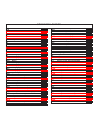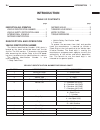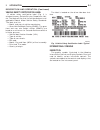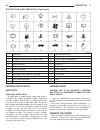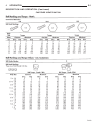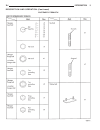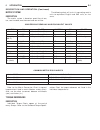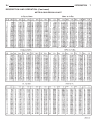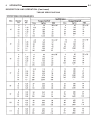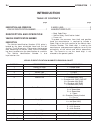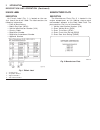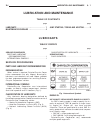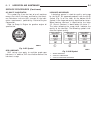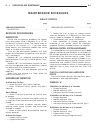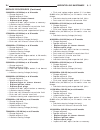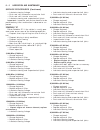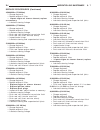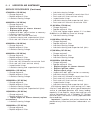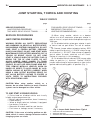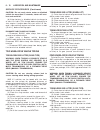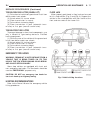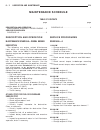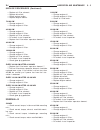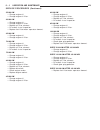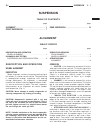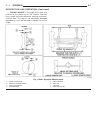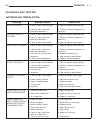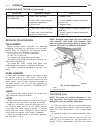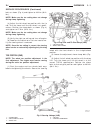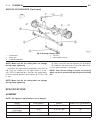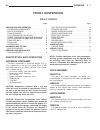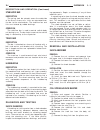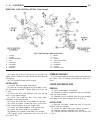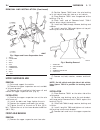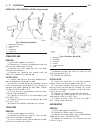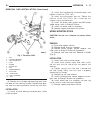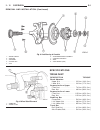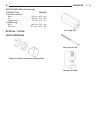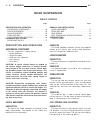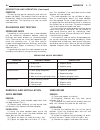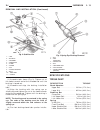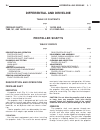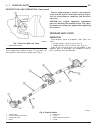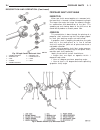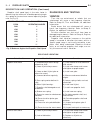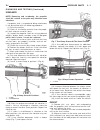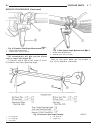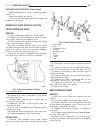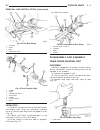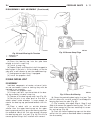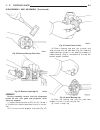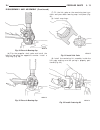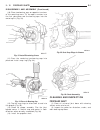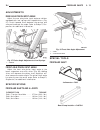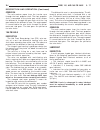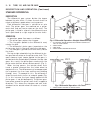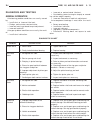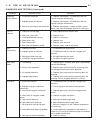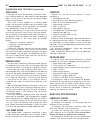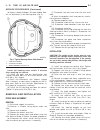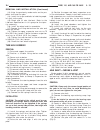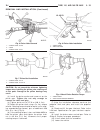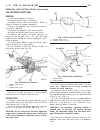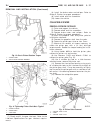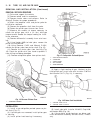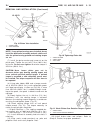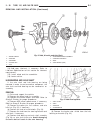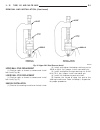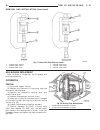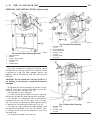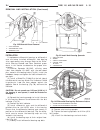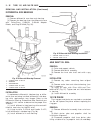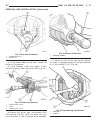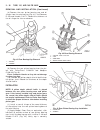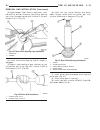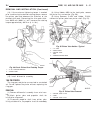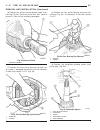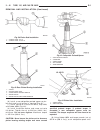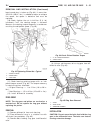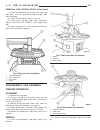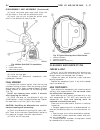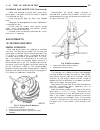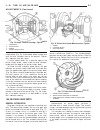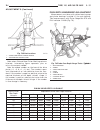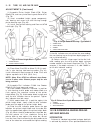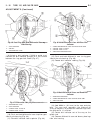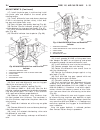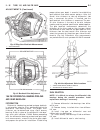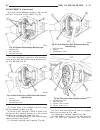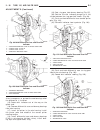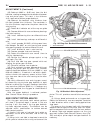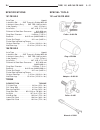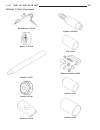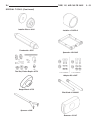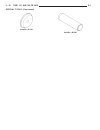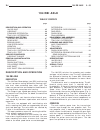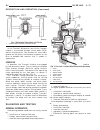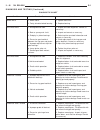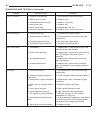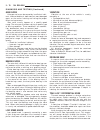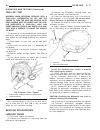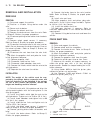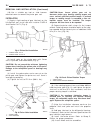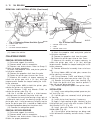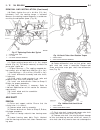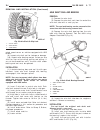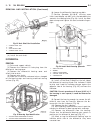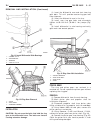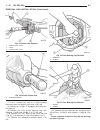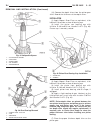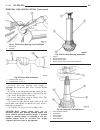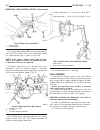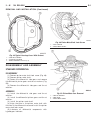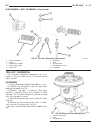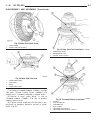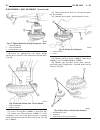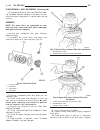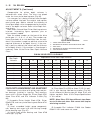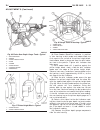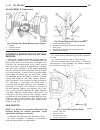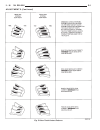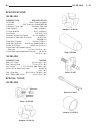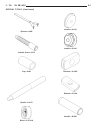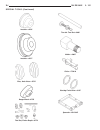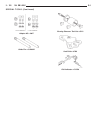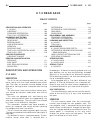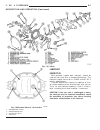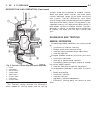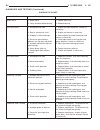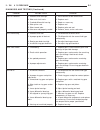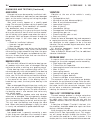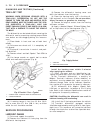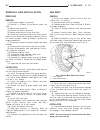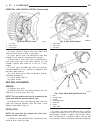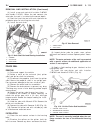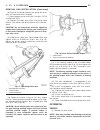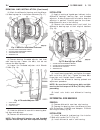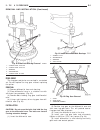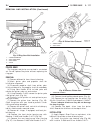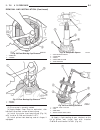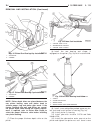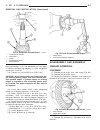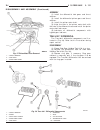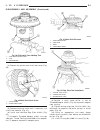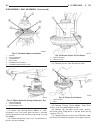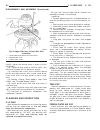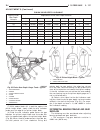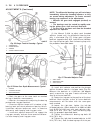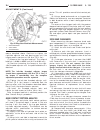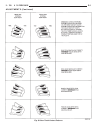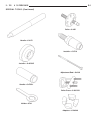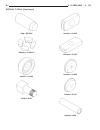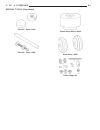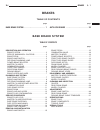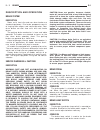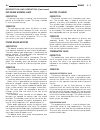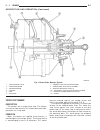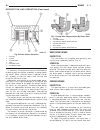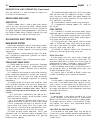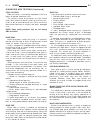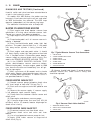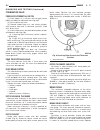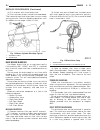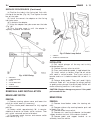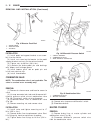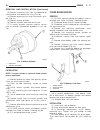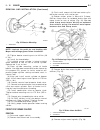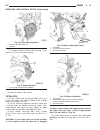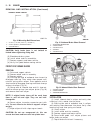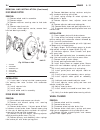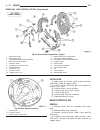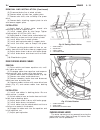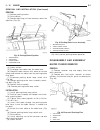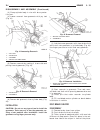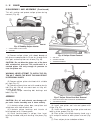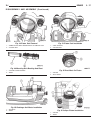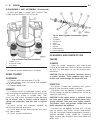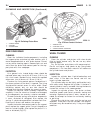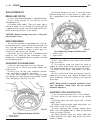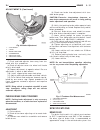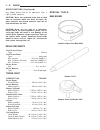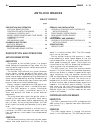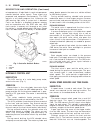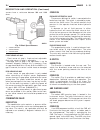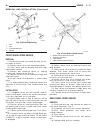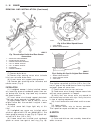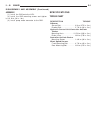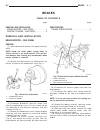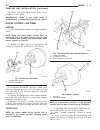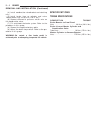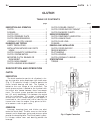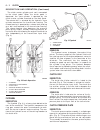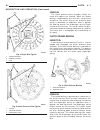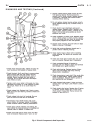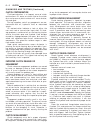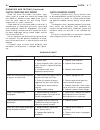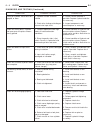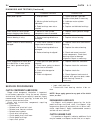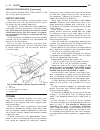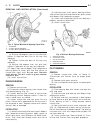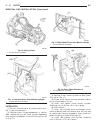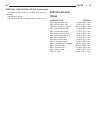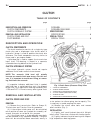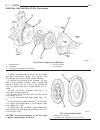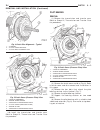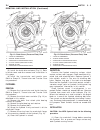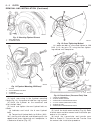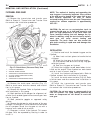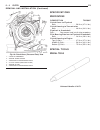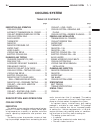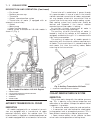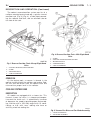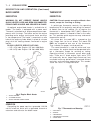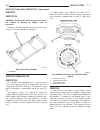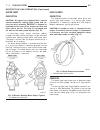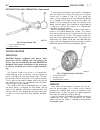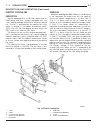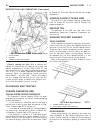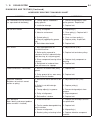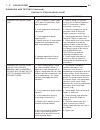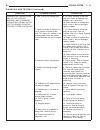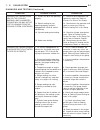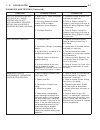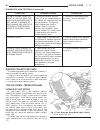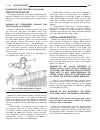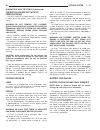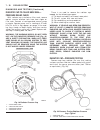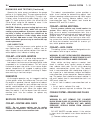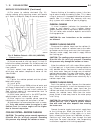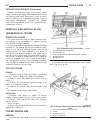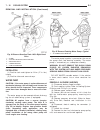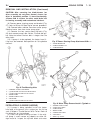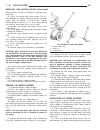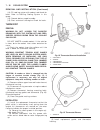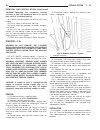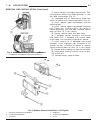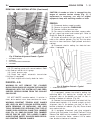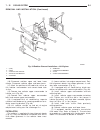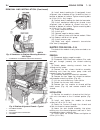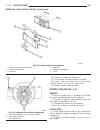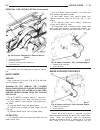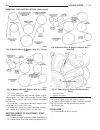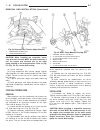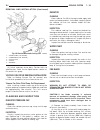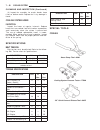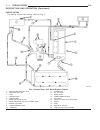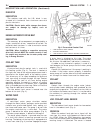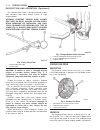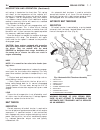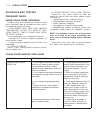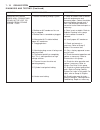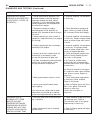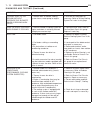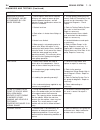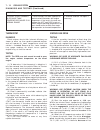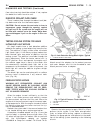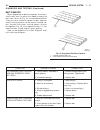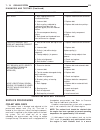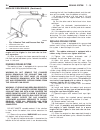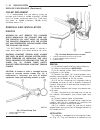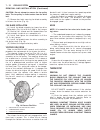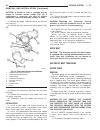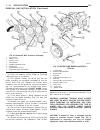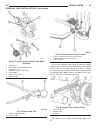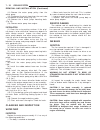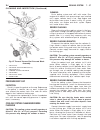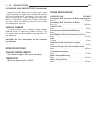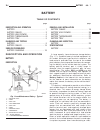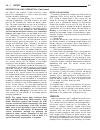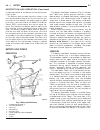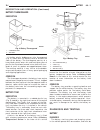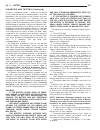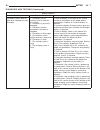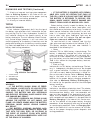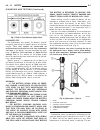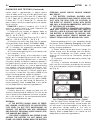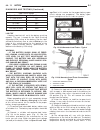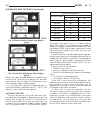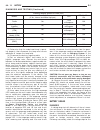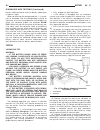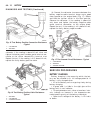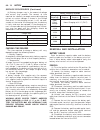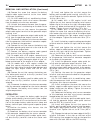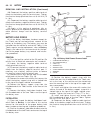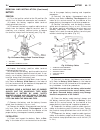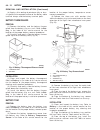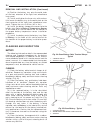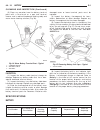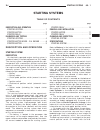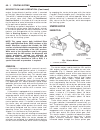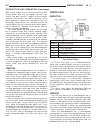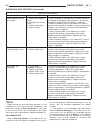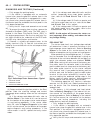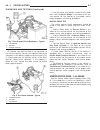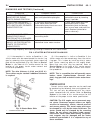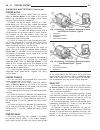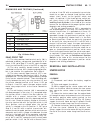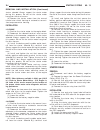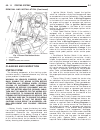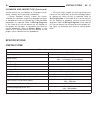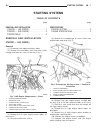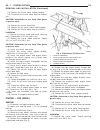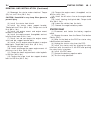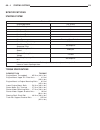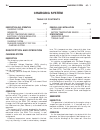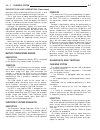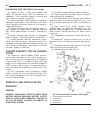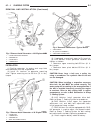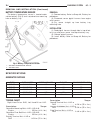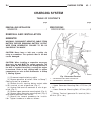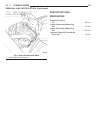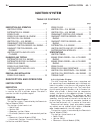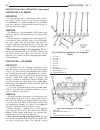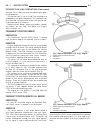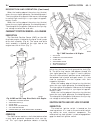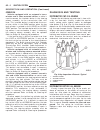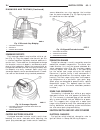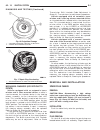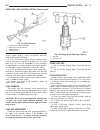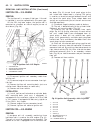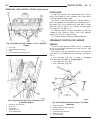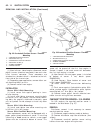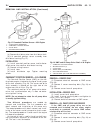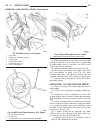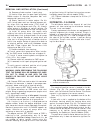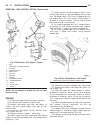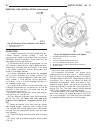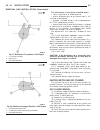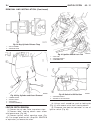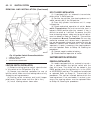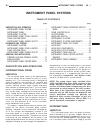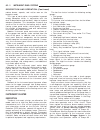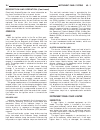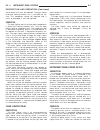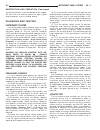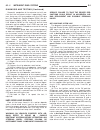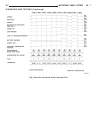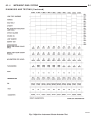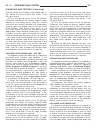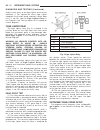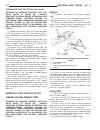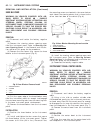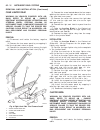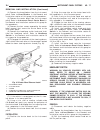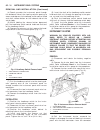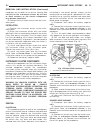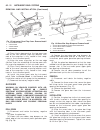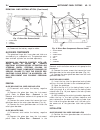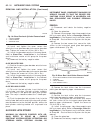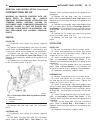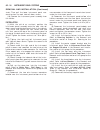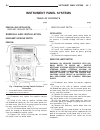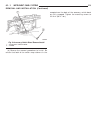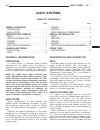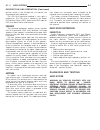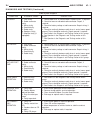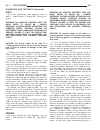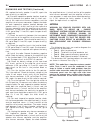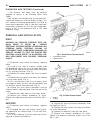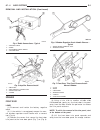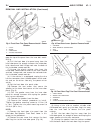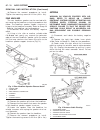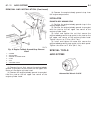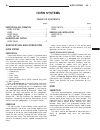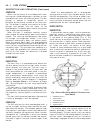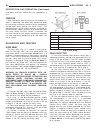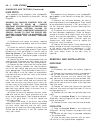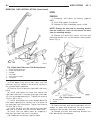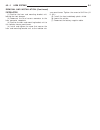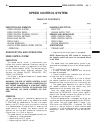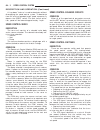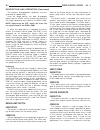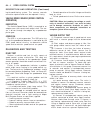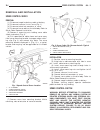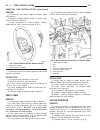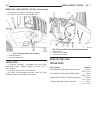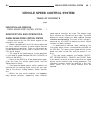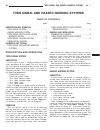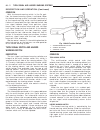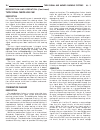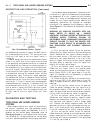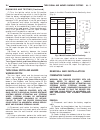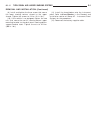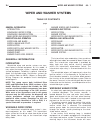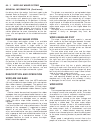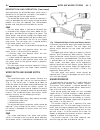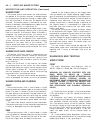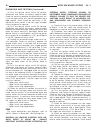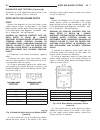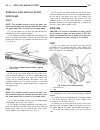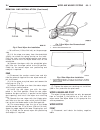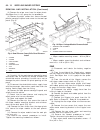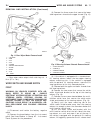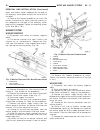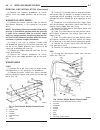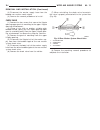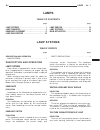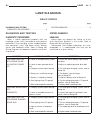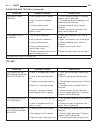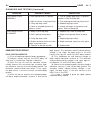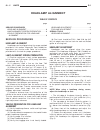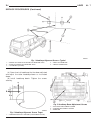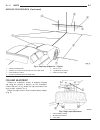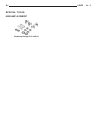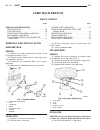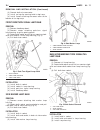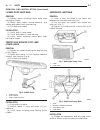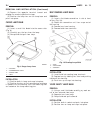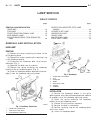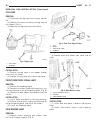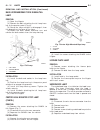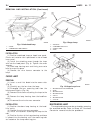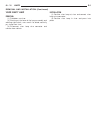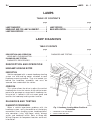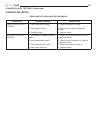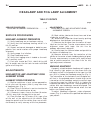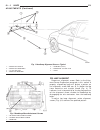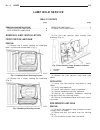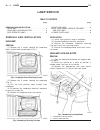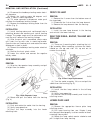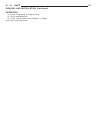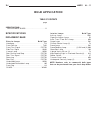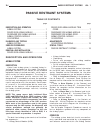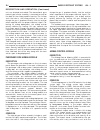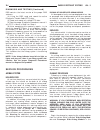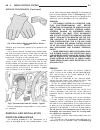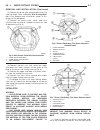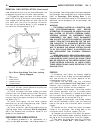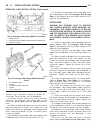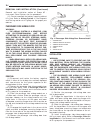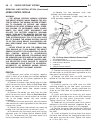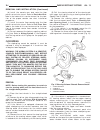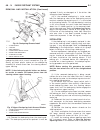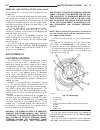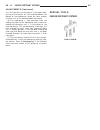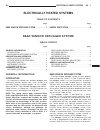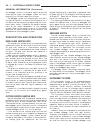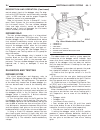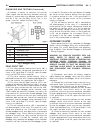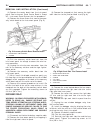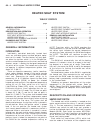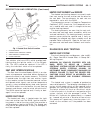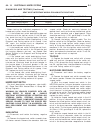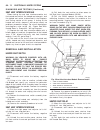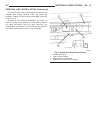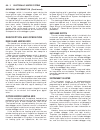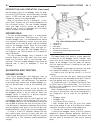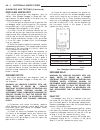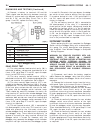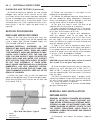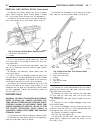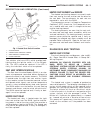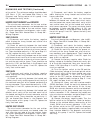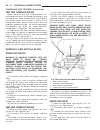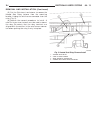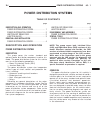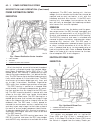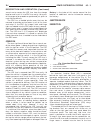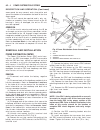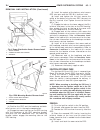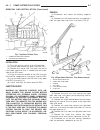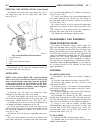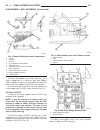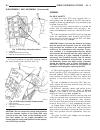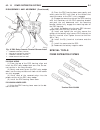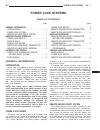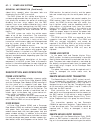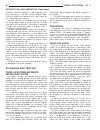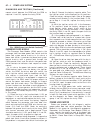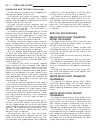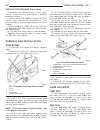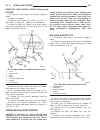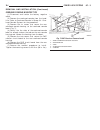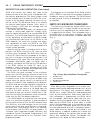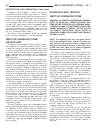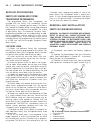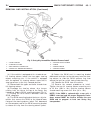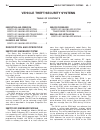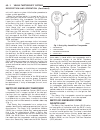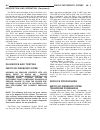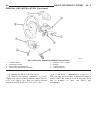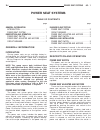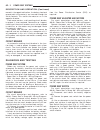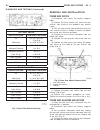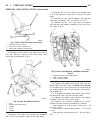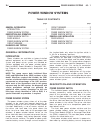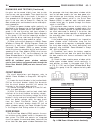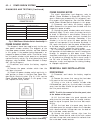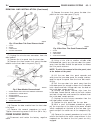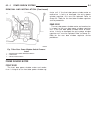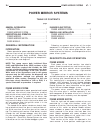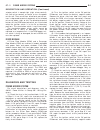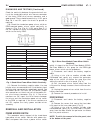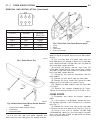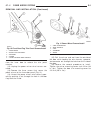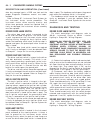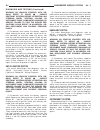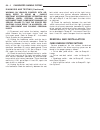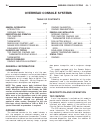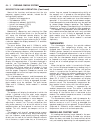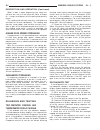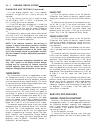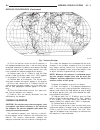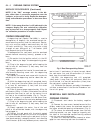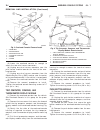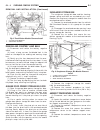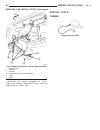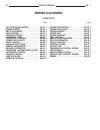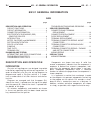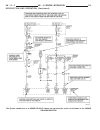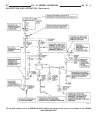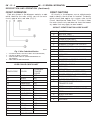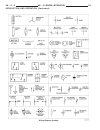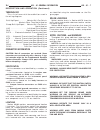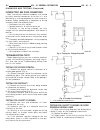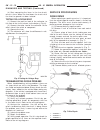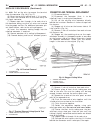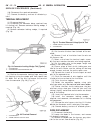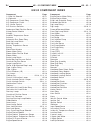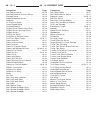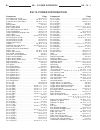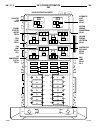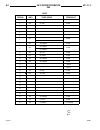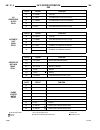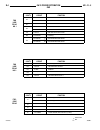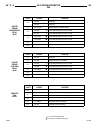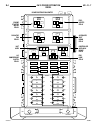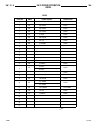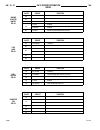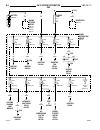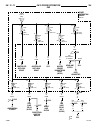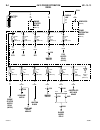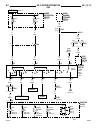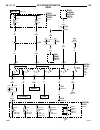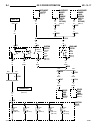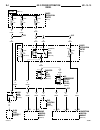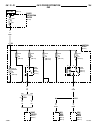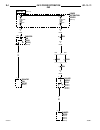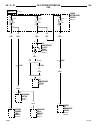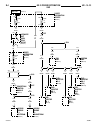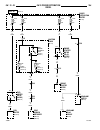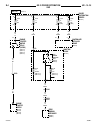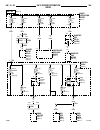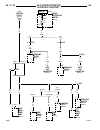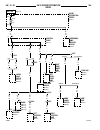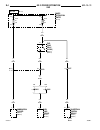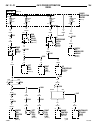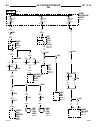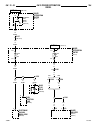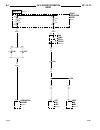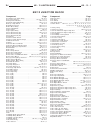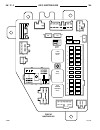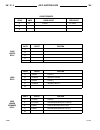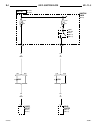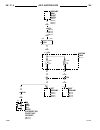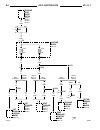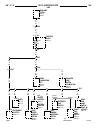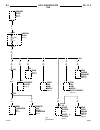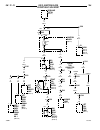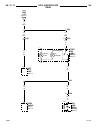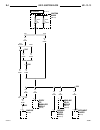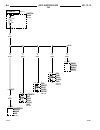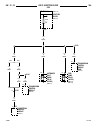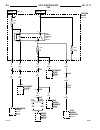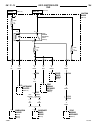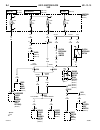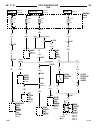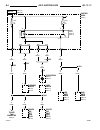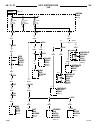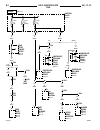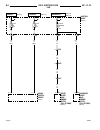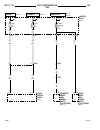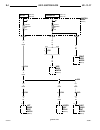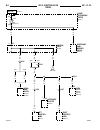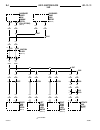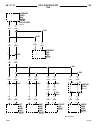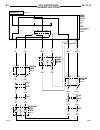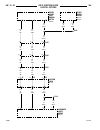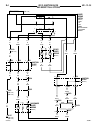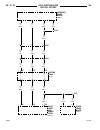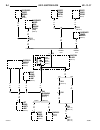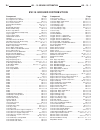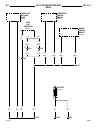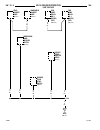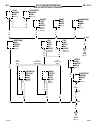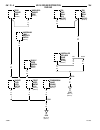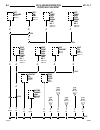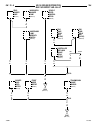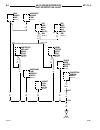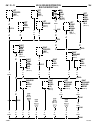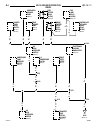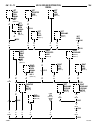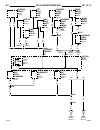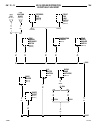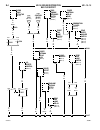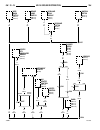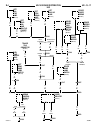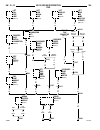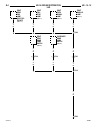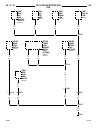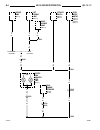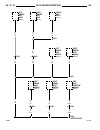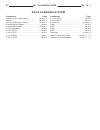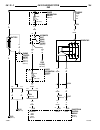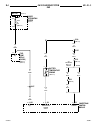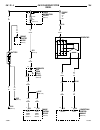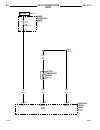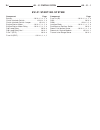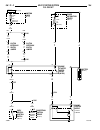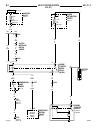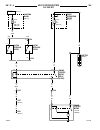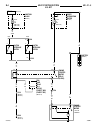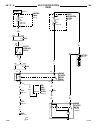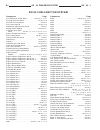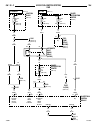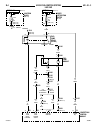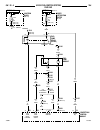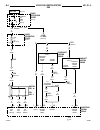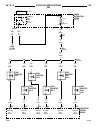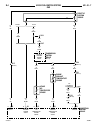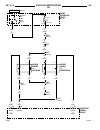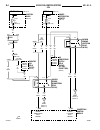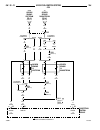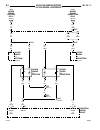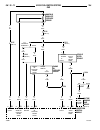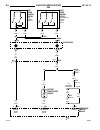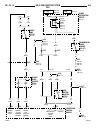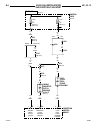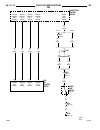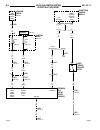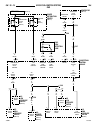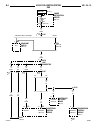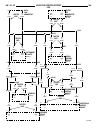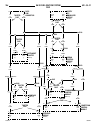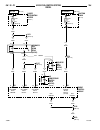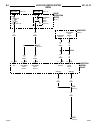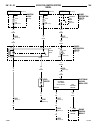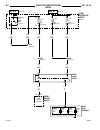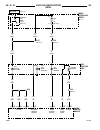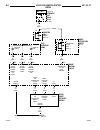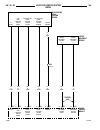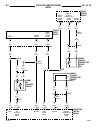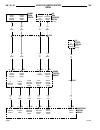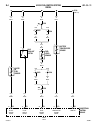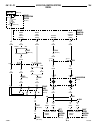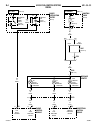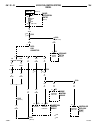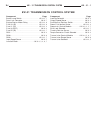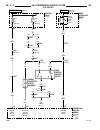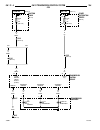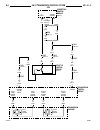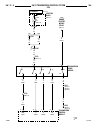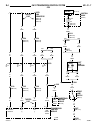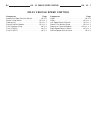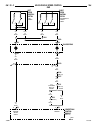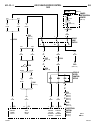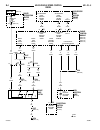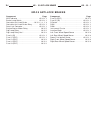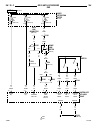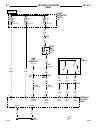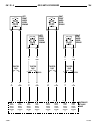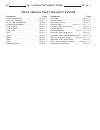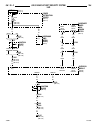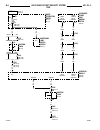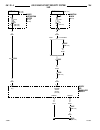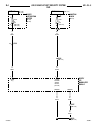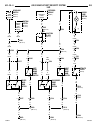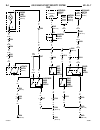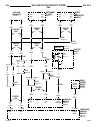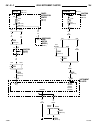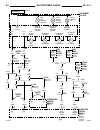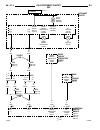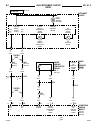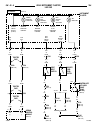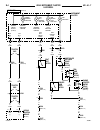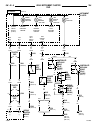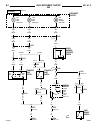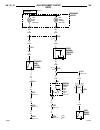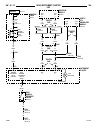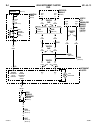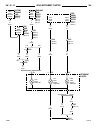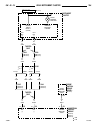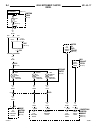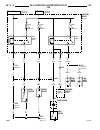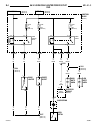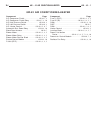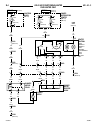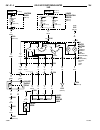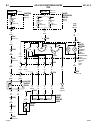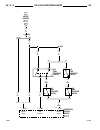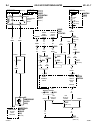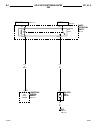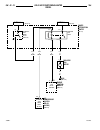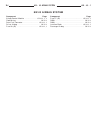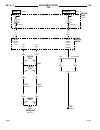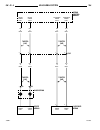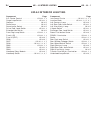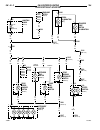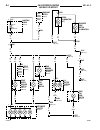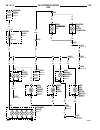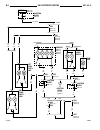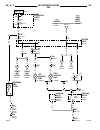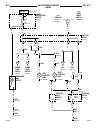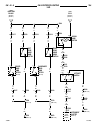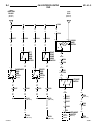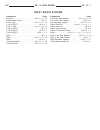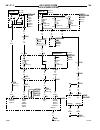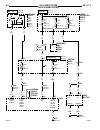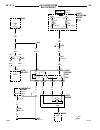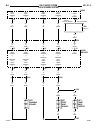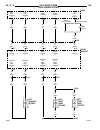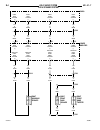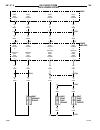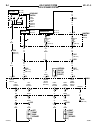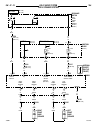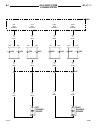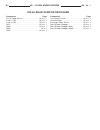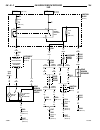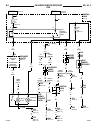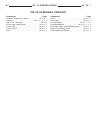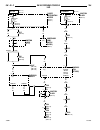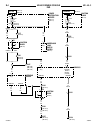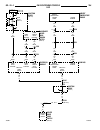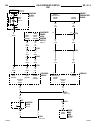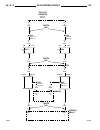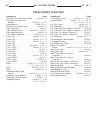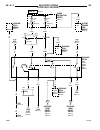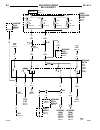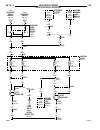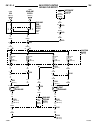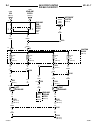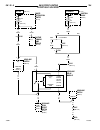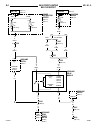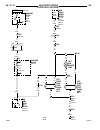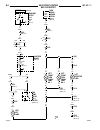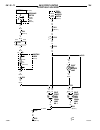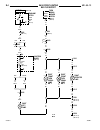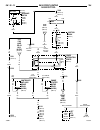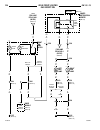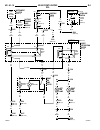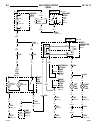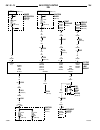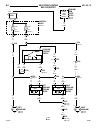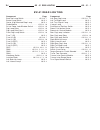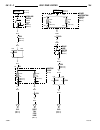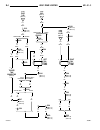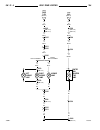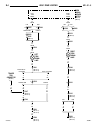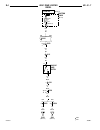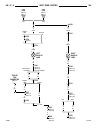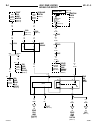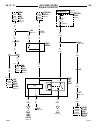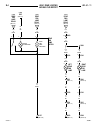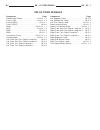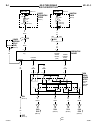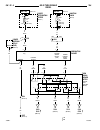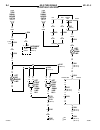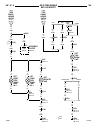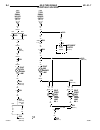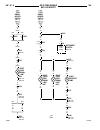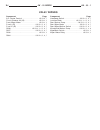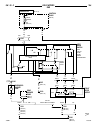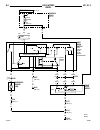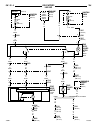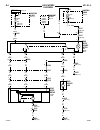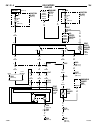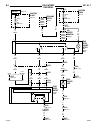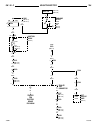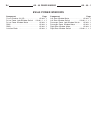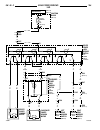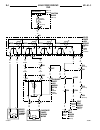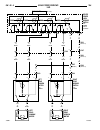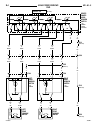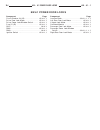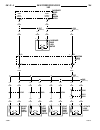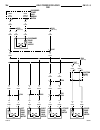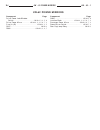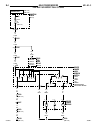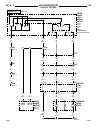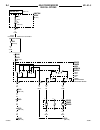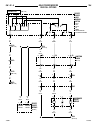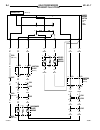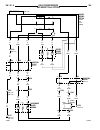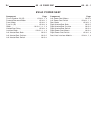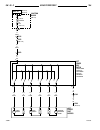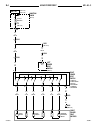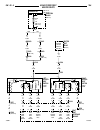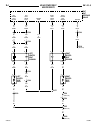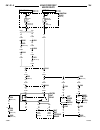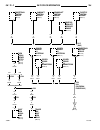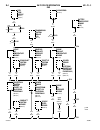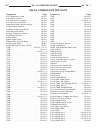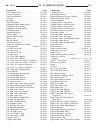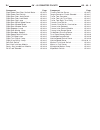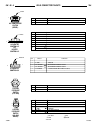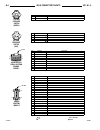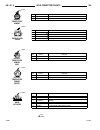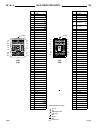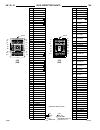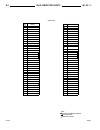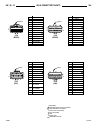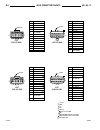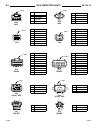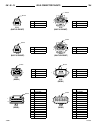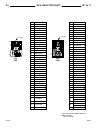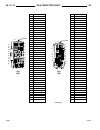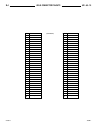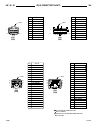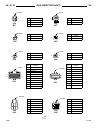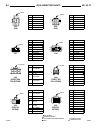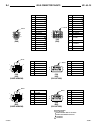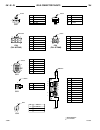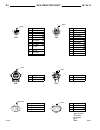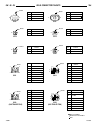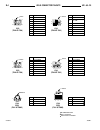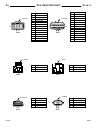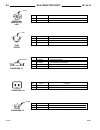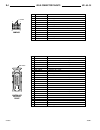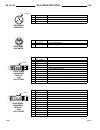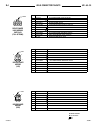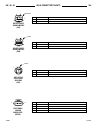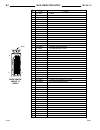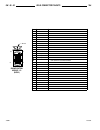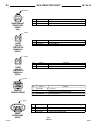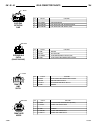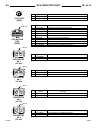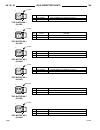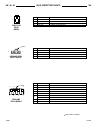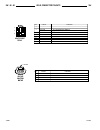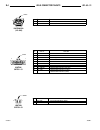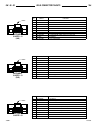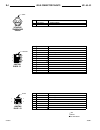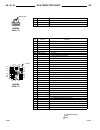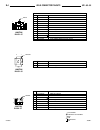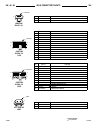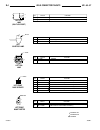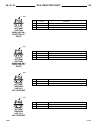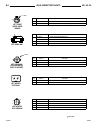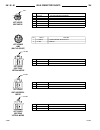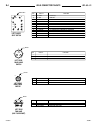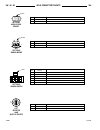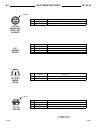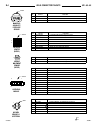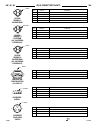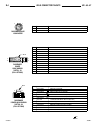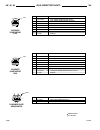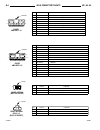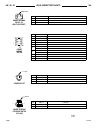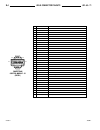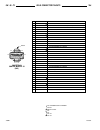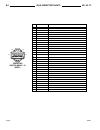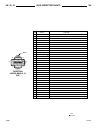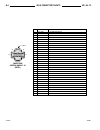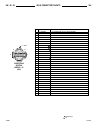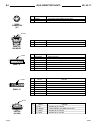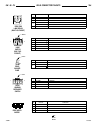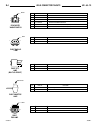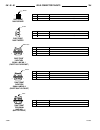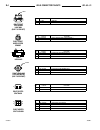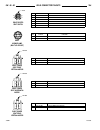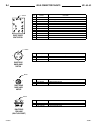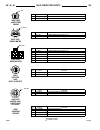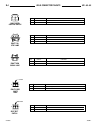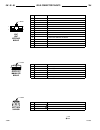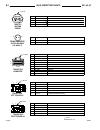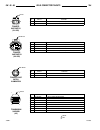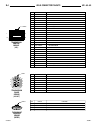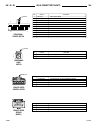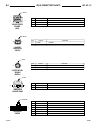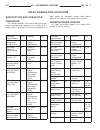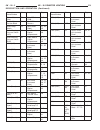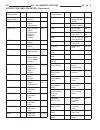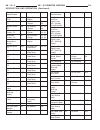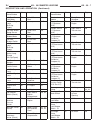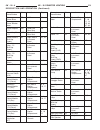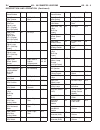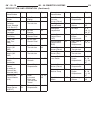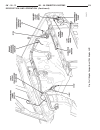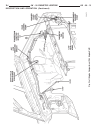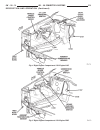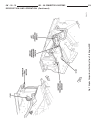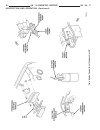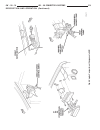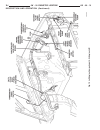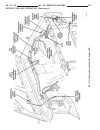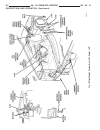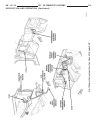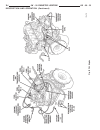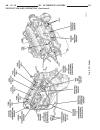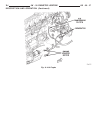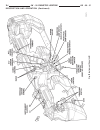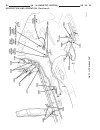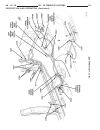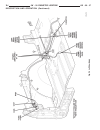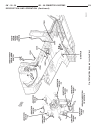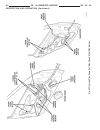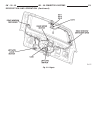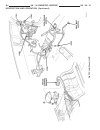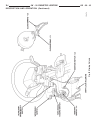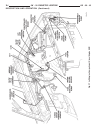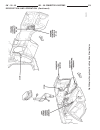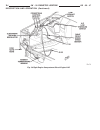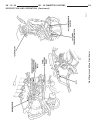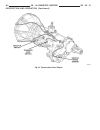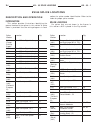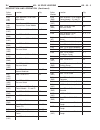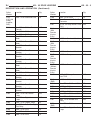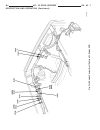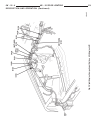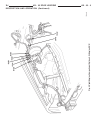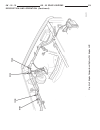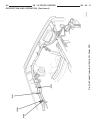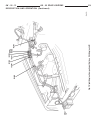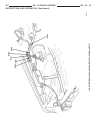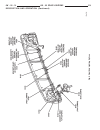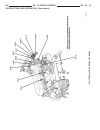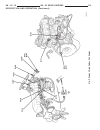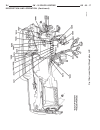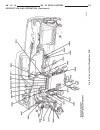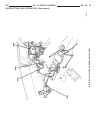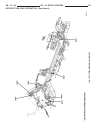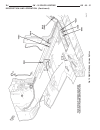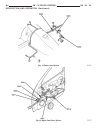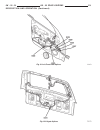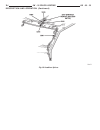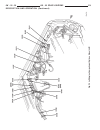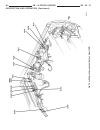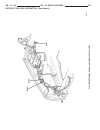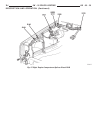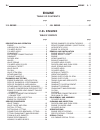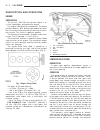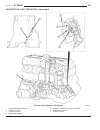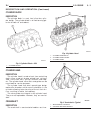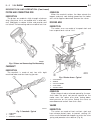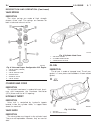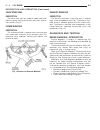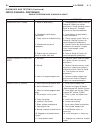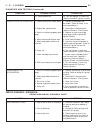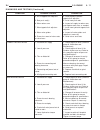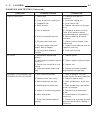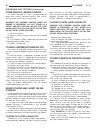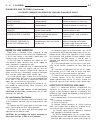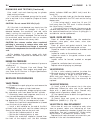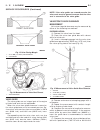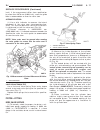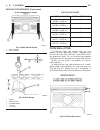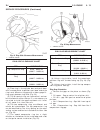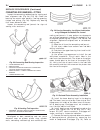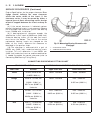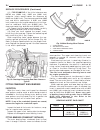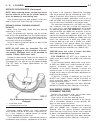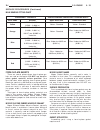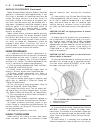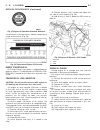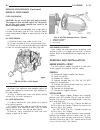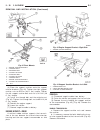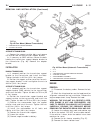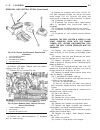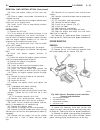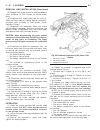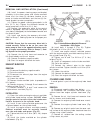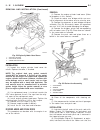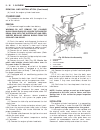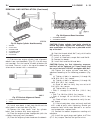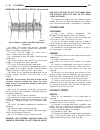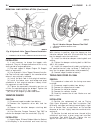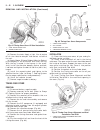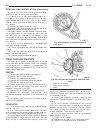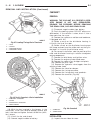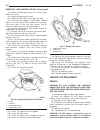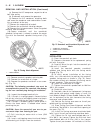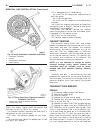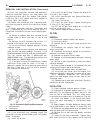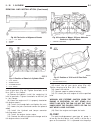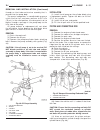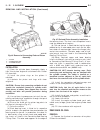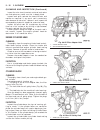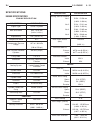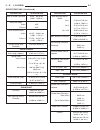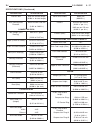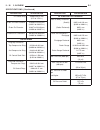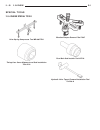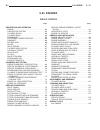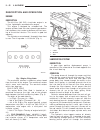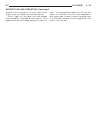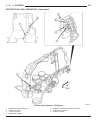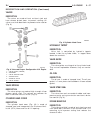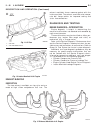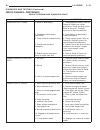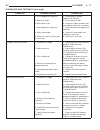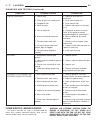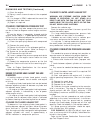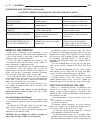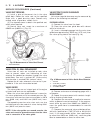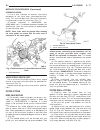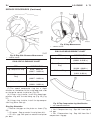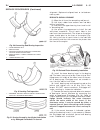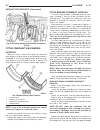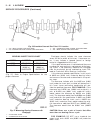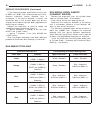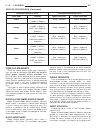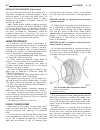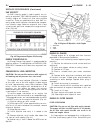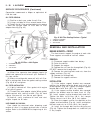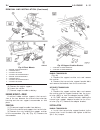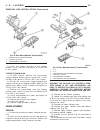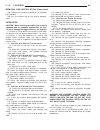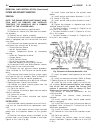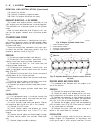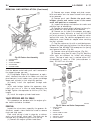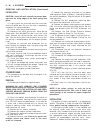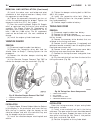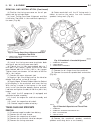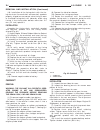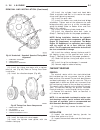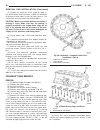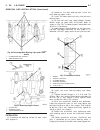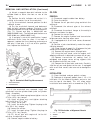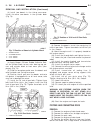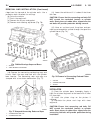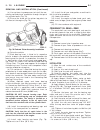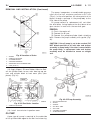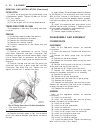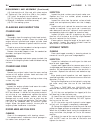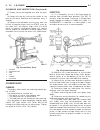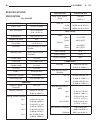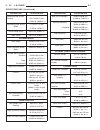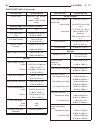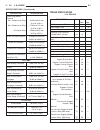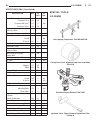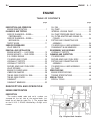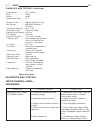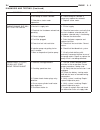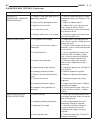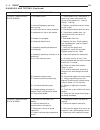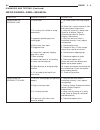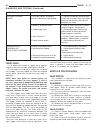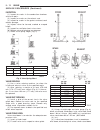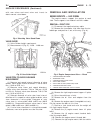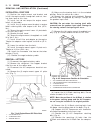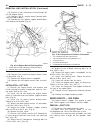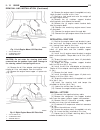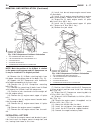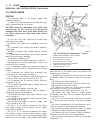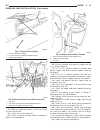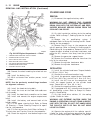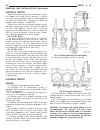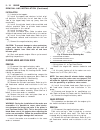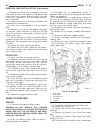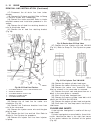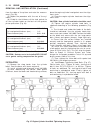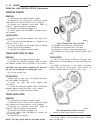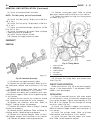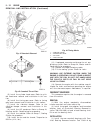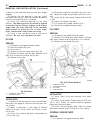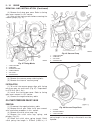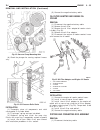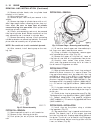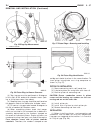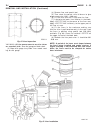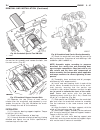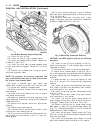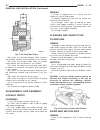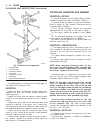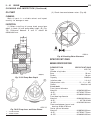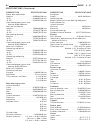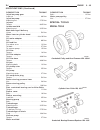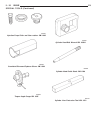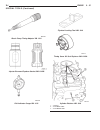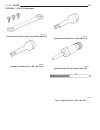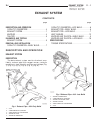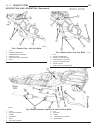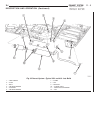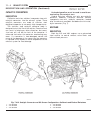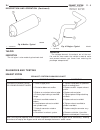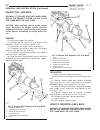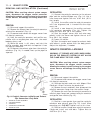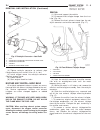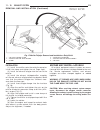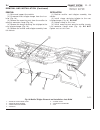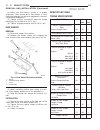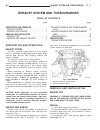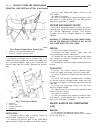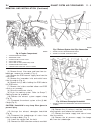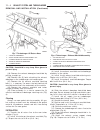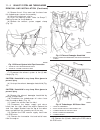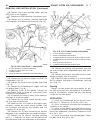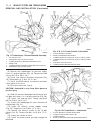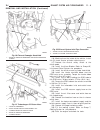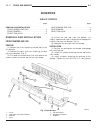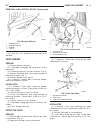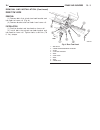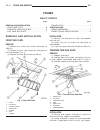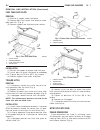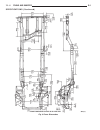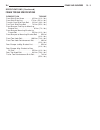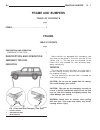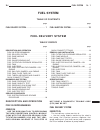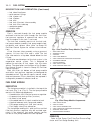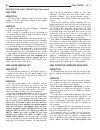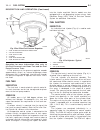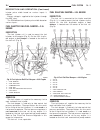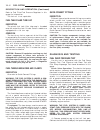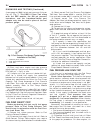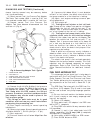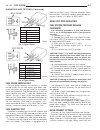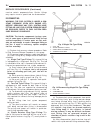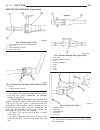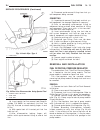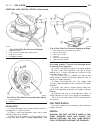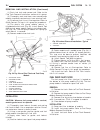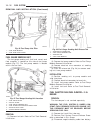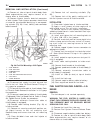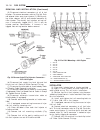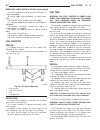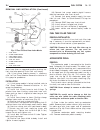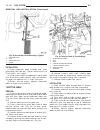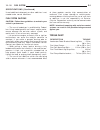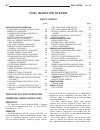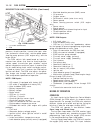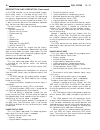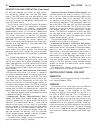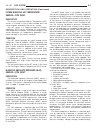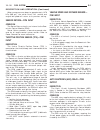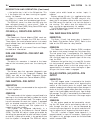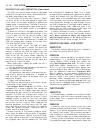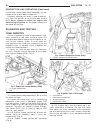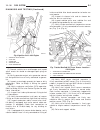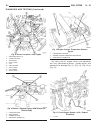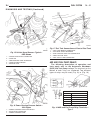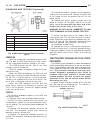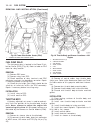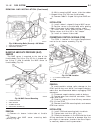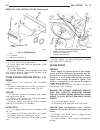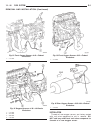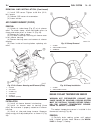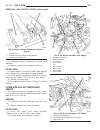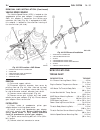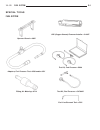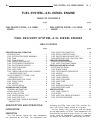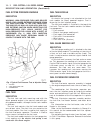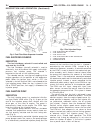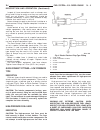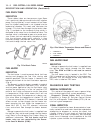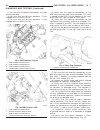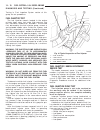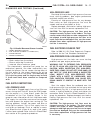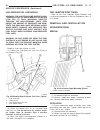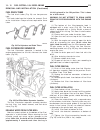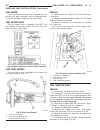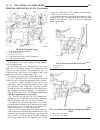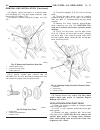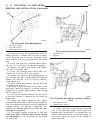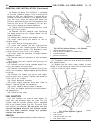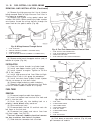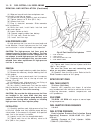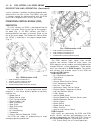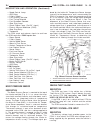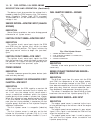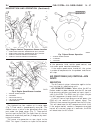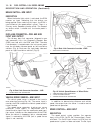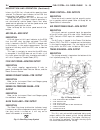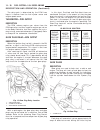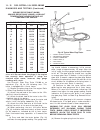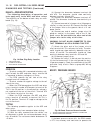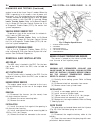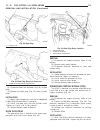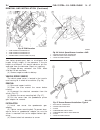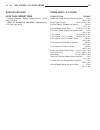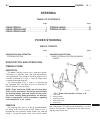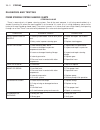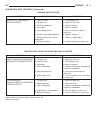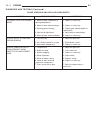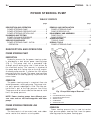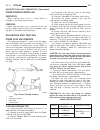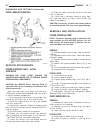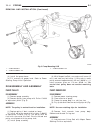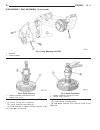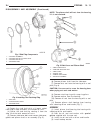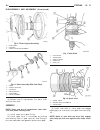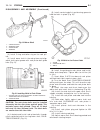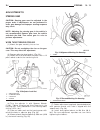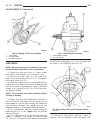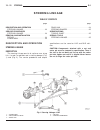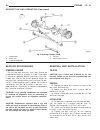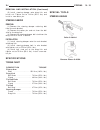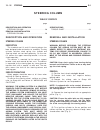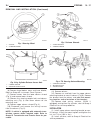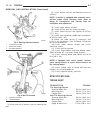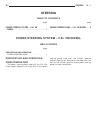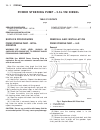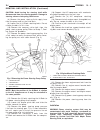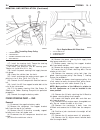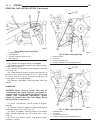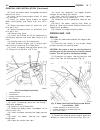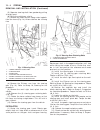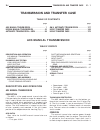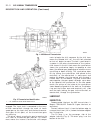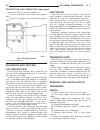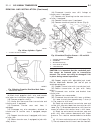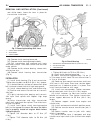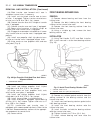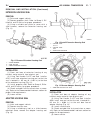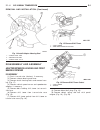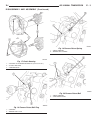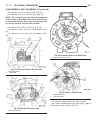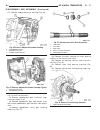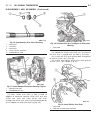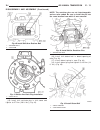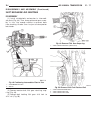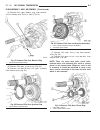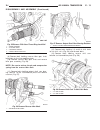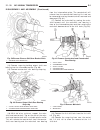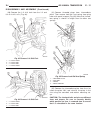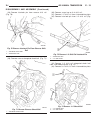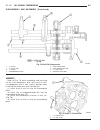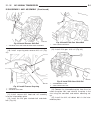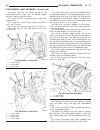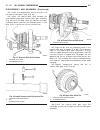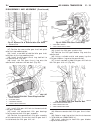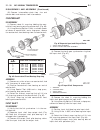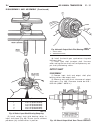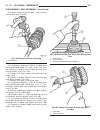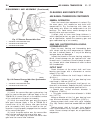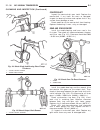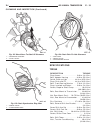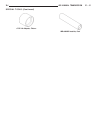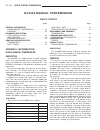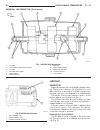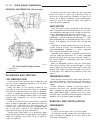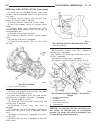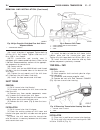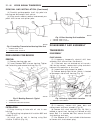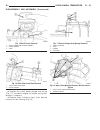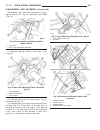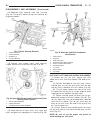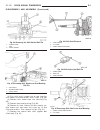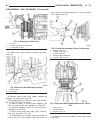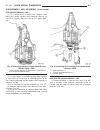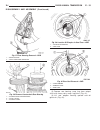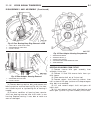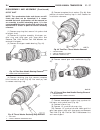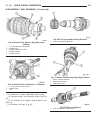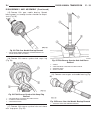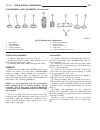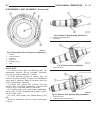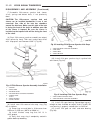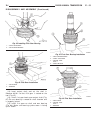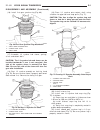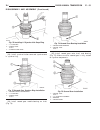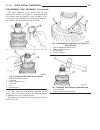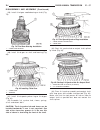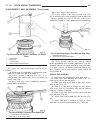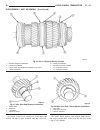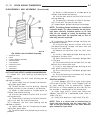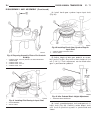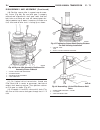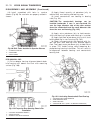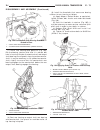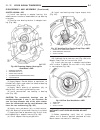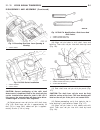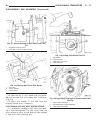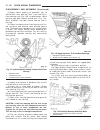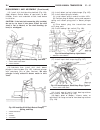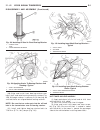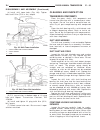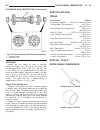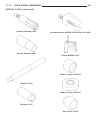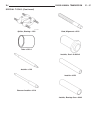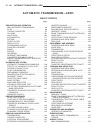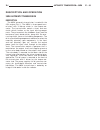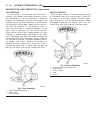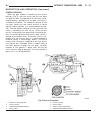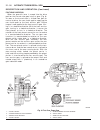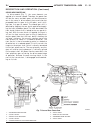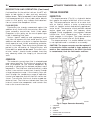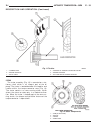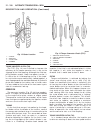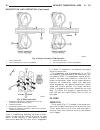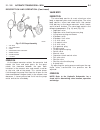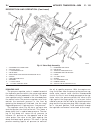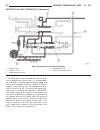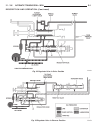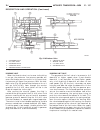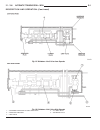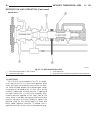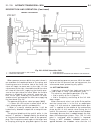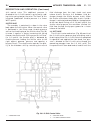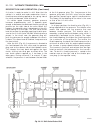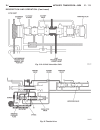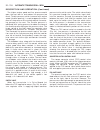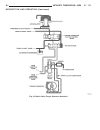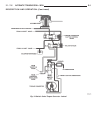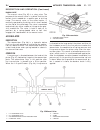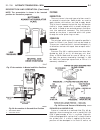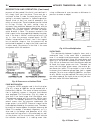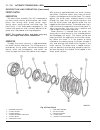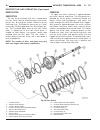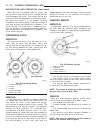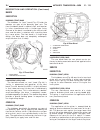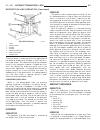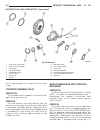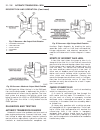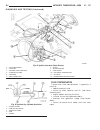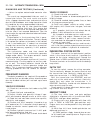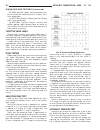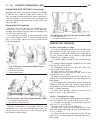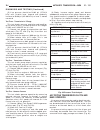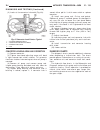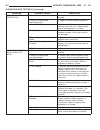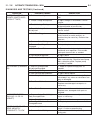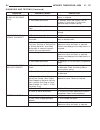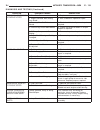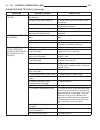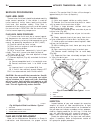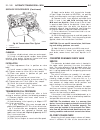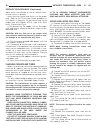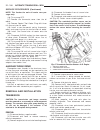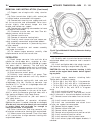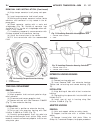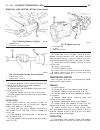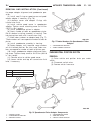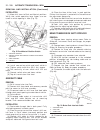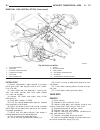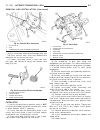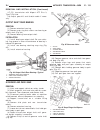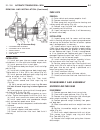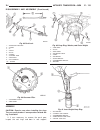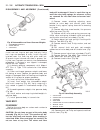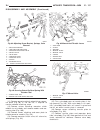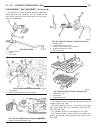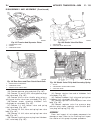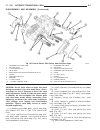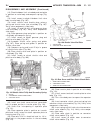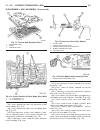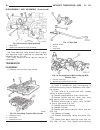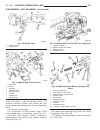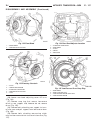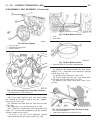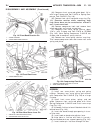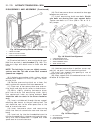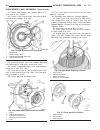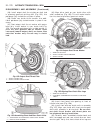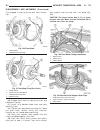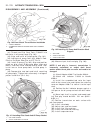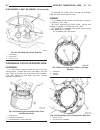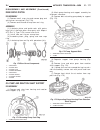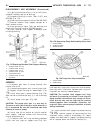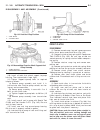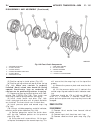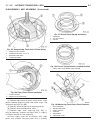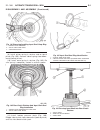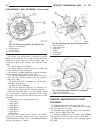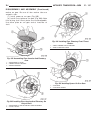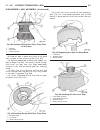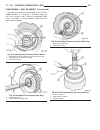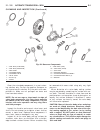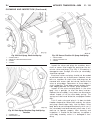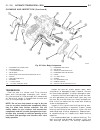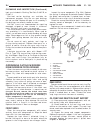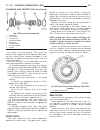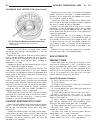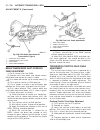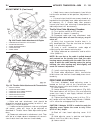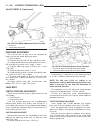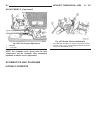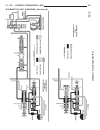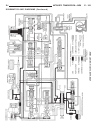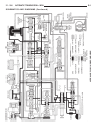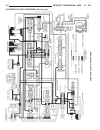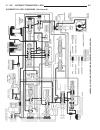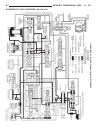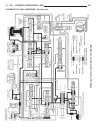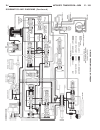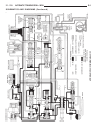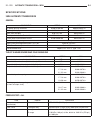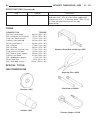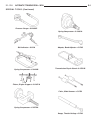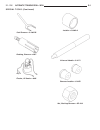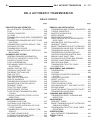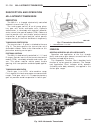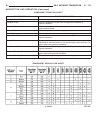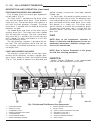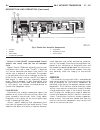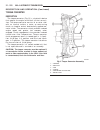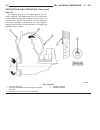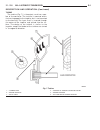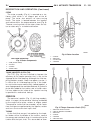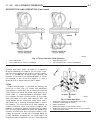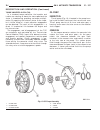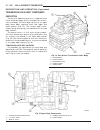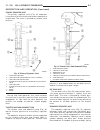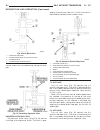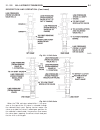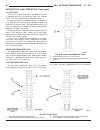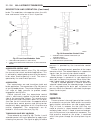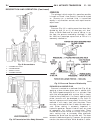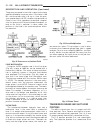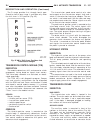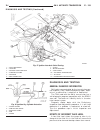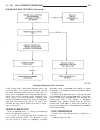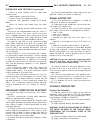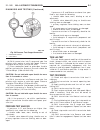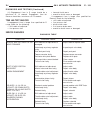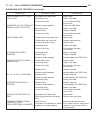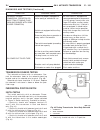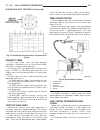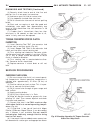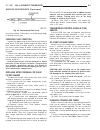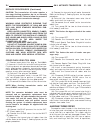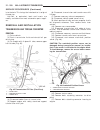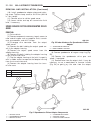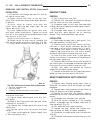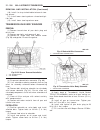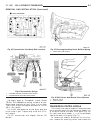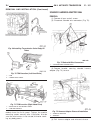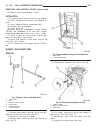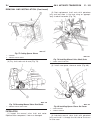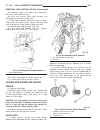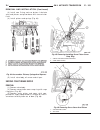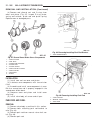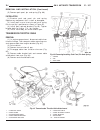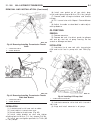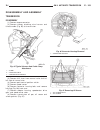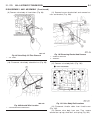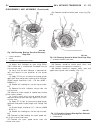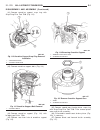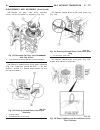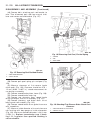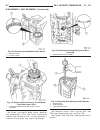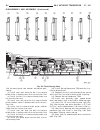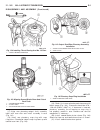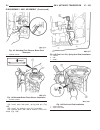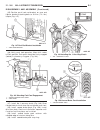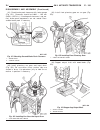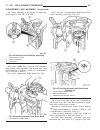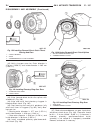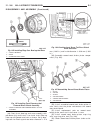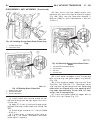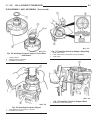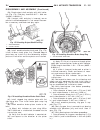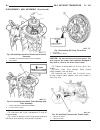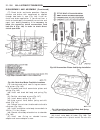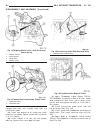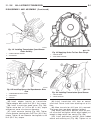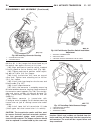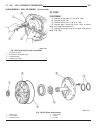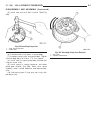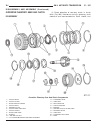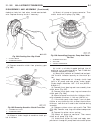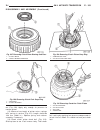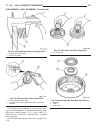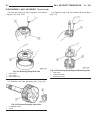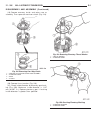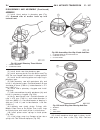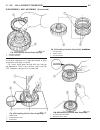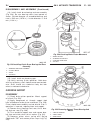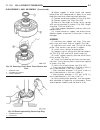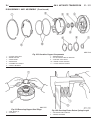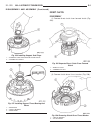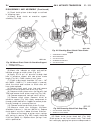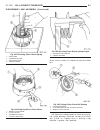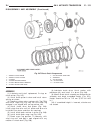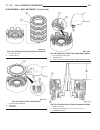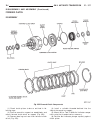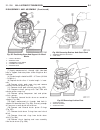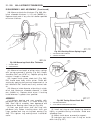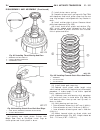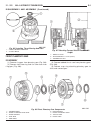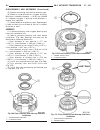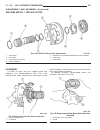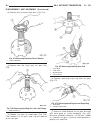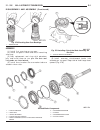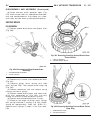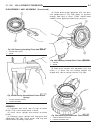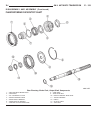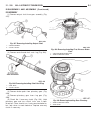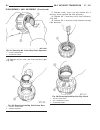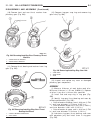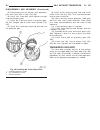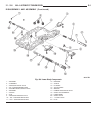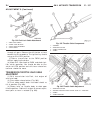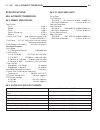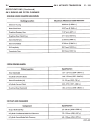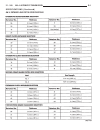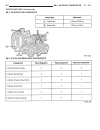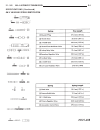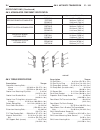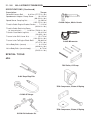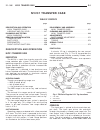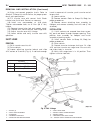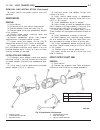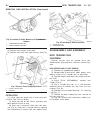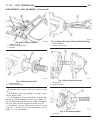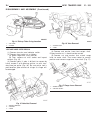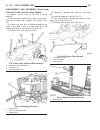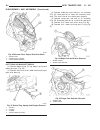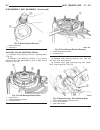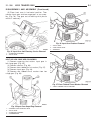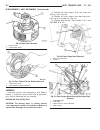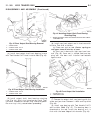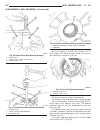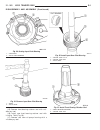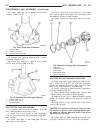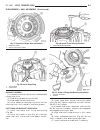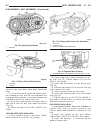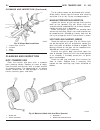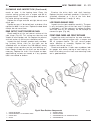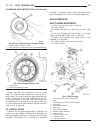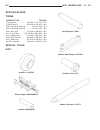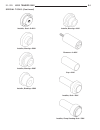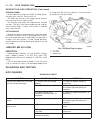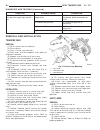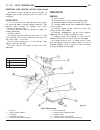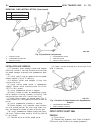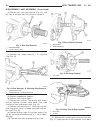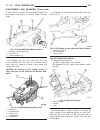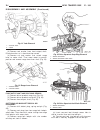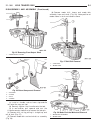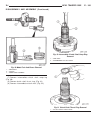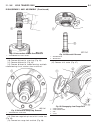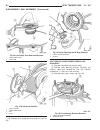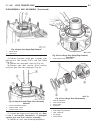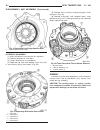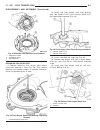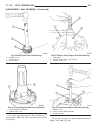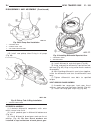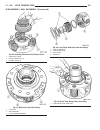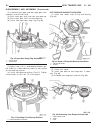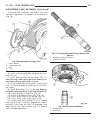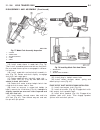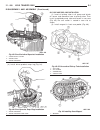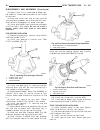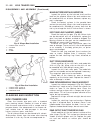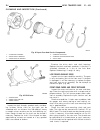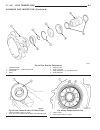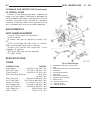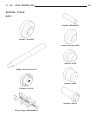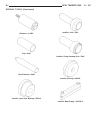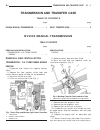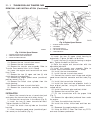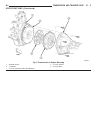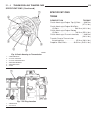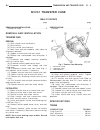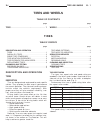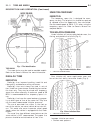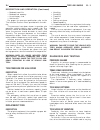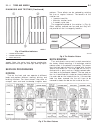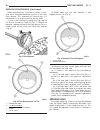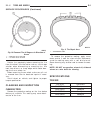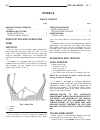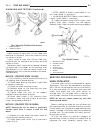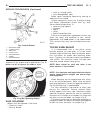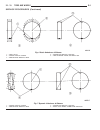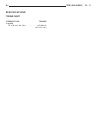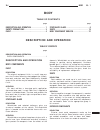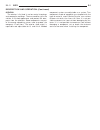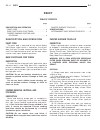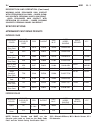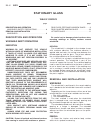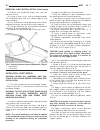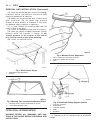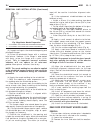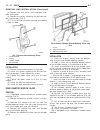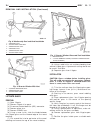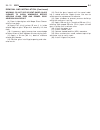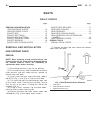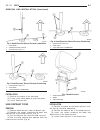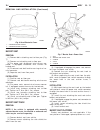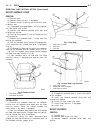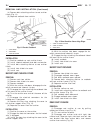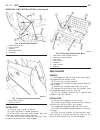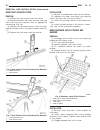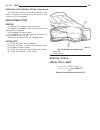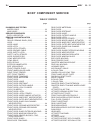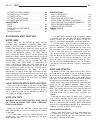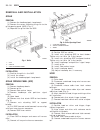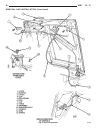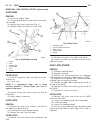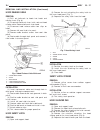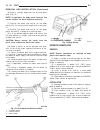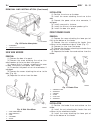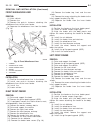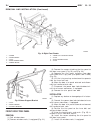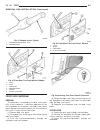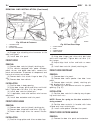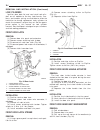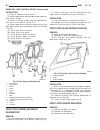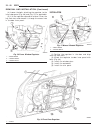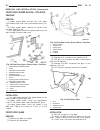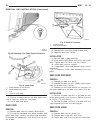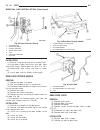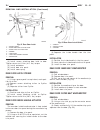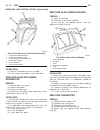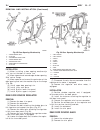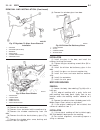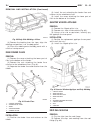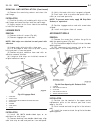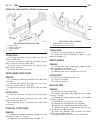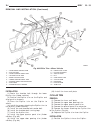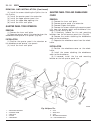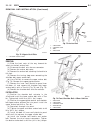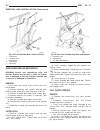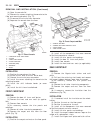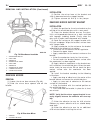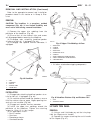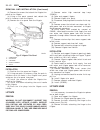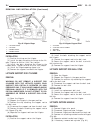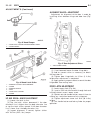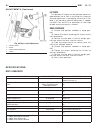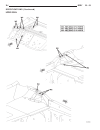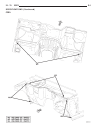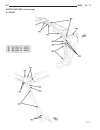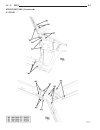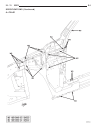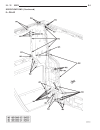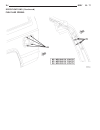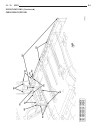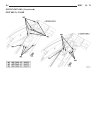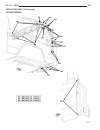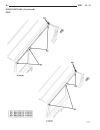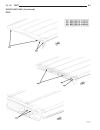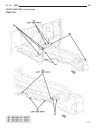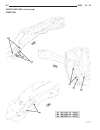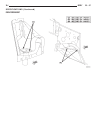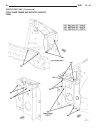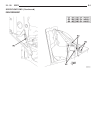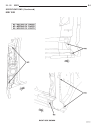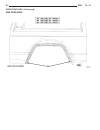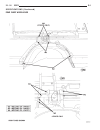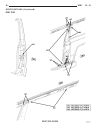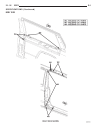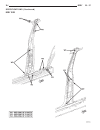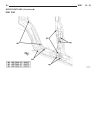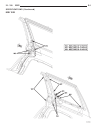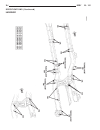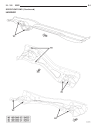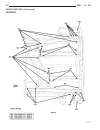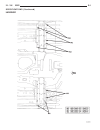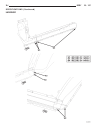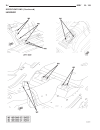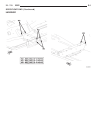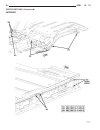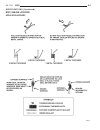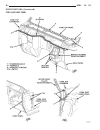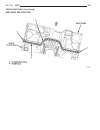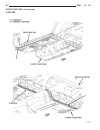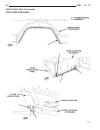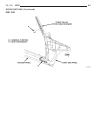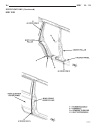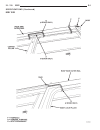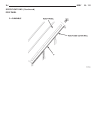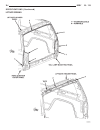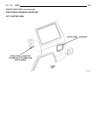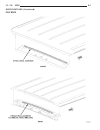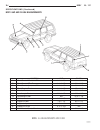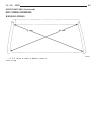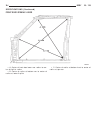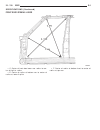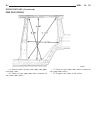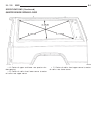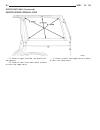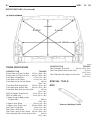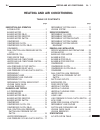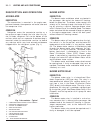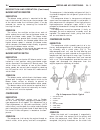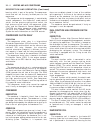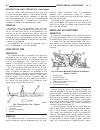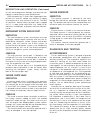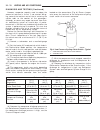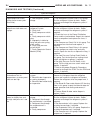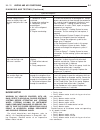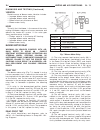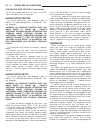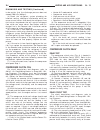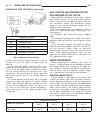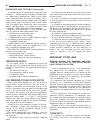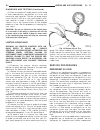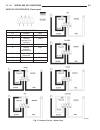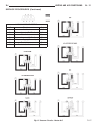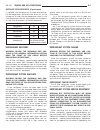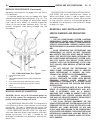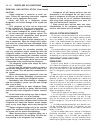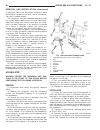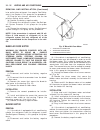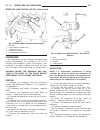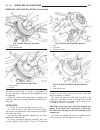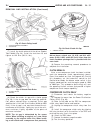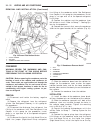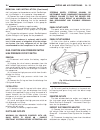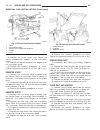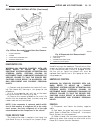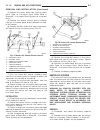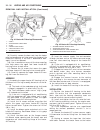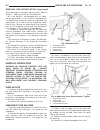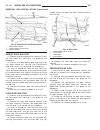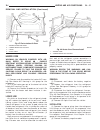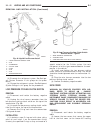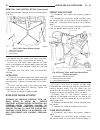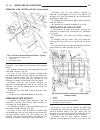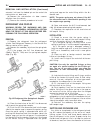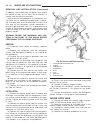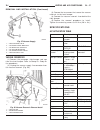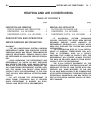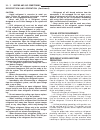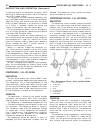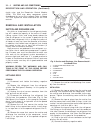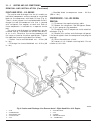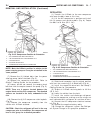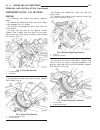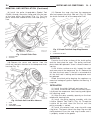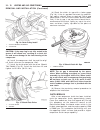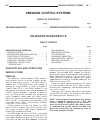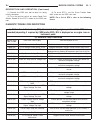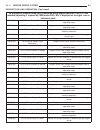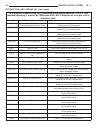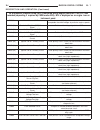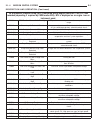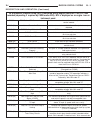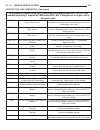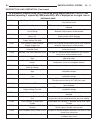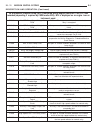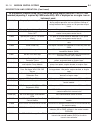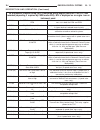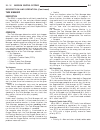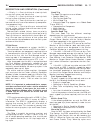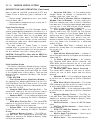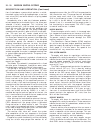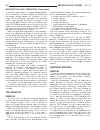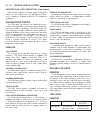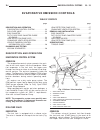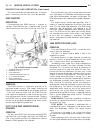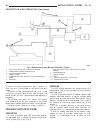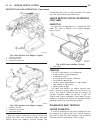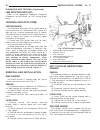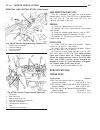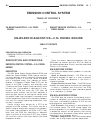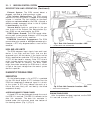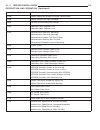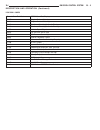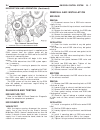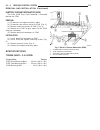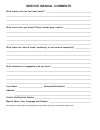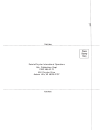- DL manuals
- Jeep
- Automobile
- 200 Cherokee
- Service Manual
Jeep 200 Cherokee Service Manual
GROUP TAB LOCATOR
IN
Introduction
INa
Introduction
0
Lubrication and Maintenance
0a
Lubrication and Maintenance
2
Suspension
3
Differential and Driveline
5
Brakes
5a
Brakes
6
Clutch
6a
Clutch
7
Cooling System
7a
Cooling System
8A
Battery
8B
Starting System
8Ba
Starting Systems
8C
Charging System
8Ca
Charging System
8D
Ignition System
8E
Instrument Panel Systems
8Ea
Instrument Panel Systems
8F
Audio Systems
8G
Horn Systems
8H
Vehicle Speed Control System
8Ha
Vehicle Speed Control System
8J
Turn Signal and Hazard Warning Systems
8K
Wiper and Washer Systems
8L
Lamps
8La
Lamps
8M
Passive Restraint Systems
8N
Electrically Heated Systems
8O
Power Distribution Systems
8P
Power Lock Systems
8Q
Vehicle Theft/Security Systems
8Qa
Vehicle Theft/Security Systems
8R
Power Seats Systems
8S
Power Window Systems
8T
Power Mirror Systems
8U
Chime/Buzzer Warning Systems
8V
Overhead Console Systems
8W
Wiring Diagrams
9
Engine
9a
Engine
11
Exhaust System and Intake Manifold
11a
Exhaust System and Intake Manifold
13
Frame and Bumpers
13a
Frame and Bumpers
14
Fuel System
14a
Fuel System–2.5L Diesel Engine
19
Steering
19a
Steering
21
Transmission and Transfer Case
21a
Transmission and Transfer Case
22
Tires and Wheels
23
Body
24
Heating and Air Conditioning
24a
Heating and Air Conditioning
25
Emission Control Systems
25a
Emission Control System
Service Manual Comment Forms
Summary of 200 Cherokee
Page 1
Group tab locator in introduction ina introduction 0 lubrication and maintenance 0a lubrication and maintenance 2 suspension 3 differential and driveline 5 brakes 5a brakes 6 clutch 6a clutch 7 cooling system 7a cooling system 8a battery 8b starting system 8ba starting systems 8c charging system 8ca...
Page 2: Introduction
Introduction table of contents page page description and operation vehicle identification number . . . . . . . . . . 1 vehicle safety certification label . . . . . . 2 international symbols . . . . . . . . . . . . . . . . . 2 fastener identification . . . . . . . . . . . . . . . . . 3 fastener usage...
Page 3
Vehicle safety certification label a vehicle safety certification label (fig. 1) is attached to every daimlerchrysler corporation vehi- cle. The label certifies that the vehicle conforms to all applicable federal motor vehicle safety standards. The label also lists: • month and year of vehicle manuf...
Page 4
Fastener identification description grade/class identification the sae bolt strength grades range from grade 2 to grade 8. The higher the grade number, the greater the bolt strength. Identification is determined by the line marks on the top of each bolt head. The actual bolt strength grade correspon...
Page 5
Fastener identification 4 introduction xj description and operation (continued).
Page 6
Fastener strength xj introduction 5 description and operation (continued).
Page 7
Metric system description the metric system is based on quantities of one, ten, one hundred, one thousand and one million. The following chart will assist in converting metric units to equivalent english and sae units, or vise versa. Conversion formulas and equivalent values multiply by to get multi...
Page 8
Metric conversion chart xj introduction 7 description and operation (continued).
Page 9
Torque specifications 8 introduction xj description and operation (continued).
Page 10: Introduction
Introduction table of contents page page description and operation vehicle identification number . . . . . . . . . . 1 e-mark label . . . . . . . . . . . . . . . . . . . . . . . . . . 2 manufacturer plate . . . . . . . . . . . . . . . . . . . 2 description and operation vehicle identification number...
Page 11
E-mark label description an e-mark label (fig. 1) is located on the rear shut face of the driver’s door. The label contains the following information: • date of manufacture • month-day-hour (mdh) • vehicle identification number (vin) • country codes • regulation number • regulation amendment number ...
Page 12: Lubricants
Lubrication and maintenance table of contents page page lubricants . . . . . . . . . . . . . . . . . . . . . . . . . . . . . 1 maintenance schedules . . . . . . . . . . . . . . . . . 4 jump starting, towing and hoisting . . . . . 9 lubricants table of contents page page service procedures parts and ...
Page 13
Api quality classification this symbol (fig. 2) on the front of an oil container means that the oil has been certified by the ameri- can petroleum institute (api) to meet all the lubri- cation requirements specified by dailmlerchrysler corporation. Refer to group 9, engine for gasoline engine oil sp...
Page 14
Specifications fluid capacities fuel tank all . . . . . . . . . . . . . . . . . . . . . . . . 76.4 l (20.2 gal.) engine oil w/filter change 2.5l . . . . . . . . . . . . . . . . . . . . . . . . . 3.8 l (4.0 qts.) 4.0l . . . . . . . . . . . . . . . . . . . . . . . . . 5.7 l (6.0 qts.) cooling system 2...
Page 15: Maintenance Schedules
Maintenance schedules table of contents page page service procedures description . . . . . . . . . . . . . . . . . . . . . . . . . . . . 4 unscheduled inspection . . . . . . . . . . . . . . . . 4 service procedures description service and maintenance procedures for compo- nents and systems listed in...
Page 16
30,000 miles (48 000 km) or at 24 months • change engine oil. • replace engine oil filter. • replace air cleaner element. • replace spark plugs. • inspect drive belt, adjust tension as necessary. • lubricate steering linkage. • drain and refill automatic transmission fluid. • drain and refill transf...
Page 17
• lubricate steering linkage. • drain and refill automatic transmission fluid. • drain and refill transfer case fluid. • lubricate steering and suspension ball joints. Important: inspection and service should also be performed any time a malfunction is observed or sus- pected. Schedule “b” follow sc...
Page 18
45,000 miles (72 000 km) • change engine oil. • replace engine oil filter. • inspect engine air cleaner element, replace as necessary. • lubricate steering linkage. 48,000 miles (77 000 km) • change engine oil. • replace engine oil filter. • lubricate steering linkage. • drain and refill automatic t...
Page 19
87,000 miles (139 000 km) • change engine oil. • replace engine oil filter. • lubricate steering linkage. 90,000 miles (144 000 km) • change engine oil. • replace engine oil filter. • replace engine air cleaner element. • replace spark plugs. • inspect drive belt, adjust tension as necessary. • lubr...
Page 20
Jump starting, towing and hoisting table of contents page page service procedures jump starting procedure. . . . . . . . . . . . . . . 9 two-wheel-drive vehicle towing . . . . . . . 10 four-wheel-drive vehicle towing . . . . . . 10 emergency tow hooks . . . . . . . . . . . . . . . . . 11 hoisting re...
Page 21
Caution: do not crank starter motor on disabled vehicle for more than 15 seconds, starter will over- heat and could fail. (6) allow battery in disabled vehicle to charge to at least 12.4 volts (75% charge) before attempting to start engine. If engine does not start within 15 sec- onds, stop cranking...
Page 22
Towing-rear end lifted (wheel lift) (1) raise front of vehicle off ground and install tow dollies under front wheels. (2) attach wheel lift to rear wheels. (3) place transmission in neutral. (4) raise vehicle to towing height. (5) place transmission in park (automatic trans- mission) or first gear (...
Page 23
Caution: do not attempt to lift a jeep vehicle with a floor jack positioned under: • an axle tube. • a body side sill. • a steering linkage component. • a drive shaft. • the engine or transmission oil pan. • the fuel tank. • a front suspension arm. Note: use the correct sub-frame rail or frame rail ...
Page 24: Lubricants
Lubrication and maintenance table of contents page page lubricants . . . . . . . . . . . . . . . . . . . . . . . . . . . . . 1 maintenance schedule. . . . . . . . . . . . . . . . . . . 2 lubricants table of contents page page specifications engine oil—diesel engines . . . . . . . . . . . . . . 1 flu...
Page 25: Maintenance Schedule
Maintenance schedule table of contents page page description and operation maintenance schedule—diesel engine . . . 2 service procedures schedule—a . . . . . . . . . . . . . . . . . . . . . . . . . . . 2 schedule—b . . . . . . . . . . . . . . . . . . . . . . . . . . . 3 description and operation mai...
Page 26
• replace air filter element. • replace drive belt. • check engine smoke. • replace engine coolant. 70 000 km • change engine oil. • change engine oil filter. 80 000 km • change engine oil. • change engine oil filter. • replace air filter element. • drive belt visual inspection. • replace fuel filte...
Page 27
55 000 km • change engine oil. • change engine oil filter. 60 000 km • change engine oil. • change engine oil filter. • replace air filter element. • drive belt visual inspection. • replace fuel filter/water separator element. 65 000 km • change engine oil. • change engine oil filter. 70 000 km • ch...
Page 28: Suspension
Suspension table of contents page page alignment . . . . . . . . . . . . . . . . . . . . . . . . . . . . . . 1 front suspension . . . . . . . . . . . . . . . . . . . . . . . 7 rear suspension . . . . . . . . . . . . . . . . . . . . . . . 16 alignment table of contents page page description and opera...
Page 29
• thrust angle is the angle of the rear axle relative to the centerline of the vehicle. Incorrect thrust angle can cause off-center steering and exces- sive tire wear. This angle is not adjustable, damaged component(s) must be replaced to correct the thrust angle. Fig. 1 wheel alignment measurements...
Page 30
Diagnosis and testing suspension and steering system condition possible causes correction front end noise 1. Loose or worn wheel bearings. 1. Adjust or replace wheel bearings. 2. Loose or worn steering or suspension components. 2. Tighten or replace components as necessary. Excessive play in steerin...
Page 31
Condition possible causes correction knocking, rattling or squeaking 1. Worn shock bushings. 1. Replace shock. 2. Loose, worn or bent steering/ suspension components. 2. Inspect, tighten or replace components as necessary. 3. Shock valve. 3. Replace shock. Improper tracking 1. Loose, worn or bent tr...
Page 32
Bolts as shown (fig. 4) and tighten to 49 n·m (36 ft. Lbs.). Note: make sure the toe setting does not change during clamp tightening. (4) adjust the left wheel toe position with the tie rod. Turn the sleeve until the left wheel is at specifi- cations. Position the clamp bolts as shown (fig. 4) and t...
Page 33
Note: make sure the toe setting does not change during clamp tightening. (4) adjust the right wheel toe position with the tie rod. Turn the sleeve until the right wheel is at cor- rect toe-in specifications. Position the clamp bolts to their original position and tighten to 27 n·m (20 ft. Lbs.). Not...
Page 34: Front Suspension
Front suspension table of contents page page description and operation suspension components . . . . . . . . . . . . . . . . 7 shock absorbers . . . . . . . . . . . . . . . . . . . . . . 7 jounce bumper. . . . . . . . . . . . . . . . . . . . . . . . . 7 coil springs and isolators . . . . . . . . . ....
Page 35
Coil springs and isolators description the coil springs mount up in the wheelhouse which is part of the unitized body bracket. A rubber dough- nut isolator is located between the top of the spring and the bracket. The bottom of the spring seats on a axle pad and retained with a clip. Operation the c...
Page 36
Stabilizer bar description the spring steel bar extends across the underside of the chassis frame rails. Links are connected from the bar to the axle brackets. The stabilizer bar and links are isolated by rubber bushings. Operation the stabilizer bar is used to control vehicle body roll during turns...
Page 37
(8) lower the axle until the spring is free from the upper mount. Remove the coil spring clip and remove the spring. (9) pull jounce bumper out of mount. Installation (1) install jounce bumper into mount. (2) position the coil spring on the axle pad. Install the spring clip and bolt. Tighten bolt to...
Page 38
Upper suspension arm removal (1) raise and support the vehicle. (2) remove the upper suspension arm nut and bolt at the axle bracket. (3) remove the nut and bolt at the frame rail and remove the upper suspension arm (fig. 3). Installation (1) position the upper suspension arm at the axle and frame r...
Page 39
Stabilizer bar removal (1) raise and support the vehicle. (2) remove nuts, retainers and grommets from the links at the stabilizer bar (fig. 6). (3) remove the links mounting nuts and bolts from the axle brackets. (4) remove the stabilizer bar clamps from the body rails. Remove the stabilizer bar. I...
Page 40
(5) remove the hub bearing mounting bolts from the back of the steering knuckle. Remove hub bear- ing from the steering knuckle and off the axle shaft. Installation (1) install the hub bearing and brake dust shield to the knuckle. (2) install the hub bearing to knuckle bolts and tighten to 102 n·m (...
Page 41
Specifications torque chart description torque shock absorber upper nut . . . . . . . . . . . . . . . 22 n·m (16 ft. Lbs.) lower nut . . . . . . . . . . . . . . . 23 n·m (17 ft. Lbs.) suspension arm upper front nut . . . . . . . . . . . . . . . 74 n·m (55 ft. Lbs.) rear nut . . . . . . . . . . . . ....
Page 42
Description torque track bar bracket bolts . . . . . . . . . . . . . . . . . . 125 n·m (92 ft. Lbs.) nut . . . . . . . . . . . . . . . . . . . 100 n·m (74 ft. Lbs.) support bolts . . . . . . . . . . . . . 42 n·m (31 ft. Lbs.) hub/bearing bolts . . . . . . . . . . . . . . . . . . 102 n·m (75 ft. Lbs....
Page 43: Rear Suspension
Rear suspension table of contents page page description and operation suspension component . . . . . . . . . . . . . . . . 16 shock absorbers . . . . . . . . . . . . . . . . . . . . . 16 jounce bumpers. . . . . . . . . . . . . . . . . . . . . . . 16 stabilizer bar . . . . . . . . . . . . . . . . . ....
Page 44
Operation the leaf springs control ride quality and maintain proper ride height. The shackles allow the springs to change their length as the vehicle moves over various road conditions. The bushings are used to isolate axle/road noise. Diagnosis and testing spring and shock a knocking or rattling no...
Page 45
Leaf spring removal (1) raise vehicle at body rails. (2) remove the wheel and tire assemblies. (3) support axle with hydraulic jack to relieve axle weight. (4) disconnect the stabilizer bar link from the spring bracket stud. (5) remove nuts, u-bolts and spring bracket from axle. (6) remove nut and b...
Page 46
(1) assemble tools shown (fig. 3). Tighten nut at the socket wrench end of the threaded rod until the bushing is forced out. (2) assemble and align the bushing installation tools. (3) align the bushing with the spring eye or shackle eye and tighten the nut at the socket wrench end of the threaded ro...
Page 48: Differential And Driveline
Differential and driveline table of contents page page propeller shafts . . . . . . . . . . . . . . . . . . . . . . . 1 tube, 181, and 186 fbi axle . . . . . . . . . . . . . . 16 194 rbi axle . . . . . . . . . . . . . . . . . . . . . . . . . . . . 65 8 1/4 rear axle . . . . . . . . . . . . . . . . ....
Page 49
Shaft to operate at different angles. The slip joints (or yokes) permit contraction or expansion (fig. 2). Before undercoating a vehicle, the propeller shaft and the u-joints should be covered to pre- vent an out-of-balance condition and driveline vibration. Caution: use original equipment replaceme...
Page 50
Propeller shaft joint angle description when two shafts come together at a common joint, the bend that is formed is called the operating angle. The larger the angle, the larger the amount of angu- lar acceleration and deceleration of the joint. This speeding up and slowing down of the joint must be ...
Page 51
Propeller shaft speed (rpm) is the main factor in determining the maximum allowable operating angle. As a guide to the maximum normal operating angles refer to (fig. 5). Diagnosis and testing vibration tires that are out-of-round, or wheels that are unbalanced, will cause a low frequency vibration. ...
Page 52
Unbalance note: removing and re-indexing the propeller shaft 180° relative to the yoke may eliminate some vibrations. If propeller shaft is suspected of being unbalanced, it can be verified with the following procedure: (1) raise the vehicle. (2) clean all the foreign material from the propel- ler s...
Page 53
(4) refer to runout specifications chart. (5) if the propeller shaft runout is out of specifica- tion, remove the propeller shaft, index the shaft 180°, and re-install the propeller shaft. Measure shaft runout again. (6) if the propeller shaft runout is now within specifications, mark the shaft and ...
Page 54
This measurement will give you the pinion shaft or input yoke angle (b). (7) subtract smaller figure from larger (c minus b) to obtain axle input operating angle. Refer to rules given below and the example in (fig. 12) for additional information. Fig. 11 rear (input) angle measurement (b) 1 – pinion...
Page 55
• good cancellation of u–joint operating angles (within 1°). • operating angles less than 3°. • at least 1/2 of one degree continuous operating (propeller shaft) angle. Removal and installation front propeller shaft removal (1) hoist and support vehicle on safety stands. (2) remove the crossmember/s...
Page 56
Installation (1) slide the slip yoke on the transmission/transfer case output shaft. Align the installation reference marks at the axle yoke and install the propeller shaft (fig. 16). (2) tighten the u-joint strap/clamp bolts at the axle yoke to 19 n·m (14 ft. Lbs.) torque. (3) crimp clamp to hold d...
Page 57
(4) set the yoke in an arbor press or vise with a socket whose inside diameter is large enough to receive the bearing cap positioned beneath the yoke. (5) position the yoke with the grease fitting, if equipped, pointing up. (6) place a socket with an outside diameter smaller than the upper bearing c...
Page 58
(4) press the bearing cap into the yoke bore enough to install a snap ring. (5) install a snap ring. (6) repeat step 3 and step 4to install the opposite bearing cap. If the joint is stiff or binding, strike the yoke with a soft hammer to seat the needle bearings. (7) add grease to lube fitting, if e...
Page 59
Assembly during assembly, ensure that the alignment marks on the link yoke and propeller shaft yoke are aligned. (1) apply extreme pressure (ep) n.L.G.I. Grade 1 or 2 grease to inside of yoke bores to aid in installa- tion. (2) fit a cross into the propeller shaft yoke (fig. 27). (3) place a bearing...
Page 60
(6) flip the propeller shaft yoke and install the bearing cap onto the opposite trunnion. Install a snap ring (fig. 30). (7) fit the link yoke on the remaining two trun- nions and press both bearing caps into place (fig. 31). (8) install snap rings. (9) install the centering kit assembly inside the ...
Page 61
(10) place two bearing caps on opposite trunnions of the remaining cross. Fit the open trunnions into the link yoke bores and the bearing caps into the centering kit (fig. 33). (11) press the remaining two bearing caps into place and install snap rings (fig. 34). (12) tap the snap rings to allow the...
Page 62
Adjustments rear axle pinion input angle adjust the rear axle pinion input angle on vehicles equipped with leaf springs with tapered shims (fig. 37). Install tapered shims between the springs and axle pad to correct the angle. Refer to group 2, sus- pension, for additional information. Front axle pi...
Page 63
Tube, 181, and 186 fbi axle table of contents page page description and operation 181 fbi axle. . . . . . . . . . . . . . . . . . . . . . . . . . . . 16 186 fbi axle. . . . . . . . . . . . . . . . . . . . . . . . . . . . 17 lubricant . . . . . . . . . . . . . . . . . . . . . . . . . . . . . 17 stand...
Page 64
Operation the axle receives power from the transfer case through the front propeller shaft. The front propeller shaft is connected to the pinion gear which rotates the differential through the gear mesh with the ring gear bolted to the differential case. The engine power is transmitted to the axle s...
Page 65
Standard differential description the differential gear system divides the torque between the axle shafts. It allows the axle shafts to rotate at different speeds when turning corners. Each differential side gear is splined to an axle shaft. The pinion gears are mounted on a pinion mate shaft and ar...
Page 66
Diagnosis and testing general information axle bearing problem conditions are usually caused by: • insufficient or incorrect lubricant. • foreign matter/water contamination. • incorrect bearing preload torque adjustment. • incorrect backlash. Axle gear problem conditions are usually the result of: •...
Page 67
Condition possible causes correction differential gears scored 1. Insufficient lubrication. 1. Replace scored gears. Fill differential with the correct fluid type and quantity. 2. Improper grade of lubricant. 2. Replace scored gears. Fill differential with the correct fluid type and quantity. 3. Exc...
Page 68
Gear noise axle gear noise can be caused by insufficient lubri- cant, incorrect backlash, tooth contact, worn/damaged gears, or the carrier housing not having the proper offset and squareness. Gear noise usually happens at a specific speed range. The noise can also occur during a specific type of dr...
Page 69
(6) apply a bead of mopar t silicone rubber seal- ant, or equivalent, to the housing cover (fig. 3). Install the housing cover within 5 minutes after applying the sealant. (7) install the cover and any identification tag. Tighten the cover bolts in a criss–cross pattern to 41 n·m (30 ft. Lbs.) torqu...
Page 70
(13) align the previously made marks on the pro- peller shaft and the yoke. (14) install the straps and bolts to hold the propel- ler shaft to the yoke. (15) check and fill axle lubricant. Refer to the lubricant specifications in this group for the quan- tity necessary. (16) install the wheel and ti...
Page 71
(6) compress the vise jaws to force the bearing cap into the larger socket (receiver). (7) release the vise jaws. Remove the sockets and bearing cap that was partially forced out of the yoke. (8) repeat the above procedure for the remaining bearing cap. (9) remove the remaining bearing cap, bearings...
Page 72
Caution: do not exceed the minimum tightening torque when installing the pinion yoke retaining nut at this point. Damage to the pinion bearings may result. (3) install the pinion washer and a new nut on the pinion gear. Tighten the nut only enough to remove the shaft end play. (4) tighten pinion nut...
Page 73
186 fbi pinion shaft seal removal (1) raise and support the vehicle. (2) remove wheel and tire assemblies. (3) remove brake rotors and calipers. Refer to group 5, brakes, for proper procedures. (4) mark the propeller shaft and pinion yoke for installation reference. (5) remove the propeller shaft fr...
Page 74
(7) check and fill the gear lubricant. Refer to the lubricant specifications for gear lubricant require- ments. (8) install the brake rotors and calipers. Refer to group 5, brakes, for proper procedures. (9) install wheel and tire assemblies. (10) lower the vehicle. Collapsible spacer removal w/pini...
Page 75
Removal w/pinion removed (1) raise and support the vehicle. (2) remove wheel and tire assemblies. (3) remove brake rotors and calipers. Refer to group 5, brakes, for proper procedures. (4) mark the propeller shaft and pinion yoke for installation reference. (5) remove the propeller shaft from the yo...
Page 76
Note: if new pinion bearings were installed, do not install the differential assembly and axle shafts until after the pinion bearing preload and rotating torque are set. (7) install the pinion washer and a new nut on the pinion gear. Tighten the nut to 217 n·m (160 ft. Lbs.) minimum. Do not over-tig...
Page 77
(14) add gear lubricant, if necessary. Refer to lubricant specifications of this section for lubricant requirements. (15) install wheel and tire assemblies. (16) lower vehicle. Hub bearing and axle shaft if the axle shaft and hub bearing are being removed in order to service another component, the a...
Page 78
Installation (1) thoroughly clean the axle shaft (fig. 22) and apply a thin film of mopar t wheel bearing grease, or equivalent, to the shaft splines, seal contact sur- face, and hub bore. (2) install the brake rotor shield to the knuckle. (3) install the hub bearing and axle shaft assem- bly, or ax...
Page 79
Upper ball stud replacement (1) position tools as shown to remove and install ball stud (fig. 26). Lower ball stud replacement (1) position tools as shown to remove and install ball stud (fig. 27). Knuckle installation (1) position the steering knuckle on the ball studs. (2) install and tighten the ...
Page 80
Axle bushing replacement refer to group 2, suspension, for the proper axle bushing procedures. Differential removal (1) raise and support vehicle. (2) remove the lubricant fill hole plug from the differential housing cover. (3) remove the differential housing cover and allow fluid to drain. (4) remo...
Page 81
(8) install a guide pin c-3288-b at the left side of the differential housing. Attach dial indicator c-3339 to guide pin. Load the lever adapter against the opposite side of the housing (fig. 30) and zero the indicator. Caution: do not spread over 0.50 mm (0.020 in). If the housing is over-spread, i...
Page 82
Installation if replacement differential bearings or differential case are being installed, differential side bearing shim requirements may change. Refer to the differ- ential bearing preload and gear backlash proce- dures in this section to determine the proper shim selection. (1) position spreader...
Page 83
Differential side bearings removal (1) remove differential case from axle housing. (2) remove the bearings from the differential case with puller/press c-293-pa, c-293-39 adapter blocks, and plug sp-3289 (fig. 35). Installation if replacement differential side bearings or differ- ential case are bei...
Page 84
(4) using holder 6958 to hold yoke, remove the pinion nut and washer. (5) using remover c-452 and holder c-3281, remove the pinion yoke from pinion shaft (fig. 38). (6) remove the pinion gear and preload shims from housing (fig. 39). Catch the pinion with your hand to prevent it from falling and bei...
Page 85
(8) remove the rear pinion bearing cup and oil slinger from the axle housing (fig. 41). Use remover d-149 and handle c–4171. Record the thickness of the oil slinger for future reference. (9) remove the rear pinion bearing from the pin- ion with puller/press c–293-pa and adapters c-293-39 (fig. 42). ...
Page 86
(3) apply mopar t door ease, or equivalent, stick lubricant to outside surface of front pinion bearing cup. Install the bearing cup with installer d-144 and handle c–4171 (fig. 44). (4) install front pinion bearing, and oil slinger, if equipped. (5) apply a light coating of gear lubricant on the lip...
Page 87
(10) install the pinion washer and a new nut on the pinion gear. Tighten the nut to 217 n·m (160 ft. Lbs.). Caution: never loosen pinion gear nut to decrease pinion gear bearing rotating torque and never exceed specified preload rotating torque. (11) check bearing preload torque with an inch pound t...
Page 88
(14) if the maximum tightening torque is reached prior to achieving the desired rotating torque, remove the pinion yoke and decrease the thickness of the preload shim pack. Decreasing the shim pack thick- ness 0.025 mm (0.001 in.) will increase the rotating torque approximately 0.9 n·m (8 in. Lbs.)....
Page 89
(6) remove the pinion and collapsible spacer from housing (fig. 52). Catch the pinion with your hand to prevent it from falling and being damaged. (7) remove the front pinion bearing cup, bearing, oil slinger, if equipped, and pinion seal with remover c-4345 and handle c–4171 (fig. 53). (8) remove t...
Page 90
(10) remove the rear pinion bearing from the pin- ion with puller/press c–293-pa and adapters c–293–39 (fig. 56). Place 4 adapter blocks so they do not damage the bearing cage. (11) remove the depth shim/oil slinger from the pinion shaft. Record the thickness of the depth shim/ oil slinger. Installa...
Page 91
(6) install a new collapsible preload spacer on pin- ion shaft and install pinion in housing (fig. 61). (7) install yoke with installer w-162-b, cup 8109, and holder 6958 (fig. 62). (8) install the pinion washer and a new nut onto the pinion. Tighten the nut to 216 n·m (160 ft. Lbs.) minimum. Do not...
Page 92
Bearing end play is taken up (fig. 63). If more than 353 n·m (260 ft. Lbs.) is needed to begin to collapse the spacer, the spacer is defective and must be replaced. (10) slowly tighten the nut in 6.8 n·m (5 ft. Lb.) increments until the rotating torque is achieved. Measure the rotating torque freque...
Page 93
(1) invert the differential case and start two ring gear bolts. This will provide case-to-ring gear bolt hole alignment. (2) invert the differential case in the vise. (3) install new ring gear bolts and alternately tighten to 95–122 n·m (70–90 ft. Lbs.) torque (fig. 66). (4) install differential in ...
Page 94
(3) install the pinion gear mate shaft. Align the roll pin holes in shaft and the differential case. (4) install the roll pin to hold the pinion mate shaft in the differential case (fig. 69). (5) install the ring gear. (6) lubricate all differential components with hypoid gear lubricant. Final assem...
Page 95
• wear and damage to pinion gear mate shaft, pinion gears, side gears and thrust washers. Replace as a matched set only. • ring and pinion gear for worn and chipped teeth. • ring gear for damaged bolt threads. Replaced as a matched set only. • pinion yoke for cracks, worn splines, pitted areas, and ...
Page 96
Pinion depth measurement and adjustment measurements are taken with pinion bearing cups and pinion bearings installed in the axle housing. Take measurements with pinion gauge set and dial indicator c-3339 (fig. 73). (1) assemble pinion height block 6739, pinion block 6733, and rear pinion bearing on...
Page 97
Height block (fig. 73). Hold scooter block in place and zero the dial indicator face to the pointer. Tighten dial indicator face lock screw. (7) with scooter block still in position against the pinion height block, slowly slide the dial indicator probe over the edge of the pinion height block. (8) s...
Page 98
Note where old and new pinion marking columns intersect. Intersecting figure represents plus or minus the amount needed. Note the etched number on the face of the drive pinion (–1, –2, 0, +1, +2, etc.). The numbers repre- sent thousands of an inch deviation from the stan- dard. If the number is nega...
Page 99
(1) assemble pinion height block 6739, pinion block 6733, and rear pinion bearing onto screw 6741 (fig. 79). (2) insert assembled height gauge components, rear bearing and screw into axle housing through pinion bearing cups (fig. 80). (3) install front pinion bearing and cone-nut 6740 hand tight (fi...
Page 100
Differential side bearing cones. The proper shim thickness can be determined using slip-fit dummy bearings d-348 in place of the differential side bear- ings and a dial indicator c-3339. Before proceeding with the differential bearing preload and gear back- lash measurements, measure the pinion gear...
Page 101
(9) attach a dial indicator c-3339 to guide stud. Position the dial indicator plunger on a flat surface between the ring gear bolt heads (fig. 87). (10) push and hold differential case to pinion gear side of axle housing (fig. 88). (11) zero dial indicator face to pointer (fig. 88). (12) push and ho...
Page 102
(17) install the pinion gear in axle housing. Install the pinion yoke and establish the correct pinion rotating torque. (18) install differential case and dummy bearings d-348 in axle housing (without shims), install bear- ing caps and tighten bolts snug. (19) seat ring gear side dummy bearing (fig....
Page 103
186 fbi differential bearing preload and gear backlash introduction differential side bearing preload and gear backlash is achieved by selective shims positioned behind the differential side bearing cones. The proper shim thickness can be determined using slip-fit dummy bearings d-348 in place of th...
Page 104
(6) install the marked bearing caps in their correct positions. Install and snug the bolts (fig. 95). (7) using a dead-blow type mallet, seat the differ- ential dummy bearings to each side of the axle hous- ing (fig. 96) and (fig. 97). (8) thread guide stud c-3288-b into rear cover bolt hole below r...
Page 105
Shims to compress, or preload the new bearings when the differential is installed. (15) rotate dial indicator out of the way on the guide stud. (16) remove differential case and dummy bearings from axle housing. (17) install the pinion in the axle housing. Install the pinion yoke and establish the c...
Page 106
(25) subtract 0.002 in. (0.05 mm) from the dial indicator reading to compensate for backlash between ring and pinion gears. This total is the thickness shim required to achieve proper backlash. (26) subtract the backlash shim thickness from the total preload shim thickness. The remainder is the shim...
Page 107
Fig. 105 gear tooth contact patterns 3 - 60 tube, 181, and 186 fbi axle xj adjustments (continued).
Page 108
Specifications 181 fbi axle axle type . . . . . . . . . . . . . . . . . . . . . . . . . . Hypoid lubricant–std. . . . . Sae thermally stable 80w–90 lubricant–heavy duty . . . Sae 75w–140 synthetic lube capacity . . . . . . . . . . . . . . . 1.48 l (3.13 pts.) axle ratio . . . . . . . . . . . . . . ....
Page 109
Dial indicator—c-3339 driver—c-3716-a handle—c-4171 installer—d-146 remover—d-149 installer—w-162-d cup—8109 remover/installer—6289 installer—6761 installer—6752 3 - 62 tube, 181, and 186 fbi axle xj special tools (continued).
Page 110
Installer discs—8110 turnbuckle—6797 tool set, pinion depth—6774 gauge block—6733 spanner—6958 installer—c-3972-a spreader—w-129-b adapter kit—6987 pilot stud—c-3288-b remover—d-147 xj tube, 181, and 186 fbi axle 3 - 63 special tools (continued).
Page 111
Installer—d-144 installer—w-262 3 - 64 tube, 181, and 186 fbi axle xj special tools (continued).
Page 112: 194 Rbi Axle
194 rbi axle table of contents page page description and operation 194 rbi axle . . . . . . . . . . . . . . . . . . . . . . . . . . . 65 lubricant . . . . . . . . . . . . . . . . . . . . . . . . . . . . . 66 standard differential . . . . . . . . . . . . . . . . . 66 trac-lok y differential . . . . ....
Page 113
Lubricant description a multi-purpose, hypoid gear lubricant which con- forms to the following specifications should be used. Mopar t hypoid gear lubricant conforms to all of these specifications. • the lubricant should have mil–l–2105c and api gl 5 quality specifications. • lubricant is a thermally...
Page 114
In the trac-lok y differential, part of the ring gear torque is transmitted through clutch packs which contain multiple discs. The clutches will have radial grooves on the plates, and concentric grooves on the discs or bonded fiber material that is smooth in appearance. Operation in operation, the t...
Page 115
Diagnostic chart condition possible causes correction wheel noise 1. Wheel loose. 1. Tighten loose nuts. 2. Faulty, brinelled wheel bearing. 2. Replace bearing. Axle shaft noise 1. Misaligned axle tube. 1. Inspect axle tube alignment. Correct as necessary. 2. Bent or sprung axle shaft. 2. Inspect an...
Page 116
Condition possible causes correction loss of lubricant 1. Lubricant level too high. 1. Drain lubricant to the correct level. 2. Worn axle shaft seals. 2. Replace seals. 3. Cracked differential housing. 3. Repair as necessary. 4. Worn pinion seal. 4. Replace seal. 5. Worn/scored yoke. 5. Replace yoke...
Page 117
Gear noise axle gear noise can be caused by insufficient lubri- cant, incorrect backlash, tooth contact, worn/damaged gears, or the carrier housing not having the proper offset and squareness. Gear noise usually happens at a specific speed range. The noise can also occur during a specific type of dr...
Page 118
Trac–lok y test warning: when servicing vehicles with a trac–lok y differential do not use the engine to turn the axle and wheels. Both rear wheels must be raised and the vehi- cle supported. A trac–lok y axle can exert enough force if one wheel is in con- tact with a surface to cause the vehicle to...
Page 119
Removal and installation rear axle removal (1) raise and support the vehicle. (2) position a suitable lifting device under the axle. (3) secure axle to device. (4) remove the wheels and tires. (5) remove the brake drums from the axle. Refer to group 5, brakes, for proper procedures. (6) disconnect p...
Page 120
(10) use a suitable pry tool or slide hammer mounted screw to remove the pinion gear seal. Installation (1) apply a light coating of gear lubricant on the lip of pinion seal. Install seal with installer c-3972-a and handle c-4171 (fig. 8). (2) install yoke on the pinion gear with screw 8112, cup 810...
Page 121
(11) lower the vehicle. Collapsible spacer removal w/pinion installed (1) raise and support the vehicle. (2) remove wheel and tire assemblies. (3) remove rear brake drums. Refer to group 5, brakes, for proper procedures. (4) mark the propeller shaft and pinion yoke for installation reference. (5) re...
Page 122
Note: if new pinion bearings were installed, do not install the differential assembly and axle shafts until after the pinion bearing preload and rotating torque are set. (7) install the yoke washer and a new nut on the pinion gear. Tighten the pinion nut until there is zero bearing end-play. (8) tig...
Page 123
(10) slowly tighten the nut in 6.8 n·m (5 ft. Lbs.) increments until the rotating torque is achieved. Measure the rotating torque frequently to avoid over crushing the collapsible spacer (fig. 18). (11) check rotating torque with a (in. Lbs.) torque wrench (fig. 18). The torque necessary to rotate t...
Page 124
Wheel speed sensor on vehicles equipped with abs brakes. (9) inspect axle shaft seal for leakage or damage. (10) inspect roller bearing contact surface on axle shaft for signs of brinelling, galling and pitting. If any of these conditions exist, the axle shaft and/or bearing and seal must be replace...
Page 125
(4) install the axle shaft. Differential removal (1) raise and support vehicle. (2) remove the lubricant fill hole plug from the differential housing cover. (3) remove the differential housing cover and allow fluid to drain. (4) remove axle shafts. (5) note the installation reference letters stamped...
Page 126
(14) retrieve differential case preload shims from axle housing. Mark or tag the differential case pre- load shims to indicate which side of the differential they were removed from. (15) remove spreader from housing. Installation if replacement differential bearings or differential case are being in...
Page 127
(9) tighten the bearing cap bolts to 77 n·m (57 ft. Lbs.) torque. (10) install the axle shafts. Differential side bearings removal (1) remove differential from axle housing. (2) remove the bearings from the differential case with puller/press c-293-pa, c-293-39 blocks, and plug sp-3289 (fig. 30). In...
Page 128
Installation caution: do not reuse the bolts that held the ring gear to the differential case. The bolts can fracture causing extensive damage. (1) invert the differential case and start two ring gear bolts. This will provide case-to-ring gear bolt hole alignment. (2) invert the differential case in...
Page 129
(7) use a suitable pry tool or a slide hammer mounted screw to remove the pinion shaft seal. (8) remove oil slinger, if equipped, and front pin- ion bearing. (9) remove the front pinion bearing cup with remover c-4345 and handle c–4171 (fig. 36). (10) remove the rear bearing cup from housing (fig. 3...
Page 130
(13) remove the depth shims from the pinion gear shaft. Record the thickness of the depth shims. Installation (1) apply mopar t door ease, or equivalent, stick lubricant to outside surface of bearing cup. (2) install the pinion rear bearing cup with installer d-146 and driver handle c–4171 (fig. 40)...
Page 131
(8) install the rear bearing and slinger, if equipped, on the pinion gear with installer w-262 (fig. 43). (9) install a new collapsible preload spacer on pin- ion shaft and install pinion gear in housing (fig. 44). (10) install pinion gear in housing. (11) install yoke with installer screw 8112, cup...
Page 132
(14) using yoke holder 6958 and a torque wrench set at 474 n·m (350 ft. Lbs.), crush collapsible spacer until bearing end play is taken up (fig. 46). Note: if the spacer requires more than 474 n·m (350 ft. Lbs.) torque to crush, the collapsible spacer is defective and must be replaced. (15) slowly t...
Page 133
Disassembly and assembly standard differential disassembly (1) remove pinion mate shaft lock screw (fig. 49). (2) remove pinion mate shaft. (3) rotate the differential side gears and remove the differential pinion gears and thrust washers (fig. 50). (4) remove the differential side gears and thrust ...
Page 134
Trac-lok y differential the trac–lok y differential components are illus- trated in (fig. 51). Refer to this illustration during repair service. Disassembly (1) clamp side gear holding tool 6965 in a vise. (2) position the differential case on side gear holding tool 6965 (fig. 52). (3) remove ring g...
Page 135
(7) assemble threaded adapter c-6960-1 into top side gear. Thread forcing screw c-6960-4 into adapter until it becomes centered in adapter plate. (8) position a small screw driver in slot of threaded adapter c-6960-1 (fig. 56) to prevent adapter from turning. (9) tighten forcing screw tool 122 n·m (...
Page 136
(10) using an appropriate size feeler gauge, remove thrust washers from behind the pinion gears (fig. 58). (11) insert turning bar c-6960-2 in case (fig. 59). (12) loosen the forcing screw c-6960-4 in small increments until the clutch pack tension is relieved and the differential case can be turned ...
Page 137
(17) remove differential case from side gear hold- ing tool 6965. Remove side gear, clutch pack retainer, and clutch pack. Keep plates in correct order during removal. Assembly note: the clutch discs are replaceable as com- plete sets only. If one clutch disc pack is damaged, both packs must be repl...
Page 138
(11) rotate case with turning bar c-6960-2 until the pinion mate shaft holes in pinion gears align with holes in case. It may be necessary to slightly tighten the forcing screw in order to install the pin- ion gears. (12) tighten forcing screw to 122 n·m (90 ft. Lbs.) maximum to compress the bellevi...
Page 139
Compensation for pinion depth variance is achieved with select shims. The shims are placed under the inner pinion bearing cone (fig. 65). If a new gear set is being installed, note the depth variance etched into both the original and replace- ment pinion gear. Add or subtract the thickness of the or...
Page 140
(6) place scooter block/dial indicator in position in axle housing so dial probe and scooter block are flush against the surface of the pinion height block. Hold scooter block in place and zero the dial indica- tor face to the pointer. Tighten dial indicator face lock screw. (7) with scooter block s...
Page 141
Differential bearing preload and gear backlash differential side bearing preload and gear backlash is achieved by selective shims inserted between the bearing cup and the axle housing. The proper shim thickness can be determined using slip-fit dummy bearings d-348 in place of the differential side b...
Page 142
(6) install the marked bearing caps in their correct positions. Install and snug the bolts. (7) using a dead-blow type mallet, seat the differ- ential dummy bearings to each side of the axle hous- ing (fig. 72) and (fig. 73). (8) thread guide stud c-3288-b into rear cover bolt hole below ring gear (...
Page 143
(14) add the dial indicator reading to the starting point shim thickness to determine total shim thick- ness to achieve zero differential end play. (15) add 0.008 in. (0.2 mm) to the zero end play total. This new total represents the thickness of shims to compress, or preload the new bearings when t...
Page 144
(38) verify differential case and ring gear runout by measuring ring to pinion gear backlash at eight locations around the ring gear. Readings should not vary more than 0.05 mm (0.002 in.). If readings vary more than specified, the ring gear or the differential case is defective. After the proper ba...
Page 145
Fig. 79 gear tooth contact patterns 3 - 98 194 rbi axle xj adjustments (continued).
Page 146
Specifications 194 rbi axle description specification axle type . . . . . . . . . . . . . . . Semi–floating hypoid lubricant . . . . . . . . Sae thermally stable 80w–90 lubricant trailer tow . . . . . . . Synthetic 75w–140 lube capacity . . . . . . . . . . . . . . . 1.66 l (3.50 pts.) friction modif...
Page 147
Spanner—6958 installer screw—8112 cup—8109 handle—c-4171 driver—c-3716-a installer—d-130 installer—d-146 remover—c-4345 remover—d-149 installer—w-262 3 - 100 194 rbi axle xj special tools (continued).
Page 148
Installer—6436 installer—6437 disc, axle arbor—6732 gauge block—6735 tool set, pinion depth—6774 trac-lok tool set—6960 holder—6965 puller—7794-a starting point shim—8107 spreader—w-129-b xj 194 rbi axle 3 - 101 special tools (continued).
Page 149
Adapter kit—6987 guide pin—c-3288-b bearing remover tool set—6310 hub puller—6790 dial indicator—c-3339 3 - 102 194 rbi axle xj special tools (continued).
Page 150: 8 1/4 Rear Axle
8 1/4 rear axle table of contents page page description and operation 8 1/4 axle . . . . . . . . . . . . . . . . . . . . . . . . . . . . . 103 lubricant . . . . . . . . . . . . . . . . . . . . . . . . . . . . 104 standard differential . . . . . . . . . . . . . . . . 105 trac-lok y differential . . ....
Page 151
Lubricant description multi-purpose, hypoid gear lubricant should be used for rear axles with a standard differential. The lubricant should have a mil-l-2105c and api gl 5 quality specifications. Trac-lok differentials require the addition of 4 oz. Of friction modifier to the axle lubricant after se...
Page 152
Standard differential description the differential gear system divides the torque between the axle shafts. It allows the axle shafts to rotate at different speeds when turning corners. Each differential side gear is splined to an axle shaft. The pinion gears are mounted on a pinion mate shaft and ar...
Page 153
The trac-lok y design provides the differential action needed for turning corners and for driving straight ahead during periods of unequal traction. When one wheel looses traction, the clutch packs transfer additional torque to the wheel having the most traction. Trac-lok y differentials resist whee...
Page 154
Diagnostic chart condition possible causes correction wheel noise 1. Wheel loose. 1. Tighten loose nuts. 2. Faulty, brinelled wheel bearing. 2. Replace bearing. Axle shaft noise 1. Misaligned axle tube. 1. Inspect axle tube alignment. Correct as necessary. 2. Bent or sprung axle shaft. 2. Inspect an...
Page 155
Condition possible causes correction loss of lubricant 1. Lubricant level too high. 1. Drain lubricant to the correct level. 2. Worn axle shaft seals. 2. Replace seals. 3. Cracked differential housing. 3. Repair as necessary. 4. Worn pinion seal. 4. Replace seal. 5. Worn/scored yoke. 5. Replace yoke...
Page 156
Gear noise axle gear noise can be caused by insufficient lubri- cant, incorrect backlash, tooth contact, worn/damaged gears, or the carrier housing not having the proper offset and squareness. Gear noise usually happens at a specific speed range. The noise can also occur during a specific type of dr...
Page 157
Trac–lok y test warning: when servicing vehicles with a trac–lok y differential do not use the engine to turn the axle and wheels. Both rear wheels must be raised and the vehi- cle supported. A trac–lok y axle can exert enough force if one wheel is in con- tact with a surface to cause the vehicle to...
Page 158
Removal and installation rear axle removal (1) raise and support the vehicle. (2) position a suitable lifting device under the axle. (3) secure axle to device. (4) remove the wheels and tires. (5) secure brake drums to the axle shaft. (6) disconnect the brake hose at the axle junction block. Do not ...
Page 159
(2) insert c–lock in end of axle shaft. Push axle shaft outward to seat c–lock in side gear. (3) insert pinion shaft into differential case and through thrust washers and differential pinions. (4) align hole in shaft with hole in the differential case and install lock screw with loctite t on the thr...
Page 160
(3) install a new axle seal with installer c-4076-b and handle c-4735-1. When the tool contacts the axle tube, the seal is installed to the correct depth. (4) coat the lip of the seal with axle lubricant for protection prior to installing the axle shaft. (5) install the axle shaft. Pinion seal remov...
Page 161
(6) position the pinion yoke on the end of the shaft with the reference marks aligned. (7) seat yoke on pinion shaft with installer c-3718 and wrench 6719. (8) remove the tools and install the pinion yoke washer. The convex side of the washer must face out- ward. Caution: do not exceed the minimum t...
Page 162
(2) mark the differential housing and the differen- tial bearing caps for installation reference (fig. 17). (3) remove bearing threaded adjuster lock from each bearing cap. Loosen the bolts, but do not remove the bearing caps. (4) loosen the threaded adjusters with wrench c-4164 (fig. 18). (5) hold ...
Page 163
Ring gear the ring gear and pinion are serviced in a matched set. Do not replace the ring gear without replacing the pinion. Removal (1) remove differential from axle housing. (2) place differential case in a suitable vise with soft metal jaw protectors. (fig. 22). (3) remove bolts holding ring gear...
Page 164
Pinion gear the ring gear and pinion are serviced in a matched set. Do not replace the pinion without replacing the ring gear. Removal (1) remove differential from the axle housing. (2) mark pinion yoke and propeller shaft for installation alignment. (3) disconnect propeller shaft from pinion yoke. ...
Page 165
(2) ensure cup is correctly seated. (3) apply mopar t door ease, or equivalent, stick lubricant to outside surface of bearing cup. (4) install the pinion front bearing cup (fig. 31) with installer d–130 and handle c–4171. (5) install pinion front bearing, and oil slinger, if equipped. (6) apply a li...
Page 166
Note: pinion depth shims are placed between the rear pinion bearing cone and pinion head to achieve proper ring and pinion gear mesh. If the factory installed ring gear and pinion are reused, the pinion depth shim should not require replace- ment. If required, refer to pinion gear depth to select th...
Page 167
Bearing end-play. It will not be possible at this point to achieve zero bearing end-play if a new collapsible spacer was installed. (13) tighten the nut to 285 n·m (210 ft. Lbs.). Caution: never loosen pinion nut to decrease pin- ion bearing rotating torque and never exceed spec- ified preload torqu...
Page 168
Assembly (1) install the differential side gears and thrust washers. (2) install the differential pinion gears and thrust washers. (3) install the pinion mate shaft. (4) align the hole in the pinion mate shaft with the hole in the differential case and install the pinion mate shaft lock screw. (5) l...
Page 169
(4) remove the pinion mate shaft lock screw (fig. 40). (5) remove the pinion mate shaft. If necessary, use a drift and hammer (fig. 41). (6) install and lubricate step plate 8140–2 (fig. 42). (7) assemble threaded adapter 8140-1 into top side gear. Thread forcing screw 6960-4 into adapter until it b...
Page 170
(12) loosen the forcing screw 6960-4 in small increments until the clutch pack tension is relieved and the differential case can be turned using turning bar 6960-2. (13) rotate differential case until the differential pinions can be removed. (14) remove pinions from differential case. (15) remove fo...
Page 171
And clutch pack. Keep plates in correct order during removal. Assembly note: the clutch discs are replaceable as com- plete sets only. If one clutch disc pack is damaged, both packs must be replaced. Lubricate each component with gear lubricant before assembly. (1) assemble the clutch discs into pac...
Page 172
Slightly tighten the forcing screw in order to install the pinions. (12) tighten forcing screw to 122 n·m (90 ft. Lbs.) maximum to compress the belleville springs. (13) lubricate and install thrust washers behind pinions and align washers with a small screw driver. Insert mate shaft into each pinion...
Page 173
Adjustments 8 1/4 axle pinion gear depth general information ring gears and pinions are supplied as matched sets only. The identifying numbers for the ring gear and pinion are etched into the face of each gear (fig. 51). A plus (+) number, minus (–) number or zero (0) is etched into the face of the ...
Page 174
(7) with scooter block still in position against the pinion height block, slowly slide the dial indicator probe over the edge of the pinion height block. (8) slide the dial indicator probe across the gap between the pinion height block and the arbor bar with the scooter block against the pinion heig...
Page 175
• mark the gears so the same teeth are meshed during all backlash measurements. • maintain the torque while adjusting the bearing preload and ring gear backlash. • excessive adjuster torque will introduce a high bearing load and cause premature bearing failure. Insufficient adjuster torque can resul...
Page 176
Cedure described above. Continue to tighten the right-side adjuster and seat bearing cups until the torque remains constant at 102 n·m (75 ft. Lbs.) (7) measure the ring gear backlash. The range of backlash is 0.006 to 0.008 inch (0.15 to 0.203 mm). (8) continue increasing the torque at the right- s...
Page 177
Fig. 59 gear tooth contact patterns 3 - 130 8 1/4 rear axle xj adjustments (continued).
Page 178
(7) if clearance is 0.012 inch (0.305 mm) or greater, both side gears must be replaced (matched set) and the clearance measurements repeated. (8) if clearance (above) continues to be 0.012 inch (0.305 mm) or greater, the case must be replaced. Specifications 8 1/4 inch axle axle type . . . . . . . ....
Page 179
Handle—c-4171 installer—c-4076-b handle—c-4735-1 holder—6719 puller—c-452 installer—c-3718 adjustment rod—c-4164 puller/press—c-293–pa adapters—c-293-48 3 - 132 8 1/4 rear axle xj special tools (continued).
Page 180
Plug—sp-3289 adapters—c-293-47 installer—c-4340 holder—8138 installer—c-4345 remover—c-4307 installer—c-4308 installer—d-130 installer—6448 xj 8 1/4 rear axle 3 - 133 special tools (continued).
Page 181
Trac-lok y tools—8140 trac-lok y tools—6960 pinion gauge block—8540 arbor discs—8541 pinion gauge set 3 - 134 8 1/4 rear axle xj special tools (continued).
Page 182: Brakes
Brakes table of contents page page base brake system . . . . . . . . . . . . . . . . . . . . . . 1 antilock brakes . . . . . . . . . . . . . . . . . . . . . . . 33 base brake system table of contents page page description and operation brake system . . . . . . . . . . . . . . . . . . . . . . . . . ....
Page 183
Description and operation brake system description power assist front disc and rear drum brakes are standard equipment. Disc brake components consist of single piston calipers and ventilated rotors. Rear drum brakes are dual shoe units with cast brake drums. The parking brake mechanism is lever and ...
Page 184
Red brake warning lamp description a red warning lamp is used for the service brake portion of the hydraulic system. The lamp is located in the instrument cluster. Operation the red warning light alerts the driver if a pres- sure differential exists between the front and rear hydraulic systems or th...
Page 185
Front disc brakes description the calipers are a single piston type. The calipers are free to slide laterally, this allows continuous com- pensation for lining wear. Operation when the brakes are applied fluid pressure is exerted against the caliper piston. The fluid pressure is exerted equally and ...
Page 186
In summary, fluid pressure acting simultaneously on both piston and caliper, produces a strong clamp- ing action. When sufficient force is applied, friction will attempt to stop the rotors from turning and bring the vehicle to a stop. Application and release of the brake pedal gener- ates only a ver...
Page 187
Ating levers forward, by means tensioner and cables. As the actuating lever is pulled forward, the parking brake strut (which is connected to both shoes), exerts a linear force against the primary brake shoe. This action presses the primary shoe into contact with the drum. Once the primary shoe cont...
Page 188
May be required if a new tensioner, or cables are installed, or disconnected. Brake hoses and lines description flexible rubber hose is used at both front brakes and at the rear axle junction block. Double walled steel tubing is used to connect the master cylinder to the major hydraulic braking comp...
Page 189
Pedal pulsation pedal pulsation is caused by components that are loose, or beyond tolerance limits. The primary cause of pulsation are disc brake rotors with excessive lateral runout or thickness vari- ation, or out of round brake drums. Other causes are loose wheel bearings or calipers and worn, da...
Page 190
Wheel and tire problems some conditions attributed to brake components may actually be caused by a wheel or tire problem. A damaged wheel can cause shudder, vibration and pull. A worn or damaged tire can also cause pull. Severely worn tires with very little tread left can produce a grab-like conditi...
Page 191
Ferential switch and valve have been actuated due to a leak in the hydraulic system. On models with abs brakes, the amber warning lamp only illuminates during the self test and when an abs malfunction has occurred. The abs lamp operates independently of the red warning lamp. For additional informati...
Page 192
Combination valve pressure differential switch (1) have helper sit in drivers seat to apply brake pedal and observe red brake warning light. (2) raise vehicle on hoist. (3) connect bleed hose to a rear wheel cylinder and immerse hose end in container partially filled with brake fluid. (4) have helpe...
Page 193
The drum if machining causes the drum to exceed the maximum allowable diameter. Brake line and hoses flexible rubber hose is used at both front brakes and at the rear axle junction block. Inspect the hoses whenever the brake system is serviced, at every engine oil change, or whenever the vehicle is ...
Page 194
(3) fill reservoir with fresh brake fluid. (4) press cylinder pistons inward with wood dowel. Then release pistons and allow them to return under spring pressure. Continue bleeding operations until air bubbles are no longer visible in fluid. Base brake bleeding use mopar brake fluid, or an equivalen...
Page 195
Mounted on-vehicle lathe is recommended. This type of lathe trues the rotor to the vehicles hub/bearing. Caution: brake rotors that do not meet minimum thickness specifications before or after machining must be replaced. Brake drum machining the brake drums can be machined on a drum lathe when neces...
Page 196
(4) position the tube in the flaring tool flush with the top of the tool bar (fig. 16). Then tighten the tool bar on the tube. (5) install the correct size adaptor on the flaring tool yoke screw. (6) lubricate the adaptor. (7) align the adaptor and yoke screw over the tube (fig. 16). (8) turn the yo...
Page 197
Installation (1) install pedal and support bracket as an assem- bly into the vehicle. (2) install nuts securing the booster to the pedal support bracket and nuts to the column bracket. (3) tighten nuts to 39 n·m (29 ft. Lbs.). (4) lubricate the brake pedal pin and bushings with mopar multi-mileage g...
Page 198
(3) remove mounting nuts from the combination valve bracket and remove the valve (fig. 20). (4) remove mounting nuts from the master cylin- der (fig. 21). (5) remove master cylinder. (6) remove cylinder cover and drain fluid. (7) if master cylinder reservoir requires service, refer to reservoir repl...
Page 199
Note: lubricate the pedal pin and bushing with mopar multi-mileage grease before installation. (5) tighten booster mounting nuts to 39 n·m (29 ft. Lbs.). (6) install the knee blocker. (7) if original master cylinder is being installed, check condition of seal at rear of master cylinder. Replace seal...
Page 200
(7) tilt top of caliper outward with pry tool if nec- essary (fig. 27) and remove caliper. (8) remove caliper from vehicle. Installation (1) clean brake shoe mounting ledges with wire brush and apply light coat of mopar multi-mileage grease to surfaces (fig. 28). (2) install caliper by position notc...
Page 201
Caution: verify brake hose is not twisted or kinked before tightening fitting bolt. (5) bleed base brake system. (6) install wheel and tire assemblies. (7) remove supports and lower vehicle. (8) verify firm pedal before moving vehicle. Front disc brake shoes removal (1) raise and support vehicle. (2...
Page 202
Disc brake rotor removal (1) remove wheel and tire assemble. (2) remove caliper. (3) remove retainers securing rotor to hub studs (fig. 33). (4) remove rotor from hub. (5) if rotor shield requires service, remove front hub and bearing assembly. Installation (1) if new rotor is being installed, remov...
Page 203
Installation (1) apply bead of silicone sealer around cylinder mounting surface of support plate. (2) install cylinder mounting bolts and tighten to 20 n·m (15 ft. Lbs.). (3) connect brake line to cylinder. (4) install brake shoe return spring. (5) install brake drum. (6) install wheel and tire asse...
Page 204
(5) disconnect brake line at wheel cylinder. (6) remove wheel cylinder from support plate. (7) remove axle shaft, refer to group 3 for proce- dures. (8) remove bolts attaching support plate to axle and remove support plate. Installation (1) apply bead of silicone sealer around axle mounting surface ...
Page 205
Removal (1) release parking brakes. (2) raise vehicle. (3) remove adjusting nut from tensioner rod at the equalizer (fig. 38). (4) lower vehicle. (5) disengage front cable from the cable lever. (6) compress cable retainer with worm drive hose clamp and remove the cable from the parking brake lever b...
Page 206
(3) clamp cylinder body in vise with brass protec- tive jaws. (4) loosen reservoir from grommets with pry tool (fig. 41). (5) remove reservoir by rocking it to one side and pulling free of grommets (fig. 42). (6) remove old grommets from cylinder body (fig. 43). Installation caution: do not use any ...
Page 207
This will cushion and protect caliper piston during removal (fig. 45). (4) remove caliper piston with short bursts of low pressure compressed air. Direct air through fluid inlet port and ease piston out of bore (fig. 46). Caution: do not blow the piston out of the bore with sustained air pressure. T...
Page 208
Fig. 48 piston seal removal 1 – remove seal with wood pencil or similar tool 2 – piston seal fig. 49 mounting bolt bushing and boot 1 – caliper slide bushing 2 – boot fig. 50 bushings and boots installation 1 – bushing 2 – boot fig. 51 piston seal installation 1 – seal groove 2 – piston seal fig. 52...
Page 209
(8) seat dust boot in caliper with installer tool c-4842 and tool handle c-4171 (fig. 54). (9) replace caliper bleed screw if removed. Wheel cylinder disassembly (1) remove push rods and boots (fig. 55). (2) press pistons, cups and spring and expander out of cylinder bore. (3) remove bleed screw. As...
Page 210
Rear drum brake cleaning clean the individual brake components, including the support plate and wheel cylinder exterior, with a water dampened cloth or with brake cleaner. Do not use any other cleaning agents. Remove light rust and scale from the brake shoe contact pads on the sup- port plate with f...
Page 211
Adjustments brake lamp switch (1) press and hold brake pedal in applied position. (2) pull switch plunger all the way out to fully extended position. (3) release brake pedal. Then pull pedal lightly rearward. Pedal will set plunger to correct position as pedal pushes plunger into switch body. Switch...
Page 212
(7) push and hold adjuster lever away from star wheel with thin screwdriver. (8) back off adjuster screw star wheel until brake drag is eliminated. (9) repeat adjustment at opposite wheel. Be sure adjustment is equal at both wheels. (10) install support plate access hole plugs. (11) adjust parking b...
Page 213
Only mopar brake fluid or an equivalent from a tightly sealed container. Caution: never use reclaimed brake fluid or fluid from an container which has been left open. An open container will absorb moisture from the air and contaminate the fluid. Caution: never use any type of a petroleum- based flui...
Page 214: Antilock Brakes
Antilock brakes table of contents page page description and operation antilock brake system . . . . . . . . . . . . . . . . 33 controller antilock brakes . . . . . . . . . . . 33 hydraulic control unit. . . . . . . . . . . . . . . . 34 wheel speed sensors and tone wheel . . 34 combination valve . . ...
Page 215
Microprocessors. A logic block in each microprocessor receives identical sensor signals. These signals are processed and compared simultaneously. The cab contains a self check program that illuminates the abs warning light when a system fault is detected. Faults are stored in a diagnostic program me...
Page 216
Sensors have a resistance between 900 and 1300 ohms. Front sensor air gap front sensor air gap is fixed and not adjustable. Only rear sensor air gap is adjustable. Although front air gap is not adjustable, it can be checked if diagnosis indicates this is necessary. Front air gap should be 0.36 to 1....
Page 217
Diagnosis and testing antilock brakes the abs brake system performs several self-tests every time the ignition switch is turned on and the vehicle is driven. The cab monitors the systems input and output circuits to verify the system is oper- ating correctly. If the on board diagnostic system senses...
Page 218
Front wheel speed sensor removal (1) raise vehicle and turn wheel outward for eas- ier access to sensor. (2) remove sensor wire from mounting brackets. (3) clean sensor and surrounding area with shop towel before removal. (4) remove bolt attaching sensor to steering knuckle and remove sensor (fig. 6...
Page 219
(7) remove brake drum. (8) remove clips securing sensor wires to brake lines, rear axle and, brake hose. (9) unseat sensor wire support plate grommet. (10) remove bolt attaching sensor to bracket and remove sensor (fig. 8). Installation (1) if original sensor is being installed, remove any remaining...
Page 220
(2) disconnect switch harness. (3) remove switch mounting screws (fig. 11) (4) remove the acceleration switch. Installation caution: the mercury switch (inside the g-switch), will not function properly if the switch is installed incorrectly. Verify that the switch locating arrow is pointing to the f...
Page 221
Assembly (1) install the cab onto the hcu. (2) install the cab mounting screws and tighten to 1.8 n·m (16 in. Lbs.). (3) install pump motor connector to the cab. Specifications t0rque chart description torque g-sensor sensor bolt . . . . . . . . . . . . . . 3 n·m (27.5 in. Lbs.) bracket bolt . . . ....
Page 222: Brakes
Brakes table of contents page page removal and installation brake booster – rhd diesel . . . . . . . . . . . . 1 master cylinder – rhd diesel . . . . . . . . . . 3 specifications torque specifications . . . . . . . . . . . . . . . . . . 4 removal and installation brake booster – rhd diesel removal (...
Page 223
(11) remove the retaining clip that secures the booster push rod to the brake pedal (fig. 4). (12) remove nuts attaching booster to passenger compartment side of dash panel (fig. 5). (13) working inside the engine compartment, posi- tion the coolant reservoir out of the way and remove the brake boos...
Page 224
(15) adjust the brake lamp switch. Refer to the procedure in this group. Warning: be certain a firm brake pedal is achieved prior to attempting to operate the vehicle. Master cylinder – rhd diesel removal (1) open hood and disconnect the negative battery cable note: pump the brake pedal several time...
Page 225
(4) install combination valve/bracket and retaining nuts. (5) install brake lines on cylinder and valve. Torque brake lines to 19 n·m (170 in. Lbs.). (6) connect differential pressure switch wire on the combination valve. (7) fill and bleed the brake system. Refer to the procedure in this group. (8)...
Page 226: Clutch
Clutch table of contents page page description and operation clutch . . . . . . . . . . . . . . . . . . . . . . . . . . . . . . . . 1 flywheel . . . . . . . . . . . . . . . . . . . . . . . . . . . . . . 2 clutch disc. . . . . . . . . . . . . . . . . . . . . . . . . . . . 2 clutch pressure plate . . ...
Page 227
The clutch master cylinder push rod is connected to the clutch pedal. When the clutch pedal is depressed, the slave cylinder is operated by the clutch master cylinder mounted on the dash panel. The release fork is actuated by the hydraulic slave cylinder mounted on the transmission housing. The rele...
Page 228
Operation the clutch pressure plate assembly clamps the clutch disc against the flywheel. When the release bearing is depressed by the shift fork, the pressure exerted on the clutch disc by the pressure plate spring is decreased. As additional force is applied, the bearing presses the diaphragm spri...
Page 229
Hydraulic clutch linkage description the hydraulic linkage consists of a clutch master cylinder with integral reservoir, a clutch slave cylin- der and an interconnecting fluid line (fig. 7). The clutch master cylinder push rod is connected to the clutch pedal. The slave cylinder push rod is con- nec...
Page 230
Fig. 8 clutch components and inspection xj clutch 6 - 5 diagnosis and testing (continued).
Page 231
Clutch contamination fluid contamination is a frequent cause of clutch malfunctions. Oil, water, or clutch fluid on the clutch disc and pressure plate surfaces will cause chatter, slip and grab. During inspection, note if any components are con- taminated with oil, hydraulic fluid, or water/road spl...
Page 232
Clutch cover and disc runout check the clutch disc before installation. Axial (face) runout of a new disc should not exceed 0.50 mm (0.020 in.). Measure runout about 6 mm (1/4 in.) from the outer edge of the disc facing. Obtain another disc if runout is excessive. Check condition of the clutch befor...
Page 233
Condition possible causes correction facing on flywheel side of disc torn, gouged, or worn. 1. Flywheel surface scored or nicked. 2. Correct surface condition if possible. Replace flywheel and disc as necessary. 2. Clutch disc sticking or binding on transmission input shaft. 2. Inspect components an...
Page 234
Condition possible causes correction clutch pedal squeak. 1. Pivot pin loose. 1. Tighten pivot pin if possible. Replace clutch pedal if necessary. 2. Master cylinder bushing not lubricated. 2. Lubricate master cylinder bushing. 3. Pedal bushings worn out or cracked. 3. Replace and lubricate bushings...
Page 235
Alent meeting standards sae j1703 and dot 3. Do not use any other type of fluid. Clutch fluid level the clutch fluid reservoir, master cylinder, slave cylinder and fluid lines are pre-filled with fluid at the factory during assembly operations. The hydraulic system should not require additional flui...
Page 236
Caution: do not use an oxy/acetylene torch to remove the old gear, or to heat and expand a new gear. The high temperature of the torch flame can cause localized heating that will damage the fly- wheel. In addition, using the torch to heat a replace- ment gear will cause uneven heating and expansion....
Page 237
(c) starting 180 degrees from the last pilot bolt, tighten 3 large hole bolts 3/4s of the way (any sequence). (d) tighten 3 pilot hole bolts all the way (any sequence). (e) starting 180 degrees from last pilot bolt, tighten 3 large bolts all the way (any sequence). (11) apply light coat of mopar t h...
Page 238
Clutch housing the clutch housing is removable and can be replaced when the transmission is out of the vehicle. The bolts attaching the housing to the transmis- sion case are located inside the housing (fig. 14). Recommended tightening torque for the clutch hous- ing-to-transmission bolts is 46 n·m ...
Page 239
Installation (1) be sure reservoir cover on clutch master cylin- der is tight to avoid spills. (2) position clutch linkage components in vehicle. Work connecting line and slave cylinder downward past engine and adjacent to clutch housing (fig. 16) or (fig. 17). (3) position clutch master cylinder on...
Page 240
(9) secure clutch fluid line in body and transmis- sion clips. (10) lower vehicle. (11) connect clutch interlock safety switch wires. Specifications torque description torque bolts, clutch cover 2.5 l . . . . . . . 31 n·m (23 ft. Lbs) bolts, clutch cover 4.0 l . . . . . . . 50 n·m (37 ft. Lbs) bolt/...
Page 242: Clutch
Clutch table of contents page page description and operation clutch components . . . . . . . . . . . . . . . . . . . . 1 clutch hydraulic system . . . . . . . . . . . . . . 1 removal and installation clutch cover and disc . . . . . . . . . . . . . . . . . 1 pilot bearing . . . . . . . . . . . . . . ...
Page 243
(3) check free operation of clutch disc by sliding disc onto transmission output shaft splines. Disc should slide onto splines freely without binding. (4) position the clutch disc on flywheel. Be sure side of disc marked “flywheel side” is positioned against flywheel (fig. 3). If disc is not marked,...
Page 244
(10) install the transmission and transfer case. Refer to group 21, transmission and transfer case for procedure. Pilot bearing removal (1) remove the transmission and transfer case. Refer to group 21, transmission and transfer case for procedures. (2) remove the clutch cover and disc (fig. 6). Refe...
Page 245
Installation caution: the bearing can be installed incorrectly if care is not exercised. Make sure the stamped let- ters on the bearing will be facing out (toward rear of vehicle) after installation. (1) lightly scuff sand the flywheel surface with 180 grit emery cloth. Clean the surface with mopar ...
Page 246
(5) install the clutch disc and cover (fig. 11). Refer to clutch cover and disc removal and installation in this group. (6) install the transmission and transfer case. Refer to group 21, transmission and transfer case for procedures. Flywheel removal (1) remove the transmission and clutch housing. R...
Page 247
(2) install new o-ring in the flywheel mounting flange (fig. 14). Use grease to hold the ring in place. (3) install the flywheel on the crankshaft and align the bolt holes. (4) install and tighten the new flywheel bolts as follows: (a) lubricate and install the 6 new flywheel bolts. (b) torque the 6...
Page 248
Flywheel ring gear removal (1) remove the transmission and transfer case. Refer to group 21, transmission and transfer case for removal and installation procedures. (2) remove the clutch cover and disc (fig. 17). Refer to clutch cover and disc removal and installa- tion in this group. (3) remove the...
Page 249
Specifications specifications description torque clutch cover to flywheel bolts . . . . . . . . . . . . . . . . . . . 50 n·m (37 ft. Lbs.) clutch housing to transmission bolts . . . . . . . . . . . . . . . . . . . 46 n·m (34 ft. Lbs.) flywheel to crankshaft bolts . . . . . See removal and installati...
Page 250: Cooling System
Cooling system table of contents page page description and operation cooling system . . . . . . . . . . . . . . . . . . . . . . . . 1 automatic transmission oil cooler. . . . . 2 coolant reserve/overflow system . . . . . 2 cooling system fans . . . . . . . . . . . . . . . . . . . 3 block heater . . ...
Page 251
• fan shroud • radiator pressure cap • thermostat • coolant reserve/overflow system • transmission oil cooler (if equipped with an automatic transmission) • coolant • water pump • hoses and hose clamps cooling system circulation for 2.5l/4.0l models is shown in (fig. 1). Automatic transmission oil c...
Page 252
The coolant reserve/overflow system consists of a radiator mounted pressurized cap, a plastic reserve/ overflow tank (fig. 3) (fig. 4), a tube (hose) connect- ing the radiator and tank, and an overflow tube on the side of the tank. Operation as the engine cools, a vacuum is formed in the cooling sys...
Page 253
Block heater description warning: do not operate engine unless block heater cord has been disconnected from power source and secured in place. An optional engine block heater is available for all models. The heater is equipped with a power cord. The cord is attached to an engine compartment com- pon...
Page 254
Radiator description caution: plastic tanks, while stronger than brass, are subject to damage by impact, such as wrenches. Radiators for both engines are the cross flow type. Plastic tanks are used on all radiators. Radiator pressure cap description all radiators are equipped with a pressure cap. Th...
Page 255
Water pump description caution: all engines are equipped with a reverse (counter-clockwise) rotating water pump and vis- cous fan drive assembly. Reverse is stamped or imprinted on the cover of the viscous fan drive and inner side of the fan. The letter r is stamped into the back of the water pump i...
Page 256
Viscous fan drive description caution: engines equipped with poly–v drive belts have reverse rotating fans and viscous fan drives. They are marked with the word reverse to designate their usage. Installation of the wrong fan or viscous fan drive can result in engine overheat- ing. The thermal viscou...
Page 257
Electric cooling fan description vehicles equipped with a 2.5l/4.0l engine and air conditioning and 4.0l vehicles equipped with the “max” cooling package also have an electrical cooling fan. The fan is controlled by the cooling fan relay, which is located in the power distribution center (pdc) (fig....
Page 258
Electric cooling fan 4.0l: with or without a/c request the electric fan will come on only when the coolant temperature is at least 106° c (223° f), and will remain on until the coolant temperature drops to 103° c (217° f) or below. Regardless of coolant tem- perature, when air conditioning system pr...
Page 259
Accessory drive belt diagnosis chart condition possible causes correction rib chunking (one or more ribs has separated from belt body) 1. Foreign objects imbedded in pulley grooves. 1. Remove foreign objects from pulley grooves. Replace belt. 2. Installation damage 2. Replace belt rib or belt wear 1...
Page 260
Condition possible causes correction noise (objectionable squeal, squeak, or rumble is heard or felt while drive belt is in operation) 1. Belt slippage 1. Adjust belt tension (2.5l) 2. Bearing noise 2. Locate and repair 3. Belt misalignment 3. Align belt/pulley(s) 4. Belt to pulley mismatch 4. Insta...
Page 261
Cooling system diagnosis chart condition possible causes correction temperature gauge reads low 1. Has a diagnostic trouble code (dtc) been set indicating a stuck open thermostat? 1. Refer to group 25, emission systems for on-board diagnostics and dtc information. Replace thermostat if necessary. 2....
Page 262
Condition possible causes correction temperature gauge reads high or the coolant warning lamp illuminates. Coolant may or may not be lost or leaking from the cooling system (continued) 6. Poor seals at the radiator cap. 6. (a) check condition of cap and cap seals. Refer to radiator cap. Replace cap ...
Page 263
Condition possible causes correction temperature gauge reads high or the coolant warning lamp illuminates. Coolant may or may not be lost or leaking from the cooling system (continued) 17. Viscous fan drive not operating properly. 17. Check fan drive operation and replace as necessary. Refer to visc...
Page 264
Condition possible causes correction temperature gauge reading is inconsistent (fluctuates, cycles or is erratic) (continued) 8. Water pump impeller loose on shaft. 8. Check water pump and replace as necessary. Refer to water pumps in this group. 9. Loose accessory drive belt. (water pump slipping) ...
Page 265
Condition possible causes correction electric radiator fan will not run at all. Gauge reading high or hot (2.5l/4.0l models equipped with a/c and 4.0l models equipped with max cooling) 1. Blown fuse in power distribution center (pdc) 1. Determine reason for blown fuse and repair as necessary. 2. Fan...
Page 266
Condition possible causes correction steam is coming from the front of vehicle near the grill area when weather is wet, engine is warmed up and running, and vehicle is stationary. Temperature gauge is in normal range 1. During wet weather, moisture (snow, ice or rain condensation) on the radiator wi...
Page 267
Pressure tester method the engine should be at the normal operating tem- perature. Recheck the system cold if the cause of coolant loss is not located during warm engine exam- ination. Warning: hot, pressurized coolant can cause injury by scalding. Carefully remove the radiator pressure cap from the...
Page 268
Combustion leakage test (without pressure tester) do not waste reusable coolant. If the solution is clean, drain the coolant into a clean container for reuse. Warning: do not remove the cylinder block drain plugs or loosen the radiator draincock with the system hot and under pressure. Serious burns ...
Page 269
Radiator cap-to-filler neck seal— pressure relief check with radiator cap installed on filler neck, remove coolant reserve/ overflow tank hose from nipple on filler neck. Connect a hand operated vacuum pump to nipple. Operate pump until a reading of 47-to-61 kpa (14- to-18 in. Hg) appears on gauge. ...
Page 270
Operate the tester pump and observe the gauge pointer at its highest point. The cap release pressure should be 83-to-110 kpa (12-to-16 psi). The cap is sat- isfactory when the pressure holds steady. It is also good if it holds pressure within the 83-to-110 kpa (12-to-16 psi) range for 30 seconds or ...
Page 271
(2) for access to radiator draincock (fig. 21), remove radiator grille mounting screws and remove grill. Refer to group 23, body for correct procedure. (3) attach one end of a 24 inch long x 1/4 inch id hose to the radiator draincock. Put the other end into a clean container. Open draincock and drai...
Page 272
Remove the lead away hose, flushing gun, water supply hose and air supply hose. Remove the thermo- stat housing and install thermostat. Install the ther- mostat housing with a replacement gasket. Refer to thermostat replacement. Connect the radiator hoses. Refill the cooling system with the correct ...
Page 273
Installation (1) position tank and tighten to 2 n·m (17 in. Lbs.) torque. (2) position tube and secure clamp. Water pump caution: if the water pump is replaced because of mechanical damage, the fan blades and viscous fan drive should also be inspected. These components could have been damaged due to...
Page 274
Caution: after removing fan blade/viscous fan drive assembly, do not place thermal viscous fan drive in horizontal position. If stored horizontally, silicone fluid in viscous fan drive could drain into its bearing assembly and contaminate lubricant. (9) remove power steering pump and bracket (fig. 2...
Page 275
Pump mating surfaces for erosion or damage from cavitation. (3) install the gasket and water pump. The sili- cone bead on the gasket should be facing the water pump. Also, the gasket is installed dry. Tighten mounting bolts to 23 n·m (17 ft. Lbs.) torque. Rotate the shaft by hand to be sure it turns...
Page 276
Pump. Also, the gasket is installed dry. Tighten mounting bolts to 23 n·m (17 ft. Lbs.) torque. Rotate the shaft by hand to be sure it turns freely. (4) connect the radiator and heater hoses to the water pump. (5) position water pump pulley to water pump hub. (6) install four pump pulley bolts. Tigh...
Page 277
(13) fill cooling system with coolant and check for leaks. Refer to refilling cooling system in this group. (14) connect battery negative cable. (15) start and warm the engine. Check for leaks. Thermostat removal warning: do not loosen the radiator draincock with the system hot and pres- surized. Se...
Page 278
Caution: tightening the thermostat housing unevenly or with the thermostat out of its recess may result in a cracked housing. (3) tighten the housing bolts to 20 n·m (15 ft. Lbs.) torque. (4) install hoses to thermostat housing. (5) install electrical connector to coolant tempera- ture sensor. (6) b...
Page 279
(1) lower radiator into engine compartment. Posi- tion alignment dowels into rubber grommets in radi- ator lower crossmember (fig. 41). (2) if equipped with air conditioning, attach con- denser to radiator with mounting brackets (fig. 35). (3) install radiator upper crossmember and four mounting bol...
Page 280
(12) fill cooling system with correct coolant. Refer to the coolant section of this group. (13) install pressure cap. (14) check and adjust automatic transmission fluid level (if equipped). (15) start engine and visually check for leaks. Radiator—4.0l warning: do not remove the cylinder block drain ...
Page 281
(10) disconnect radiator upper and lower hoses clamps. Disconnect radiator upper and lower hoses. (11) mark the position of the hood latch striker on the radiator crossmember and remove hood latch striker. (12) remove two radiator upper crossmember to isolator nuts (fig. 39). (13) remove four radiat...
Page 282
(8) install electric cooling fan (if equipped). Insert alignment tabs at bottom of fan shroud into slots in bracket at bottom of radiator. Tighten mounting bolts to 3 n·m (31 in. Lbs.) torque. (9) connect electric cooling fan electrical connector. (10) install mechanical cooling fan shroud. Insert a...
Page 283
(6) connect fan electrical connector. (7) install power steering reservoir to shoud. (8) install viscous fan drive assy. To water pump hub and tighten nuts to 27 n·m (20 ft. Lbs.) (9) connect battery negative cable. Electric cooling fan—4.0l removal the auxiliary cooling fan is attached to the radia...
Page 284
(3) connect auxiliary cooling fan electrical connec- tor. Block heater removal refer to correct illustration (fig. 45) (fig. 46) when servicing block heater. Warning: do not remove the cylinder block drain plugs or loosen the radiator draincock with the system hot and pres- surized. Serious burns fr...
Page 285
Gauge. Use the correct gauge when checking belt ten- sion. Place gauge in the middle of the section of belt being tested (between two pulleys) to check tension. Do not allow the gauge (or gauge adapter) to contact anything but the belt. Belt schematics the belt routing schematics are published from ...
Page 286
(2) install new belt. (3) using serpentine belt tension gauge, tighten adjusting bolt until belt reaches proper tension. Refer to belt tension at the rear of this section for proper belt tension. (4) after belt is tensioned correctly, tighten idler pulley bolt to 47 n·m (35 ft. Lbs.) (5) after idler...
Page 287
Caution: when installing the serpentine acces- sory drive belt, the belt must be routed correctly. If not, the engine may overheat due to the water pump rotating in the wrong direction. Refer to (fig. 51) (fig. 52) for correct belt routing. (2) install new belt. (3) using serpentine belt tension gau...
Page 288
(3) install accessory drive belts. Tension belts to specifications. Refer to the specifications section at the end of this group. Viscous fan drive removal/installation refer to cooling system fan for removal and installation procedures of the viscous drive unit. Viscous fan drive fluid pump out req...
Page 289
(3) inspect fan assembly for cracks, bends, loose rivets or broken welds. Replace fan if any damage is found. Cooling system hoses inspection inspect the hoses at regular intervals. Replace hoses that are cracked, feel brittle when squeezed or swell excessively when the system is pressurized. The us...
Page 290: Cooling System
Cooling system table of contents page page description and operation cooling system . . . . . . . . . . . . . . . . . . . . . . . . 1 radiator . . . . . . . . . . . . . . . . . . . . . . . . . . . . . . 3 engine accessory drive belt. . . . . . . . . . . . 3 coolant tank . . . . . . . . . . . . . . ....
Page 291
Coolant routing for cooling system flow routing, refer to (fig. 1) fig. 1 coolant flow—2.5l diesel engine—typical 1 – pressurized coolant tank 2 – pressure/vent cap 3 – hose 4 – heater hoses 5 – heater core 6 – water manifold fitting 7 – water manifold (top of cylinder head) 8 – engine (top view) 9 ...
Page 292
Radiator description the radiator used with the 2.5l diesel is con- structed of a horizontal flow aluminum core with plastic side tanks. Caution: plastic tanks, while stronger than brass, are subject to damage by impact, such as wrenches. Engine accessory drive belt description the accessory drive c...
Page 293
On the front of the coolant tank (fig. 4). For informa- tion, refer to group 8e, instrument panel and gauges. If this lamp is illuminated, it indicates the need for service. Thermostat description a pellet-type thermostat controls the operating temperature of the engine by controlling the amount of ...
Page 294
Between the closed cooling system and the atmo- sphere. If the vacuum valve is stuck shut, the radia- tor and/or cooling system hoses will collapse on cool- down. Note: do not use any type of tool when tightening the cap. Hand tighten only. Coolant performance description the required ethylene-glyco...
Page 295
The radiator lower hose is spring-reinforced to pre- vent collapse from water pump suction at high engine speeds. Warning: constant tension hose clamps are used on most cooling system hoses. When removing or installing, use only tools designed for servicing this type of clamp (fig. 6). Always wear s...
Page 296
Coil spring is located on the front face. This spring coil reacts to the temperature of the radiator dis- charge air. It engages the viscous fan drive for higher fan speed if the air temperature from the radiator rises above a certain point. Until additional engine cooling is necessary, the fan will...
Page 297
Diagnosis and testing preliminary checks engine cooling system overheating establish what driving conditions caused the com- plaint. Abnormal loads on the cooling system such as the following may be the cause: (1) prolonged idle, very high ambient temperature, slight tail wind at idle, slow traffic,...
Page 298
Condition possible causes correction temperature gauge reads high. Coolant may or may not be lost or leaking from cooling system 1. Trailer is being towed, a steep hill is being climbed, vehicle is operated in slow moving traffic, or engine is being idled with very high ambient (outside) temperature...
Page 299
Condition possible causes correction temperature gauge reads high. Coolant may or may not be lost or leaking from cooling system - cont. 7. Coolant not flowing through system. 7. Check for coolant flow in coolant tank with engine warm and thermostat open. Coolant should be observed flowing through t...
Page 300
Condition possible causes correction temperature gauge reading is inconsistent (fluctuates, cycles or is erratic) 1. During cold weather operation, with the heater blower in the high position, the gauge reading may drop slightly. Fluctuation is also influenced by loads, outside temperature and exten...
Page 301
Condition possible causes correction coolant loss to the ground without pressure cap blowoff. Gauge is reading high or hot 1. Coolant leaks in radiator, cooling system hoses, water pump or engine. 1. Pressure test and repair as necessary. Refer to testing cooling system for leaks in this group. Hose...
Page 302
Condition possible causes correction inadequate heater performance. May be accompanied by low gauge reading 1. Diesel engines, due to their inherent efficiency are slower to warm up than gasoline powered engines, and will operate at lower temperatures when the vehicle is unloaded. 1. The low gauge r...
Page 303
Condition possible causes correction coolant level changes in coolant tank. Temperature gauge is in normal range 1. Level changes are to be expected as coolant volume fluctuates with engine temperature. If the level in the tank was between the hot and cold marks at normal engine operating temperatur...
Page 304
Flow noise (roaring) should be noticed. If not, replace the defective viscous fan drive unit. Radiator coolant flow check there is coolant flow through the coolant tank (bot- tle) before and after the thermostat opens. Caution: do not remove the vent valve to insert a temperature gauge thought the o...
Page 305
• holds steady: if the pointer remains steady for two minutes, there are no serious coolant leaks in the system. However, there could be an internal leak that does not appear with normal system test pres- sure. Inspect for interior leakage or do the internal leakage test. Do this if it is certain th...
Page 306
Belt diagnosis when diagnosing serpentine accessory drive belts, small cracks that run across the ribbed surface of the belt from rib to rib (fig. 13), are considered normal. These are not a reason to replace the belt. However, cracks running along a rib (not across) are not nor- mal. Any belt with ...
Page 307
Condition possible causes correction belt slips 1. Belt slipping because of insufficient tension. 1. Replace automatic belt tensioner. 2. Incorrect belt. 2. Replace belt. 3. Belt or pulley subjected to substance (belt dressing, oil, ethylene glycol) that has reduced friction. 3. Replace belt and cle...
Page 308
Engine will be higher in the tank due to ther- mal expansion. (2) after the engine has been operated through a few heat-up and cool-down cycles, recheck the coolant level in the tank. Draining cooling system the cooling system is equipped with a pressurized coolant tank using a pressure/vent cap. Wa...
Page 309
Coolant replacement it is recommended that the cooling system be drained and flushed at 84,000 kilometers (52,500 miles), or 3 years, whichever occurs first. Then every two years, or 48,000 kilometers (30,000 miles), whichever occurs first. Removal and installation radiator warning: do not remove th...
Page 310
Plastic side tanks and fit into rubber grommets located in the front lower crossmember. (1) carefully lower the radiator into engine com- partment. Position the alignment dowels on the bot- tom of radiator into the rubber grommets in front lower crossmember (fig. 17). (2) if equipped with air condit...
Page 311
Caution: do not attempt to remove the fan pulley bolts. The fan pulley is under tension from the drive belt. (7) remove four bolts securing fan blade assembly to viscous fan drive (fig. 18). Fan blade installation (1) install fan blade assembly to viscous fan drive. Tighten bolts (fig. 18) to 23 n·m...
Page 312
Caution: a number or letter is stamped into the tongue of constant tension clamps (fig. 16). If replacement is necessary, use only an original equipment clamp with matching number or letter. (2) remove the upper radiator hose at the thermo- stat housing. (3) remove the four thermostat housing bolts ...
Page 313
(2) drain the cooling system. Refer to draining cooling system in this group. (3) the thermal viscous fan drive and the fan blade assembly are attached (threaded) to the fan pulley shaft (fig. 23). Remove the fan/fan drive assembly from the fan pulley by turning the mount- ing nut counterclockwise (...
Page 314
(9) a metal coolant tube (used to connect rubber coolant hoses), and its mounting bracket are attached to the front of the water pump (fig. 26). A rubber hose connects this tube to the engine. Disconnect the hose clamp and rubber hose at the back of the ther- mostat. Position the hose to the side. (...
Page 315
(11) remove the water pump pulley from the water pump. (12) disconnect the drain hose from the vent tube at the bottom of water pump (fig. 22). (13) remove the 4 water pump mounting bolts (fig. 22). (14) remove water pump from engine. Installation (1) clean the o-ring mating surfaces. If the origi- ...
Page 316
Pressure/vent cap inspection visually inspect the gasket on the cap. Replace cap if the gasket is swollen, torn or worn. Inspect the area around the coolant tank filler neck for white deposits that indicate a leaking cap. The cap must be replaced by a similar threaded-on unit with the correct operat...
Page 317
Remove the lead away hose, flushing gun, water supply hose and air supply hose. Remove the thermo- stat housing and install thermostat. Install the ther- mostat housing with a new replacement rubber seal. Refer to thermostat installation. Connect the radia- tor hoses. Refill the cooling system with ...
Page 318: Battery
Battery table of contents page page description and operation battery. . . . . . . . . . . . . . . . . . . . . . . . . . . . . . . . 1 battery cables . . . . . . . . . . . . . . . . . . . . . . . . 3 battery hold downs . . . . . . . . . . . . . . . . . . . 4 battery thermoguard . . . . . . . . . . ....
Page 319
Ing against one another. These dissimilar metal plates are submerged in a sulfuric acid and water solution called an electrolyte. The factory-installed battery has a built-in test indicator (hydrometer). The color visible in the sight glass of the indicator will reveal the battery condi- tion. For m...
Page 320
Ment of excess or free electrons between the positive and negative plate groups. This movement of elec- trons produces a flow of electrical current through the load device attached to the battery terminals. As the plate materials become more similar chem- ically, and the electrolyte becomes less aci...
Page 321
Reliable connection of the battery to the vehicle elec- trical system. The battery positive cable terminal clamp is die cast onto the ends of two wires. One wire has an eye- let terminal that connects the battery positive cable to the b(+) terminal stud of the power distribution center (pdc), and th...
Page 322
Battery thermoguard description a flexible plastic bubble-wrap style thermoguard (fig. 4) slides over the battery case to enclose the sides of the battery. The thermoguard consists of a heavy black plastic outer skin and two lighter plies of plastic that have been formed into a sheet with hun- dreds...
Page 323
Tested as a complete system. In order for the engine to start and the battery to charge properly, all of the components that are used in these systems must per- form within specifications. It is important that the battery, starting system and charging system be thor- oughly tested and inspected any ...
Page 324
Battery diagnosis condition possible causes correction the battery seems weak or dead when attempting to start the engine. 1. The battery has an incorrect size or rating for this vehicle. 2. The battery is physically damaged. 3. The battery terminal connections are loose or corroded. 4. The battery ...
Page 325
Battery diagnosis condition possible causes correction the battery state-of-charge cannot be maintained. 1. The battery has an incorrect size or rating for this vehicle. 2. The battery terminal connections are loose or corroded. 3. The generator drive belt is slipping. 4. The electrical system ignit...
Page 326
7. A faulty or incorrect starting system component. Refer to starting system in the index of this ser- vice manual for the location of the proper starting system diagnosis and testing procedures. 8. A faulty or incorrect battery. Testing built-in test indicator a test indicator (hydrometer) built in...
Page 327
Hydrometer test the hydrometer test reveals the battery state-of- charge by measuring the specific gravity of the elec- trolyte. This test cannot be performed on maintenance-free batteries with non-removable cell caps. If the battery has non-removable cell caps, refer to built-in test indicator or o...
Page 328
Rection factor is approximately a specific gravity value of 0.004, which may also be identified as four points of specific gravity. For each 5.5° c above 26.7° c (10° f above 80° f), add four points. For each 5.5° c below 26.7° c (10° f below 80° f), subtract four points. Always correct the specific...
Page 329
Load test a battery load test will verify the battery cranking capacity. The test is based on the cold cranking amperage (cca) rating of the battery. See the label affixed to the battery case, or refer to battery in the index of this service manual for the location of the proper factory-installed ba...
Page 330
Battery has been charged, boosted, or loaded a few minutes prior to the test, the battery will be some- what warmer. See the load test temperature chart for the proper loaded voltage reading. (7) if the voltmeter reading falls below 9.6 volts, at a minimum battery temperature of 21° c (70° f), the b...
Page 331
Electronic module ignition-off draw (iod) module time out? (if yes, interval and wake-up input) iod iod after time out radio no 1 to 3 milliamperes n/a audio power amplifier no up to 1 milliampere n/a central timer module (ctm) no 4.75 milliamperes n/a powertrain control module (pcm) no 0.95 milliam...
Page 332
Battery cable connection and the battery cable again to confirm repair. When performing the voltage drop test, it is impor- tant to remember that the voltage drop is giving an indication of the resistance between the two points at which the voltmeter probes are attached. Exam- ple: when testing the ...
Page 333
Voltmeter. If the reading is above 0.2 volt, clean and tighten the battery positive cable eyelet terminal con- nection at the starter solenoid b(+) terminal stud. Repeat the test. If the reading is still above 0.2 volt, replace the faulty battery positive cable. (4) connect the voltmeter to measure ...
Page 334
Warning: • if the battery shows signs of freez- ing, leaking, loose posts, or low electro- lyte level, do not test, assist-boost, or charge. The battery may arc internally and explode. Personal injury and/or vehi- cle damage may result. • explosive hydrogen gas forms in and around the battery. Do no...
Page 335
(3) battery chargers vary in the amount of voltage and current they provide. The amount of time required for a battery to accept measurable charging current at various voltages is shown in the charge rate chart. If the charging current is still not mea- surable at the end of the charging time, the b...
Page 336
(10) remove the screw that secures the battery negative cable eyelet terminal to the inner fender shield near the battery. (11) on lhd models with air conditioning, discon- nect the compressor clutch wire harness connector from the battery wire harness connector. (12) unlatch and remove the cover fr...
Page 337
(20) reconnect the battery positive cable terminal clamp to the battery positive terminal post. Tighten the terminal clamp pinch-bolt hex nut to 8.4 n·m (75 in. Lbs.). (21) reconnect the battery negative cable terminal clamp to the battery negative terminal post. Tighten the terminal clamp pinch-bol...
Page 338
Battery removal (1) turn the ignition switch to the off position. Be certain that all electrical accessories are turned off. (2) loosen the battery negative cable terminal clamp pinch-bolt hex nut. (3) disconnect the battery negative cable terminal clamp from the battery negative terminal post. If n...
Page 339
(8) apply a thin coating of petroleum jelly or chas- sis grease to the exposed surfaces of the battery cable terminal clamps and the battery terminal posts. Battery thermoguard removal (1) remove the battery and the battery thermo- guard from the battery tray as a unit. Refer to bat- tery in the ind...
Page 340
(4) position the battery tray onto the weld studs on the front extension of the right front wheelhouse inner panel. (5) install and tighten the three nuts with washers that secure the battery tray to the weld studs on the front extension of the right front wheelhouse inner panel. Tighten the nuts to...
Page 341
(5) clean any corrosion from the battery terminal posts with a wire brush or a post and terminal cleaner, and a sodium bicarbonate (baking soda) and warm water cleaning solution (fig. 26). Inspection (1) inspect the battery cable terminal clamps for damage. Replace any battery cable that has a dam- ...
Page 342: Starting Systems
Starting systems table of contents page page description and operation starting system . . . . . . . . . . . . . . . . . . . . . . . 1 starter motor. . . . . . . . . . . . . . . . . . . . . . . . . 2 starter relay . . . . . . . . . . . . . . . . . . . . . . . . . 3 diagnosis and testing starting sys...
Page 343
Engine, the park/neutral position switch is mounted on the right side of the automatic transmission case. The switch is indexed to and driven by the transmis- sion manual valve shaft. Refer to park/neutral position switch in the index of this service manual for the location of more information on ei...
Page 344
Both starter motors use an overrunning clutch and starter pinion gear unit to engage and drive the starter ring gear, which is integral to the flywheel (manual transmission) or torque converter drive plate (automatic transmission) mounted on the rear crankshaft flange. Shims are available and can be...
Page 345
Diagnosis and testing starting system diagnosis the battery, starting system and charging system in the vehicle operate with one another, and must be tested as a complete system. In order for the engine to start and the battery to charge properly, all of the components that are used in these systems...
Page 346
Starting system diagnosis condition possible cause correction starter engages, fails to turn engine. 1. Battery discharged or faulty. 2. Starting circuit wiring faulty. 3. Starter motor faulty. 4. Engine seized. 1. Refer to battery in the index of this service manual for the location of the proper b...
Page 347
• fully engage the parking brake. • if the vehicle is equipped with an automatic transmission, place the gearshift selector lever in the park position. If the vehicle is equipped with a man- ual transmission, place the gearshift selector lever in the neutral position and block the clutch pedal in th...
Page 348
• to prevent the engine from starting, remove the automatic shutdown (asd) relay. The asd relay is located in the power distribution center (pdc), in the engine compartment. See the fuse and relay lay- out label affixed to the underside of the pdc cover for asd relay identification and location. (1)...
Page 349
(5) connect the positive lead of the voltmeter to the starter housing. Connect the negative lead of the voltmeter to the battery negative terminal post (fig. 8). Rotate and hold the ignition switch in the start position. Observe the voltmeter. If the reading is above 0.2 volt, correct the poor start...
Page 350
Condition possible cause correction 1. Very high frequency whine before engine starts; engine starts ok. 1. Excessive distance between pinion gear and flywheel/drive plate gear. 1. Move starter motor toward flywheel/drive plate by removing shim(s), if possible. 2. Very high frequency whine after eng...
Page 351
Starter motor (1) remove the starter motor from the vehicle. Refer to starter motor in the index of this service manual for the location of the proper starter motor removal and installation procedures. (2) mount the starter motor securely in a soft- jawed bench vise. The vise jaws should be clamped ...
Page 352
Relay circuit test (1) the relay common feed terminal cavity (30) is connected to battery voltage and should be hot at all times. If ok, go to step 2. If not ok, repair the open circuit to the fused b(+) fuse in the pdc as required. (2) the relay normally closed terminal (87a) is connected to termin...
Page 353
(6) disconnect the solenoid terminal wire harness connector from the connector receptacle on the starter solenoid. Always support the starter motor during this process. Do not let the starter motor hang from the wire harness. (7) remove the starter motor and any starter motor shims (if used) from th...
Page 354
Starter solenoid. Always support the starter motor during this process. Do not let the starter motor hang from the wire harness. (8) remove the starter motor from the manual transmission clutch housing or automatic transmis- sion torque converter housing. Installation 2.5l engine (1) position the st...
Page 355
Cleaning and inspection starting system the following components of the starting system should be carefully inspected whenever any starting system problem is encountered. Warning: on vehicles equipped with air- bags, disable the airbag system before attempting any steering wheel, steering column, or...
Page 356
Service manual for the location of the proper starter motor removal and installation procedures. • starter solenoid visually inspect the starter solenoid for indications of physical damage and loose or corroded wire harness connections. Clean corroded connections as required. Refer to wiring diagram...
Page 358: Starting Systems
Starting systems table of contents page page removal and installation starter — lhd (diesel) . . . . . . . . . . . . . . . . . 1 starter — rhd (diesel). . . . . . . . . . . . . . . . . 2 starter relay . . . . . . . . . . . . . . . . . . . . . . . . . 3 specifications starting system . . . . . . . . ...
Page 359
(12) remove the starter motor support bracket. (13) disconnect the starter motor electrical connec- tors. Caution: heatshields are very sharp. Wear gloves to prevent injury. (14) remove the starter heatshield. (15) remove the (3) starter motor retaining bolts. (16) remove the starter motor from the ...
Page 360
(2) reconnect the starter motor electrical. Torque (b+) nut to 27 n·m (20 ft. Lbs.). Caution: heatshield is very sharp. Wear gloves to prevent injury. (3) install the starter heat shield. (4) install the starter motor support bracket. Torque bolt to 47 n·m (35 ft. Lbs.). Torque nuts to 10 n·m (90 in...
Page 361
Specifications starting system starter and solenoid engine application 2.5l diesel power rating 2.2 kilowatt voltage 12 volts number of fields 4 number of poles 4 number of brushes 4 drive type planetary gear reduction free running test voltage 11.5 volts free running test maximum amperage draw 160 ...
Page 362: Charging System
Charging system table of contents page page description and operation charging system. . . . . . . . . . . . . . . . . . . . . . . 1 generator . . . . . . . . . . . . . . . . . . . . . . . . . . . . . 1 battery temperature sensor . . . . . . . . . . . 2 electronic voltage regulator . . . . . . . . ....
Page 363
Generator begins producing sufficient current, it also provides the current needed to energize the rotor. The y type stator winding connections deliver the induced ac current to 3 positive and 3 negative diodes for rectification. From the diodes, rectified dc current is delivered to the vehicle elec...
Page 364
(3) inspect all fuses in both the fuseblock and power distribution center (pdc) for tightness in receptacles. They should be properly installed and tight. Repair or replace as required. (4) inspect generator mounting bolts for tightness. Replace or tighten bolts if required. Refer to the gen- erator...
Page 365
Installation (1) position generator to engine and snap field wire connector into rear of generator. (2) install b+ terminal to generator mounting stud. Tighten mounting nut to 8.5 n·m (75 in. Lbs.) torque. (3) if equipped, snap plastic cover to b+ terminal. (4) lhd vehicles: install generator fasten...
Page 366
Battery temperature sensor the battery temperature sensor is located under vehicle battery (fig. 5) and is attached to a mounting hole on battery tray. Removal (1) remove battery. Refer to group 8a, battery for procedures. (2) disconnect sensor pigtail harness from engine wire harness. (3) pry senso...
Page 368: Charging System
Charging system table of contents page page removal and installation generator . . . . . . . . . . . . . . . . . . . . . . . . . . . . . 1 specifications specifications . . . . . . . . . . . . . . . . . . . . . . . . . 2 removal and installation generator warning: disconnect negative cable from batt...
Page 369
Specifications specifications battery terminal nut . . . . . . . . . . . . . . . . . . . . . . . . . . . . . 8.5 n·m lower generator mounting bolt . . . . . . . . . . . . . . . . . . . . . . . . . . . . . 47 n·m upper generator mounting bolt . . . . . . . . . . . . . . . . . . . . . . . . . . . . 27...
Page 370: Ignition System
Ignition system table of contents page page description and operation ignition system . . . . . . . . . . . . . . . . . . . . . . . . 1 distributor-2.5l engine. . . . . . . . . . . . . . . . . 2 spark plugs . . . . . . . . . . . . . . . . . . . . . . . . . . . 2 spark plug cables-2.5l engine . . . ....
Page 371
• crankshaft position sensor • camshaft position sensor • the map, tps, iac and ect also have an effect on the control of the ignition system. Distributor-2.5l engine description the 2.5l engine is equipped with a camshaft driven mechanical distributor (fig. 1) containing a shaft driven distributor ...
Page 372
Ignition coil-2.5l engine description a single ignition coil is used with the 2.5l 4–cylin- der engine. The coil is not oil filled. The coil windings are embedded in an epoxy compound. This provides heat and vibration resistance that allows the coil to be mounted on the engine. Operation the powertr...
Page 373
Advance. This is done to meet changing engine oper- ating conditions. The ignition coil is not oil filled. The windings are embedded in an epoxy compound. This provides heat and vibration resistance that allows the ignition coil to be mounted on the engine. Because of coil design, spark plug cables ...
Page 374
When the leading edge of the pulse ring (shutter) enters the sync signal generator, the following occurs: the interruption of magnetic field causes the voltage to switch high resulting in a sync signal of approxi- mately 5 volts. When the trailing edge of the pulse ring (shutter) leaves the sync sig...
Page 375
Operation vehicles equipped with an automatic trans- mission and a floor mounted shifter: a cable is used to connect the interlock device in the steering column assembly, to the transmission floor shift lever. This interlock device is used to lock the trans- mission shifter in the park position when...
Page 376
Spark plug cables testing check the spark plug cable connections for good contact at the coil(s), distributor cap towers, and spark plugs. Terminals should be fully seated. The insulators should be in good condition and should fit tightly on the coil, distributor and spark plugs. Spark plug cables w...
Page 377
Terminal at ignition coil end of cable. If resistance is not within specifications as found in the spark plug cable resistance chart, remove the cable from the distributor cap. Connect the ohmmeter to the termi- nal ends of the cable. If resistance is not within spec- ifications as found in the spar...
Page 378
Scavenger deposits fuel scavenger deposits may be either white or yel- low (fig. 14). They may appear to be harmful, but this is a normal condition caused by chemical additives in certain fuels. These additives are designed to change the chemical nature of deposits and decrease spark plug misfire te...
Page 379
Mechanical diagnosis (key difficult to rotate) vehicles equipped with an automatic trans- mission and a floor mounted shifter: a cable is used to connect the interlock device in the steering column assembly, to the transmission floor shift lever. This interlock device is used to lock the trans- miss...
Page 380
Any/all spark plug(s), refer to ignition coil-4.0l engine removal/installation. (1) 2.5l 4–cylinder engine: always remove spark plug or ignition coil cables by grasping at the cable boot (fig. 18). Turn the cable boot 1/2 turn and pull straight back in a steady motion. Never pull directly on the cab...
Page 381
Ignition coil—2.5l engine removal the ignition coil is an epoxy filled type. If the coil is replaced, it must be replaced with the same type. On the 2.5l 4-cylinder engine, the ignition coil is mounted to a bracket on side of engine (to rear of distributor) (fig. 20). (1) disconnect ignition coil se...
Page 382
Installation (1) position ignition coil rubber boots to all spark plugs. Push down on coil assembly until bolt bases have contacted cylinder head (2) install 4 coil mounting bolts. Loosely tighten 4 bolts just enough to allow bolt bases to contact cylin- der head. Do a final tightening of each bolt ...
Page 383
(1) near left-rear side of engine, disconnect sensor pigtail harness (electrical connector) from main elec- trical harness connector. These connectors are attached to a bracket which is attached to the left- front side of the transmission. (2) depending upon application, remove either sen- sor mount...
Page 384
(4) remove distributor rotor from distributor shaft. (5) lift camshaft position sensor assembly from distributor housing (fig. 27). Installation (1) install camshaft position sensor to distributor. Align sensor into notch on distributor housing. (2) connect wiring harness. (3) install rotor. (4) ins...
Page 385
(4) before proceeding to next step, mark and note rotational position of oil pump drive in relationship to engine block. After installation, the cmp sensor should face rear of engine 0°. (5) remove hold-down bolt and clamp (fig. 29). (6) while pulling assembly from engine, note direc- tion and posit...
Page 386
(b) remove cylinder number 1 spark plug. (c) hold a finger over the open spark plug hole. Rotate engine at vibration dampener bolt until compression (pressure) is felt. (d) slowly continue to rotate engine. Do this until timing index mark on vibration damper pul- ley aligns with top dead center (tdc...
Page 387
Note: do not attempt to modify this fork to attain ignition timing. Removal (1) disconnect negative battery cable at battery. (2) disconnect coil secondary cable at coil. (3) remove distributor cap from distributor (2 screws). Do not remove cables from cap. Do not remove rotor. (4) disconnect distri...
Page 388
Installation (1) if engine crankshaft has been rotated after dis- tributor removal, cylinder number 1 must be returned to its proper firing stroke. Refer to previous removal step 5 and step 6. These steps must be done before installing distributor. (2) check position of slot on oil pump gear. On the...
Page 389
The distributor is correctly installed when: • rotor is pointed at 3 o’clock position. • plastic alignment pin (or pin punch tool) is still installed to distributor. • number 1 cylinder piston is set at top dead cen- ter (tdc) (compression stroke). • centerline of slot at base of distributor is alig...
Page 390
Ignition switch removal (1) remove key cylinder. Refer to previous steps. (2) remove lower steering column cover screws and remove cover (fig. 40). (3) remove ignition switch mounting screw (fig. 43). Use tamper proof torx bit (snap-on t sdmtr10 or equivalent) to remove the screw. (4) using a small ...
Page 391
Ignition switch installation (1) before installing ignition switch, rotate the slot in the switch to the on position (fig. 42). (2) connect two electrical connectors to rear of ignition switch. Make sure that locking tabs are fully seated into wiring connectors. (3) position switch to column and ins...
Page 392
Specifications ignition timing ignition timing is not adjustable on any engine. Engine firing order—2.5l 4-cylinder engine engine firing order—4.0l 6-cylinder engine spark plugs engine plug type electrode gap 2.5l rc12ecc 0.89 mm (0.035 in.) 4.0l rc12ecc 0.89 mm (0.035 in.) spark plug cable resistan...
Page 393
Torque chart description torque camshaft position sensor–to–base bolts—4.0l . . . . . . . . . . . . . . 28 n·m (15 in. Lbs.) crankshaft position sensor bolts (sensor mounted with 2 bolts) . . . . . . . . . 19 n·m (14 ft. Lbs.) crankshaft position sensor nuts (sensor mounted with 2 nuts) . . . . . . ...
Page 394: Instrument Panel Systems
Instrument panel systems table of contents page page description and operation instrument panel system . . . . . . . . . . . . . . 1 instrument panel . . . . . . . . . . . . . . . . . . . . . . 1 instrument cluster. . . . . . . . . . . . . . . . . . . . 2 instrument panel cigar lighter . . . . . . ....
Page 395
Reduce buzzes, squeaks, and rattles even on the bumpiest roads. This type of construction also provides improved energy absorption which, in conjunction with the dual airbag modules and seat belts, helps to improve occupant protection. This foundation structure also serves as the air duct for the he...
Page 396
Electrically heated systems for more information on the timer function of the instrument cluster. The instrument clusters for this model are serviced only as complete units. If a cluster gauge or the clus- ter circuit board are faulty, the entire cluster must be replaced. The cluster lens, the clust...
Page 397
Switch bezel unit must be replaced. The cigar lighter knob and heating element unit is available for ser- vice. This component cannot be repaired and, if faulty or damaged, it must be replaced. Operation the cigar lighter consists of two major components: a knob and heating element unit, and the cig...
Page 398
Spring-clip retainers inside the bottom of the recepta- cle shell that are used to secure the cigar lighter heating element to the insulated contact. Diagnosis and testing instrument cluster if all of the gauges and/or indicator lamps are inop- erative, perform the preliminary diagnosis. If an indiv...
Page 399
Successful completion of the actuator test will con- firm that the instrument cluster is operational. How- ever, there may still be a problem with the ccd data bus, the powertrain control module (pcm), the air- bag control module (acm), the sentry key immobi- lizer module (skim) or the inputs to one...
Page 400
Fig. 1 low-line instrument cluster actuator test xj instrument panel systems 8e - 7 diagnosis and testing (continued).
Page 401
Fig. 2 high-line instrument cluster actuator test 8e - 8 instrument panel systems xj diagnosis and testing (continued).
Page 402
Brake warning lamp the diagnosis found here addresses an inoperative brake warning lamp condition. If the brake warning lamp stays on with the ignition switch in the on position and the park brake released, or comes on while driving, refer base brake system for vehicles not equipped with the four wh...
Page 403
Time four-wheel drive indicator lamp should light. If ok, replace the faulty transfer case switch. If not ok, go to step 5. (5) turn the ignition switch to the off position. Disconnect and isolate the battery negative cable. Remove the instrument cluster. With the transfer case switch wire harness c...
Page 404
Proceed with lamp diagnosis. Refer to washer sys- tem in the diagnosis and testing section of group 8k - wiper and washer systems for more informa- tion. For complete circuit diagrams, refer to instru- ment cluster in the contents of group 8w - wiring diagrams. (1) check the fused ignition switch ou...
Page 405
Output circuit cavity of the cigar lighter wire harness connector. If ok, replace the faulty cigar lighter receptacle (instrument panel accessory switch bezel unit). If not ok, refer to cigar lighter relay in the diagnosis and testing section of this group for further diagnosis. Cigar lighter relay ...
Page 406
Warning: on vehicles equipped with air- bags, refer to group 8m - passive restraint systems before attempting any steering wheel, steering column, or instrument panel component diagnosis or service. Failure to take the proper pre- cautions could result in accidental air- bag deployment and possible ...
Page 407
Knee blocker warning: on vehicles equipped with air- bags, refer to group 8m - passive restraint systems before attempting any steering wheel, steering column, or instrument panel component diagnosis or service. Failure to take the proper pre- cautions could result in accidental air- bag deployment ...
Page 408
(3) press firmly on the center bezel over each of the snap clip locations until each of the six snap clips is fully engaged in its receptacle on the instrument panel. (4) reconnect the battery negative cable. Instrument panel accessory switch bezel warning: on vehicles equipped with air- bags, refer...
Page 409
Cigar lighter relay warning: on vehicles equipped with air- bags, refer to group 8m - passive restraint systems before attempting any steering wheel, steering column, or instrument panel component diagnosis or service. Failure to take the proper pre- cautions could result in accidental air- bag depl...
Page 410
(2) remove the knee blocker from the instrument panel. Refer to knee blocker in the removal and installation section of this group for the procedures. (3) remove the center bezel from the instrument panel. Refer to instrument panel center bezel in the removal and installation section of this group f...
Page 411
(4) reach up under the instrument panel through the outboard side of the steering column opening to access and depress the headlamp switch control knob and shaft release button on the inboard side of the switch body. (5) while holding the release button depressed, pull the headlamp switch control kn...
Page 412
Receptacles on the back of the cluster housing. Do not pull on the instrument cluster by the lens or mask sections, or the cluster components may become separated. (5) remove the instrument cluster from the instru- ment panel. Installation (1) position the instrument cluster to the instru- ment pane...
Page 413
(4) remove the odometer reset knob boot by pull- ing it out of the cluster lens. Cluster hood and mask (1) disconnect and isolate the battery negative cable. (2) remove the instrument cluster from the instru- ment panel. Refer to instrument cluster in the removal and installation section of this gro...
Page 414
(1) insert the bulb and bulb holder unit straight into the correct bulb mounting hole in the cluster electronic circuit board. (2) with the bulb holder fully seated against the cluster electronic circuit board, turn the bulb holder clockwise about sixty degrees to lock it into place. (3) install the...
Page 415
(3) press firmly downward on the top cover over each of the four forward snap clip locations until each of the snap clips is fully seated in their recep- tacles in the instrument panel. (4) align the seven snap clips on the rear edge (farthest from the windshield) of the top cover with the snap clip...
Page 416
(4) reconnect the battery negative cable. Glove box components the glove box hinge, bin, inner door and latch are serviced only as a complete unit. The glove box outer door and lock cylinder are serviced separately. Warning: on vehicles equipped with air- bags, refer to group 8m - passive restraint ...
Page 417
(2) install and tighten the seven screws that secure the inner glove box door to the outer glove box door. Tighten the screws to 2.2 n·m (20 in. Lbs.). (3) install the glove box onto the instrument panel. Refer to glove box - installation in the removal and installation section of this group for the...
Page 418
Instrument panel end cap warning: on vehicles equipped with air- bags, refer to group 8m - passive restraint systems before attempting any steering wheel, steering column, or instrument panel component diagnosis or service. Failure to take the proper pre- cautions could result in accidental air- bag...
Page 419
Instrument panel center support bracket warning: on vehicles equipped with air- bags, refer to group 8m - passive restraint systems before attempting any steering wheel, steering column, or instrument panel component diagnosis or service. Failure to take the proper pre- cautions could result in acci...
Page 420
(4) remove the top cover from the instrument panel. Refer to instrument panel top cover in the removal and installation section of this group for the procedures. (5) remove the center support bracket from the instrument panel. Refer to instrument panel cen- ter support bracket in the removal and ins...
Page 421
Studs. Then pull the lower instrument panel rear- ward to clear the cowl side roll down screws. (16) remove the instrument panel assembly from the vehicle. Installation (1) with the aid of an assistant, position the instrument panel assembly onto the cowl side roll down screws and the dash panel stu...
Page 422: Instrument Panel Systems
Instrument panel systems table of contents page page removal and installation headlamp leveling switch. . . . . . . . . . . . . . 1 rear fog lamp switch. . . . . . . . . . . . . . . . . . 1 removal and installation headlamp leveling switch removal (1) disconnect and isolate the negative battery cabl...
Page 423
(8) reverse the removal procedures to install. Be certain that both of the switch snap retainers in the receptacle on the back of the accessory switch bezel are fully engaged. Tighten the mounting screws to 2.2 n·m (20 in. Lbs.). Fig. 2 accessory switch bezel remove/install 1 – accessory switch beze...
Page 424: Audio Systems
Audio systems table of contents page page general information introduction . . . . . . . . . . . . . . . . . . . . . . . . . . 1 audio system . . . . . . . . . . . . . . . . . . . . . . . . . . 1 description and operation radio. . . . . . . . . . . . . . . . . . . . . . . . . . . . . . . . . . 1 ign...
Page 425
Ignition switch in the off position, will correct the scrambled display condition. The iod fuse should be checked if the radio is inoperative. The iod fuse is located in the power distribution center (pdc). Refer to the pdc label for iod fuse identification and location. Speaker the standard equipme...
Page 426
Audio system diagnosis condition possible cause correction no audio. 1. Fuse faulty. 2. Radio connector faulty. 3. Wiring faulty. 4. Ground faulty. 5. Radio faulty. 6. Speakers faulty. 7. Amplifier faulty (if equipped). 1. Check radio fuses in junction block. Replace fuses, if required. 2. Check for...
Page 427
Radio for circuit descriptions and diagrams, refer to 8w-47 - audio system in group 8w - wiring dia- grams. Warning: on vehicles equipped with air- bags, refer to group 8m - passive restraint systems before attempting any steering wheel, steering column, or instrument panel component diagnosis or se...
Page 428
Ok, replace the faulty speaker. If not ok, repair the open circuit(s) as required. (6) for each inoperative speaker location, check for continuity between the speaker feed (+) circuit cavi- ties of the radio wire harness connectors and the amplifier wire harness connectors. Repeat the check for each...
Page 429
Test 1 test 1 determines if the antenna mast is insulated from the base. Proceed as follows: (1) unplug the antenna coaxial cable connector from the radio chassis and isolate. (2) connect one ohmmeter test lead to the tip of the antenna mast. Connect the other test lead to the antenna base. Check fo...
Page 430
• the antenna and cable must be carefully matched to ensure a low standing wave ratio (swr). Fleet vehicles are available with an extra-cost rfi- suppressed powertrain control module (pcm). This unit reduces interference generated by the pcm on some radio frequencies used in two-way radio com- munic...
Page 431
Speaker front door lower (1) disconnect and isolate the battery negative cable. (2) if the vehicle is so equipped, remove the man- ual window regulator crank handle with a removal tool (fig. 6). (3) remove the screws that secure the front door trim panel to the inner door panel (fig. 7) or (fig. 8)....
Page 432
Gage the top of the panel from the inner belt weath- erstrip. (6) pull the front door trim panel away from the inner door panel far enough to access the inside door latch release and lock linkage rods near the back of the inside door remote controls. (7) unsnap the plastic retainer clips from the in...
Page 433
(6) reverse the removal procedures to install. Tighten the mounting screw to 2.2 n·m (20 in. Lbs.). Rear headliner the rear headliner speakers can be serviced with- out removing the headliner using the procedures that follow. The headliner speaker support structure is integral to the headliner assem...
Page 434
(4) unscrew the antenna mast from the antenna body (fig. 13). (5) remove the antenna cap nut and adapter using an antenna nut wrench (special tool c-4816) (fig. 14). (6) lower the antenna body and cable assembly through the top of the fender far enough to access the antenna body by reaching up into ...
Page 435
(2) remove the nut that secures the engine-to-body ground strap eyelet to the stud on the left upper rear corner of the engine cylinder head. (3) remove the engine-to-body ground strap eyelet from the stud on the left upper rear corner of the engine cylinder head. (4) remove the engine-to-body groun...
Page 436: Horn Systems
Horn systems table of contents page page description and operation horn system. . . . . . . . . . . . . . . . . . . . . . . . . . . 1 horn . . . . . . . . . . . . . . . . . . . . . . . . . . . . . . . . . . 1 horn relay . . . . . . . . . . . . . . . . . . . . . . . . . . . . 2 horn switch . . . . . ...
Page 437
Operation within the two halves of the molded plastic horn housing are a flexible diaphragm, a plunger, an elec- tromagnetic coil and a set of contact points. The dia- phragm is secured in suspension around its perimeter by the mating surfaces of the horn hous- ing. The plunger is secured to the cen...
Page 438
Trim cover and horn switch must be replaced as a unit. Operation when the center area of the driver side airbag trim cover is depressed, the electrically conductive grids on the facing surfaces of the horn switch membranes contact each other, closing the switch circuit. The completed horn switch cir...
Page 439
Horn switch for complete circuit diagrams, refer to horn/ci- gar lighter in the contents of group 8w - wiring diagrams. Warning: on vehicles equipped with air- bags, refer to group 8m - passive restraint systems before attempting any steering wheel, steering column, or instrument panel component dia...
Page 440
(4) push down firmly on the horn relay until the terminals are fully seated in the terminal cavities in the junction block receptacle. (5) position the trim onto the right cowl side inner panel. (6) install and tighten the screw that secures the right cowl side inner trim panel and right front door ...
Page 441
Installation (1) position the horn and mounting bracket unit behind the front bumper. (2) reconnect the wire harness connector to the horn connector receptacle. (3) position the horn and mounting bracket unit to the radiator closure panel brace. (4) install and tighten the screw that secures the hor...
Page 442: Speed Control System
Speed control system table of contents page page description and operation speed control system . . . . . . . . . . . . . . . . . 1 speed control servo. . . . . . . . . . . . . . . . . . . 2 speed control solenoid circuits . . . . . . . 2 speed control switches . . . . . . . . . . . . . . . 2 brake ...
Page 443
A “tap down” feature is used to decelerate without disengaging the speed control system. To decelerate from an existing recorded target speed, momentarily depress the coast switch. For each switch activa- tion, speed will be lowered approximately 1 mph. Speed control servo description the servo unit...
Page 444
The previous disengagement conditions are pro- grammed for added safety. Once the speed control has been disengaged, depressing the accel switch restores the vehicle to the target speed that was stored in the pcm’s ram. Note: depressing the off switch will erase the set speed stored in the pcm’s ram...
Page 445
Ing/air-conditioning system. The vacuum reservoir cannot be repaired and must be replaced if faulty. Vehicle speed sensor (speed control operation) description the vehicle speed sensor (vss) is mounted to an adapter near the transmission output shaft. The sen- sor is driven through the adapter by a ...
Page 446
Removal and installation speed control servo removal (1) disconnect negative battery cable at battery. (2) disconnect vacuum line at servo (fig. 1). (3) disconnect electrical connector at servo. (4) disconnect servo cable at throttle body. Refer to servo cable removal/installation. (5) remove 2 moun...
Page 447
Removal (1) disconnect and isolate negative battery cable from battery. (2) remove airbag module. Refer to group 8m, passive restraint systems. (3) from underside of steering wheel, remove speed control switch mounting screw (fig. 3). (4) remove switch from steering wheel and unplug electrical conne...
Page 448
(3) remove 2 reservoir mounting screws. (4) remove reservoir from bumper bar. Installation (1) position reservoir to bumper bar and install mounting screws. Tighten screws to 8 n·m (72 in. Lbs.) torque. (2) install vacuum line to reservoir (3) install front bumper end cap. Refer to front bumper end ...
Page 450
Vehicle speed control system table of contents page description and operation diesel engine speed control system . . . . 1 description and operation diesel engine speed control system unique features for the 2.5l diesel engine will be covered in this section. • models equipped with the 2.5l diesel e...
Page 452
Turn signal and hazard warning systems table of contents page page description and operation turn signal system . . . . . . . . . . . . . . . . . . . . 1 hazard warning system . . . . . . . . . . . . . . . . 1 turn signal switch and hazard warning switch . . . . . . . . . . . . . . . . . . . . . . 2...
Page 453
Operation with the hazard warning switch in the on posi- tion, the hazard warning system is activated. When the hazard warning system is activated, the circuitry of the hazard warning switch and the combination flasher will cause both the right side and the left side turn signal indicator lamps, fro...
Page 454
Turn signal cancelling cam description the turn signal cancelling cam is concealed within the steering column below the steering wheel. The turn signal cancelling cam consists of two lobes that are integral to the lower surface of the clockspring rotor. The clockspring mechanism provides turn sig- n...
Page 455
Will become high and the ic signals the pnp transis- tor to de-energize the circuit. This cycling will con- tinue until the right or left turn signal switch is turned off. A special design feature of the combination flasher allows it to “sense” that a turn signal circuit or bulb is not operating, an...
Page 456
(7) turn the ignition switch to the off position. Place the hazard warning switch in the on position. Check for battery voltage again at the fused b+ cir- cuit cavity in the combination flasher wire harness connector. If ok, go to step 8. If not ok, go to step 9. (8) disconnect and isolate the batte...
Page 457
The instrument panel diagnostics mounting bracket (fig. 4). (4) pull the combination flasher into the instru- ment panel steering column opening far enough to access the wire harness connector. (5) remove the combination flasher from the wire harness connector. (6) remove the combination flasher fro...
Page 458
With the optional tilt steering column, move the tilt steering column to the fully lowered position. (5) remove both the upper and lower shrouds from the steering column. (6) remove the two screws that secure the multi- function switch water shield and bracket to the top of the steering column (fig....
Page 459
(9) install and tighten the three screws that secure the lower steering column shroud to the upper shroud. Tighten the screws to 2 n·m (18 in. Lbs.). (10) if the vehicle is so equipped, tighten the two nuts that secure the non-tilt steering column upper mounting bracket to the dash panel steering co...
Page 460: Wiper And Washer Systems
Wiper and washer systems table of contents page page general information introduction . . . . . . . . . . . . . . . . . . . . . . . . . . 1 windshield wiper system . . . . . . . . . . . . . . 1 windshield washer system . . . . . . . . . . . . . 1 rear wiper and washer system . . . . . . . . 2 descri...
Page 461
The driver when the washer fluid level needs to be checked. Refer to group 8e - instrument panel sys- tems for more information on this feature. The washers will operate only when the ignition switch is in the accessory or on positions. If the wip- ers are not already turned on when the washers are ...
Page 462
Wipe cycle when the windshield wiper switch stalk is moved to the off position, and parks the blades in the lowest portion of the wipe pattern. The windshield wiper motor cannot be repaired. If faulty or damaged, the entire wiper linkage and pivot module unit must be replaced. The reinforcement brac...
Page 463
Washer pump the washer pumps and motors are mounted near the bottom of the washer reservoir. A barbed nipple on the pump housing passes through a rubber grom- met seal installed in a hole near the bottom of the reservoir. The washer pump is retained by an inter- ference fit between the barbed pump n...
Page 464
(4) turn the ignition switch to the off position. Disconnect and isolate the battery negative cable. Check for continuity between the ground circuit cav- ity of the wiper switch wire harness connector and a good ground. There should be continuity. If ok, replace the faulty switch. If not ok, repair ...
Page 465
Be continuity. If ok, replace the faulty rear wiper motor. If not ok, repair the open circuit as required. Washer system front the diagnosis found here addresses an inoperative front washer pump. If the washer pump operates, but no washer fluid is emitted from the washer noz- zles, be certain to che...
Page 466
Be continuity. If ok, replace the faulty switch. If not ok, repair the open circuit as required. Wiper switch and washer switch front perform the diagnosis for the front wiper system and/or washer system as described in this group before testing the front wiper and washer switch. For circuit descrip...
Page 467
Removal and installation wiper blade front note: the notched retainer end of the wiper ele- ment should always be oriented towards the end of the wiper blade that is nearest to the wiper pivot. (1) lift the wiper arm to raise the wiper blade and element off of the windshield glass. (2) to remove the...
Page 468
• 33 to 62 mm (1.29 to 2.44 inch) on the passenger side. (5) lift the wiper arm away from the windshield slightly to relieve the spring tension on the latch. Push the latch into the locked position and slowly release the arm until the wiper blade rests on the windshield. (6) operate the wipers with ...
Page 469
(2) remove the wiper arms from the wiper pivots. See wiper arm in this group for the procedures. (3) remove the eight screws that secure the cowl plenum cover/grille panel and screen to the cowl top panel (fig. 9). (4) carefully lift the cowl plenum cover/grille panel and screen from the vehicle far...
Page 470
• rear wiper motor output shaft retaining nut - 3 n·m (27 in. Lbs.). Wiper switch and washer switch front warning: on vehicles equipped with air- bags, refer to group 8m - passive restraint systems before attempting any steering wheel, steering column, or instrument panel component diagnosis or serv...
Page 471
Will provide additional clearance to ease multi-func- tion switch removal. (10) gently pull the windshield wiper and washer switch up and away from the right side of the steer- ing column far enough to access the wire harness connector. (11) unplug the wire harness connector from the windshield wipe...
Page 472
Wiper and washer switch receptacle on the back of the accessory switch bezel and pull the switch out of the bezel. (8) reverse the removal procedures to install. Be certain that both of the switch snap clip retainers in the receptacle on the back of the accessory switch bezel are fully engaged. Tigh...
Page 473
(8) reverse the removal procedures to install. Always use a new rubber grommet seal on the reser- voir. Washer fluid level sensor (1) remove the washer reservoir from the vehicle. See washer reservoir in this group for the proce- dures. Note: the pivoting float of the washer fluid sensor must be in ...
Page 474
(2) disconnect the washer supply hose from the barbed rear washer nozzle nipple. (3) reverse the removal procedures to install. Check valve (1) remove the four screws that secure the liftgate opening upper garnish moulding to the upper liftgate opening reinforcement. (2) using a trim stick or anothe...
Page 476: Lamps
Lamps table of contents page page lamp systems . . . . . . . . . . . . . . . . . . . . . . . . . . . 1 lamp diagnosis . . . . . . . . . . . . . . . . . . . . . . . . . 3 headlamp alignment . . . . . . . . . . . . . . . . . . . . 6 lamp bulb service . . . . . . . . . . . . . . . . . . . . . 10 lamp s...
Page 477
Used for tail light and stop lamp functions. One sin- gle filament bulb is for turn signal functions. The other bulb is a single filament bulb used for back-up light illumination. Operation each tail lamp module can be serviced separately. Each bulb can also be serviced separately. The head- lamp sw...
Page 478: Lamp Diagnosis
Lamp diagnosis table of contents page page diagnosis and testing diagnostic procedures . . . . . . . . . . . . . . . . 3 system diagnosis . . . . . . . . . . . . . . . . . . . . . . 3 diagnosis and testing diagnostic procedures when a vehicle experiences problems with the headlamp system, verify the...
Page 479
Condition possible causes correction headlamps flash randomly 1. Poor lighting circuit z1-ground. 1. Test for voltage drop across z1-ground locations, refer to group 8w. 2. High resistance in headlamp circuit. 2. Test amperage draw of headlamp circuit. Should not exceed 30 amps. 3. Faulty headlamp s...
Page 480
Condition possible causes correction fog lamps flash randomly 1. Poor lighting circuit z1-ground. 1. Test for voltage drop across z1-ground locations. Refer to group 8w. 2. High resistance in fog lamp circuit. 2. Test amperage draw of fog lamp circuit. 3. Faulty fog lamp switch. 3. Replace fog lamp ...
Page 481: Headlamp Alignment
Headlamp alignment table of contents page page service procedures headlamp alignment . . . . . . . . . . . . . . . . . . . . 6 lamp alignment screen preparation . . . . . 6 vehicle preparation for headlamp alignment . . . . . . . . . . . . . . . . . . . . . . . . . . . . 6 headlamp adjustment . . . ...
Page 482
(8) cover front of headlamp that has been adjusted and adjust the other headlamp beam as instructed above. (9) install headlamp bezels. Tighten the screws securely. Fig. 1 headlamp alignment screen—typical 1 – center of vehicle to center of headlamp lens 2 – floor to center of headlamp lens 3 – 7.62...
Page 483
Fog lamp adjustment prepare an alignment screen. A properly aligned fog lamp will project a pattern on the alignment screen 100 mm (4 in.) below the fog lamp centerline and straight ahead (fig. 4). Rotate the adjustment screw to adjust beam height (fig. 5). Fig. 4 fog lamp alignment —typical 1 – veh...
Page 484
Special tools headlamp alignment headlamp aiming kit c-4466–a xj lamps 8l - 9.
Page 485: Lamp Bulb Service
Lamp bulb service table of contents page page removal and installation headlamp bulb . . . . . . . . . . . . . . . . . . . . . . . . 10 fog lamp bulb. . . . . . . . . . . . . . . . . . . . . . . . . 10 front park/turn signal lamp bulb . . . . . . 11 side marker lamp bulb . . . . . . . . . . . . . . ...
Page 486
(2) connect bulb wire connector. (3) install spring clip securing bulb to fog lamp. (4) install screws attaching the access cover to the bottom of the fog lamp. Front park/turn signal lamp bulb removal (1) remove headlamp bezel. (2) remove screws attaching park/turn signal lamp housing to grille ope...
Page 487
License plate lamp bulb removal (1) remove screws attaching license plate lamp housing to liftgate. (2) rotate bulb socket counter-clockwise and remove bulb socket from lamp housing. (3) pull bulb from socket. Installation (1) install bulb in lamp socket. (2) install bulb socket in lamp housing. (3)...
Page 488
(2) depress the opposite terminal inward and engage the remaining bulb wire loop. (3) position the lamp lens on the lamp base and press into place. Cargo lamp bulb removal (1) insert a small flat blade into the access slots (fig. 9). (2) carefully pry the lens from the lamp. (3) grasp bulb and pull ...
Page 489: Lamp Service
Lamp service table of contents page page removal and installation headlamp . . . . . . . . . . . . . . . . . . . . . . . . . . . . . 14 fog lamp. . . . . . . . . . . . . . . . . . . . . . . . . . . . . . 15 front park/turn signal lamp . . . . . . . . . . . 15 side marker lamp. . . . . . . . . . . . ...
Page 490
Fog lamp removal (1) disconnect the fog lamp wire harness connec- tor. (2) remove the screws attaching the fog lamp to the support (fig. 3). (3) separate the fog lamp from the vehicle. Installation (1) position the fog lamp in the support bracket and install the screws. (2) connect the fog lamp wire...
Page 491
Back-up/brake/rear turn signal/tail lamp removal (1) open the liftgate. (2) remove the bolts attaching the tail lamp hous- ing to the quarter panel (fig. 6). (3) grasp the lamp and pull to disengage it from the grommet at the base of the lamp. (4) rotate the bulb sockets one-third turn and remove th...
Page 492
Installation (1) position underhood lamp on hood inner panel. Ensure anti-rotation tab is positioned in slot on hood inner panel. (2) install the attaching screw through the lamp and into the hood panel (fig. 8). Tighten the screw securely. (3) fold lamp housing over and firmly press onto base to sn...
Page 493
Visor vanity lamp removal (1) fold down sunvisor. (2) starting at the base of the lamp assembly and working right-to-left, use a small flat blade, carefully pry lamp from visor. (3) disconnect visor lamp wire connector and remove from vehicle. Installation (1) position visor lamp at visor and connec...
Page 494: Lamp Systems
Lamp systems table of contents page page removal and installation sentinel headlamp delay module . . . . . . . 19 daytime running lamp module . . . . . . . . . . 19 removal and installation sentinel headlamp delay module removal (1) remove the knee blocker. (2) remove the screw that attaches the mod...
Page 495: Bulb Application
Bulb application table of contents page page specifications exterior lamps. . . . . . . . . . . . . . . . . . . . . . . . 20 interior lamps . . . . . . . . . . . . . . . . . . . . . . . . 20 specifications exterior lamps caution: do not use bulbs that have a higher can- dle power than the bulb liste...
Page 496: Lamps
Lamps table of contents page page lamp diagnosis . . . . . . . . . . . . . . . . . . . . . . . . . 1 headlamp and fog lamp alignment. . . . . . . 3 lamp bulb service . . . . . . . . . . . . . . . . . . . . . . 6 lamp service. . . . . . . . . . . . . . . . . . . . . . . . . . . . 8 bulb application ....
Page 497
Diagnosis and testing headlamp leveling motor diagnosis condition possible causes correction one motor does not operate 1. Poor connection at motor. 1. Secure connector on motor. 2. No voltage at motor. 2. Repair circuit. Refer to group 8w, wiring. 3. Defective motor. 3. Replace motor. Both motors d...
Page 498
Headlamp and fog lamp alignment table of contents page page service procedures headlamp alignment preparation. . . . . . . . 3 adjustments headlamp/fog lamp adjustment using alignment screen . . . . . . . . . . . . . . . . . . . . 3 service procedures headlamp alignment preparation (1) verify headla...
Page 499
Fog lamp alignment prepare an alignment screen. Refer to the align- ment screen preparation paragraph in this section. A properly aligned fog lamp will project a pattern on the alignment screen 200 mm (8 in.) below the fog lamp centerline and straight ahead (fig. 3). To improve visual interpretation...
Page 500
Fig. 3 fog lamp alignment-typical 1 – high intensity area 2 – center of vehicle 3 – vertical center of fog lamp 4 – horizontal center of fog lamp 5 – 200mm (8 in.) 6 – front of fog lamp 7 – 10 meters (32.8 ft.) fig. 4 fog lamp beam adjustment screws 1 – adjustment screw 2 – mounting bracket 3 – fog ...
Page 501: Lamp Bulb Service
Lamp bulb service table of contents page page removal and installation front position lamp bulb . . . . . . . . . . . . . . . 6 side repeater lamp bulb . . . . . . . . . . . . . . . . 6 rear fog lamp bulb . . . . . . . . . . . . . . . . . . . . 7 license plate lamp bulb . . . . . . . . . . . . . . ....
Page 502
Installation (1) align the side repeater lamp bulb to the socket (fig. 4). (2) push the bulb into the socket. (3) verify lamp operation. (4) push and rotate the socket into the housing. (5) press the lamp assembly into the fender mounting hole. Rear fog lamp bulb removal (1) there are 3 mounting bol...
Page 503: Lamp Service
Lamp service table of contents page page removal and installation headlamp . . . . . . . . . . . . . . . . . . . . . . . . . . . . . . 8 headlamp leveling motor. . . . . . . . . . . . . . . 8 side repeater lamp . . . . . . . . . . . . . . . . . . . . . 9 front fog lamp . . . . . . . . . . . . . . . ...
Page 504
(4) disconnect the headlamp leveling motor electri- cal connector. (5) rotate the leveling motor 90 degrees until motor is loose in mounting bracket. (6) tilt motor upwards to disconnect motor push rod from the headlamp leveling linkage. (7) remove the headlamp leveling motor from the vehicle (fig. ...
Page 505
Installation (1) install lamp socket in lamp housing. (2) verify lamp operation. (3) install license plate lamp assembly in liftgate and install retaining screws. 8l - 10 lamps xj removal and installation (continued).
Page 506: Bulb Application
Bulb application table of contents page specifications replacement bulbs . . . . . . . . . . . . . . . . . . . . 11 specifications replacement bulbs exterior lamps bulb type headlamp . . . . . . . . . . . . . . . . . . . . . . . . . . . . . H4 front position . . . . . . . . . . . . . . . . . . . . ....
Page 508: Passive Restraint Systems
Passive restraint systems table of contents page page description and operation airbag system . . . . . . . . . . . . . . . . . . . . . . . . . 1 driver side airbag module . . . . . . . . . . . . . 2 passenger side airbag module. . . . . . . . . . 3 airbag control module . . . . . . . . . . . . . . ...
Page 509
Module (acm). The acm also contains an impact sensor and a safing sensor, which are monitored by the acm to determine when an impact occurs that is severe enough to require airbag system protection. When a frontal impact is severe enough, the acm signals the inflator units of both airbag modules to ...
Page 510
Unit are attached and sealed. The conventional pyro- technic-type inflator assembly is mounted to studs on the back of the airbag module housing. The inflator seals the hole in the airbag cushion so it can dis- charge the gas it produces directly into the cushion when supplied with the proper electr...
Page 511
Acm. A pre-programmed decision algorithm in the acm microprocessor determines when the decelera- tion rate as signaled by the impact sensor indicates an impact that is severe enough to require airbag system protection. When the programmed conditions are met, the acm sends an electrical signal to dep...
Page 512
Drb contains the latest version of the proper drb software. (3) using the drb, read and record the active diagnostic trouble code (dtc) data. (4) read and record any stored dtc data. (5) see the proper diagnostic procedures manual if any dtc is found in step 3 or step 4. (6) after completing the nec...
Page 513
Removal and installation section of this group for the procedures. Use a vacuum cleaner to remove any residual pow- der from the vehicle interior. Clean from outside the vehicle and work your way inside, so that you avoid kneeling or sitting on a non-cleaned area. Be sure to vacuum the heater and ai...
Page 514
In the removal and installation section of this group for the clockspring service procedures. Installation warning: • use extreme care to prevent any for- eign material from entering the driver side airbag module, or becoming entrapped between the airbag cushion and the driver side airbag trim cover...
Page 515
(2) remove the driver side airbag module from the steering wheel. Refer to driver side airbag mod- ule in the removal and installation section of this group for the procedures. (3) remove the plastic horn switch feed wire retainer from the stud on the back of the driver side airbag housing (fig. 5)....
Page 516
Feed and ground wires are not pinched between the airbag housing and the trim cover locking blocks. (2) engage the upper and lower trim cover locking blocks with the lip of the driver side airbag housing, then engage the locking blocks on each side of the trim cover with the lip of the housing. Be c...
Page 517
Removal and installation section of group 8e - instrument panel systems for the procedures. (8) remove the four screws that secure the lower flange of the passenger side airbag door to the instrument panel upper glove box opening reinforce- ment. (9) reach through and above the instrument panel glov...
Page 518
Removal and installation section of group 8e - instrument panel systems for the procedures. (11) do not reconnect the battery negative cable at this time. Refer to airbag system in the diagnosis and testing section of this group for the proper pro- cedures. Passenger side airbag door warning: • the ...
Page 519
Airbag control module warning: • the airbag control module contains the impact sensor, which enables the sys- tem to deploy the airbag. Before attempt- ing to diagnose or service any airbag system or related steering wheel, steer- ing column, or instrument panel compo- nents you must first disconnec...
Page 520
(6) install the console rear duct onto the floor panel transmission tunnel. Refer to ducts and out- lets in the index of this service manual for the loca- tion of the proper console rear duct installation procedures. (7) install the center floor console onto the floor panel transmission tunnel. Refe...
Page 521
Clockspring latch with a small screwdriver (fig. 15). Gently pry both plastic latches of the clockspring assembly to release them from the steering column upper housing. Note: if the clockspring plastic latches are broken, be certain to remove the broken pieces from the steering column upper housing...
Page 522
Tion of group 8e - instrument panel systems for the procedures. (8) install the steering wheel onto the steering col- umn upper shaft. Be certain to index the flats on the hub of the steering wheel with the formations on the inside of the clockspring rotor. Pull the upper clock- spring wire harnesse...
Page 523
Until the rotor flats are horizontal. If the upper clock- spring wire harnesses are not oriented towards the bottom of the clockspring, rotate the rotor another one-half turn in the counterclockwise direction. (6) the clockspring is now centered. Lock the clockspring rotor to the clockspring case to...
Page 524
Electrically heated systems table of contents page page rear window defogger system . . . . . . . . . . 1 heated seat system . . . . . . . . . . . . . . . . . . . . . 8 rear window defogger system table of contents page page general information introduction . . . . . . . . . . . . . . . . . . . . . ...
Page 525
The defogger switch is turned on again during the same ignition cycle, the defogger system will auto- matically turn off after about five minutes. The defogger system will automatically shut off if the ignition switch is turned to the off position, or it can be turned off manually by depressing the ...
Page 526
Control output signal at the defogger relay. For diag- nosis of the ccd data bus and the data bus message inputs, a drb scan tool and the proper diagnostic procedures manual are recommended. Refer to instrument cluster in group 8e - instru- ment panel systems for the service procedures for the instr...
Page 527
Rear glass heating grid for circuit descriptions and diagrams, refer to 8w-48 - rear window defogger in group 8w - wir- ing diagrams. To detect breaks in the grid lines, the following procedure is required: (1) turn the ignition switch to the on position. Set the defogger switch in the on position. ...
Page 528
(3) connect a battery to terminals 85 and 86. There should now be continuity between terminals 30 and 87, and no continuity between terminals 87a and 30. If ok, see the relay circuit test in this group. If not ok, replace the faulty relay. Relay circuit test (1) the relay common feed terminal cavity...
Page 529
(6) check for continuity between the rear window defogger relay control circuit cavities of the right instrument cluster wire harness connector (connector b) and the defogger relay receptacle (the cavity for iso relay terminal 85) in the junction block. There should be continuity. If ok, replace the...
Page 530
(2) remove the center bezel from the instrument panel. See instrument panel center bezel in group 8e - instrument panel systems for the procedures. (3) remove the three screws that secure the acces- sory switch bezel to the instrument panel (fig. 5). (4) pull the accessory switch bezel out from the ...
Page 531: Heated Seat System
Heated seat system table of contents page page general information introduction . . . . . . . . . . . . . . . . . . . . . . . . . . 8 description and operation heated seat switch. . . . . . . . . . . . . . . . . . . . . 8 seat heat interface module. . . . . . . . . . . . . 9 heated seat relay . . . ...
Page 532
The switches also have led’s which provide back- lighting when the ignition switch is in the on posi- tion. The led’s cannot be repaired. If the led is faulty, the individual switch must be replaced. Seat heat interface module the seat heat interface module (shim) is an elec- tronic microprocessor c...
Page 533
Seat heat interface module diagnostic routines failure mode switch “hi” telltale switch “lo” telltale shorted heating element flashing flashing open heating element flashing off ntc value out of range off flashing before testing the individual components in the heated seat system, check the followin...
Page 534
Of the switch. The resistance reading should be about 32.5 ohms. If ok, see heated seat relay in the diagnosis and testing section of this group. If not ok, replace the faulty switch. Heated seat element and sensor the wire harness connectors for the seat cushion and seat back heating elements are l...
Page 535
Seat heat interface module before testing the seat heat interface module, test the heated seat switch, the heated seat elements, and the heated seat sensor as described in the diagnosis and testing section of this group. If testing of the heated seat switch, elements, and sensor reveals no problems,...
Page 536
(5) cut the christmas tree fastener to remove the heated seat relay fastener from the mounting bracket. Unplug the wire harness connector from the relay (fig. 3). (6) reverse the removal procedures to install. A new christmas tree fastener must be used to mount the relay. Be certain that the relay t...
Page 538
Electrically heated systems table of contents page page rear window defogger system . . . . . . . . . . 1 heated seat system . . . . . . . . . . . . . . . . . . . . . 8 rear window defogger system table of contents page page general information introduction . . . . . . . . . . . . . . . . . . . . . ...
Page 539
The defogger switch is turned on again during the same ignition cycle, the defogger system will auto- matically turn off after about five minutes. The defogger system will automatically shut off if the ignition switch is turned to the off position, or it can be turned off manually by depressing the ...
Page 540
Control output signal at the defogger relay. For diag- nosis of the ccd data bus and the data bus message inputs, a drb scan tool and the proper diagnostic procedures manual are recommended. Refer to instrument cluster in group 8e - instru- ment panel systems for the service procedures for the instr...
Page 541
Rear glass heating grid for circuit descriptions and diagrams, refer to 8w-48 - rear window defogger in group 8w - wir- ing diagrams. To detect breaks in the grid lines, the following procedure is required: (1) turn the ignition switch to the on position. Set the defogger switch in the on position. ...
Page 542
(3) connect a battery to terminals 85 and 86. There should now be continuity between terminals 30 and 87, and no continuity between terminals 87a and 30. If ok, see the relay circuit test in this group. If not ok, replace the faulty relay. Relay circuit test (1) the relay common feed terminal cavity...
Page 543
(6) check for continuity between the rear window defogger relay control circuit cavities of the right instrument cluster wire harness connector (connector b) and the defogger relay receptacle (the cavity for iso relay terminal 85) in the junction block. There should be continuity. If ok, replace the...
Page 544
(2) remove the center bezel from the instrument panel. See instrument panel center bezel in group 8e - instrument panel systems for the procedures. (3) remove the three screws that secure the acces- sory switch bezel to the instrument panel (fig. 5). (4) pull the accessory switch bezel out from the ...
Page 545: Heated Seat System
Heated seat system table of contents page page general information introduction . . . . . . . . . . . . . . . . . . . . . . . . . . 8 description and operation heated seat switch. . . . . . . . . . . . . . . . . . . . . 8 seat heat interface module. . . . . . . . . . . . . 9 heated seat relay . . . ...
Page 546
The switches also have led’s which provide back- lighting when the ignition switch is in the on posi- tion. The led’s cannot be repaired. If the led is faulty, the individual switch must be replaced. Seat heat interface module the seat heat interface module (shim) is an elec- tronic microprocessor c...
Page 547
Seat heat interface module diagnostic routines failure mode switch “hi” telltale switch “lo” telltale shorted heating element flashing flashing open heating element flashing off ntc value out of range off flashing before testing the individual components in the heated seat system, check the followin...
Page 548
Of the switch. The resistance reading should be about 32.5 ohms. If ok, see heated seat relay in the diagnosis and testing section of this group. If not ok, replace the faulty switch. Heated seat element and sensor the wire harness connectors for the seat cushion and seat back heating elements are l...
Page 549
Seat heat interface module before testing the seat heat interface module, test the heated seat switch, the heated seat elements, and the heated seat sensor as described in the diagnosis and testing section of this group. If testing of the heated seat switch, elements, and sensor reveals no problems,...
Page 550
(5) cut the christmas tree fastener to remove the heated seat relay fastener from the mounting bracket. Unplug the wire harness connector from the relay (fig. 3). (6) reverse the removal procedures to install. A new christmas tree fastener must be used to mount the relay. Be certain that the relay t...
Page 552: Power Distribution Systems
Power distribution systems table of contents page page description and operation power distribution system. . . . . . . . . . . . . 1 power distribution center . . . . . . . . . . . . . 2 ignition-off draw fuse . . . . . . . . . . . . . . . . . 2 junction block . . . . . . . . . . . . . . . . . . . ...
Page 553
Power distribution center description all of the electrical current distributed throughout this vehicle is directed through the standard equip- ment power distribution center (pdc) (fig. 1). The molded plastic pdc housing is located on the right side of the engine compartment, just behind the bat- t...
Page 554
Sonnel are to remove the iod fuse from the storage location and install it into pdc fuse cavity 16 as part of the preparation procedures performed just prior to new vehicle delivery. The pdc has a molded plastic cover that can be removed to provide service access to all of the fuses and relays in th...
Page 555
Access panel for easy removal, and a fuse puller and spare fuse holders are located on the back of the fuse access panel. The jb unit cannot be repaired and is only ser- viced as an assembly. If any internal circuit or the jb housing is faulty or damaged, the entire jb unit must be replaced. Operati...
Page 556
(3) position the pdc and the headlamp and dash wire harness unit in the engine compartment. (4) engage the mounting slots on the pdc housing with the stanchions of the pdc mounting bracket and push the unit downward until the mounting bracket latches engage the mounting tabs on the pdc housing. (5) ...
Page 557
Installation (1) turn the ignition switch to the off position. (2) unlatch and remove the cover from the pdc. (3) remove the stored iod fuse from the plastic fuse holder formation that is molded into the under- side of the pdc cover. (4) align the terminal blades of the iod fuse with the terminal re...
Page 558
(9) remove the three nuts that secure the jb to the mounting studs on the right cowl side inner panel (fig. 9). (10) remove the jb from the mounting studs on the right cowl side inner panel. Installation note: if the junction block (jb) is being replaced with a new unit, be certain to transfer each ...
Page 559
(3) from the bottom of the pdc housing, use a small screwdriver or a terminal pick tool (special tool kit 6680) to release the two latches (yellow) that secure the relay wedge to the pdc relay cassette. (4) from the top of the pdc housing, remove the relay wedge from the pdc relay cassette (fig. 12)...
Page 560
(4) from the bottom of the pdc housing, remove the relay cassette from the pdc (fig. 14). Caution: do not remove the wiring and terminals from the terminal cavities of the faulty pdc relay cassette at this time. Refer to the assembly proce- dure that follows for the proper procedures for transferrin...
Page 561
Pdc relay wedge (1) from the top of the pdc housing, align and insert the pdc relay wedge latch arms into the cor- rect cavities in the relay cassette. (2) gently and evenly press the pdc relay wedge down into the relay cassette until both of the latches are fully engaged. (3) install each of the re...
Page 562: Power Lock Systems
Power lock systems table of contents page page general information introduction . . . . . . . . . . . . . . . . . . . . . . . . . . 1 power lock system . . . . . . . . . . . . . . . . . . . . 1 remote keyless entry system . . . . . . . . . . 1 description and operation power lock switch . . . . . . ...
Page 563
(about thirty seconds), when the power locks are unlocked using the rke transmitter. The rke system for this vehicle also features a customer programmable horn chirp feature. This fea- ture allows the customer the option of enabling or disabling the horn chirp request that the rke receiver issues as...
Page 564
Headliner. The rke receiver is a radio frequency unit that also contains the rke system program logic. The rke receiver also performs as a smart relay for the illuminated entry feature. The rke receiver has a memory function to retain the vehicle access codes of at least one, but no more than four r...
Page 565
Request circuit between the ddm and the pdm as required. If not ok, replace the faulty ddm. Passenger door module the passenger door module (pdm) contains the passenger side front door power lock switch and the power lock system control circuitry. In its role as a power lock switch, it provides the ...
Page 566
(1) check each power lock motor for correct opera- tion while moving the power lock switch to both the lock and unlock positions. If all of the power lock motors are inoperative, go to step 2. If one power lock motor is inoperative, go to step 3. (2) if all of the power lock motors are inoperative, ...
Page 567
If not ok, repair the shorted circuit or component as required and replace the faulty fuse. (2) disconnect and isolate the battery negative cable. Remove the remote keyless entry (rke) receiver from the headliner. Unplug the wire harness connector from the rke receiver. (3) check the wire harness co...
Page 568
To program the remote keyless entry (rke) receiver so that the horn chirp feature is disabled, proceed as follows: (1) while within the reception range of the rke receiver, press and hold the lock button of a pro- grammed rke transmitter depressed for five to ten seconds. (2) while holding the rke t...
Page 569
Liftgate (1) disconnect and isolate the battery negative cable. (2) open the liftgate. (3) remove the liftgate trim panel from the lift- gate. Refer to group 23 - body for the procedures. (4) reach through the liftgate inner panel access hole and disconnect the link from the clip on the power lock m...
Page 570
Overhead console mounted type (1) disconnect and isolate the battery negative cable. (2) remove the overhead console from the head- liner. Refer to overhead console in group 8v - over- head console systems for the procedures. (3) remove the six screws that secure the rear overhead console housing to...
Page 572
Vehicle theft/security systems table of contents page page general information introduction . . . . . . . . . . . . . . . . . . . . . . . . . . 1 sentry key immobilizer system . . . . . . . . . 1 description and operation sentry key immobilizer module. . . . . . . . . 1 sentry key immobilizer transp...
Page 573
Skim also transfers the “secret key” code to the memory of each of the sentry key transponders dur- ing new key programming. The security code is used by the assembly plant to access the skis for initial- ization, or by the dealer technician to access the sys- tem for service. The skim also stores i...
Page 574
The sentry key transponder is within the range of the skim transceiver antenna ring when it is inserted in the ignition lock cylinder. When the ignition switch is turned to the start or on positions, the skim trans- ceiver issues a radio frequency (rf) signal that excites the transponder chip. The t...
Page 575
Service procedures sentry key immobilizer system transponder programming two programmed sentry key transponders are included with the sentry key immobilizer system (skis) when it is shipped from the factory. The sentry key immobilizer module (skim) can be programmed to recognize up to six additional...
Page 576
(4) if the vehicle is equipped with a standard non- tilt steering column, loosen the two upper steering column mounting nuts. If the vehicle is equipped with the optional tilt steering column, move the tilt steering column to the fully lowered position. (5) remove both the upper and lower shrouds fr...
Page 578
Vehicle theft/security systems table of contents page page description and operation sentry key immobilizer system . . . . . . . . . 1 sentry key immobilizer module. . . . . . . . . 1 sentry key immobilizer transponder . . . 2 sentry key immobilizer system indicator lamp . . . . . . . . . . . . . . ...
Page 579
Units will require a system initialization procedure to restore system operation. When the ignition switch is turned to the on or start positions, the skim transmits an rf signal to excite the sentry key transponder. The skim then listens for a return rf signal from the transponder of the sentry key...
Page 580
The skim sends messages to the instrument clus- ter to turn the lamp on for about three seconds when the ignition switch is turned to the on position as a bulb test. After completion of the bulb test, the skim sends bus messages to keep the lamp off for a dura- tion of about one second. Then the ski...
Page 581
Removal and installation sentry key immobilizer module warning: on vehicles equipped with air- bags, refer to group 8m - passive restraint systems before attempting any steering wheel, steering column, or instrument panel component diagnosis or service. Failure to take the proper pre- cautions could...
Page 582
(14) remove the skim from the vehicle. (15) reverse the removal procedures to install. Tighten the non-tilt steering column mounting nuts to 22 n·m (200 in. Lbs.) and the steering column shroud mounting screws to 2 n·m (18 in. Lbs.). (16) if the skim is replaced with a new unit, a drb scan tool and ...
Page 584: Power Seat Systems
Power seat systems table of contents page page general information introduction . . . . . . . . . . . . . . . . . . . . . . . . . . 1 power seat system . . . . . . . . . . . . . . . . . . . . 1 description and operation power seat switch. . . . . . . . . . . . . . . . . . . . . 1 power seat adjuster...
Page 585
Moved in the opposite direction, the battery feed and ground path to the motor(s) are reversed through the switch contacts. This causes the motor to run in the opposite direction. Each motor contains a self-resetting circuit breaker to protect it from overload. Consecutive or frequent resetting of t...
Page 586
Removal and installation power seat switch (1) disconnect and isolate the battery negative cable. (2) remove the three screws that secure the seat cushion side shield to the outboard seat cushion frame. (3) pull the seat cushion side shield away from the seat cushion frame far enough to access the p...
Page 587
(5) remove the two screws that secure the front of the seat adjuster frame to the floor panel seat mounting reinforcement (fig. 4). (6) remove the screw that secures the outboard rear of the seat adjuster frame to the floor panel. (7) remove the nut that secures the inboard rear of the seat adjuster...
Page 588: Power Window Systems
Power window systems table of contents page page general information introduction . . . . . . . . . . . . . . . . . . . . . . . . . . 1 power window system . . . . . . . . . . . . . . . . . 1 description and operation power window switch . . . . . . . . . . . . . . . . . 1 door module . . . . . . . ...
Page 589
Between the terminals of the power window motor. The passenger side front door and, on four-door mod- els, both rear door power window switches receive their battery feed through the power window lockout switch or through the master switches in the ddm. Also, each of the individual power window swit...
Page 590
The glass can be moved slightly from side to side, front to rear, and up and down. Then check that the glass is not bound tight in the tracks. If the glass is free, proceed with the diagnosis that follows. If the glass is not free, refer to group 23 - body for the door window glass and hardware serv...
Page 591
Power window switch the diagnosis found here applies only to the rear door power window switches. For diagnosis of the front door power window switches, see door module in this group. If the problem being diagnosed is an inoperative power window switch illumination lamp, but the power window switch ...
Page 592
(7) unplug the wire harness connectors from the door module. (8) remove the trim panel from the front door. (9) remove the three screws that secure the door module to the front door trim panel (fig. 5). (10) remove the door module from the front door trim panel. (11) reverse the removal procedures t...
Page 593
Power window motor front door the front door power window motor and mecha- nism is integral to the front door power window reg- ulator unit. If the front door power window motor or mechanism is faulty or damaged, the entire power window regulator unit must be replaced. Refer to group 23 - body for t...
Page 594: Power Mirror Systems
Power mirror systems table of contents page page general information introduction . . . . . . . . . . . . . . . . . . . . . . . . . . 1 power mirror system. . . . . . . . . . . . . . . . . . 1 description and operation power mirror . . . . . . . . . . . . . . . . . . . . . . . . . 1 power mirror swi...
Page 595
Selector switch is moved right (right mirror control), left (left mirror control), or center to turn the power mirrors off. Then one of four directional control but- tons is depressed to control movement of the selected mirror up, down, right, or left. The directional control buttons of the ddm-moun...
Page 596
Check for continuity between the ground circuit cav- ity of the stand-alone switch wire harness connector or the 8-way ddm wire harness connector and a good ground. There should be continuity. If ok, go to step 10. If not ok, repair the circuit to ground as required. (10) check the stand-alone power...
Page 597
(4) lift the front door trim panel upwards and away from the inner door panel far enough to disen- gage the top of the panel from the inner belt weath- erstrip. (5) pull the front door trim panel away from the inner door panel far enough to access the inside door latch release and lock linkage rods ...
Page 598
Note: to aid in the removal of the trim panel, start at the bottom of the panel. (5) lift the front door trim panel upwards and away from the inner door panel far enough to disen- gage the top of the panel from the inner belt weath- erstrip. (6) pull the front door trim panel away from the inner doo...
Page 599
From the inner door to release the trim panel retainer. (12) unplug the power mirror wire harness con- nector. (13) remove the three screws that secure the power mirror to the inner door panel (fig. 11). (14) unseat the power mirror wire harness grom- met by pushing it out through the hole in the do...
Page 600
Chime/buzzer warning systems table of contents page page general information introduction . . . . . . . . . . . . . . . . . . . . . . . . . . 1 chime warning system . . . . . . . . . . . . . . . . . 1 description and operation instrument cluster. . . . . . . . . . . . . . . . . . . . 1 driver door j...
Page 601
Data bus message inputs, a drb scan tool and the proper diagnostic procedures manual are recom- mended. Refer to group 8e - instrument panel systems for the instrument cluster service procedures. The instrument cluster chime warning circuitry and chime tone generator cannot be repaired and, if fault...
Page 602
Warning: on vehicles equipped with air- bags, refer to group 8m - passive restraint systems before attempting any steering wheel, steering column, or instrument panel component diagnosis or service. Failure to take the proper pre- cautions could result in accidental air- bag deployment and possible ...
Page 603
Warning: on vehicles equipped with air- bags, refer to group 8m - passive restraint systems before attempting any steering wheel, steering column, or instrument panel component diagnosis or service. Failure to take the proper pre- cautions could result in accidental air- bag deployment and possible ...
Page 604: Overhead Console Systems
Overhead console systems table of contents page page general information introduction . . . . . . . . . . . . . . . . . . . . . . . . . . 1 overhead console . . . . . . . . . . . . . . . . . . . . . 1 description and operation trip computer . . . . . . . . . . . . . . . . . . . . . . . . . 1 compass...
Page 605
Some of the functions and features that the trip computer supports and/or controls, include the fol- lowing display options: • compass and temperature • trip odometer (odo) • average fuel economy (avg eco) • instant fuel economy (eco) • distance to empty (dte) • elapsed time (et) • blank display. Mo...
Page 606
When a door is open, depressing the lamp lens switches will not turn the lamps off. Refer to group 8l - lamps, for diagnosis of the reading and courtesy lamps. The reading and courtesy lamp lens, and bulbs are available for service replacement. The reading and courtesy lamp holders and switches are ...
Page 607
A. In the display segment test, if any segment should fail to light the unit is faulty and must be replaced. B. If the internal circuitry test is failed, the mod- ule will display “fail”. If “fail” is displayed, the unit is faulty and must be replaced. C. If the ccd data bus message test is failed, ...
Page 608
(2) turn the ignition switch to the on position. If the compass/temperature data is not currently being displayed, momentarily depress and release the step button to step through the display options until you have reached the compass/temperature display. (3) depress both the u. S./metric, and the st...
Page 609
Note: if the “cal” message remains in the dis- play, either there is excessive magnetism near the compass, or the unit is faulty. Repeat the demagne- tizing and calibration procedures at least one more time. Note: if the wrong direction is still indicated in the compass display, the area selected fo...
Page 610
(5) lower the overhead console far enough to access the two wire harness connectors. (6) unplug one wire harness connector near the push button module towards the front of the over- head console. (7) unplug one wire harness connector from the remote keyless entry (rke) receiver near the center of th...
Page 611
Reading and courtesy lamp bulb (1) disconnect and isolate the battery negative cable. (2) insert a long, narrow, flat-bladed tool in the notch on the edge of the reading and courtesy lamp lens. (3) gently pry the lens downward from the over- head console housing and pivot the lens down. It may be ne...
Page 612
(6) reverse the removal procedures to install. Tighten the ambient temperature sensor mounting screw to 3.4 n·m (30 in. Lbs.). Special tools compass fig. 7 ambient temperature sensor remove/install 1 – wire harness 2 – screw 3 – sensor 4 – radiator support crossmember 5 – clips 6 – horn degaussing t...
Page 614: Wiring Diagrams
Wiring diagrams contents page page air conditioning-heater . . . . . . . . . . . 8w-42-1 airbag system . . . . . . . . . . . . . . . . . . . . 8w-43-1 anti-lock brakes . . . . . . . . . . . . . . . . . . 8w-35-1 audio system . . . . . . . . . . . . . . . . . . . . . 8w-47-1 charging system . . . . ....
Page 616
8w-01 general information index page page description and operation circuit functions . . . . . . . . . . . . . . . . . . . . . . 4 circuit information . . . . . . . . . . . . . . . . . . . . 4 connector information . . . . . . . . . . . . . . . . 7 electrostatic discharge (esd) sensitive devices . ...
Page 617
The system shown here is an example only. It does not represent the actual circuit shown in the wiring diagram section. 8w - 01 - 2 8w - 01 general information xj description and operation (continued).
Page 618
The system shown here is an example only. It does not represent the actual circuit shown in the wiring diagram section. Xj 8w - 01 general information 8w - 01 - 3 description and operation (continued).
Page 619
Circuit information each wire shown in the diagrams contains a code which identifies the main circuit, part of the main circuit, gage of wire, and color (fig. 1). Circuit functions all circuits in the diagrams use an alpha/numeric code to identify the wire and its function. To identify which circuit...
Page 620
Section identification the wiring diagrams are grouped into individual sections. If a component is most likely found in a par- ticular group, it will be shown complete (all wires, connectors, and pins) within that group. For exam- ple, the auto shutdown relay is most likely to be found in group 30, ...
Page 621
Wiring diagram symbols 8w - 01 - 6 8w - 01 general information xj description and operation (continued).
Page 622
Terminology this a list of terms with there definitions used in the wiring diagrams. Built-up-export . . . . . . . Vehicles built for sale in markets other than north america except-built-up-export . Vehicles built for sale in north america lhd . . . . . . . . . . . . . . . . Left hand drive vehicle...
Page 623
Warning: to prevent serious burns, avoid contact with hot parts such as the radia- tor, exhaust manifold(s), tail pipe, cata- lytic converter, and muffler. Warning: do not allow flame or sparks near the battery. Gases are always present in and around the battery. Warning: always remove rings, watche...
Page 624
Intermittent and poor connections most intermittent electrical problems are caused by faulty electrical connections or wiring. It is also possible for a sticking component or relay to cause a problem. Before condemning a component or wiring assembly check the following items. • connectors are fully ...
Page 625
(4) start connecting the items in the fuse circuit one at a time. When the fuse blows the circuit with the short to ground has been isolated. Testing for a voltage drop (1) connect the positive lead of the voltmeter to the side of the circuit closest to the battery (fig. 6). (2) connect the other le...
Page 626
Terminal/connector repair-molex connectors (1) disconnect battery. (2) disconnect the connector from its mating half/ component. (3) insert the terminal releasing special tool 6742 into the terminal end of the connector (fig. 8). (4) using special tool 6742 release the locking fin- gers on the termi...
Page 627
(6) repair or replace the terminal. (7) install the wire and terminal in the connector. Fully seat the terminal in the connector. (8) push in the single lock tab on the side of the connector (fig. 12). Terminal/connector repair- augat connectors (1) disconnect battery. (2) disconnect the connector f...
Page 628
Kit 6680. Pull on the wire to remove the terminal from the connector (fig. 16) (fig. 17). (5) reset the terminal locking tang, if it has one. (6) insert the removed wire in the same cavity on the repair connector. (7) repeat steps four through six for each wire in the connector, being sure that all ...
Page 629
(16) re-connect the repaired connector. (17) connect the battery, and test all affected sys- tems. Terminal replacement (1) disconnect battery. (2) disconnect the connector being repaired from its mating half. Remove connector locking wedge, if required (fig. 19). (3) remove connector locking wedge,...
Page 630
(4) remove the insulation from the wires in the harness. Only remove enough insulation to solder in the new diode. (5) install the new diode in the harness, making sure current flow is correct. If necessary refer to the appropriate wiring diagram for current flow. (6) solder the connection together ...
Page 632
8w-02 component index component page 1-2 and 3-4 solenoid . . . . . . . . . . . . . . . . . . . 8w-31 2-3 solenoid . . . . . . . . . . . . . . . . . . . . . . . . . . 8w-31 a/c compressor clutch relay . . . . . . . . . . . . 8w-42 a/c compressor clutch . . . . . . . . . . . . . . . . . 8w-42 a/c- he...
Page 633
Component page low coolant switch . . . . . . . . . . . . . . . . . . . . 8w-30 manifold absolute pressure sensor . . . . . . . . 8w-30 message center . . . . . . . . . . . . . . . . . . . . . . . 8w-30 needle movement sensor . . . . . . . . . . . . . . . 8w-30 odometer . . . . . . . . . . . . . . ....
Page 634
8w-10 power distribution component page a/c compressor clutch . . . . . . . . . . . . . . . 8w-10-22, 32 a/c compressor clutch relay . . . . . . . . 8w-10-19, 22, 32 automatic shut down relay . . . . . . . . . 8w-10-19, 23, 34 battery . . . . . . . . . . . . . . . . . . . . . . . . . . 8w-10-11, 13 ...
Page 635
16 19 18 20 17 11 13 15 14 12 2 4 5 3 1 7 10 8 9 6 13 12 14 11 10 2 4 8 5 6 power distribution center motor starter engine relay d c relay fuel pump down shut automatic relay b lamp fog relay no. 1 relay clutch a/c compressor relay controller anti-lock brake relay lamp fog no. 2 a fuses 8 14 7 6 7 3...
Page 636
Fuses fuse no. Amps fused circuit feed circuit 1 - - - a1 12rd 40a 2 3 40a a2 12pk/bk a7 10rd/bk 50a 4 f141 12lg/rd 40a 5 6 40a a111 12rd/lg 7 30a a3 14rd/wt 8 10 20a a4 12bk/pk 9 20a a10 12rd/dg 30a 11 a20 12rd/db 40a 12 - 20a 13 14 - - 15 m1 20pk f99 18rd l9 20bk/pk f34 18tn/bk 15a 16 17 20a 20a 1...
Page 637
B5 b3 b1 b4 b2 fused ignition switch output (st-run) f20 18wt c13 18db/or a/c compressor clutch relay control a17 16rd/bk fused b(+) - a/c compressor clutch relay output c3 16db/bk - function cavity circuit d8 d5 d2 d6 d4 a999 16rd - - a16 14rd/lg fused b(+) k51 18db/yl fused ignition switch output ...
Page 638
Circuit cavity function c2 c1 c3 c5 fuel pump relay control k31 18br f12 18db/wt fused ignition switch output (st-run) a61 14dg/bk fused b(+) a141 14dg/wt fuel pump relay output a61 16dg/bk fused b(+) no. 2 fog lamp relay no. 1 fog lamp relay ground z1 20bk high beam indicator driver g34 16rd/gy fog...
Page 639
Circuit cavity function - - fused b(+) f141 12lg/rd d13 d10 d12 d14 c27 18db/pk radiator fan relay control c25 12lb radiator fan relay output f20 18wt fused ignition switch output (st-run) (gas) relay oxygen sensor upstream fused ignition switch output (st-run) f20 18wt fused ignition switch output ...
Page 640
16 19 18 20 17 11 13 15 14 12 2 4 5 3 1 7 10 8 9 6 13 12 14 11 10 2 4 8 5 6 fuel heater relay power distribution center motor starter engine relay d c 10 11 14 12 13 relay radiator fan 6 5 8 4 2 down shut automatic relay b used not relay clutch a/c compressor relay controller anti-lock brake a fuses...
Page 641
Fuses fuse no. Amps fused circuit feed circuit 1 - - - a54 12rd/gy 50a 2 3 50a a54 12rd/gy a16 12rd/lg 30a 4 a1 12rd 40a 5 6 30a a61 14lg/rd 7 20a a41 16yl 8 10 40a a111 12rd/lg 9 50a a2 12pk/bk a10 12rd/dg 40a 11 40a 12 a20 12rd/db 13 14 20a 15 m1 20pk - f32 20pk/db - 15a 16 17 - - 18 19 15a 30a a0...
Page 642
Abs warning indicator driver g19 20lg/or circuit cavity function b19 b16 b20 b18 z1 20bk ground - - g83 18gy/bk fused ignition switch output (run) f15 20db/wt b5 b3 b1 b4 b2 automatic shut down relay output a142 18dg/or c13 20db/or a/c compressor clutch relay control a17 16rd/bk fused b(+) - a/c com...
Page 643
Fused b(+) a41 16yl circuit cavity function d10 d13 circuit cavity function d8 d5 d2 d6 d4 ground z1 18bk f12 18db/wt fused ignition switch output (st-run) a61 14lg/rd fused b(+) - - a93 14rd/bk fuel heater relay output d11 t141 20yl ignition switch output (start) z1 20bk ground d12 - - z1 20bk/yl g...
Page 644
Center distribution power battery engine starter motor a0 6 rd rd 6 a0 2 fuse 40a 40a fuse 3 4 fuse 50a 5 fuse 40a 30a fuse 7 9 fuse 20a generator a11 6 bk/wt s118 a11 link fusible 10 dg a (8w-10-12) to fuse 12 (pdc) 1 8 9 2 a2 12 pk/bk 10 3 11 4 13 6 a3 14 rd/wt to 22 15 rd 12 a1 switch ignition to...
Page 645
A15 a16 a22 a21 a24 a23 26 19 25 18 17 fuse 20a to rd 18 f99 (pdc) fuse 11 from rd/dg 12 a10 12 fuse 40a 20a fuse 13 a20 12 rd/db to 15a fuse 16 20 fuse 15a to controller anti-lock power distribution center a (8w-10-11) brake brake anti-lock controller s135 to pk 20 m1 20a fuse 19 a18 a17 15a fuse 2...
Page 646
Center distribution power battery engine starter motor a0 2/0 rd rd 6 a0 2 fuse 50a 50a fuse 3 4 fuse 30a 5 fuse 40a 20a fuse 7 9 fuse 50a generator a11 6 bk/gy s118 a11 link fusible 10 dg b (8w-10-14) to fuse 13 (pdc) 1 8 9 2 10 3 11 4 13 6 a41 16 yl 22 15 rd/gy 12 a54 s153 to to s153 to headlamp s...
Page 647
S218 to tn/bk 18 f34 a10 a9 23 fuse 15a lamp/ underhood to pk 20 m1 f75 16 vt to s301 lamp brake to pk/db 20 f32 switch 20a fuse 22 a11 a12 a3 a4 26 fuse 20a 15a fuse 25 a6 a5 to a/c compressor to bk/pk 20 l9 a15 a16 20 fuse 20a m1 20 pk to junction brake b (8w-10-13) center distribution power anti-...
Page 648
Power distribution center batt a0 1 2 fuse 40a a1 12 rd c2 rd 12 a1 2 c2 1 c2 g26 20 lb switch key-in c1 3 0 2 1 4 4 c1 3 c1 4 1 2 0 3 c1 10 c1 7 3 0 2 1 4 c1 9 3 0 2 1 4 8 c1 2 c1 g9 20 gy/bk a2 12 pk/bk c100 c6 pk/bk 12 a2 40a fuse 3 2 1 bk 20 z1 3 0 2 1 4 yl 14 a41 a22 12 bk/or a21 12 db st-run a...
Page 649
Power distribution center batt a0 4 5 fuse 40a a1 12 rd c2 rd 12 a1 2 c2 1 c2 g26 20 lb switch key-in c1 3 0 2 1 4 4 c1 3 c1 4 1 2 0 3 c1 10 c1 7 3 0 2 1 4 c1 9 3 0 2 1 4 8 c1 2 c1 g9 20 gy/bk a2 12 pk/bk c100 c6 pk/bk 12 a2 40a fuse 10 23 1 bk 20 z1 3 0 2 1 4 yl 14 a41 a22 12 bk/or a21 12 db st-run...
Page 650
A31 12 bk/wt run-acc a31 3 0 2 1 4 8 c1 29 c201 5 c300 g26 20 lb lb 20 g26 5 c1 db 12 a21 c201 64 27 fuse 10a 20a fuse 11 10 fuse 15a block junction spare fuse 8 l2 c4 9 fuse 10a 4 acc 3 lock 0 off 2 run 1 start 2 bk/lb 18 g16 c317 b c200 17 s200 s210 lb 20 g26 passenger power lock/ window switch c2...
Page 651
Bk/or 12 a22 62 relay defogger window rear 86 20a fuse 22 c4 m2 12 fuse 10a junction block 15a fuse 25 26 fuse 10a ignition switch 1 start 2 run 0 off 3 lock 4 acc bk/or 12 a22 a41 14 yl 4 1 2 0 3 10 c1 3 0 2 1 4 c1 3 c1 4 pk/bk 12 a2 batt a2 c201 63 10a fuse 19 m1 c4 lhd rhd rhd lhd yl 14 a41 spare...
Page 652
Power distribution center batt a0 1 2 fuse 50a a54 12 rd/gy 50a fuse 3 2 8 9 rd/gy 12 a54 s153 a54 10 rd/gy glow plug relay 1 4 gy 10 k154 plug glow a16 12 rd/lg 10 3 4 fuse 30a rd/lg 12 a16 s151 a16 12 rd/lg rd/lg 12 a16 c8 c2 c4 automatic shut relay center distribution power 10a fuse 24 a7 a8 powe...
Page 653
10 junction block horn relay relay lighter cigar circuit breaker 29 25a 15a fuse 20 15a fuse 21 15 fuse 25a 2 fuse 25a 25a fuse 1 c2 2 a7 10 rd/bk 3 4 fuse 50a batt a0 power distribution center 30 87 87 30 86 m6 c4 1 lighter cigar 50 c201 f30 16 rd dg/rd 20 x2 c2 4 s131 lhd rhd x2 20 dg/rd x2 20 dg/...
Page 654
12 11 4 11 c201 c100 d5 rd/lg 12 a111 40a fuse 6 5 1 d10 d14 40a fuse 5 4 batt a0 power distribution center rhd lhd c202 7 lg/rd 12 f141 (in pdc) fan radiator relay lb 12 c25 rd/lg 12 a111 radiator fan motor a111 12 rd/lg 8 c209 relay motor blower 1 c1 12 dg a motor blower (8w-10-11) (8w-10-2) (8w-4...
Page 655
Clutch compressor a/c db/bk 16 c3 c108 4 c100 e10 db/gy 20 f1 10a fuse 27 a2 a1 c3 16 db/bk a17 16 rd/bk b2 b1 22 13 15 9 fuse 20a rd/wt a3 module delay headlamp 2 switch headlamp 8 c1 rd/wt a3 daytime running lamp module 6 d1 c100 a3 rd/wt center distribution power batt a0 30a fuse 7 6 rd/wt 14 a3 ...
Page 656
Dg/wt 18 f142 s110 f142 20 dg/wt f142 20 dg/wt dg/wt 20 f142 7 s168 dg/wt 18 f142 c3 12 c107 powertrain control module a14 a13 21 fuse 15a f142 18 dg/wt d8 d2 rd/lg 14 a16 30a fuse 8 7 14 center distribution power batt a0 relay down shut automatic power distribution center (in pdc) rd 16 a999 4.0l 2...
Page 657
12 30a fuse 6 5 1 fuel heater a93 14 rd/bk d2 d8 center distribution power batt a0 d14 d10 28 15 fuse 30a 21 t40 16 br 10 motor starter engine bk/pk 12 a4 87 30 junction block 1 c2 relay defogger window rear 10a fuse 14 13 fuse spare 1 c6 c15 12 bk/wt defogger window rear 4 c326 3 c312 c310 c15 12 b...
Page 658
Bk/wt 12 c15 c310 c312 3 c326 4 9 25 rd/db 12 a20 a10 12 rd/dg 20a fuse 13 26 19 18 25 12 fuse 40a br 16 t40 1 c108 t40 16 br engine starter motor rear window defogger bk/wt 12 c15 c6 1 spare fuse 13 14 fuse 10a rear window defogger relay bk/pk 12 a4 c2 1 block junction batt a0 20a fuse 10 23 16 c6 ...
Page 659
9 a20 12 rd/db rd/dg 12 a10 25 controller anti-lock brake 20 27 14 fuse 20a 40a fuse 12 25 18 17 24 11 fuse 40a s131 4 c2 x2 20 dg/rd rd 16 f30 cigar lighter 1 c4 m6 86 30 87 87 30 center distribution power batt a0 50a fuse 9 15 rd/bk 10 a7 2 c2 1 fuse 25a 25a fuse 2 25a fuse 15 21 fuse 15a 20 fuse ...
Page 660
M1 20 pk pk 20 m1 radio 7 c2 m1 20 pk 4 c7 12 c1 junction block 1 module control transmission 25 s135 pk 20 m1 m1 20 pk a23 a24 16 fuse 15a center distribution power batt a0 c1 9 s214 instrument cluster right courtesy lamp courtesy left lamp 1 1 m1 20 pk m1 20 pk 6 c201 m1 20 pk s18 c4 m1 20 pk m1 2...
Page 661
2 compass pk 20 m1 c dome lamps overhead module 2 pk 20 m1 s347 m1 20 pk m1 20 pk pk 20 m1 junction block from c (8w-10-27) batt a0 center distribution power 20a fuse 19 a17 a18 tn/bk 18 f34 c1 4 switch headlamp 16 connector link data f34 18 tn/bk tn/bk 18 f34 data link connector 16 headlamp switch ...
Page 662
2 compass pk 20 m1 pk 20 m1 c dome lamps overhead module 2 pk 20 m1 s347 m1 20 pk m1 20 pk pk 20 m1 junction block from c (8w-10-27) tn/bk 18 f34 tn/bk 18 f34 data link connector 16 headlamp switch 4 c1 s218 f34 18 tn/bk switch tn/bk 18 f34 c1 b power antenna relay options lamp vanity visor/ right l...
Page 663
M1 20 pk pk 20 m1 m1 20 pk 4 c7 12 c1 junction block 1 pk 20 m1 a23 a24 16 fuse 15a center distribution power batt a0 c1 9 instrument cluster right courtesy lamp courtesy left lamp 1 1 m1 20 pk 6 c201 m1 20 pk s18 c4 m1 20 pk pk 20 m1 a c207 m1 18 pk c208 a pk 18 m1 m1 20 pk a lamp/ cargo c3 3 2 com...
Page 664
Dg/bk 14 a61 c1 22 module pump fuel 1 dg/wt 16 a141 dg/wt 16 a141 dg/bk 16 a61 14 c107 c100 d2 a141 14 dg/wt module control powertrain a11 a12 22 fuse 15a c1 c2 2 combination flasher batt a0 center distribution power 15a fuse 20 a15 a16 bk/pk 20 l9 f5 l9 20 bk/pk lhd rhd 22 c204 fuel pump relay (in ...
Page 665
Power distribution center batt a0 15a fuse 19 a17 a18 f32 20 pk/db f8 5 6 brake lamp switch l50 20 wt/tn s203 12 controller anti-lock brake c200 24 l50 18 dg/wt mounted high center stop lamp 5 c326 l50 20 wt/tn s302 lamp stop tail/ left c322 6 wt/tn 18 l50 3 3 l50 18 wt/tn 6 c321 right tail/ stop la...
Page 666
Power distribution center batt a0 15a fuse 23 a10 a9 f32 20 pk/db 5 6 brake lamp switch l50 20 wt/tn s203 12 controller anti-lock brake c200 24 mounted high center 2 stop lamp 5 c326 l50 20 wt/tn wt/tn 20 l50 s302 lamp stop tail/ left c322 6 wt/tn 18 l50 3 l50 18 wt/tn 6 c321 right tail/ stop lamp l...
Page 667
Batt a16 c2 c8 center distribution power center distribution power batt a0 20a fuse 22 20a fuse 21 a14 a13 a12 a11 c2 1 2 10 a 2 c2 electronic vacuum modulator fuel injection pump glow plug relay amplifier power s156 s301 s137 c200 14 21 c204 c4 c100 a142 16 dg/or a142 16 dg/or f142 16 dg/or f142 16...
Page 668
Lb 20 l39 lb 20 l39 lb 20 l39 c106 8 s106 b11 b12 15a fuse 25 a5 a6 power distribution center batt a0 a9 a10 23 fuse 15a bk/pk 20 l9 l9 20 bk/pk 2 combination flasher relay lamp fog (in pdc) wt/or 20 f61 b11 c100 f5 c100 lhd rhd left fog lamp right fog lamp 2 2 l39 20 lb (8w-10-7) (8w-10-13) (8w-52-...
Page 670
8w-12 junction block component page a/c compressor clutch relay . . . . . . . . . . . . . . . . 8w-12-14 a/c- heater control . . . . . . . . . . . . . . . . . 8w-12-8, 9, 22, 23 airbag control module . . . . . . . . . . . . . . . . . . 8w-12-25, 26 automatic shut down relay . . . . . . . . . . . . ....
Page 671
Junction block front of 27 10a 14 13 26 12 10a 25 15a 10a 23 10 24 20a 11 9 10a 22 20a 8 21 15a 10a 16 10a 3 5 10a 18 4 10a 17 15a 10a 19 5a 6 15a 20 10a 7 c1 c2 c8 c4 c5 c7 c6 c9 c3 1 25a 25a 2 25a 15 spare relay 30 28 29 10a 10a 25a 25a 20a cigar lighter relay horn window rear relay relay defogger...
Page 672
Fuses fuse no. Amps fused circuit feed circuit 1 25a a7 10rd/bk 2 3 l33 20rd l43 20vt 4 5 6 e2 20or 7 internal 8 10 f12 18db/wt 9 f87 20wt/bk 11 12 l3 16rd/or l7 18bk/yl a21 12db 25a 10a 10a 10a 10a 20a 10a e1 20tn a22 12bk/or a7 10rd/bk a21 12db a21 12db a21 12db - - 15a f20 18wt 13 14 15 16 17 18 ...
Page 673
Horn relay control fused b(+) circuit cavity function 30 85 86 87 x3 20bk/rd internal x2 20dg/rd - - 87a circuit cavity function 30 85 86 87 a4 12bk/pk c81 20lb/wt internal internal fused b(+) fused ignition switch output (run) rear window defogger relay output rear window defogger relay control fus...
Page 674
Junction block 1 fuse 25a batt a7 f38 16 rd/lb 1 power outlet m5 c4 rd/lb 16 f38 87 30 25a fuse 2 m6 c4 rd 16 f30 f30 16 rd lighter cigar 1 cigar lighter relay 65 c201 c201 50 lhd rhd lhd rhd (8w-12-2) (8w-10-20) (8w-10-26) (8w-41-2) (8w-41-3) (8w-41-2) (8w-41-3) (8w-41-2) (8w-41-3) xj 8w-12 junctio...
Page 675
Junction block 3 fuse 10a 9 c1 10a fuse 16 c1 11 2 a left headlamp c106 6 l34 18 rd/or rd 18 l33 headlamp right a rd 20 l33 headlamp select s7 c4 rd/or 16 l3 switch 3 c201 16 l3 16 rd/or s213 rd/or 16 l3 lhd rhd rd/or 20 l34 (gas except drl) (in pdc) no. 1 relay lamp fog 12 l33 20 rd/wt l33 20 rd be...
Page 676
Junction block 4 fuse 10a 10 c1 10a fuse 5 c1 1 9 b left headlamp c106 13 l44 18 vt/rd vt 18 l43 headlamp right b l44 20 vt/rd vt 20 l43 beam select s3 c4 switch 1 vt/wt 16 l4 l4 16 vt/wt b12 c100 s133 3 headlamp leveling vt/rd 20 l44 switch lhd rhd c201 22 1 motor leveling headlamp left right headl...
Page 677
43 c201 junction block 6 fuse 5a s2 c4 e2 20 or s1 c4 42 c201 e1 20 tn headlamp switch 1 s315 e2 20 or or 20 e2 1 c206 e2 20 or e2 20 or 1 1 illumination prndl (a/t) e2 20 or e2 20 or e2 20 or e2 20 or e2 20 or or 20 e2 e2 20 or radio c2 5 lamp 1 front fog switch switch window rear 4 defogger 3 c1 i...
Page 678
Or/bk 20 e2 c203 12 or 20 e2 1 c206 e2 20 or e2 20 or 1 1 illumination prndl (a/t) e2 20 or e2 20 or e2 20 or e2 20 or e2 20 or or 20 e2 s215 radio c2 5 lamp 1 front fog switch switch window rear 4 defogger 3 c1 instrument cluster heater a/c- 7 control switch 3 rear washer junction block 6 fuse 5a s...
Page 679
Junction block 7 fuse 10a 6 c2 c7 2 l77 20 br/yl m3 c4 18 l77 45 c201 rhd lhd l7 18 bk/yl headlamp switch 9 b6 no. 1 relay lamp fog (in pdc) l77 20 br/yl 7 c106 l77 20 br 1 license lamp s104 l77 18 br br 18 l77 l77 20 br side left 1 marker turn 2 left park/ no. 2 signal signal no. 1 park/ left 2 tur...
Page 680
Junction block 7 fuse 10a 6 c2 c7 2 m3 c4 br/yl 18 l77 45 c201 rhd lhd l7 18 bk/yl headlamp switch 9 7 c106 1 license lamp l77 20 br city left 1 lamp br/yl 18 l77 l77 18 br/yl s311 c327 2 br/yl 18 l77 c310 c311 4 11 l77 20 br/yl 5 trailer tow connector s340 lamp stop tail/ left 2 others tow trailer ...
Page 681
4 1 on indicator switch illum. 2 3 3 1 b15 b13 fog lamp relay module diode left city lamp c100 a4 7 c106 a5 c100 a (8w-12-11) fuse 7 (jb) from switch lamp fog front s230 l77 20 br/yl l77 20 br/yl l77 20 br l139 20 vt l39 20 lb l39 20 lb l39 18 lb l92 20 pk s169 l77 18 br/yl (in pdc) (8w-50-17) (8w-5...
Page 682
Junction block 8 fuse spare st-run a21 c4 s13 compass 6 9 fuse 10a f87 20 wt/bk f87 20 wt/bk c201 5 delay headlamp 8 module cluster instrument 8 c1 f87 20 wt/bk wt/bk 20 f87 s216 options full base wt/bk 20 f87 f87 20 wt/bk s225 wt/bk 20 f87 1 message center 4 f87 20 wt/bk (diesel) sentry key immobil...
Page 683
Junction block st-run a21 15a fuse 10 s12 c4 f20 18 wt 1 c201 f20 18 wt c100 a9 s159 solenoid purge evap/ cycle duty wt 18 f20 d11 3 sensor range transmission f20 18 wt (4.0l a/t) to s161 a back-up switch f20 18 wt f20 18 wt f20 18 wt 7 c111 f20 18 wt f20 18 wt 4.0l m/t 5 f20 18 wt module lamp runni...
Page 684
Junction block 11 fuse 20a st-run a21 c2 5 f12 18 db/wt control powertrain 2 c1 s130 module d4 relay down automatic shut (in pdc) c5 relay fuel pump (in pdc) f12 18 db/wt f12 18 db/wt f12 18 db/wt db/wt 18 f12 10 c107 f12 18 db/wt (in pdc) relay heater fuel d4 (gas) (gas) db/wt 18 f12 c1 47 (diesel)...
Page 685
Junction block 11 fuse 20a st-run a21 c2 5 f12 18 db/wt control powertrain 2 c1 s130 module d4 relay down automatic shut (in pdc) c5 relay fuel pump (in pdc) f12 18 db/wt f12 18 db/wt db/wt 18 f12 10 c107 f12 18 db/wt db/wt 18 f12 26 (rhd) module control transmission f12 18 db/wt f12 18 db/wt module...
Page 686
Junction block 12 fuse 10a run a22 s20 c4 85 87 30 86 batt a4 10a fuse 14 c4 s26 3 c9 rear window defogger c81 20 lb/wt l5 20 bk relay 13 fuse spare c4 s19 bk/wt 20 c16 1 c6 bk/wt 12 c15 3 bk 20 l5 1 combination flasher lb/yl 20 c16 window rear 3 defogger switch 37 c200 11 c305 mirror 5 driver power...
Page 687
5 c5 lb/yl 20 c16 junction block 12 fuse 10a run a22 s20 c4 85 87 30 86 batt a4 10a fuse 14 c4 s26 rear window defogger c81 20 lb/wt relay 13 fuse spare c16 20 bk/wt c4 s19 1 c6 bk/wt 12 c15 bk 20 l5 1 combination flasher c16 20 lb/yl window rear 3 defogger switch 2 c204 11 c305 mirror 5 passenger p...
Page 688
Junction block 15 fuse 25a batt a7 9 c9 run-acc a31 15a fuse 17 19 fuse 10a c4 s9 3 c1 f35 16 rd switch window 5 passenger c2 lock/ power rd/wt 16 x12 18 fuse 10a st a41 54 x12 16 rd/wt c2 radio 6 m/t 2.5l a/t motor relay starter engine (in pdc) c8 2 1 switch interlock clutch yl/rd 20 f45 f45 20 yl/...
Page 689
Junction block 15 fuse 25a batt a7 run-acc a31 15a fuse 17 19 fuse 10a c4 s9 3 c1 18 fuse 10a f45 20 yl/rd st a41 x12 16 rd/wt c2 radio 6 m/t a/t 1 2 switch interlock clutch f45 20 yl/rd yl 20 t141 c8 (in pdc) engine starter relay motor e7 c100 yl/rd 20 f45 clutch interlock switch 2 1 yl/rd 20 f45 j...
Page 690
Junction block 20 fuse 15a batt a7 8 c7 21 fuse 15a 85 87 30 86 horn relay c5 1 s22 c4 c2 4 c323 a6 20 rd/or 3 rd/or 20 a6 bk/rd 20 x3 7 c301 x3 20 bk/rd x3 20 bk/rd 26 c201 bk/rd 20 x3 dg/rd 20 x2 x2 20 dg/rd dg/rd 20 x2 s131 4 trailer tow connector 10 overhead module horn low high horn switch horn...
Page 691
Junction block 22 fuse 20a run a22 s11 c4 spare fuse 24 25 fuse 15a c4 s8 v23 18 br/pk 39 c201 br/pk 18 v23 10 db/wt 20 f15 f15 20 db/wt c201 40 f15 20 db/wt lock shift 2 solenoid switch 5 rear wiper/ 6 v23 18 br/pk c200 29 br/pk 18 v23 4 c327 v23 18 br/pk 2 c313 c310 7 br/pk 18 v23 motor 4 rear wip...
Page 692
Junction block 22 fuse 20a run a22 s11 c4 6 c1 spare fuse 24 25 fuse 15a c4 s8 br/pk 18 v23 5 lock shift 2 solenoid switch 6 rear wiper/ 5 v23 18 br/pk c203 6 br/pk 18 v23 4 c327 v23 18 br/pk 2 c313 c310 7 br/pk 18 v23 motor 4 rear wiper brake controller anti-lock 23 relay brake controller anti-lock...
Page 693
7 c321 dg/yl 18 l78 dg/yl l78 dg/yl l78 dg/yl l78 s101 18 18 20 side right 1 marker 2 2 dg/yl 20 l78 14 c106 junction block 23 fuse 10a 5 c1 c7 6 l78 20 dg/yl dg/yl 18 l78 m3 c4 bk/yl 18 l7 45 c201 rhd lhd l7 18 bk/yl headlamp switch 9 2 right tail/ stop lamp s206 lamp c1 headlamp switch output dg/y...
Page 694
Run a22 module airbag control junction block 27 fuse 10a st-run a21 c4 s23 17 20 s21 c4 10a fuse 26 25a 28 breaker circuit run-acc a31 8 c5 c8 1 f81 14 tn 4 passenger power c2 lock/ window switch switch window lock/ c1 power driver 9 1 c307 tn 12 f81 tn 14 f81 lg/yl 18 f14 f23 18 db/yl 13 c201 f81 1...
Page 695
Tn 12 f81 run a22 module airbag control junction block 27 fuse 10a st-run a21 c4 s23 db/yl 18 f23 17 f14 18 lg/yl 20 s21 c4 10a fuse 26 25a 28 breaker circuit run-acc a31 8 c5 c8 1 f81 14 tn tn 12 f81 15 c204 14 lg/yl 18 f14 f23 18 db/yl c202 3 switch window lock/ c2 power passenger 4 f81 14 tn c307...
Page 696
5 motor front wiper 1 db 16 v6 db 16 v6 a rd/lb 14 f37 circuit breaker 30 20a batt a7 junction block c4 m4 2 c6 25a 29 breaker circuit run-acc a31 c1 8 rhd lhd c201 8 db 16 v6 wipe/ wash switch switch seat power left 8 heated seat relay 10 c329 right power seat switch b s356 f37 14 rd f37 14 rd/lb f...
Page 697
M1 20 pk pk 20 m1 radio 7 c2 m1 20 pk 4 c7 12 c1 junction block 1 module control transmission 25 s135 pk 20 m1 m1 20 pk a23 a24 16 fuse 15a center distribution power batt a0 c1 9 s214 instrument cluster right courtesy lamp courtesy left lamp 1 1 m1 20 pk m1 20 pk 6 c201 m1 20 pk s18 c4 m1 20 pk m1 2...
Page 698
M1 20 pk pk 20 m1 radio 7 c2 m1 20 pk 4 c7 12 c1 junction block 1 m1 20 pk a23 a24 16 fuse 15a center distribution power batt a0 c1 9 instrument cluster right courtesy lamp courtesy left lamp 1 1 m1 20 pk m1 20 pk 6 c201 m1 20 pk s18 c4 m1 20 pk pk 20 m1 a c207 m1 18 pk c208 a pk 18 m1 m1 20 pk a la...
Page 699
Junction block 7 c7 headlamp switch 3 c1 m2 20 yl bk/wt 18 m2 2 lamp left courtesy courtesy right lamp 2 m2 18 bk/wt b c207 c208 b yl 20 m2 m2 20 yl yl 20 m2 46 c201 s25 c4 s201 lhd rhd yl 20 m2 c3 1 compass 7 1 overhead module 3 overhead module base/police s345 m2 20 yl m2 20 yl m2 20 yl m2 20 yl y...
Page 700
Junction block 1 c7 p33 16 or/bk lock/ passenger power window switch c1 5 or/bk 16 p33 p33 16 or/bk 2 motor door passenger lock s317 1 c9 p33 16 or/bk 4 c305 s306 or/bk 16 p33 p33 16 or/bk c309 4 p33 16 or/bk c304 4 1 c326 or/bk 16 p33 or/bk 16 p33 or/bk 16 p33 p33 16 or/bk c310 c311 1 4 or/bk 16 p3...
Page 701
Junction block lock/ passenger power window c1 5 or/bk 16 p33 motor door passenger lock s323 p33 16 or/bk 4 c305 s306 or/bk 16 p33 p33 16 or/bk c309 4 p33 16 or/bk c304 4 1 c326 or/bk 16 p33 or/bk 16 p33 or/bk 16 p33 c310 c311 1 4 or/bk 16 p33 lock driver door motor 2 2 motor door left rear lock loc...
Page 702
1 2 3 4 6 10 5 7 6 p74 20 db p72 20 yl/bk p76 20 or/yl p91 20 wt/bk 6 5 3 4 m m 2 1 driver power mirror mirror power passenger 2 1 m m 3 4 5 6 9 10 block junction c9 c9 c9 c9 c5 c5 c5 3 2 c5 p74 20 db p72 20 yl/bk 35 c200 34 9 8 p91 20 wt/bk 36 10 p76 20 or/yl 12 c200 13 c305 p76 20 or/yl p91 20 wt/...
Page 703
Junction block 2 c9 lock/ driver power window switch c2 4 9 c5 db 20 p74 9 35 24 p74 20 db p74 20 db p74 20 db 3 mirror passenger power db 20 p74 p72 20 yl/bk 1 c9 6 c5 10 20 34 8 p72 20 yl/bk 7 c2 yl/bk 20 p72 yl/bk 20 p72 yl/bk 20 p72 power driver mirror c2 2 or/yl 20 p76 p76 20 or/yl 2 4 or/yl 20...
Page 704
1 11 2 7 8 6 10 5 7 6 z1 20 bk p75 20 db/wt p71 20 yl/lb p76 20 or/yl p91 20 wt/bk 6 5 4 3 m m 1 2 driver power mirror mirror power passenger 2 1 m m 3 4 5 6 9 10 block junction c9 c9 c9 c9 c9 c5 c5 c5 3 2 c5 p74 20 db p72 20 yl/bk 9 c204 8 9 8 p75 20 db/wt p71 20 yl p91 20 wt/bk 10 c204 10 p76 20 o...
Page 705
Junction block 2 c9 lock/ driver power window switch 3 9 c5 db/rd 20 p75 9 9 p74 20 db 6 mirror driver power db/wt 20 p75 p71 20 yl/lb 1 c9 6 c5 10 8 8 p71 20 yl 1 yl/bk 20 p72 power passenger mirror p76 20 or/yl 2 4 or/yl 20 p76 s328 p76 20 or/yl 10 c305 10 c204 or/yl 20 p76 p76 20 or/yl 2 c5 10 c9...
Page 706
Junction block s5 c4 z1 14 bk 11 c9 s314 bk 14 z1 c201 14 g107 z1 14 bk 85 cigar lighter relay z1 16 bk s319 bk 14 z1 z1 18 bk lock/ passenger power c2 6 window switch 6 mirror passenger power c3 2 (lhd) power driver mirror bk 18 z1 6 z1 14 bk rhd lhd z1 20 bk bk 20 z1 bk 20 z1 module overhead 1 com...
Page 708
8w-15 ground distribution component page a/c compressor clutch . . . . . . . . . . . . . . . . . . . 8w-15-11 a/c high pressure switch . . . . . . . . . . . . . . . . . 8w-15-11 a/c low pressure switch . . . . . . . . . . . . . . . . . 8w-15-11 a/c- heater control . . . . . . . . . . . . . . . . 8w-...
Page 709
24 module transmission control (4.0l) z12 18 bk/tn 9 c107 bk/tn 16 z12 z1 16 bk s107 z12 14 bk/tn bk/tn 14 z12 control powertrain module 31 32 switch case transfer b a 242 4wd 231 4wd 1/2 oxygen sensor downstream upstream sensor oxygen 1/1 bk 18 z1 z1 20 bk (2.5l) steering power switch 1 bk 20 z1 6 ...
Page 710
G102 bk/tn 12 z12 powertrain control module z12 14 bk/tn z12 16 bk/tn 5 s146 bk/tn 14 z12 bk/tn 14 z12 8 brake controller anti-lock 24 bk 12 z1 z1 12 bk bk 18 z1 a1 z1 18 bk 4 link data connector battery bk 6 z0 g104 g105 z0 2/0 bk engine control module 1 c1 27 c1 32 c1 31 c1 e7 c100 a7 c100 lhd rhd...
Page 711
Z1 20 bk 2 pump rear washer b pump windshield washer bk 18 z1 switch fluid washer level a bk 18 z1 z1 20 bk bk 20 z1 z1 16 bk s132 2 4 control vehicle speed servo (in pdc) b8 relay fog lamp no. 1 no. 2 lamp fog relay b13 (in pdc) z1 20 bk bk 18 z1 a (8w-15-7) to g106 (drl) (drl) switch mercury lamp/...
Page 712
S141 bk 16 z1 z1 18 bk bk 16 z1 z1 20 bk z1 18 bk 2 b pump windshield washer bk 18 z1 wiper front motor 4 a 8 transmission range (a/t) sensor bk 18 z1 bk 18 z1 z1 20 bk bk 20 z1 z1 16 bk s132 2 underhood lamp/ 4 control vehicle speed servo (in pdc) relay fog lamp no. 2 no. 1 lamp fog relay b8 (in pd...
Page 713
S141 bk 16 z1 bk 16 z1 z1 20 bk z1 18 bk 2 b bk 18 z1 4 a 8 transmission range (4.0l a/t) sensor bk 20 z1 bk 18 z1 bk 20 z1 z1 16 bk s132 2 4 control vehicle speed servo relay anti-lock controller brake b19 (in pdc) bk 18 z1 d (8w-15-10) to g106 e (8w-15-10) to g106 windshield washer pump rear washe...
Page 714
From s132 bk 16 z1 a (8w-15-4) z1 16 bk g106 bk 12 z1 2 module lamp 8 daytime running z12 16 bk/tn 3 z1 18 bk bk 18 z1 3 c right headlamp z1 18 bk bk 20 z1 fog right 1 lamp s102 bk 18 z1 4 z1 20 bk bk/wt 20 z1 11 z1 18 bk s103 lamp 1 left fog z1 20 bk bk 18 z1 headlamp left c 3 z1 18 bk bk 18 z1 3 n...
Page 715
S141 bk 16 z1 bk 16 z1 z1 20 bk z1 18 bk 2 pump rear washer b pump windshield washer bk 18 z1 wiper front motor 4 a 8 transmission range sensor bk 18 z1 bk 20 z1 z1 16 bk s132 2 4 control vehicle speed servo bk 18 z1 f (8w-15-10) to g106 g (8w-15-10) to g106 switch level fluid washer switch mercury ...
Page 716
Z1 20 bk 2 pump rear washer b pump windshield washer bk 18 z1 a bk 18 z1 bk 20 z1 z1 16 bk s132 2 4 control vehicle speed servo bk 18 z1 f (8w-15-10) to g106 switch mercury lamp/ underhood switch level fluid washer z1 18 bk module control powertrain 6 c1 c107 5 t41 18 bk/wt except abs z1 20 bk bk 20...
Page 717
From s141 from s132 bk 16 z1 g (8w-15-8) f (8w-15-8) z1 16 bk g106 bk 12 z1 2 1 z1 18 bk bk 18 z1 1 c right headlamp z1 18 bk bk 20 z1 fog right 1 lamp s102 bk 18 z1 4 z1 20 bk bk/wt 20 z1 11 z1 18 bk/wt s103 lamp 1 left fog z1 20 bk bk 18 z1 headlamp left c 1 z1 18 bk bk 18 z1 1 2 left city lamp la...
Page 718
Z1 12 bk s132 bk 12 z1 bk 12 z1 s157 s141 washer windshield pump b washer rear pump 2 a level washer fluid switch d6 (in pdc) heater fuel relay motor engine starter d13 relay (in pdc) bk 20 z1 z1 18 bk z1 18 bk bk 18 z1 bk 20 z1 2 underhood lamp/ d modulator electronic vacuum 4 front wiper motor z1 ...
Page 719
From s132 h (8w-15-11) g106 bk 12 z1 2 1 turn right front z1 18 bk signal lamp lamp signal bk 18 z1 front right turn 1 c right headlamp z1 18 bk bk 20 z1 fog right 1 lamp s102 bk 18 z1 4 z1 20 bk bk/wt 20 z1 11 z1 18 bk/wt s103 lamp 1 left fog z1 20 bk bk 18 z1 headlamp left c 1 turn left front z1 1...
Page 720
Junction block s5 c4 z1 14 bk bk 14 z1 c201 14 85 cigar lighter relay z1 14 bk rhd lhd z1 20 bk bk 20 z1 s342 module overhead 3 z1 14 bk 9 bk 20 z1 switch belt seat b z1 20 bk 2 c206 bk 20 z1 z1 20 bk (a/t) illumination prndl 2 2 compass 1 i (8w-15-14) to s208 c3 2 illumination switch case transfer ...
Page 721
3 cigar lighter bk 16 z1 g107 z1 16 bk outlet power 3 z1 14 bk s208 z1 20 bk bk 20 z1 z1 20 bk z1 20 bk switch defogger window rear 1 4 1 rear wiper/ washer switch flasher combination 5 switch lamp fog front extended idle switch 1 others police package i (8w-15-13) c201 from bk 14 z1 2 a/c- heater c...
Page 722
2 bk 20 z1 g107 z1 16 bk 3 1 rear fog lamp switch z1 14 bk s208 z1 20 bk bk 20 z1 z1 20 bk z1 20 bk switch defogger window rear 1 4 1 rear wiper/ washer switch flasher combination 5 switch lamp fog front i (8w-15-13) c201 from bk 14 z1 relay antenna power a z1 18 bk (rhd) c1 z1 18 bk a (lhd) power a...
Page 723
C201 25 c202 6 z8 12 bk/vt lhd rhd 2 bk/vt 16 z8 control heater a/c- 1 z2 20 bk/lg 6 c1 cluster instrument c2 9 bk/vt 12 z8 bk/lg 18 z2 bk 18 z1 4 headlamp delay module switch headlamp 1 c1 2 1 wipe/ wash bk 16 z1 z1 18 bk ignition switch bk 20 z1 bk 18 z1 s207 bk 14 z1 z9 14 bk radio g108 switch sw...
Page 724
10 airbag control module bk/yl 18 z6 base z6 18 bk/pk options full g200 7 c2 amplifier power c2 8 z5 16 bk/lb g301 bk/lb 16 z5 bk 12 z1 bk 20 z1 s309 g302 z1 12 bk z1 20 bk z1 16 bk bk 14 z1 z1 14 bk module pump fuel 6 b c320 bk 18 z1 2 left rear door jamb switch switch jamb door driver 3 z1 18 bk c...
Page 725
2 2 prndl illumination (a/t) bk 20 z1 z1 20 bk window lock/ power passenger c2 6 switch mirror power passenger 6 switch belt seat b c206 2 s313 bk 20 z1 bk 20 z1 bk 20 z1 s329 z1 16 bk z1 14 bk switch jamb door passenger 3 z1 18 bk c317 c 3 c307 b c320 bk 18 z1 2 left rear door jamb switch module pu...
Page 726
Bk 16 z1 bk 20 z1 s310 g303 z1 20 bk bk 18 z1 2 c321 z1 18 bk b c319 bk 18 z1 2 right rear door jamb switch switch jamb door passenger 3 z1 18 bk c318 c lamp stop tail/ right 1 1 right turn signal lamp lamp back-up right 1 z1 18 bk bk 18 z1 bk 18 z1 s348 bk 18 z1 1 right rear fog lamp (built-up- exp...
Page 727
Bk 12 z1 bk 20 z1 s310 g303 z1 20 bk bk 18 z1 2 c321 b c319 bk 18 z1 2 right rear door jamb switch c318 c z1 18 bk lamp stop tail/ right 1 1 right turn signal lamp lamp back-up right 1 z1 18 bk bk 18 z1 bk 18 z1 s348 switch jamb door driver 3 z1 18 bk s319 z1 18 bk z1 16 bk bk 14 z1 bk 14 z1 6 power...
Page 728
Bk 18 z1 g304 bk 18 z1 z1 18 bk z1 12 bk defogger window rear bk 12 z1 1 c310 c312 2 9 c311 c310 6 s334 bk 18 z1 z1 20 bk z1 18 bk 2 license lamp switch liftgate 1 motor 1 rear wiper lamp mounted high center stop 1 c333 2 z1 18 bk c330 2 z1 18 bk lamp license 2 left right 2 license lamp s332 z1 18 b...
Page 729
S354 bk 18 z1 bk 18 z1 z1 18 bk bk 18 z1 6 b b back seat heated left right heated seat back heated seat relay c332 4 c329 12 seat heated left 3 z1 18 bk z1 18 bk z1 18 bk switch switch bk 18 z1 3 right heated seat s355 z1 18 bk seat power right a z1 14 bk switch switch bk 14 z1 b left power seat int...
Page 730
8w-20 charging system component page automatic shut down relay . . . . . . . . . . 8w-20-2, 4 battery . . . . . . . . . . . . . . . . . . . . . . . . . . 8w-20-2, 4 battery temperature sensor . . . . . . . . . . 8w-20-3, 5 engine control module . . . . . . . . . . . . . . . . 8w-20-4 engine starter ...
Page 731
Bk/wt 6 a11 4 bk a0 6 rd dg 16 k20 10 c2 generator field bk 8 z0 g100 battery generator 2 module control powertrain 8 fuse 30a 14 a16 rd/lg center distribution power 7 14 d2 d8 relay down shut automatic rd a999 16 16 a999 rd to 18 (pdc) fuse 12 c3 output relay down shut automatic a14 a13 power distr...
Page 732
Module control powertrain 4 c1 sensor ground s138 1 2 battery temperature sensor c3 15 pk/yl 18 k118 signal sensor temperature battery c107 3 s111 k167 20 br/yl k167 20 br/yl other br/yl 18 k167 built-up- california/ 4.0l br/yl 18 k167 br/yl 20 k167 s123 export batt a0 center distribution power a11 ...
Page 733
Bk/gy 6 a11 a0 6 rd dg 18 k20 generator field bk 6 z0 g104 battery generator 2 module control powertrain 4 fuse 30a 12 a16 rd/lg center distribution power 3 10 c2 c8 down shut automatic dg/or a142 16 output relay down automatic 1 s137 16 a142 dg/or 5 c120 k20 18 dg 7 dg 10 a11 fusible link s118 engi...
Page 734
24 fuse 10a center distribution power a7 a8 battery temperature sensor signal 15 c3 pk/yl 18 k118 br/yl 20 k167 2 1 c1 4 s138 ground sensor k167 18 br/yl f16 16 rd/lg c1 22 b(+) fused batt a16 powertrain control module battery temperature sensor (8w-10-19) (8w-10-7) (8w-70-4) (8w-10-19) (8w-30-23) (...
Page 736
8w-21 starting system component page battery . . . . . . . . . . . . . . . . . . . . . 8w-21-2, 3, 4, 5, 6 clutch interlock switch . . . . . . . . . . . . 8w-21-4, 5, 6 clutch interlock switch jumper . . . . . . . 8w-21-2, 3 engine starter motor . . . . . . . . . . 8w-21-2, 3, 4, 5, 6 engine starter...
Page 737
C10 c7 c6 c8 t40 16 br motor starter engine 2 20a fuse 10 23 a0 6 rd center distribution power 1 2 p/n battery yl/rd 20 f45 bk/wt 18 t41 rd 6 a0 yl 16 a41 position neutral park/ bk/wt 18 t41 c1 6 powertrain control module sense switch position neutral park/ 19 fuse 10a st a41 3 c1 junction block eng...
Page 738
C10 c7 c6 c8 t40 16 br motor starter engine 7 20a fuse 10 23 a0 6 rd center distribution power 1 2 p/n battery yl/rd 20 f45 bk/wt 18 t41 rd 6 a0 yl 16 a41 sensor range transmission bk/wt 20 t41 c1 6 powertrain control module sense position neutral park/ 19 fuse 10a st a41 3 c1 junction block engine ...
Page 739
C10 c7 c6 c8 t40 16 br motor starter engine 20a fuse 10 23 a0 6 rd center distribution power 1 2 battery yl/rd 20 f45 rd 6 a0 yl 16 a41 19 fuse 10a st a41 3 c1 junction block engine starter motor relay (in pdc) 1 c108 br 16 t40 16 clutch interlock switch g101 s107 z1 16 bk bk/wt 20 t41 5 c107 z1 20 ...
Page 740
C10 c7 c6 c8 t40 16 br motor starter engine 20a fuse 10 23 a0 6 rd center distribution power 1 2 battery yl/rd 20 f45 rd 6 a0 yl 16 a41 19 fuse 10a st a41 3 c1 junction block engine starter motor relay (in pdc) z1 20 bk bk 16 z1 s132 g106 1 c108 16 clutch interlock switch rhd lhd yl 20 t141 c100 e8 ...
Page 741
D13 d14 d10 d11 t40 16 br motor starter engine 20a fuse 7 6 a0 2/0 rd center distribution power 1 2 battery rd 6 a0 yl 16 a41 19 fuse 10a st a41 3 c1 junction block engine starter motor relay (in pdc) z1 20 bk bk 12 z1 s141 g106 10 c111 br 14 t40 13 s132 z1 12 bk 1 pull-in 2 hold-in yl/rd 20 f45 clu...
Page 742
8w-30 fuel/ignition system component page a/c compressor clutch relay . . . . . . 8w-30-9, 18, 22, 27 a/c high pressure switch . . . . . . . . . . . . . 8w-30-18, 30 a/c low pressure switch . . . . . . . . . . . . . . . . 8w-30-18 a/c- heater control . . . . . . . . . . . . . . . . . 8w-30-18, 30 ac...
Page 743
Powertrain control module 20a fuse 11 c1 2 db/wt 18 f12 f12 18 db/wt 8 fuse 30a rd/lg 14 a16 d6 d8 d2 d4 k51 18 db/yl 3 c3 c3 12 dg/wt 18 f142 automatic shut down relay (in pdc) control relay down shut automatic shut down relay output 5 s130 10 c107 switch ignition fused center distribution power 7 ...
Page 744
Powertrain control module 20a fuse 11 c3 c2 c1 c5 k31 18 br 19 c3 control relay pump fuel 5 s130 center distribution power st-run a21 junction block c2 batt a0 a11 a12 a61 14 dg/bk 15a fuse 22 fuel pump relay (in pdc) 1 6 m fuel pump module g302 s309 z1 16 bk 4 sensor ground c1 4 k226 18 db/lg 3 c10...
Page 745
Powertrain control module 20a fuse 11 c3 c2 c1 c5 k31 18 br 19 c3 control relay pump fuel 5 s130 center distribution power st-run a21 junction block c2 batt a0 a11 a12 a61 14 db/bk 15a fuse 22 fuel pump relay (in pdc) 1 6 m fuel pump module g302 s309 z1 16 bk 4 sensor ground c1 4 k226 18 db/lg 3 c10...
Page 746
Powertrain control module driver coil ignition 7 c1 d8 batt a16 gy 18 k19 power distribution center automatic shut down relay d2 2 1 ignition coil dg/or 18 a142 2 1 3 3 sensor position crankshaft c1 4 sensor ground s114 s111 k24 18 gy/bk c1 8 signal sensor position crankshaft ground sensor sensor gr...
Page 747
Powertrain control module 2 1 c2 4 no. 1 injector fuel fuel injector no. 2 15 2 k11 18 wt/db yl/wt k13 2 1 5 no. 3 injector fuel k15 pk/bk fuel injector no. 4 16 k14 lb/br 1 2 2 1 lg/bk k16 12 no. 6 injector fuel 2 1 tn k12 6 no. 5 injector fuel 1 s113 18 18 18 18 18 a142 18 dg/or dg/or 18 a142 dg/o...
Page 748
Module control powertrain ground sensor 4 c1 sensor position throttle 3 1 k21 18 bk/rd 15 c1 2 1 sensor temperature air intake 2 br/yl 20 k167 s115 engine coolant temperature sensor 1 2 c1 16 tn/bk 18 k2 s114 23 c1 k22 18 or/db supply 5v c1 17 k7 20 or signal sensor temperature air intake engine coo...
Page 749
Powertrain control module 24 c1 bk 18 z1 1 4 2 3 z1 20 bk c1 4 k41 18 bk/dg k167 18 br/yl s111 ground sensor oxygen sensor 1/2 signal c1 25 tn/wt 18 k141 oxygen sensor 1/1 upstream downstream 1/2 sensor oxygen s110 g101 signal 1/1 sensor oxygen bk 16 z1 s107 s114 br/yl 20 k167 k167 20 br/yl k167 20 ...
Page 750
Power distribution center 20a fuse 17 batt a0 powertrain control module 10 fuse 15a st-run a21 block junction s12 1 c201 lhd rhd d11 (in pdc) relay fan radiator s159 c100 e9 c20 c17 c16 c18 c13 c11 c12 c15 b (8w-30-10) 8 c3 a (8w-30-10) c3 9 oxygen sensor downstream relay (in pdc) oxygen sensor upst...
Page 751
Powertrain control module 24 c1 bk 20 z1 1 4 2 3 z1 20 bk c1 4 k41 18 bk/dg k167 18 br/yl s111 ground sensor oxygen sensor 1/2 signal c1 25 tn/wt 18 k141 oxygen sensor 1/1 upstream downstream 1/2 sensor oxygen g101 signal 1/1 sensor oxygen bk 16 z1 s107 s114 br/yl 20 k167 k167 20 br/yl k167 20 br/yl...
Page 752
Powertrain control module 26 c1 bk 20 z1 1 4 2 3 z1 20 bk c1 4 k241 18 lg/rd k167 18 br/yl s123 ground sensor oxygen sensor 2/2 signal c1 29 tn 18 k341 oxygen sensor 2/1 upstream downstream 2/2 sensor oxygen g101 signal 2/1 sensor oxygen bk 16 z1 s107 br/yl 20 k167 k167 20 br/yl 1 4 2 3 b (8w-30-9) ...
Page 753
Module control powertrain 1 c2 31 vt/or 18 k6 c1 27 2 3 sensor pressure absolute manifold k1 18 dg/rd or 20 k7 s115 k7 18 or supply 5v 17 c1 2 1 br/yl 20 k167 sensor speed vehicle 5v supply g7 18 wt/or 27 c2 3 signal sensor speed vehicle wt/or 18 g7 s108 4 c1 sensor ground s114 signal sensor pressur...
Page 754
Module control powertrain 4 c1 sensor ground s138 c3 32 signal switch control speed v37 18 rd/lg b5 20 1 2 battery temperature sensor c3 15 pk/yl 18 k118 signal sensor temperature battery clockspring c107 3 s111 v37 rd/lg 2 3 b6 c100 k167 20 br/yl k4 20 bk/rd switch control speed left 2 1 1 2 right ...
Page 755
Powertrain control module solenoid vacuum control speed 4 c3 tn/rd 18 v36 1 2 v35 18 lg/rd c3 5 servo control speed vehicle 6 c1 c10 c8 center distribution power 7 p/n t41 20 st f45 control control speed control vent solenoid sensor range transmission engine starter motor relay 8 bk/wt s141 g106 2.5...
Page 756
Module control powertrain 11 wt 18 f20 11 fuse 20a st-run a21 1 2 c3 20 purge evap/ cycle duty k52 18 pk/bk purge evap/ cycle duty solenoid c2 5 c2 junction block f20 18 wt a b or/bk 18 k54 (2.5l a/t) solenoid clutch converter torque wt 18 f20 s12 c4 c100 e9 1 c201 c100 a9 lhd rhd torque converter c...
Page 757
Powertrain control module 24 c3 other 4.0l a/t 2 1 wt/pk 20 k29 s140 wt/pk 20 k29 s204 bk 18 z1 z1 14 bk s207 g108 11 c1 wt/pk 18 k29 c1 20 brake lamp switch sense brake lamp switch lhd rhd k29 18 wt/pk motor control air idle no. 1 no. 4 control no. 2 no. 3 driver driver driver driver c1 10 c1 19 18...
Page 758
Powertrain control module actuator idle c100 f16 others police package (lhd) 12 c1 k78 18 gy 11 c107 gy 18 k78 c107 11 c1 12 power steering pressure switch signal 4.0l a/t 2.5l 4.0l a/t 2.5l 2 k10 18 db/br switch pressure steering power 1 z1 20 bk s107 g101 bk 16 z1 k78 20 gy 1 2 extended idle switc...
Page 759
C3 1 powertrain control module b5 b3 control relay clutch compressor a/c c13 18 db/or center distribution power c22 18 db/wt 1 22 c3 c3 23 3 lg 18 c90 a6 c100 c90 20 lg control heater a/c- switch pressure high a/c a/c low pressure switch a/c select input sense switch a/c lg 20 c90 s143 lg 20 c90 gen...
Page 760
C3 29 powertrain control module 27 c3 connector link data pk 18 d21 19 fuse 20a a17 power distribution center batt a0 a18 16 a18 c100 f34 18 tn/bk z12 18 bk/tn 5 a7 c100 a1 4 bk 18 z1 z1 18 bk g102 6 7 lg/bk 20 d20 d21 20 pk bk/tn 18 z12 transmit/ sci sci receive c1 4 f34 18 tn/bk switch headlamp b7...
Page 761
Connector link data vt/br 18 d1 d2 18 wt/bk 11 3 6 d1 20 vt/br wt/bk 20 d2 (+) bus ccd ccd bus (-) 12 instrument cluster 1 c2 (-) bus ccd ccd bus (+) d2 20 wt/bk vt/br 20 d1 2 c2 5 11 6 7 19 d1 20 vt/br wt/bk 20 d2 (+) bus ccd ccd bus (-) 18 28 c3 (-) bus ccd ccd bus (+) d2 20 wt/bk vt/br 20 d1 30 c...
Page 762
Connector link data vt/br 18 d1 d2 18 wt/bk 11 3 6 d1 20 vt/br wt/bk 20 d2 (+) bus ccd ccd bus (-) 12 instrument cluster 1 c2 (-) bus ccd ccd bus (+) d2 20 wt/bk vt/br 20 d1 2 c2 5 11 6 7 19 d1 20 vt/br wt/bk 20 d2 (+) bus ccd ccd bus (-) 18 28 c3 (-) bus ccd ccd bus (+) d2 20 wt/bk vt/br 20 d1 30 c...
Page 763
12 z12 20a fuse 11 c6 c8 c2 c4 k51 20 db/yl dg/or 16 a142 relay shut down automatic bk/tn st-run a21 s137 junction block 5 c2 4 fuse 30a power distribution center batt a0 a142 16 dg/or a142 16 dg/or 16 z12 z12 14 s146 s130 f12 18 db/wt f12 18 db/wt bk/tn bk/tn g102 automatic shut down 10 3 s151 a16 ...
Page 764
Powertrain control module c8 s137 power distribution center a142 16 dg/or g102 bk/tn 14 z12 ground 32 s146 bk/tn z12 12 31 z12 14 bk/tn ground rd/lg 16 f16 a7 a8 10a fuse 24 batt a16 fused b(+) dg/or 16 a142 batt a16 c2 automatic shut down relay automatic shut down relay output 22 c1 2 c1 c1 c1 sour...
Page 765
C1 29 module control engine relay output shut down automatic fused relay heater fuel automatic shut down relay s141 z1 12 bk control f12 18 db/wt s130 z1 12 bk s132 bk 12 z1 s157 f142 18 dg/or dg/or 16 a142 a142 16 dg/or s137 lg/rd 14 a61 power distribution center batt a16 c8 c2 21 fuse 20a a13 12 5...
Page 766
Gy 10 k154 power distribution center batt a16 20a fuse 21 f142 18 dg/or c2 c8 down shut automatic 3 4 1 2 relay plug glow k152 18 wt s153 a54 10 rd/gy glow plug assembly glow plug no. 1 no. 2 plug glow no. 3 plug glow no. 4 plug glow 2 fuse 50a 50a fuse 3 rd/gy 12 a54 a54 12 rd/gy batt a0 8 1 9 2 a1...
Page 767
Ground sensor 7 4 8 6 5 9 10 power distribution center c2 c8 s137 dg/or 16 a142 gy 20 k156 fuel temp. Sensor k4 20 bk/lb bk/lb 20 k4 s149 tn/wt 16 k140 k140 tn/wt tn/wt 18 k140 tn/wt k140 s148 control fuel quantity actuator 18 18 lg 18 k126 k153 18 or fuel injection pump a13 a14 21 fuse 20a f142 16 ...
Page 768
57 lb/bk 20 k134 20 1 measure coil 3 2 20 k135 wt/bk 58 control sleeve position 56 k57 lg/or sleeve control fuel injection pump sensor sensor position sleeve engine control module control sleeve position c2 c2 c2 b5 b3 5 c1 c13 20 db/or center distribution power a/c compressor clutch relay a/c compr...
Page 769
7 or/db k22 20 20 k255 wt/dg 8 20 k6 vt/wt 10 sensor ground 3 s149 20 k151 wt 5 bk/lb k4 20 sensor ground low idle position switch sensor position pedal sensor supply 5v pedal position sensor signal supply 5v 20 k4 bk/lb 1 2 sensor movement needle br/bk 18 k67 signal sensor movement needle lg/yl 18 ...
Page 770
Powertrain control module 3 sensor speed vehicle 2 gy/yl 18 g60 tn/rd 18 k222 1 tn/bk 18 k2 k2 20 tn/bk sensor ground k167 18 br/yl sensor speed vehicle 1 c111 6 5v supply supply 5v 1 or 18 k7 k7 18 or g7 18 wt/or signal s152 vehicle speed sensor g7 18 wt/or g7 20 wt/or 8 br/yl 20 k167 s138 sensor g...
Page 771
Powertrain control module sense switch a/c c22 20 db/wt output request a/c dg 18 c103 c100 db/wt 20 c22 a6 c90 18 lg 6 lg 20 c90 c120 4 switch pressure high a/c a/c- heater control a/c switch sense gy/bk 20 k24 4 3 k3 20 lg/bk 1 k24 20 gy/bk 1 signal sensor speed engine lg/bk 20 k3 engine speed sens...
Page 772
Powertrain control module br/yl 18 k167 sensor ground s138 br/yl 20 k167 sensor level fuel 4 3 db/lg 18 k226 fuel level sensor signal b2 k226 20 db/lg rhd lhd lhd rhd 7 c204 15 c200 c200 30 br/yl 20 k167 2 1 dg/wt 18 g123 water in fuel sensor sensor fuel in water signal switch level coolant g18 18 p...
Page 773
15a fuse 19 f32 20 pk/db center distribution power batt a0 2 1 switch lamp brake rd/lg 20 v37 2 clockspring wt/pk 20 k29 6 5 brake lamp switch output s147 l50 20 wt/tn wt/tn 20 l50 v37 20 rd/lg speed control switch signal rd/lg 20 v37 b4 c100 wt/tn 20 l50 s203 l50 20 wt/tn b1 s204 k29 18 wt/pk k29 1...
Page 774
Powertrain control module 20 k185 or/lb driver indicator start to wait 4 1 9 fuse 10a junction block c4 s13 st-run a21 base full options lhd rhd 5 c201 wt/bk 20 f87 s216 wait to start warning indicator warning fuel in water indicator 7 tn/or g86 18 e15 e16 water in fuel indicator driver message cent...
Page 775
Powertrain control module connector link data pk 20 d21 26 fuse 20a a3 power distribution center batt a0 a4 16 e6 c100 f34 18 tn/bk z12 18 bk/tn 5 c100 a1 4 bk 18 z1 z1 18 bk g102 6 7 lg/bk 20 d20 d21 20 pk sci receive b7 b8 d20 18 lg/bk d21 18 pk 20 brake anti-lock controller s139 d21 20 pk d21 18 ...
Page 776
8w-31 transmission control system component page brake lamp switch . . . . . . . . . . . . . . . . 8w-31-3, 7 data link connector . . . . . . . . . . . . . . . . . 8w-31-7 engine starter motor relay . . . . . . . . . . 8w-31-2, 6 fuse 10 (jb) . . . . . . . . . . . . . . . . . . . . . . 8w-31-2, 6 fu...
Page 777
Powertrain control module f20 18 wt db/wt 18 f12 a b clutch converter torque 6 c1 c10 c8 center distribution power st t141 sense switch position park/neutral engine starter motor relay switch park/ neutral position p/n bk/wt 18 t41 t41 18 bk/wt 2 s120 bk/wt 20 t41 5 c107 t41 18 bk/wt r torque conver...
Page 778
2 1 bk 18 z1 z1 14 bk s207 g108 c100 b1 wt/pk 18 k29 brake lamp switch s204 wt/pk 18 k29 run a22 25 fuse 15a c4 s8 block junction 1 2 shift lock solenoid s219 c3 24 powertrain control module f15 20 db/wt f15 20 db/wt 40 c201 s217 f10 brake switch sense lhd rhd lamp wt/pk 20 k29 lhd rhd k29 18 wt/pk ...
Page 779
Transmission control module 20a fuse 11 26 db/wt 18 f12 f12 18 db/wt 16 fuse 15a pk 20 m1 5 switch ignition fused center distribution power a24 st-run a21 a23 junction block c2 s136 batt a0 24 z12 16 g101 ground bk/tn 9 c107 bk/tn 18 z12 fused b(+) 25 s135 m1 20 pk 12 wt 20 t19 3 2 t60 20 or/wt 13 4...
Page 780
Transmission control module 2 rd/bk 20 t52 1 7 t14 20 lg/wt 4 solenoid transmission sensor output speed speed output sensor signal speed input sensor signal sensor input speed speed input sensor ground ground sensor output speed 3 db/bk 20 t13 6 1 vt/lg 20 t31 5 ground sensor 5v supply module contro...
Page 781
Transmission control module 3 r d d3 1-2 transmission range sensor p/n 8 6 4 2 1 bk 18 z1 l10 18 br/lg t1 18 lg/bk t3 18 vt t42 18 vt/wt t41 20 bk/wt 7 18 22 9 21 feed lamp back-up t1 t3 t42 15a fuse 10 f20 18 wt s12 st-run a21 junction block c4 s159 s141 z1 16 bk g106 engine starter motor relay fro...
Page 782
Transmission control module 14 2 1 bk 18 z1 z1 14 bk s207 g108 23 wt/pk 20 k29 7 d21 20 pk f2 d21 20 pk s139 sci transmit/ pk 20 d21 connector link data vt/br 18 d1 d2 18 wt/bk 11 3 6 7 s144 s145 (+) bus ccd ccd bus (-) e11 e12 pair twisted wt/bk 20 d2 vt/br 20 d1 d1 20 vt/br d2 20 wt/bk s140 c100 f...
Page 784
8w-33 vehicle speed control component page accelerator pedal position sensor . . . . . . . . 8w-33-5 brake lamp switch . . . . . . . . . . . . . . . . 8w-33-4, 5 clockspring . . . . . . . . . . . . . . . . . . . . . . . 8w-33-2, 3 engine control module . . . . . . . . . . . . . . 8w-33-3, 5 fuel inj...
Page 785
Module control powertrain 4 c1 sensor ground s138 c3 32 signal switch control speed v37 18 rd/lg b5 20 clockspring c107 3 s111 v37 rd/lg 2 3 f18 c100 switch control speed left 1 2 right speed control switch 3 3 coast 2 cancel 1 resume/accel 2 on/off 1 set 1 2 2 1 b a s222 s221 v37 20 rd/lg k167 20 b...
Page 786
K4 20 bk/lb 61 sensor ground 60 signal switch control speed v37 20 rd/lg b5 clockspring s149 2 3 b6 c100 k4 20 bk/lb switch control speed left 1 2 right speed control switch 3 3 coast 2 cancel 1 resume/accel 2 on/off 1 set 1 2 2 1 b a s222 s221 v37 20 rd/lg k167 20 br/yl rd/lg 20 v37 br/yl 20 k167 k...
Page 787
Powertrain control module solenoid vacuum control speed 4 c3 tn/rd 18 v36 1 2 v35 18 lg/rd c3 5 servo control speed vehicle control control speed control vent solenoid 3 yl/rd 4 18 v32 3 db/rd 20 v30 c100 v30 20 db/rd 11 speed control power c3 f9 f7 4 bk 18 z1 g106 c3 24 wt/pk 18 k29 sense switch br...
Page 788
7 k22 20 or/db 24 23 wt/dg 20 k255 8 10 k6 20 vt/wt 11 5v supply pedal position sensor signal 5v supply 15a fuse 19 f32 20 pk/db center distribution power batt a0 2 1 switch lamp brake 9 wt/pk 20 k29 6 5 20 brake lamp switch output s147 wt/tn 20 l50 e1 c100 wt/tn 20 l50 s203 l50 20 wt/tn f10 s204 k2...
Page 790
8w-35 anti-lock brakes component page abs indicator . . . . . . . . . . . . . . . . . . . . . 8w-35-4, 5 brake lamp switch . . . . . . . . . . . . . . . . 8w-35-2, 3 controller anti-lock brake . . . . . 8w-35-2, 3, 4, 5, 6 controller anti-lock brake relay . . . . . . 8w-35-4, 5 data link connector ....
Page 791
12 fuse 40a 25 power distribution center batt a0 brake anti-lock controller b(+) fused 25 rd/dg 12 a10 8 24 ground ground z1 12 bk z1 12 bk g102 18 19 26 20a fuse 13 a20 12 rd/db 9 fused b(+) 1 2 3 switch g c c109 13 7 b43 pk/or yl/vt b41 6 a b42 tn/wt b tn/wt 20 b42 b41 20 yl/vt pk/or 20 b43 signal...
Page 792
12 fuse 40a 25 power distribution center batt a0 brake anti-lock controller b(+) fused 25 rd/dg 12 a10 8 24 ground ground z1 12 bk z1 12 bk g102 18 20 27 20a fuse 14 a20 12 rd/db 9 fused b(+) 1 2 3 switch g c c109 13 7 b43 18 pk/or yl/vt 18 b41 6 a b42 18 tn/wt b tn/wt 20 b42 b41 20 yl/vt pk/or 20 b...
Page 793
Switch ignition fused 23 brake anti-lock controller 6 c1 f15 20 db/wt block junction 15a fuse 25 run a22 g83 18 gy/bk 16 s134 b19 b18 b20 b16 (in pdc) relay brake anti-lock controller db/wt 18 f15 control relay abs bk 20 z1 s132 g106 z1 16 bk c1 4 c1 8 cluster instrument abs indicator 9 fuse 10a wt/...
Page 794
Switch ignition fused 23 brake anti-lock controller 6 c1 f15 20 db/wt block junction 15a fuse 25 run a22 g83 18 gy/bk 16 b19 b20 b18 b16 (in pdc) relay brake anti-lock controller db/wt 18 f15 control relay abs c1 4 c1 8 cluster instrument abs indicator 9 fuse 10a wt/bk 20 f87 c4 s13 st-run a21 f13 c...
Page 795
Controller anti-lock brake left front wheel speed sensor 4 left front wheel speed sensor (+) (-) sensor speed wheel front left 11 1 2 b a 2 left rear wheel speed sensor (-) (+) sensor speed wheel rear left 10 sensor speed wheel rear left 2 1 18 right front wheel speed sensor (-) (+) sensor speed whe...
Page 796
8w-39 vehicle theft security system component page cargo lamp/switch . . . . . . . . . . . . . . . . . 8w-39-6, 7 data link connector . . . . . . . . . . . . . . . . 8w-39-8, 9 driver door jamb switch . . . . . . . . . . . . 8w-39-6, 7 engine control module . . . . . . . . . . . . . . 8w-39-8, 9 fus...
Page 797
Module overhead 11 batt a0 20 bk 9 ground 3 bk 20 z1 ground 16 fuse 15a 2 m1 20 pk 12 3 fused b(+) a24 a23 c1 c3 m1 20 pk s347 center distribution power s342 junction block block junction c4 c3 s5 2 p59 20 lb/rd control lock door door unlock relay control db 20 p55 5 8 c301 9 p55 20 db/pk lb/rd 20 p...
Page 798
Module overhead 11 batt a0 9 ground 3 bk 20 z1 ground 16 fuse 15a 2 m1 20 pk 12 3 fused b(+) a24 a23 c1 c3 m1 20 pk s361 center distribution power s342 junction block block junction c4 c3 s5 2 p59 20 lb/rd control lock door door unlock relay control db 20 p55 5 8 c301 9 12 c305 3 1 p59 20 lb/rd db 2...
Page 799
10a fuse 27 db/gy 20 f1 b(+) fused 3 ground 5 20 z2 ground s225 center distribution power batt a17 a1 a2 c100 e10 s227 g108 f1 20 db/gy 6 junction block st-run a21 10a fuse 9 s13 c4 f87 20 wt/bk wt/bk 20 f87 full options base 5 c201 z2 20 20 z2 wt/bk 20 f87 4 f87 20 wt/bk s216 fused ignition switch ...
Page 800
10a fuse 27 db/gy 20 f1 b(+) fused 3 ground 5 20 z2 ground center distribution power batt a17 a1 a2 c100 e10 s227 g108 f1 20 db/gy 6 junction block st-run a21 10a fuse 9 s13 c4 f87 20 wt/bk z2 20 20 z2 4 f87 20 wt/bk s216 fused ignition switch (st-run) output module immobilizer key sentry bk/lg bk/l...
Page 801
Module overhead 1 m2 20 yl s345 3 1 switch jamb door driver 1 junction block c3 7 c7 courtesy lamps driver a c317 m2 18 yl 2 3 switch jamb door rear left c c317 bk 18 z1 z1 20 bk g303 bk 12 z1 s309 bk 20 z1 z1 18 bk c320 b yl 18 m2 c320 a m2 20 yl 20 m2 m2 20 20 m2 a c319 m2 18 yl b c319 bk 18 z1 z1...
Page 802
Module overhead 1 m2 20 yl s345 3 1 switch jamb door passenger 1 junction block c3 7 c7 courtesy lamp control a c317 m2 18 yl 2 3 switch jamb door rear left c c317 bk 18 z1 z1 20 bk g303 bk 12 z1 s309 bk 20 z1 z1 18 bk c320 b yl 18 m2 c320 a m2 20 20 m2 m2 20 20 m2 a c319 m2 18 yl b c319 bk 18 z1 z1...
Page 803
D1 18 vt/br 30 c3 e11 vt/br 20 d1 d1 18 vt/br ccd bus (+) e12 c100 c3 28 wt/bk 18 d2 ccd bus (-) d2 20 wt/bk wt/bk 18 d2 3 11 data link connector d2 20 wt/bk c2 1 2 c2 vt/br 20 d1 cluster instrument (-) bus ccd (+) bus ccd powertrain control module ccd bus (+) ccd bus (-) 6 12 wt/bk 20 d2 vt/br 20 d...
Page 804
D1 18 vt/br 30 c3 a11 vt/br 20 d1 d1 18 vt/br ccd bus (+) a12 c100 c3 28 wt/bk 18 d2 ccd bus (-) d2 20 wt/bk wt/bk 18 d2 3 11 data link connector d2 20 wt/bk c2 1 2 c2 vt/br 20 d1 cluster instrument (-) bus ccd (+) bus ccd powertrain control module ccd bus (+) ccd bus (-) 6 12 wt/bk 20 d2 vt/br 20 d...
Page 806
8w-40 instrument cluster component page abs indicator . . . . . . . . . . . . . . . . . . . 8w-40-6, 7, 8 airbag control module . . . . . . . . . . . . 8w-40-6, 7, 8 airbag warning indicator . . . . . . . . . . 8w-40-6, 7, 8 brake warning indicator . . . . . . . . . . . . . . 8w-40-9 brake warning p...
Page 807
Junction block st-run a21 10a fuse 9 cluster instrument s13 c4 8 switch ignition fused f87 20 wt/bk c1 full options base s216 5 c201 6 c1 c2 9 z2 20 bk/lg z2 18 bk/lg g108 lhd rhd f87 20 wt/bk ground 16 fuse 15a batt a0 power distribution center a24 a23 pk 20 m1 s135 c4 s18 c1 12 block junction pk 2...
Page 808
Wt/bk 20 d2 d1 20 vt/br ccd bus (+) (-) bus ccd tachometer control control gauge st-run f87 cluster instrument (st-run) ign. Fused 2 c2 c2 1 a12 c100 a11 s145 s144 d1 18 vt/br d2 18 wt/bk c3 30 28 c3 powertrain control module module control transmission ccd bus (+) (-) bus ccd fuel volt meter contro...
Page 809
Indicator warning engine check indicator warning check engine sensor signal oil pressure gauge pressure gauge temperature coolant engine wt/bk 20 d2 d1 20 vt/br ccd bus (+) (-) bus ccd gauge control control gauge st-run f87 cluster instrument switch ignition fused 2 c2 c2 1 vt/br 20 d1 d2 20 wt/bk a...
Page 810
Indicator warning engine check indicator warning check engine sensor signal oil pressure gauge pressure gauge temperature coolant engine wt/bk 20 d2 d1 20 vt/br ccd bus (+) (-) bus ccd gauge control control gauge st-run f87 cluster instrument switch ignition fused 2 c2 c2 1 vt/br 20 d1 d2 20 wt/bk a...
Page 811
Indicator warning airbag indicator warning airbag wt/bk 20 d2 d1 20 vt/br ccd bus (+) (-) bus ccd st-run f87 cluster instrument switch ignition fused 2 c2 c2 1 vt/br 20 d1 d2 20 wt/bk 52 c201 51 d1 18 vt/br d2 18 wt/bk 19 18 airbag control module ccd bus (+) (-) bus ccd abs indicator b16 b19 (in pdc...
Page 812
Indicator warning airbag indicator warning airbag wt/bk 20 d2 d1 20 vt/br ccd bus (+) (-) bus ccd st-run f87 cluster instrument switch ignition fused 2 c2 c2 1 vt/br 20 d1 d2 20 wt/bk 52 c201 51 d1 18 vt/br d2 18 wt/bk 19 18 airbag control module ccd bus (+) (-) bus ccd abs indicator b16 b19 (in pdc...
Page 813
Indicator warning airbag indicator warning airbag wt/bk 20 d2 d1 20 vt/br ccd bus (+) (-) bus ccd st-run f87 cluster instrument 2 c2 c2 1 vt/br 20 d1 d2 20 wt/bk 20 c204 19 d1 18 vt/br d2 18 wt/bk 19 18 airbag control module ccd bus (+) (-) bus ccd abs indicator b16 b19 (in pdc) relay brake anti-loc...
Page 814
4wd time part st-run f87 cluster instrument indicator 7 c2 g106 20 bk/wt a2 a3 bk/rd 20 g107 c2 5 indicator full time 4wd g107 20 bk/rd bk/wt 20 g106 g106 20 bk/wt bk/rd 20 g107 8 c107 12 b a 242 4wd 231 4wd transfer case d a b part time time full g101 s107 z1 20 bk z1 16 bk 2 c1 g99 20 gy/wt a10 c1...
Page 815
Part st-run f87 cluster instrument indicator indicator warning brake a3 bk/rd 20 g107 c2 5 time 4wd g107 20 bk/rd bk/rd 20 g107 3 c111 b a g106 s132 z1 12 bk 2 c1 g99 20 gy/wt a10 c100 gy/wt 20 g99 2 1 switch pressure brake g9 20 gy/bk a14 c100 g9 20 gy/bk gy/bk 20 g9 s211 c1 1 c1 2 3 0 2 1 4 4 acc ...
Page 816
5 driver door jamb switch 2 bk/lb 18 g16 c317 b c200 17 s200 lb 20 g26 c2 8 cluster instrument 2 c2 1 c2 switch key-in switch ignition bk/lb 20 g16 4 c203 b c318 g16 18 bk/lb 2 switch jamb door driver lhd rhd bk/lb 20 g16 headlamp switch 0 off 1 park 2 head 6 0 1 2 s210 chime control batt m1 fused b...
Page 817
Block junction bk 14 z1 bk 20 z1 s208 g107 db/wt 20 c80 c2 4 window rear defogger sense switch rear window defogger switch 2 1 relay control defogger rear window c2 3 cluster instrument c201 17 lb/wt 20 c81 c4 s26 relay defogger window rear 85 86 12 fuse 10a run a22 (+) ccd bus bus ccd (-) 12 wt/bk ...
Page 818
Block junction bk 14 z1 bk 20 z1 s208 g107 db/wt 20 c80 c2 4 window rear defogger sense switch rear window defogger switch 2 1 relay control defogger rear window c2 3 cluster instrument lb/wt 20 c81 c4 s26 relay defogger window rear 85 86 12 fuse 10a run a22 (+) ccd bus bus ccd (-) 12 wt/bk 20 d2 c3...
Page 819
Rd/gy 16 g34 rd/or 16 l3 s213 rd/or 16 l3 switch select beam 3 rhd lhd l3 16 rd/or c100 d4 rd/gy 16 g34 bk/lg 18 z2 c2 9 6 c1 g108 instrument cluster indicator beam high 5 c1 l60 20 tn l60 20 tn s212 s209 lg/wt 20 l61 lg/wt 20 l61 c2 6 10 c1 right turn signal indicator indicator signal turn left 1 1...
Page 820
3 c1 block junction trip reset sense switch cluster instrument 6 fuse 5a batt f34 trip reset switch cluster illumination lamps odometer control odometer s2 c4 e2 20 or s315 43 c201 e2 20 or lhd rhd s215 tn 20 e1 c4 s1 c201 42 rhd lhd 2 1 0 1 3 4 4 bright 3 dim 2 head 1 park 0 off switch headlamp 1 c...
Page 821
Indicator engaged cruise indicator engaged cruise wt/bk 20 d2 d1 20 vt/br ccd bus (+) (-) bus ccd st-run f87 cluster instrument 2 c2 c2 1 vt/br 20 d1 d2 20 wt/bk a12 c100 a11 d1 18 vt/br d2 18 wt/bk powertrain control module ccd bus (+) (-) bus ccd control pair twisted twisted pair 18 rd/lg 18 v66 3...
Page 822
Powertrain control module 20 k185 or/lb 32 indicator start to wait 4 1 9 fuse 10a junction block c4 s13 st-run a21 base full options lhd rhd 5 c201 wt/bk 20 f87 s216 wait to start warning indicator warning fuel in water indicator 7 9 tn/or g86 18 e15 e16 water in fuel indicator driver message center...
Page 824
8w-41 horn/cigar lighter/power outlet component page cigar lighter . . . . . . . . . . . . . . . . . . . . . 8w-41-2, 3 cigar lighter relay . . . . . . . . . . . . . . . . 8w-41-2, 3 clockspring . . . . . . . . . . . . . . . . . . . . . . . 8w-41-2, 3 fuse 1 (jb) . . . . . . . . . . . . . . . . . . ...
Page 825
C4 m6 block junction m5 c4 25a fuse 1 25a fuse 2 3 1 cigar lighter f30 16 rd f30 16 rd 50 z1 16 bk 65 bk 16 z1 outlet power 3 1 f38 16 rd/lb f38 16 rd/lb 4 c2 high note note low s131 x2 20 dg/rd x2 20 dg/rd x2 20 dg/rd 85 87 30 86 cigar lighter relay run-acc a31 batt a7 relay horn 86 30 87 85 c4 s22...
Page 826
C4 m6 block junction m5 c4 25a fuse 1 25a fuse 2 3 1 cigar lighter f30 16 rd z1 16 bk bk 16 z1 outlet power 3 1 f38 16 rd/lb 4 c2 high note note low s131 x2 20 dg/rd x2 20 dg/rd x2 20 dg/rd 85 87 30 86 cigar lighter relay run-acc a31 batt a7 relay horn 86 30 87 85 c5 1 clockspring horn switch bk/rd ...
Page 828
8w-42 air conditioning-heater component page a/c compressor clutch . . . . . . . . . . . . . . 8w-42-7, 8 a/c compressor clutch relay . . . . . . 8w-42-7, 8, 10 a/c high pressure switch . . . . . . . . . . . . 8w-42-6, 8 a/c low pressure switch . . . . . . . . . . . . 8w-42-6, 8 a/c- heater control ...
Page 829
Block junction 5 2 3 4 2 3 4 12 c201 61 60 59 c4 14 tn lg 14 c5 lb 14 c6 bk/tn 12 c7 power distribution center s8 c4 f15 20 db/wt f15 20 db/wt batt a0 run a22 40a fuse 6 15a fuse 25 a111 12 rd/lg 11 a111 12 rd/lg 5 12 c100 d5 bk/vt 12 z8 g108 1 fan mode 0 off 8 vent 7 heat 6 heat/defrost 4 low 3 med...
Page 830
Block junction 5 2 3 4 1 c202 8 9 10 c7 12 bk/tn c6 14 lb c5 14 lg c4 14 tn s8 c4 f15 20 db/wt run a22 15a fuse 25 7 bk/vt 12 z8 g108 1 s219 1 c204 fan mode 0 off 7 vent 7 heat 6 heat/defrost 4 low 3 medium 1 2 medium 2 1 high 7 6 5 0 4 3 2 1 control heater f15 20 db/wt 7 gas diesel 40a fuse 11 24 1...
Page 831
Block junction 5 2 3 4 12 c201 61 60 59 s8 c4 6 f15 20 db/wt run a22 15a fuse 25 11 0 off 11 max 11 11 10 10 heater control 1 2 3 4 0 5 6 7 8 9 0 8 9 5 a/c- 1 high 2 medium 2 3 medium 1 4 low 5 defrost 6 heat/def(mix) 7 heat 8 vent(panel) 9 bi-level 10 a/c 7 6 a/c select mode fan bk/vt 12 z8 g108 1 ...
Page 832
1 c202 8 9 10 7 block junction 5 2 3 4 s8 c4 6 f15 20 db/wt run a22 15a fuse 25 0 off 11 max 11 11 10 10 heater control 1 2 3 4 0 5 6 7 8 9 0 8 9 5 a/c- 1 high 2 medium 2 3 medium 1 4 low 5 defrost 6 heat/def(mix) 7 heat 8 vent(panel) 9 bi-level 10 a/c 7 6 a/c select mode fan bk/vt 12 z8 g108 1 7 c9...
Page 833
A (8w-42-4) c100 a6 c90 20 lg lg 18 c90 gas diesel lg 20 c90 db/pk 20 c21 lg 18 c90 a/c switch sense sense switch a/c lg 20 c90 s143 db/wt 18 c22 a/c high pressure switch a/c low pressure switch c3 23 module control powertrain 22 c3 1 2 4 2 3 1 c3 13 radiator fan request c48 18 tn from control heate...
Page 834
Power distribution center powertrain control module b5 b1 b2 b3 a/c compressor clutch relay 1 c3 clutch compressor a/c 4 c108 4.0l rhd other c13 18 db/or c3 16 db/bk st-run f20 batt a17 db/bk 16 c3 a/c compressor clutch relay control c4 s8 15a fuse 25 block junction run a22 f15 20 db/wt f15 20 db/wt...
Page 835
Power distribution center b5 b1 b2 b3 a/c compressor clutch relay 1 clutch compressor a/c 6 c120 c13 20 db/or c3 16 db/bk 1 2 switch pressure low a/c a/c high pressure switch 1 4 batt a17 2 11 c120 g106 s157 s132 z1 16 bk c3 14 db/bk z1 16 bk z1 12 bk z1 12 bk c1 10 c1 5 engine control module a/c co...
Page 836
Power distribution center c3 2 powertrain control module radiator d13 d14 d10 d11 radiator fan relay 1 2 c27 18 db/pk motor fan radiator g106 z1 12 bk fan batt f141 st-run f20 lb 12 c25 relay control m (8w-10-2) (8w-30-18) (8w-15-7) (8w-15-10) (8w-10-21) (8w-12-14) xj 8w-42 air conditioning-heater g...
Page 837
Power distribution center c1 17 engine control module radiator c13 c14 c10 c11 radiator fan relay 1 2 c27 20 db/pk motor fan radiator g106 z1 12 bk fan batt f141 lb 12 c25 relay control c2 c8 relay down shut automatic batt a16 a142 18 dg/or b5 a142 18 dg/or (in pdc) relay clutch compressor a/c fused...
Page 838
8w-43 airbag system component page airbag control module . . . . . . . . . . . . 8w-43-2, 3, 4 clockspring . . . . . . . . . . . . . . . . . . . . . . . . . 8w-43-4 data link connector . . . . . . . . . . . . . . . . 8w-43-2, 3 driver airbag . . . . . . . . . . . . . . . . . . . . . . . 8w-43-4 fuse...
Page 839
C4 s21 block junction s23 c4 10a fuse 26 10a fuse 27 20 module control airbag fused ignition switch 17 switch ignition fused f14 18 lg/yl f23 18 db/yl 18 19 52 51 c201 11 3 data link connector run a22 st-run a21 d2 18 wt/bk d1 18 vt/br vt/br 20 d1 wt/bk 20 d2 d2 18 wt/bk d1 18 vt/br (+) bus ccd ccd ...
Page 840
C4 s21 block junction s23 c4 10a fuse 26 10a fuse 27 20 module control airbag fused ignition switch 17 switch ignition fused f14 18 lg/yl f23 18 db/yl 18 19 20 19 c204 11 3 data link connector run a22 st-run a21 d2 18 wt/bk d1 18 vt/br vt/br 20 d1 wt/bk 20 d2 d2 18 wt/bk d1 18 vt/br (+) bus ccd ccd ...
Page 841
1 module control airbag driver airbag line 1 airbag line 1 driver 2 driver line 2 airbag line 2 airbag driver driver airbag airbag passenger airbag line 1 passenger 6 4 passenger line 2 airbag 3 5 passenger airbag line 1 line 2 airbag passenger r45 18 dg/lb r43 18 bk/lb r42 18 bk/yl r44 18 dg/yl 2 c...
Page 842
8w-44 interior lighting component page a/c- heater control . . . . . . . . . . . . . . 8w-44-2, 3, 4 cargo lamp/switch . . . . . . . . . . . . . . . . . 8w-44-8, 9 compass . . . . . . . . . . . . . . . . . . . . . . . . . . . 8w-44-5 dome lamp . . . . . . . . . . . . . . . . . . . . . . . . 8w-44-5 ...
Page 843
43 c201 junction block 6 fuse 5a s2 c4 e2 20 or s1 c4 42 c201 e1 20 tn headlamp switch 1 s315 1 c206 1 1 transfer case illumination prndl e2 20 or e2 20 or e2 20 or e2 20 or e2 20 or or 20 e2 s215 e2 20 or radio c2 5 lamp 1 front fog switch switch window rear 4 defogger 3 c1 instrument cluster heate...
Page 844
43 c201 junction block 6 fuse 5a s2 c4 e2 20 or s1 c4 42 c201 e1 20 tn headlamp switch 1 s315 1 c206 1 1 transfer case illumination prndl e2 20 or e2 20 or e2 20 or e2 20 or e2 20 or or 20 e2 s215 e2 20 or radio c2 5 lamp 1 front fog switch switch window rear 4 defogger 3 c1 instrument cluster heate...
Page 845
Junction block 6 fuse 5a s2 c4 s1 c4 e1 20 tn headlamp switch 1 c206 1 1 transfer case illumination prndl e2 20 or e2 20 or e2 20 or e2 20 or or 20 e2 s215 e2 20 or radio c2 5 lamp 1 front fog switch switch window rear 4 defogger 3 c1 instrument cluster 7 3 2 2 2 c206 z1 20 bk s313 s309 g302 z1 20 b...
Page 846
Z1 14 bk g107 s208 z1 14 bk c201 14 s314 lhd rhd bk 14 z1 junction block 2 c3 s5 c4 s347 lamp vanity right pk 20 m1 m1 20 pk left vanity lamp dome lamps switch c c3 3 block junction batt m1 2 full options others a bk 20 z1 1 bk 20 z1 b yl 20 m2 m2 20 yl 7 s345 s342 a (8w-44-6) to block junction c4 s...
Page 847
4 c7 12 c1 junction block s135 m1 20 pk a23 a24 16 fuse 15a center distribution power batt a0 s214 6 c201 s18 pk 20 m1 m1 20 pk pk 18 m1 lhd rhd rhd lhd b (8w-44-8) to switch lamp/ cargo s304 to d (8w-44-8) pk 18 m1 b c208 2 a c208 1 lamp left courtesy lamp courtesy right c201 46 rhd lhd s201 yl 20 ...
Page 848
4 c7 12 c1 junction block m1 20 pk a23 a24 16 fuse 15a center distribution power batt a0 s214 6 c201 s18 c4 pk 20 m1 rhd lhd pk 18 m1 b c208 2 a c208 1 lamp left courtesy lamp courtesy right c201 46 rhd lhd s201 yl 20 m2 s25 c4 c1 3 switch headlamp dome lamp switch c7 7 bk 14 z1 g108 z1 18 bk s207 h...
Page 849
B (8w-44-6) from c314 junction block from d (8w-44-6) 20 m2 6 c314 a g302 switch s304 switch liftgate 3 10 5 c310 c311 c314 7 m4 20 gy/bk cargo lamp/ b c a c318 m2 18 yl 2 3 switch jamb door rear right c c318 bk 18 z1 z1 20 bk bk 16 z1 s310 bk 20 z1 z1 18 bk c319 b yl 18 m2 c319 a m2 20 20 m2 m2 20 ...
Page 850
C (8w-44-6) from c314 junction block from e (8w-44-6) 20 m2 6 c314 a g302 switch s304 switch liftgate 3 10 5 c310 c311 c314 7 m4 20 gy/bk cargo lamp/ b c a c318 m2 18 yl 2 3 switch jamb door rear right c c318 bk 18 z1 z1 20 bk s310 bk 20 z1 z1 18 bk c319 b yl 18 m2 c319 a m2 20 20 m2 m2 20 yl 20 m2 ...
Page 852
8w-47 audio system component page antenna . . . . . . . . . . . . . . . . . . . . . 8w-47-2, 3, 9, 10 combination flasher . . . . . . . . . . . . . . . . . 8w-47-4 fuse 6 (jb) . . . . . . . . . . . . . . . . . . . 8w-47-2, 3, 9, 10 fuse 16 (pdc) . . . . . . . . . . . . . . . . . . . . . 8w-47-2, 3 f...
Page 853
Radio power amplifier output switch headlamp c2 4 s206 2 1 0 9 switch headlamp batt f34 l7 18 bk/yl switch ignition fused ground z9 14 bk g108 3 4 1 park 2 head 3 dim 4 bright 0 off 42 c201 c4 s2 c4 s1 block junction 5a fuse 6 fused panel c2 5 43 s215 e2 20 or e1 20 tn l7 18 bk/yl 17 fuse 15a s9 c4 ...
Page 854
Power amplifier c2 4 s206 2 1 0 9 switch headlamp batt f34 l7 18 bk/yl 3 4 1 park 2 head 3 dim 4 bright 0 off c4 s2 c4 s1 block junction 5a fuse 6 c2 5 s215 e2 20 or e1 20 tn l7 18 bk/yl 17 fuse 15a s9 c4 6 c2 power distribution center 16 fuse 15a a23 a24 batt a0 s214 7 c2 c1 12 s18 c4 m1 20 pk run-...
Page 855
Radio power amplifier a b b c a tn/bk 18 f34 f34 18 tn/bk tn/bk 18 f34 s218 c1 c1 c1 dg/rd 16 x60 4 c1 1 c1 output dg/rd 16 x60 12v radio s229 antenna power relay x60 18 dg/rd m c a b c power antenna gy 18 x17 x14 18 dg x13 18 wt c2 c2 c2 g107 bk 18 z1 1 up 2 down 2 1 1 2 gas diesel 19 fuse 20a a18 ...
Page 856
7 c1 radio power amplifier left rear speaker (+) (+) speaker rear left c1 2 6 c200 11 7 6 c1 c1 8 (-) speaker rear left left rear speaker (-) 1 4 c1 c1 5 2 2 c2 c1 1 x51 16 br/yl x57 16 br/lb x57 br/lb br/yl 18 x51 x53 16 dg x55 16 br/rd x55 br/rd dg x53 c1 1 4 c1 x60 dg/rd 18 18 18 18 left (-) spea...
Page 857
7 c1 power amplifier c1 2 22 c203 6 c1 c1 8 4 c1 c1 5 2 c2 c1 1 x51 16 br/yl x57 16 br/lb x57 br/lb br/yl 18 x51 x53 16 dg x55 16 br/rd x55 br/rd dg x53 dg/rd 16 x60 c1 1 4 c1 x60 dg/rd 18 18 18 18 6 c2 a b c2 14 x93 18 wt/rd x93 16 br/yl x91 wt/bk x91 16 br/db br/rd x85 lg/vt x87 12 c2 2 1 c2 4 spe...
Page 858
Radio power amplifier c200 3 c2 c1 2 3 c1 c1 7 10 9 c1 c1 3 9 right rear speaker (-) right rear speaker (+) (+) speaker rear right 4 5 c1 c1 6 right rear speaker (-) front right speaker (-) (+) speaker right front x52 16 db/wt x58 16 db/or x54 16 vt x56 16 db/rd db/rd x56 vt x54 db/or x58 db/wt x52 ...
Page 859
Radio power amplifier c203 3 c2 c1 2 3 c1 c1 7 15 9 c1 c1 3 21 19 5 c1 c1 6 x52 16 db/wt x58 16 db/or x54 16 vt x56 16 db/rd db/rd x56 vt x54 db/or x58 db/wt x52 17 18 18 18 18 5 c2 a b c2 13 1 c314 2 c324 10 c2 2 1 c2 11 speaker soundbar right 1 2 3 2 s320 x94 18 tn/rd x92 18 tn/bk tn/bk 16 x92 tn/...
Page 860
Radio output switch headlamp c2 4 s206 2 1 0 9 switch headlamp batt f34 l7 18 bk/yl switch ignition fused ground z9 14 bk g108 3 4 1 park 2 head 3 dim 4 bright 0 off 42 c201 c4 s2 c4 s1 block junction 5a fuse 6 fused panel c2 5 43 s215 e2 20 or e1 20 tn l7 18 bk/yl 17 fuse 15a s9 c4 6 c2 rd/wt 16 x1...
Page 861
Radio c2 4 s206 2 1 0 9 switch headlamp batt f34 l7 18 bk/yl z9 14 bk g108 3 4 1 park 2 head 3 dim 4 bright 0 off c4 s2 c4 s1 block junction 5a fuse 6 c2 5 s215 e1 20 tn l7 18 bk/yl 17 fuse 15a s9 c4 6 c2 batt m1 s214 7 c2 s18 run-acc a31 x12 16 rd/wt m1 20 pk or 20 e2 e2 20 or pk 20 m1 1 16 16 17 1...
Page 862
Radio left rear speaker(-) speaker(+) rear left 16 left soundbar speaker br/lb 18 x57 br/lb x57 br/yl 18 x51 br/yl 16 x51 3 4 6 c1 b a c1 2 3 c1 a b c1 7 2 c314 1 speaker soundbar right x52 16 db/wt x58 16 db/or db/or 18 x58 db/wt 18 x52 right rear speaker(+) speaker(-) rear right lhd rhd lhd rhd lh...
Page 864
8w-48 rear window defogger component page driver power mirror . . . . . . . . . . . . . . . . 8w-48-2, 3 fuse 12 (jb) . . . . . . . . . . . . . . . . . . . . . . 8w-48-2, 3 fuse 14 (jb) . . . . . . . . . . . . . . . . . . . . . . 8w-48-2, 3 g107 . . . . . . . . . . . . . . . . . . . . . . . . . . . ...
Page 865
Block junction s19 c4 10a fuse 12 86 30 87 85 rear window defogger relay run a22 batt a4 14 fuse 10a c4 s26 3 c9 6 5 passenger power mirror 5 6 1 c6 2 c312 c310 3 c312 c310 2 1 defogger window rear c15 12 bk/wt c16 20 bk/wt 3 1 switch defogger window rear defogger on indicator 2 z1 20 bk 2 c201 37 c...
Page 866
Block junction s19 c4 10a fuse 12 86 30 87 85 rear window defogger relay run a22 batt a4 14 fuse 10a c4 s26 3 c9 6 5 driver power mirror 5 6 1 c6 2 c312 c310 3 c312 c310 2 1 defogger window rear c15 12 bk/wt c16 20 bk/wt 3 1 switch defogger window rear defogger on indicator 2 2 c204 11 c305 illum. S...
Page 868
8w-49 overhead console component page ambient temperature sensor . . . . . . . . . 8w-49-4, 5 compass . . . . . . . . . . . . . . . . . . . . 8w-49-2, 3, 4, 5, 6 data link connector . . . . . . . . . . . . . . . . . 8w-49-6 driver door jamb switch . . . . . . . . . . . . 8w-49-4, 5 fuse 9 (jb) . . ....
Page 869
Compass 10a fuse 9 wt/bk 20 f87 6 z2 20 bk/lg 12 g108 ground 9 bk 20 z1 ground s342 block junction c4 c3 s5 2 5 c301 58 c201 z2 20 bk/lg 14 g107 s314 s208 junction block st-run a21 s13 c4 6 c301 switch ignition fused z1 14 bk c201 z2 20 bk/lg overhead module f87 20 wt/bk z1 20 bk 1 ground z1 20 bk 3...
Page 870
Compass 10a fuse 9 wt/bk 20 f87 6 z2 20 bk/lg 12 g108 ground 9 bk 20 z1 ground s342 block junction c4 c3 s5 2 5 c301 z2 20 bk/lg bk 14 z1 g107 s208 junction block st-run a21 s13 c4 6 c301 switch ignition fused z1 14 bk overhead module f87 20 wt/bk z1 20 bk 1 ground z1 20 bk 3 ground distribution pow...
Page 871
Compass bk/rd 20 x3 10 junction block 1 c5 ground sensor overhead module driver horn relay control batt a7 86 85 relay horn 7 c301 x3 20 bk/rd 1 vt/lg 20 g31 4 switch window lock/ power passenger c2 1 p59 20 lb/rd db/pk 20 p55 2 c2 11 5 p55 20 db lb/rd 20 p59 9 8 p59 20 lb/rd db/pk 20 p55 4 3 c300 c...
Page 872
Compass bk/rd 20 x3 10 junction block s22 c4 ground sensor overhead module driver horn relay control batt a7 86 85 relay horn 7 c301 x3 20 bk/rd 1 vt/lg 20 g31 4 switch window lock/ power passenger c2 1 p59 20 lb/rd db 20 p55 2 c2 11 5 p55 20 db lb/rd 20 p59 9 8 p59 20 lb/rd db/pk 20 p55 2 1 c203 co...
Page 873
D1 18 vt/br wt/bk 18 d2 3 11 data link connector ccd bus (-) ccd bus (+) 6 12 wt/bk 20 d2 vt/br 20 d1 2 c301 1 s344 s346 d1 20 vt/br d2 20 wt/bk wt/bk 20 d2 vt/br 20 d1 module overhead d1 20 vt/br d2 20 wt/bk twisted pair pair twisted compass (+) bus ccd (-) bus ccd rhd lhd 55 c201 c201 56 lhd rhd v...
Page 874
8w-50 front lighting component page controller anti-lock brake relay . . . . 8w-50-14, 17 daytime running lamp module . . . . . . . . . . . . . . . . . 8w-50-2, 4, 8, 16, 18 diode module . . . . . . . . . . . . . . . . . . 8w-50-3, 15, 17 engine starter motor relay . . . . . . . . . 8w-50-14, 17 fog...
Page 875
Headlamp switch 1 park 2 head 3 dome 4 dim 5 bright 8 0 1 2 7 5 4 power distribution center batt a0 30a fuse 7 d1 c100 a3 14 rd/wt a3 14 rd/wt 6 13 2 l20 14 lg/wt a3 14 rd/wt rd/wt 14 a3 6 module lamp running daytime b(+) fused delay headlamp bk 18 z1 g108 s207 z1 18 bk z1 14 bk 3 0 0 2 1 0 2 1 0 of...
Page 876
Headlamp switch 1 park 2 head 3 dome 4 dim 5 bright 8 0 1 2 7 power distribution center batt a0 30a fuse 7 d1 c100 a3 14 rd/wt a3 14 rd/wt 6 13 2 l20 14 lg/wt a3 14 rd/wt delay headlamp bk 18 z1 g108 s207 z1 18 bk z1 14 bk 3 0 0 2 1 0 2 1 0 off module fused b(+) ground module headlamp delay 4 3 4 a4...
Page 877
A c b left headlamp headlamp right b c a 11 c106 4 9 c106 2 6 c106 13 l43 18 vt l33 18 rd l44 18 vt/rd l34 18 rd/or z1 18 bk z1 18 bk c1 10 c4 s7 10a fuse 4 3 fuse 10a 9 c1 10a fuse 16 5 fuse 10a c1 11 1 c1 block junction s3 c4 16 c201 22 l3 16 rd/or l4 16 vt/wt s102 s103 16 l3 rd/or vt/wt 16 l4 vt ...
Page 878
A c b left headlamp headlamp right b c a 11 c106 4 9 c106 2 6 c106 13 l43 18 vt l33 18 rd z1 18 bk l44 18 vt/rd l34 18 rd/or z1 18 bk z1 18 bk c1 10 c4 s7 10a fuse 4 3 fuse 10a 9 c1 10a fuse 16 5 fuse 10a c1 11 1 c1 block junction s3 c4 l3 16 rd/or l4 16 vt/wt s102 s103 16 l3 rd/or vt 20 l43 vt/rd 2...
Page 879
A c b left headlamp headlamp right b c a 11 c106 4 9 c106 2 6 c106 13 l43 18 vt l33 18 rd z1 18 bk z1 18 bk l44 18 vt/rd l34 18 rd/or z1 18 bk/wt z1 18 bk c1 10 c4 s7 10a fuse 4 3 fuse 10a 9 c1 10a fuse 16 5 fuse 10a c1 11 1 c1 block junction s3 c4 16 c201 22 l3 16 rd/or l4 16 vt/wt s102 s103 16 l3 ...
Page 880
A c b left headlamp headlamp right b c a 11 c106 4 9 c106 2 6 c106 13 l43 18 vt l33 18 rd z1 18 bk z1 18 bk l44 18 vt/rd l34 18 rd/or z1 18 bk/wt z1 18 bk c1 10 c4 s7 10a fuse 4 3 fuse 10a 9 c1 10a fuse 16 5 fuse 10a c1 11 1 c1 block junction s3 c4 l3 16 rd/or l4 16 vt/wt s102 s103 16 l3 rd/or vt 20...
Page 881
2 8 2 power distribution center batt a0 30a fuse 7 d1 c100 a3 14 rd/wt a3 14 rd/wt 6 13 2 headlamp delay module l2 14 lg l2 14 lg a3 14 rd/wt b(+) fused rd/wt 14 a3 6 b(+) fused fused ignition switch c4 s13 block junction 9 fuse 10a st-run a21 bk 18 z1 g108 s207 z1 18 bk ground z1 14 bk s225 fused b...
Page 882
2 8 2 power distribution center batt a0 30a fuse 7 d1 c100 a3 14 rd/wt a3 14 rd/wt 6 13 2 headlamp delay module l2 14 lg l2 14 lg a3 14 rd/wt b(+) fused fused ignition switch 8 5 c201 f87 20 wt/bk s216 c4 s13 block junction 9 fuse 10a st-run a21 f87 20 wt/bk bk 18 z1 g108 s207 z1 18 bk ground z1 14 ...
Page 883
1 3 2 2 3 1 1 2 lamp marker side left 11 c106 s104 z1 18 bk l77 18 br l77 18 br l77 20 br l61 18 lg l61 18 lg l61 20 lg c2 6 c4 m3 10a fuse 7 block junction s158 g106 l7 18 bk/yl 45 c201 s206 2 1 0 9 switch headlamp 1 park 2 head 0 off batt f34 l7 18 bk/yl 3 c100 b10 l61 20 lg/wt 10 s209 l61 20 lg/w...
Page 884
2 1 left front turn signal lamp 1 2 2 1 lamp repeater left 11 c106 z1 18 bk z1 18 bk l61 18 lg l61 18 lg l61 20 lg c2 6 c4 m3 10a fuse 7 block junction s103 lamp signal turn front left g106 l7 18 bk/yl 45 c201 s206 2 1 0 9 switch headlamp 1 park 2 head 0 off batt f34 l7 18 bk/yl 3 c100 b10 l61 20 lg...
Page 885
1 2 park/ right 2 1 3 lamp signal turn 3 c106 4 s100 s101 right side marker lamp 2 1 z1 18 bk z1 18 bk l78 18 dg/yl l78 18 dg/yl l78 20 dg/yl l78 20 dg/yl l60 18 tn l60 18 tn l60 20 tn l60 20 tn c4 m3 block junction s102 turn signal lamp right park/ 5 c1 23 fuse 10a g106 l7 18 bk/yl 45 c201 s206 2 1...
Page 886
2 1 front turn signal lamp 1 2 2 1 lamp repeater 4 c106 z1 18 bk z1 18 bk c1 5 c4 m3 10a fuse 23 block junction s102 lamp signal turn front g106 l7 18 bk/yl 45 c201 s206 2 1 0 9 switch headlamp 1 park 2 head 0 off batt f34 l7 18 bk/yl 10 c100 b9 1 s212 l60 20 tn switch hazard signal/ turn s116 c106 ...
Page 887
Power distribution center no. 1 relay lamp fog b10 b6 b9 b8 l33 20 rd/wt e (8w-50-4) c106 from c106 12 11 c106 s103 g106 z1 20 bk z1 18 bk/wt z1 20 bk/wt except built-up- export export built-up- l33 20 rd/wt c10 b19 (in pdc) relay brake anti-lock controller (in pdc) relay motor starter engine z1 16 ...
Page 888
C100 a4 pk 20 l92 built-up- export export built-up- except bk 20 z1 bk 14 z1 c106 8 lb 20 l39 lb 20 l39 s208 g107 diode module 3 lb 18 l39 lb 20 l39 lb 20 l39 lb 20 l39 batt f61 4 1 z1 20 bk/wt z1 20 bk l39 20 lb l39 20 lb on indicator switch illum. No. 2 relay lamp fog b15 b11 b12 b13 front fog lam...
Page 889
11 c106 4 z1 18 bk z1 18 bk s102 s103 g106 1 2 lamp fog left 2 1 right fog lamp z1 20 bk z1 20 bk s106 3 2 switch lamp fog front b13 b12 b11 b15 power distribution center fog lamp relay no. 2 no. 1 relay lamp fog b10 b6 b9 b8 illum. Switch indicator on c2 6 c4 m3 10a fuse 7 block junction 2 1 0 9 sw...
Page 890
C106 4 z1 18 bk s102 s103 g106 1 2 lamp fog left 2 1 right fog lamp z1 20 bk z1 20 bk s106 3 2 switch lamp fog front b13 b12 b11 b15 power distribution center fog lamp relay illum. Switch indicator on lb 20 l39 lb 20 l39 bk 20 z1 1 4 g107 s208 z1 20 bk z1 14 bk batt f61 bk/yl 18 l7 l7 18 bk/yl s206 ...
Page 891
Module lamp running daytime ground 8 g106 6 fused b(+) 5 switch ignition fused output beam high switch 1 dimmer a3 14 rd/wt f20 18 wt f20 18 wt d3 c100 l3 16 rd power distribution center 13 6 30a fuse 7 batt a0 s12 c4 10 fuse 15a junction block st-run a21 headlamp right z12 16 bk/tn s213 16 c201 c4 ...
Page 892
2 3 motor leveling headlamp left right headlamp leveling motor 3 2 bk/gy 18 z15 block junction c1 1 10a fuse 5 vt/rd 20 l44 b headlamp right s133 lhd rhd s3 c4 1 beam select switch 22 c201 l4 16 vt/wt 13 c106 1 c106 g106 5 c106 z15 18 bk/gy z15 16 bk/gy 4 fuse 10a l43 20 vt 10 c1 z15 18 bk/gy s165 s...
Page 894
8w-51 rear lighting component page back-up lamp switch . . . . . . . . . . . . . . 8w-51-6, 7 brake lamp switch . . . . . . . . . . . . . . . . . . 8w-51-2 center high mounted stop lamp . . . . . . . . 8w-51-4 diode module . . . . . . . . . . . . . . . . . . . . 8w-51-9, 10 driver power lock/window ...
Page 895
L77 18 br/yl l78 18 dg/yl c7 2 c4 m3 10a fuse 7 block junction 6 c7 23 fuse 10a l7 18 bk/yl s206 2 1 0 9 switch headlamp 1 park 2 head 0 off batt f34 l7 18 bk/yl 5 6 brake lamp switch 15a fuse 23 power distribution center batt a0 a10 a9 f8 c100 f32 20 pk/db f32 20 pk/db l50 20 wt/tn s203 7 c321 bk/y...
Page 896
3 1 2 left tail/ stop lamp 2 3 1 l77 18 br/yl l78 18 dg/yl z1 18 bk lamp stop tail/ right g302 s309 bk 18 z1 s310 g303 s341 8 trailer tow connector z1 14 bk z1 14 bk z1 12 bk s348 2 c321 s337 s302 c321 6 c322 6 a (8w-51-2) b (8w-51-2) c (8w-51-2) wt/tn 20 l50 s203 from from fuse 23 (jb) 7 (jb) fuse ...
Page 897
S332 s333 left right 2 1 license lamp bk/yl 18 l78 bk 18 z1 lamp license 1 2 s203 from from 7 (jb) fuse wt/tn 20 l50 br/yl 18 l77 a (8w-51-2) c (8w-51-2) s302 mounted center high stop lamp 2 1 g304 z1 18 bk 5 c326 2 1 license lamp s334 9 c310 c311 6 z1 18 bk s311 2 c310 c311 4 11 bk 18 z1 bk 18 z1 b...
Page 898
9 3 switch hazard signal/ turn 1 2 lamp signal turn left right turn signal lamp 2 1 l62 20 br/rd s312 l63 20 dg/rd c321 1 z1 18 bk g302 s309 bk 18 z1 bk 16 z1 s310 g303 s341 8 trailer tow connector z1 14 bk z1 14 bk z1 12 bk others trailer tow s348 2 c321 bk 18 z1 bk 18 z1 bk 18 z1 dg/rd 18 l63 br/r...
Page 899
B a back-up lamp block junction st-run a21 6 transmission range sensor l10 18 br/lg s142 lhd rhd 23 c204 16 c200 e3 c100 12 c107 l10 18 br/lg l10 18 br/lg neutral park/ 1 3 position switch 4.0l m/t 2.5l a/t to s303 d (8w-51-8) br/lg 18 l10 3 lhd rhd r r r 10 fuse 15a s12 c4 f20 18 wt 1 c201 f20 18 w...
Page 900
A b back-up switch c4 s12 block junction 15a fuse 10 st-run a21 l10 18 br/lg wt 18 f20 lhd rhd 23 c204 16 c200 a15 c100 5 c111 wt 18 f20 7 c111 f20 18 wt to s303 d (8w-51-8) br/lg 18 l10 r br/lg 18 l10 l10 18 br/lg e3 a9 c100 e9 lhd rhd 1 c201 rhd lhd l10 18 br/lg e (8w-51-8) s303 to lamp (8w-12-2) ...
Page 901
1 2 2 1 z1 18 bk g302 s309 bk 18 z1 bk 12 z1 s310 g303 s341 z1 14 bk z1 12 bk other trailer tow s348 2 c321 lamp back-up left right back-up lamp s303 5 c321 z1 18 bk br/lg 18 l10 br/lg 18 l10 d (8w-51-6) br/lg 18 l10 l10 18 br/lg bk 14 z1 connector tow trailer 8 bk 18 z1 bk 18 z1 s339 tow trailer ot...
Page 902
Relay lamp fog rear junction block 10a fuse 18 44 c201 f83 18 yl/dg g107 3 z1 18 bk 2 fog front l39 20 lb logic run-acc a31 s4 c4 yl/dg 18 f83 39 c200 f83 yl/dg 18 1 lg 14 l2 headlamp switch 2 lamp switch lb 20 l39 l39 18 lb a4 c100 s230 l2 16 lg s226 3 2 1 l25 18 br diode module 5 lg/bk 18 l36 2 4 ...
Page 903
Relay lamp fog rear 85 87 30 86 junction block 10a fuse 18 f83 18 yl/dg g107 3 z1 18 bk 2 fog front l39 20 lb logic run-acc a31 s4 c4 f83 yl/dg 18 1 lg 14 l2 headlamp switch 2 c1 lamp switch lb 20 l39 l39 18 lb a4 c100 s230 l2 16 lg s226 3 2 1 l25 18 br diode module 5 lg/bk 18 l36 2 4 l38 18 br/wt i...
Page 904
Rear fog lamp switch 1 3 l38 18 br/wt rear fog lamp indicator z15 20 bk/gy switch g107 2 l36 18 lg/bk 23 c200 4 c322 lamp fog rear left right rear fog lamp c321 4 s308 l38 18 br/wt 2 1 2 1 2 c321 2 c322 g302 g303 s310 s309 s348 s341 z1 18 bk z1 14 bk z1 12 bk z1 18 bk z1 16 bk illumination f (8w-51-...
Page 905
Rear fog lamp switch 1 3 l38 18 br/wt rear fog lamp indicator z15 18 bk/gy switch g107 2 l36 18 lg/bk 8 c203 4 c322 lamp fog rear left right rear fog lamp c321 4 s308 l38 18 br/wt 2 1 2 1 2 c321 2 c322 g302 g303 s310 s309 s348 s341 z1 18 bk z1 14 bk z1 12 bk z1 18 bk z1 12 bk illumination i (8w-51-1...
Page 906
8w-52 turn signals component page combination flasher . . . . . . . . . . . . . . 8w-52-2, 3, 4 fuse 12 (jb) . . . . . . . . . . . . . . . . . . . . 8w-52-2, 3, 4 fuse 20 (pdc) . . . . . . . . . . . . . . . . . . . . . 8w-52-2, 3 fuse 23 (pdc) . . . . . . . . . . . . . . . . . . . . . . 8w-52-4 g106...
Page 907
1 10 l61 20 lg/wt l60 20 tn switch hazard signal/ turn (part of multi- function switch) 1 3 combination flasher 5 2 4 c4 s20 block junction 10a fuse 12 power distribution center 20 fuse 15a a15 a16 batt a0 b11 c100 l5 20 bk l9 20 bk/pk s208 g107 z1 20 bk z1 14 bk 6 5 l12 20 vt/tn l6 20 rd/wt r l l r...
Page 908
1 10 l61 20 lg/wt l60 20 tn switch hazard signal/ turn (part of multi- function switch) 1 3 combination flasher 5 2 4 c4 s20 block junction 10a fuse 12 power distribution center 20 fuse 15a a15 a16 batt a0 b11 c100 l5 20 bk l9 20 bk/pk s208 g107 z1 20 bk z1 14 bk 6 5 l12 20 vt/tn l6 20 rd/wt r l l r...
Page 909
1 10 l61 20 lg/wt l60 20 tn switch hazard signal/ turn (part of multi- function switch) 1 3 combination flasher 5 2 4 c4 s20 block junction 10a fuse 12 power distribution center 23 fuse 15a a10 a9 batt a0 b11 l5 20 bk l9 20 bk/pk s208 g107 z1 20 bk z1 14 bk 6 5 l12 20 vt/tn l6 20 rd/wt r l l r r l l...
Page 910
1 3 2 left park/ turn signal lamp 2 3 1 1 2 lamp marker side left 11 c106 z1 18 bk z1 18 bk l77 18 br l77 18 br 20 br l61 18 lg l61 18 lg l61 20 lg s158 lamp signal turn park/ left g106 3 c100 b10 l61 20 lg/wt s209 l61 20 lg/wt s105 lg 20 l61 l61 20 lg/wt c106 bk/wt 20 z1 s104 l77 b (8w-52-2) from s...
Page 911
L61 20 lg/wt f (8w-52-3) from switch hazard signal/ turn turn signal/ hazard switch from h (8w-52-3) 1 2 left turn signal lamp z1 16 bk s341 bk 18 z1 z1 18 bk s337 z1 14 bk others trailer tow z1 14 bk z1 12 bk g302 s309 2 1 left front turn signal lamp 1 2 2 1 lamp repeater left 11 c106 z1 18 bk z1 1...
Page 912
1 2 park/ right 2 1 3 lamp signal turn 3 c106 4 s100 right side marker lamp 2 1 z1 18 bk z1 18 bk l78 18 dg/yl l78 18 dg/yl l78 20 dg/yl l60 18 tn l60 18 tn l60 20 tn l60 20 tn s102 turn signal lamp right park/ g106 c106 10 c100 b9 tn 20 l60 s212 l60 20 tn tn 20 l60 bk 20 z1 c (8w-52-2) a (8w-52-2) ...
Page 913
L60 20 tn g (8w-52-3) e (8w-52-3) br/rd 20 l62 lhd rhd 25 c200 c204 11 l62 20 br/rd s312 l62 20 br/rd 1 c321 l62 18 br/rd 1 2 s348 z1 18 bk from switch hazard signal/ turn turn signal/ hazard switch from lamp signal turn right 2 1 front turn signal lamp 1 2 2 1 lamp repeater 4 c106 z1 18 bk z1 18 bk...
Page 914
8w-53 wipers component page a/c- heater control . . . . . . . . . . . . . . . . 8w-53-6, 7 circuit breaker 30 (jb) . . . . . . . . . . . . . . 8w-53-2, 3 front wiper motor . . . . . . . . . . . . . . . . . 8w-53-2, 3 fuse 6 (jb) . . . . . . . . . . . . . . . . . . . 8w-53-4, 5, 6, 7 fuse 22 (jb) . ....
Page 915
C4 m4 block junction 5 4 switch wash wipe/ intermittent wiper logic 0 1 2 3 1 3 max min 4 2 6 v6 16 db v10 18 br z1 16 bk v5 16 dg/yl v4 16 br/vt v3 16 br/wt a b 2 s132 c1 c100 c3 c5 6 4 m 2 run park 5 motor wiper front s207 g108 z1 18 bk relay motor wiper 20a 30 breaker circuit run-acc a31 8 c1 1 v...
Page 916
C4 m4 block junction 5 4 switch wash wipe/ intermittent wiper logic 0 1 2 3 1 3 max min 4 2 6 v6 16 db v10 18 br z1 16 bk v5 16 dg/yl v4 16 br/vt v3 16 br/wt a b s132 c1 c100 c3 c5 6 4 m 2 run park 5 motor wiper front s207 g108 z1 18 bk z1 12 bk relay motor wiper 20a 30 breaker circuit run-acc a31 8...
Page 917
C4 s11 20a fuse 22 block junction run a22 39 c201 v23 18 br/pk 6 switch washer wiper/ rear 5 2 0 1 1 g107 z1 20 bk 4 1 motor wiper rear v13 18 br/lg v20 18 bk/wt v23 18 br/pk 29 4 2 7 s208 z1 14 bk 2 4 rear wiper module 3 1 2 m 1 2 pump washer rear g304 s334 9 c310 c311 6 b pump washer windshield z1...
Page 918
C4 s11 20a fuse 22 block junction run a22 39 c201 v23 18 br/pk 6 switch washer wiper/ rear 5 2 0 1 1 g107 z1 20 bk 4 1 motor wiper rear v13 18 br/lg v20 18 bk/wt v23 18 br/pk 29 4 2 7 s208 z1 14 bk 2 4 rear wiper module 3 1 2 m 1 2 pump washer rear g304 s334 z1 18 bk 9 c310 c311 6 z1 18 bk g106 s132...
Page 919
C4 s11 20a fuse 22 block junction run a22 v23 18 br/pk 5 switch washer wiper/ rear 6 2 0 1 1 g107 z1 20 bk 4 1 motor wiper rear v13 18 br/lg v20 18 bk/wt v23 18 br/pk 6 4 2 7 s208 z1 14 bk 2 4 rear wiper module 3 1 2 m 1 2 pump washer rear g304 s334 9 c310 c311 6 b pump washer windshield z1 18 bk g1...
Page 920
C4 s11 20a fuse 22 block junction run a22 v23 18 br/pk 5 switch washer wiper/ rear 6 2 0 1 1 g107 z1 20 bk v13 18 br/lg v20 18 bk/wt v23 18 br/pk 6 s208 z1 14 bk 2 4 1 2 pump washer rear z1 18 bk g106 s132 z1 12 bk 7 s205 e5 c100 c203 5 2 wipe 1 wash 0 off 1 2 0 bk/wt 18 v20 s141 bk 12 z1 3 1 panel ...
Page 922
8w-54 trailer tow component page brake lamp switch . . . . . . . . . . . . . . . . . . 8w-54-3 fuse 7 (jb) . . . . . . . . . . . . . . . . . . . . . . . . . 8w-54-2 fuse 20 (jb) . . . . . . . . . . . . . . . . . . . . . . . . 8w-54-3 g302 . . . . . . . . . . . . . . . . . . . . . . . . . . . . . . 8...
Page 923
Block junction trailer tow connector 8 g302 s309 2 c323 z1 14 bk s337 z1 12 bk 7 fuse 10a c7 2 rhd c201 45 lhd bk/yl 18 l7 batt f34 0 off 2 head 1 park headlamp switch 9 0 1 2 s206 bk/yl 18 l7 c4 m3 5 l77 18 br/yl s311 s340 br/yl 20 l77 7 c323 l77 18 br/yl bk 14 z1 7 b40 14 lb 3 s339 2 left back-up ...
Page 924
C7 8 block junction 15a fuse 20 5 3 5 3 2 10 trailer tow connector batt a7 4 l73 20 yl l74 20 lg a6 20 rd/or 3 c323 2 1 2 8 s336 6 l50 20 wt/tn c322 6 3 lamp stop tail/ left 3 switch hazard signal/ turn lhd 25 c200 rhd c204 11 l62 20 br/rd c323 1 s335 c323 1 c323 bk/rd 20 l62 s312 dg/rd 20 l63 12 c2...
Page 926
8w-60 power windows component page circuit breaker 28 (jb) . . . . . . . . . . . . . . 8w-60-2, 3 driver power lock/window switch . 8w-60-2, 3, 4, 5 driver power window motor . . . . . . . . . . 8w-60-2, 3 g302 . . . . . . . . . . . . . . . . . . . . . . . . . . . . 8w-60-2, 4 g303 . . . . . . . . ....
Page 927
C1 c1 c1 c1 c1 c2 c1 3 6 5 12 8 8 3 4 2 1 2 1 2 1 1 9 2 switch window lock/ power driver 4 unlock 3 lock 2 down 1 up 25a 28 breaker circuit c5 8 run-acc a31 block junction 13 c201 c200 33 1 c307 br 14 q12 2 1 vt 14 q22 motor window power passenger 3 2 9 4 2 1 10 1 2 driver power window motor q21 14 ...
Page 928
C1 c1 c1 c1 c1 c2 c1 5 12 3 6 8 8 3 4 2 1 2 1 2 1 1 9 2 switch window lock/ power driver 4 unlock 3 lock 2 down 1 up 25a 28 breaker circuit c8 1 run-acc a31 block junction f81 14 tn br 14 q12 2 1 vt 14 q22 motor window power passenger 3 2 9 4 2 1 10 1 2 driver power window motor q21 14 vt q11 14 br ...
Page 929
2 down 1 up 2 down 1 up s305 q27 14 rd/bk q17 14 db/wt db/wt 14 q17 rd/bk 14 q27 dg/wt 14 q28 gy/bk 14 q18 yl 14 q1 6 5 c309 3 2 1 1 5 q23 14 rd/wt q13 14 db 6 4 2 switch window rear left 1 2 1 2 left rear window motor gy/bk 14 q18 1 1 q28 14 dg/wt 2 c306 2 z1 14 bk s329 3 c307 s309 z1 12 bk g302 2 ...
Page 930
2 down 1 up 2 down 1 up s305 q27 14 rd/bk q17 14 db/wt db/wt 14 q17 rd/bk 14 q27 dg/wt 14 q28 gy/bk 14 q18 yl 14 q1 6 3 c309 3 2 1 1 5 q23 14 rd/wt q13 14 db 6 4 2 switch window rear left 1 2 1 2 left rear window motor gy/bk 14 q18 1 1 q28 14 dg/wt 2 2 z1 14 bk s319 s310 z1 12 bk g303 q1 14 yl 3 c30...
Page 932
8w-61 power door locks component page circuit breaker 28 (jb) . . . . . . . . . . . . . . 8w-61-2, 3 driver door lock motor . . . . . . . . . . . . . 8w-61-4, 5 driver power lock/window switch . . . . . 8w-61-2, 3 fuse 15 (jb) . . . . . . . . . . . . . . . . . . . . . . 8w-61-2, 3 g107 . . . . . . ....
Page 933
Batt a7 25a fuse 15 c9 9 block junction f35 16 rd c2 3 c2 5 switch passenger power lock/ window fused b(+) switch output output switch 7 c2 p35 20 or/vt p35 20 7 c1 1 23 31 6 c305 7 c200 32 c201 9 c300 2 c1 11 20 p36 pk/vt 20 p36 switch driver power lock/ window 5 c2 g302 3 c307 s309 s329 z1 14 bk b...
Page 934
16 c204 c306 1 rd 16 f35 f81 14 tn 1 c307 c202 3 12 c305 3 c307 3 batt a7 25a fuse 15 c5 7 block junction f35 16 rd c2 7 c2 5 switch passenger power lock/ window fused b(+) output (lock) (unlock) output 3 c2 p35 18 or/vt p35 18 or/vt 7 c1 6 3 1 c300 2 c204 4 c305 7 c1 11 pk/vt 18 p36 pk/vt 18 p36 sw...
Page 935
P34 16 pk/bk s307 2 2 5 p34 16 pk/bk p34 16 pk/bk p34 16 pk/bk pk/bk 16 p34 5 5 5 pk/bk 16 p34 b pk/bk 16 p34 1 pk/bk 16 p34 1 1 p34 16 pk/bk motor liftgate lock a 2 motor door right rear lock lock rear left door motor 2 2 motor door driver lock p33 16 or/bk 4 1 c311 c310 or/bk 16 p33 p33 16 or/bk p...
Page 936
Window lock/ power passenger switch 1 c1 unlock door driver lock door c1 5 p34 16 pk/bk s322 p34 16 pk/bk pk/bk 16 p34 p33 16 or/bk or/bk 16 p33 s323 or/bk 16 p33 1 2 passenger door lock motor junction block s306 or/bk 16 p33 p33 16 or/bk c309 4 p33 16 or/bk c304 4 1 c326 or/bk 16 p33 or/bk 16 p33 o...
Page 938
8w-62 power mirrors component page driver power lock/window switch . . . . . . . . . . . . . . . . . . . 8w-62-2, 3, 4, 5, 6 driver power mirror . . . . . . . 8w-62-2, 3, 4, 5, 6, 7, 8 fuse 18 (jb) . . . . . . . . . . . . . . . . . . . . 8w-62-2, 3, 5 g107 . . . . . . . . . . . . . . . . . . . . . ....
Page 939
Mirror power driver 3 1 18 fuse 10a m m 4 down 3 up 2 right 1 left 3 2 1 4 2 c2 6 5 5 6 c2 6 1 c2 5 c2 3 c2 0 0 rest 0 4 1 2 3 3 2 1 4 0 c4 s4 block junction yl/dg 18 f83 3 c305 switch driver power lock/ window p76 20 or/yl bk 14 z1 db/wt 20 p75 p71 20 yl 2 4 or/yl 20 p76 p76 20 or/yl g302 s328 s329...
Page 940
Mirror power driver 3 1 18 fuse 10a m m 4 down 3 up 2 right 1 left 3 2 1 4 2 c2 6 5 5 6 c2 6 1 c2 5 c2 3 c2 0 0 rest 0 4 1 2 3 3 2 1 4 0 c4 s4 block junction yl/dg 18 f83 3 c305 switch driver power lock/ window p76 20 or/yl bk 14 z1 db/wt 20 p75 p71 20 yl 2 4 or/yl 20 p76 p76 20 or/yl g302 s328 s329...
Page 941
Bk 12 z1 bk 12 z1 or/yl 20 p76 or/yl 20 p76 4 2 mirror power driver or/yl 20 p76 or/yl 20 p76 or/yl 20 p76 10 36 28 s328 db 20 p74 db 20 p74 db 20 p74 yl/bk 20 p72 yl/bk 20 p72 yl/bk 20 p72 bk 14 z1 g302 s329 3 c307 s309 z1 12 bk p76 20 or/yl 2 c5 10 c9 p72 20 yl/bk db 20 p74 24 c201 20 34 c200 35 9...
Page 942
Mirror power driver 3 1 18 fuse 10a junction block m m 4 down 3 up 2 right 1 left 3 2 1 4 2 c2 6 5 5 6 c2 4 7 c2 5 c2 3 c2 0 0 rest 0 4 1 2 3 3 2 1 4 0 s232 switch driver power lock/ window p76 20 or/yl bk 16 z1 db 20 p74 p72 20 yl/bk 2 4 or/yl 20 p76 p76 20 or/yl g303 s318 s319 s310 z1 12 bk yl/dg ...
Page 943
Or/yl 20 p76 p71 20 yl/lb db/wt 20 p75 p74 20 db yl/bk 20 p72 p71 20 yl db/rd 20 p75 bk 14 z1 bk 16 z1 g303 s319 s310 z1 12 bk 2 4 or/yl 20 p76 window lock/ power driver switch 0 4 1 2 3 3 2 1 4 0 0 rest 0 1 c2 c2 6 6 5 5 6 c2 2 4 1 2 3 1 left 2 right 3 up 4 down m m 1 3 passenger power mirror s328 ...
Page 944
1 2 3 4 6 10 5 7 6 z1 14 bk p74 20 db p72 20 yl/bk p76 20 or/yl p91 20 wt/bk 6 5 3 4 m m 2 1 driver power mirror mirror power passenger 2 1 m m 3 4 5 6 9 10 block junction c9 c9 c9 c9 c5 c5 c5 3 2 c5 p74 20 db p72 20 yl/bk 35 c200 34 9 8 p91 20 wt/bk 36 10 p76 20 or/yl 12 c200 13 c305 p76 20 or/yl p...
Page 945
1 11 2 7 8 6 10 5 7 6 z1 20 bk p75 20 db/wt p71 20 yl/lb p76 20 or/yl p91 20 wt/bk 6 5 4 3 m m 1 2 driver power mirror mirror power passenger 2 1 m m 3 4 5 6 9 10 block junction c9 c9 c9 c9 c9 c5 c5 c5 3 2 c5 p74 20 db p72 20 yl/bk 9 c204 8 9 8 p75 20 db/wt p71 20 yl p91 20 wt/bk 10 c204 10 p76 20 o...
Page 946
8w-63 power seat component page circuit breaker 29 (jb) . . . . . . . . . . . . 8w-63-2, 3, 6 forward/rearward motor . . . . . . . . . . . . 8w-63-2, 3 front motor . . . . . . . . . . . . . . . . . . . . . . 8w-63-2, 3 fuse 18 (jb) . . . . . . . . . . . . . . . . . . . . . . 8w-63-4, 6 g306 . . . . ...
Page 947
2 block junction 25a 29 breaker circuit f37 14 rd/lb batt a7 n a e m j l k b 1 2 4 3 5 6 p19 14 yl/lg p21 14 rd/lg p11 14 yl/wt p13 14 rd/wt p15 14 yl/lb p17 14 rd/lb forward/ rearward motor motor front rear motor c6 1 front down 2 front up 3 rear down 4 rear up 5 forward 6 rearward c316 2 switch se...
Page 948
2 block junction 25a 29 breaker circuit f37 14 rd/lb batt a7 power seat switch n b j m e k l a 1 2 4 3 5 6 p18 14 yl/lg p20 14 rd/lg p10 14 yl/wt p12 14 rd/wt p14 14 yl/lb p16 14 rd/lb forward/ rearward motor motor front rear motor motors seat power c6 1 front up 2 front down 3 rear up 4 rear down 5...
Page 949
C4 s4 block junction f83 18 yl/dg f83 18 yl/dg c300 3 44 c201 f83 18 yl/dg f83 18 yl/dg 39 c200 s352 s351 1 c324 c316 1 f83 18 yl/dg 4 heated seat relay f83 18 yl/dg c329 11 f83 18 yl/dg s353 6 4 switch seat heated left right heated seat switch 4 12 1 14 5 1 6 5 11 10 9 1 left seat low heat led driv...
Page 950
5 seat heat interface module 13 ground heated seat driver input sense heat left 8 2 sensor feed input sense heat right 7 driver seat heated right 3 p87 18 bk/or p87 18 bk/or 7 3 p87 18 bk/or bk/dg 18 p143 c332 2 9 c329 bk/dg 18 p143 bk/dg 18 p143 p86 18 pk/bk bk/yl 18 p144 p141 18 tn/lb c b d a d a ...
Page 951
S4 c4 run-acc a31 10a fuse 18 c6 2 f83 18 yl/dg c300 3 s352 f83 18 yl/dg f83 18 yl/dg 1 c324 f83 18 yl/dg 44 c201 f83 18 yl/dg c200 39 f83 18 yl/dg s351 f83 18 yl/dg f37 14 rd/lb rhd lhd 1 c316 2 f37 14 rd/lb f83 18 yl/dg f83 18 yl/dg f37 14 rd/lb s353 11 10 c329 f37 14 rd/lb f83 18 yl/dg 4 6 2 8 4 ...
Page 952
8w-70 splice information component page s100 . . . . . . . . . . . . . . . . . . . . . . . . . . . . . . . 8w-50-12 s101 . . . . . . . . . . . . . . . . . . . . . . . . . . . . . . . 8w-12-24 s102 . . . . . . . . . . . . . . . . . . . . . . . . . . . 8w-15-7, -10, 12 s103 . . . . . . . . . . . . . ....
Page 953
Bk/rd 20 l62 1 2 right turn signal lamp position sensor throttle absolute sensor pressure manifold crankshaft sensor position powertrain module control c1 17 k7 20 or k7 20 or k7 20 or k7 18 or 3 3 3 3 position sensor camshaft or 18 k7 s115 l62 18 br/rd 1 c321 c323 8 br/rd 20 l62 br/rd 20 l62 11 c20...
Page 954
S111 br/yl 18 k167 k167 20 br/yl k167 20 br/yl k167 20 br/yl k167 20 br/yl k167 18 br/yl 4 powertrain control module c1 sensor position camshaft 2 2 s114 3 c107 3 1/2 sensor oxygen downstream k167 20 br/yl br/yl 20 k167 br/yl 20 k167 br/yl 20 k167 br/yl 20 k167 br/yl 20 k167 1 air temperature sensor...
Page 955
S138 br/yl 18 k167 k167 20 br/yl k167 br/yl k167 20 br/yl k167 br/yl k167 br/yl powertrain control module 2 b3 c100 3 oil pressure sensor low coolant switch c204 7 30 c200 br/yl 20 k167 4 fuel sensor level k167 20 br/yl lhd rhd 20 20 20 c111 8 fuel in water 2 sensor br/yl 20 k167 2 vehicle speed sen...
Page 956
8w-80 connector pin-outs component page a/c compressor clutch . . . . . . . . . . . . . . . . 8w-80-4 a/c heater control . . . . . . . . . . . . . . . . . . . 8w-80-4 a/c high pressure switch . . . . . . . . . . . . . 8w-80-4 a/c low pressure switch . . . . . . . . . . . . . . 8w-80-5 accelerator pe...
Page 957
Component page fuel injector no. 6 . . . . . . . . . . . . . . . . . . 8w-80-46 fuel level sensor . . . . . . . . . . . . . . . . . . . 8w-80-47 fuel pump module . . . . . . . . . . . . . . . . . . 8w-80-47 g switch . . . . . . . . . . . . . . . . . . . . . . . . . . 8w-80-47 generator . . . . . . ....
Page 958
Component page right power seat rear vertical motor . . . 8w-80-82 right power seat switch . . . . . . . . . . . . . 8w-80-83 right rear door jamb switch . . . . . . . . . . 8w-80-83 right rear door lock motor . . . . . . . . . . . 8w-80-83 right rear fog lamp . . . . . . . . . . . . . . . . 8w-80-8...
Page 959
Cav circuit function 7 e2 20or fused panel lamps dimmer switch signal e2 20or 6 c90 20lg a/c switch sense 5 c4 14tn blower motor low driver 4 c5 14lg blower motor m1 driver 3 c6 14lb blower motor m2 driver 2 c7 12bk/tn blower motor high driver 1 z8 12bk/vt ground black 7 1 a/c-heater control-c1 cav ...
Page 960
Yellow 1 11 22 12 - - driver airbag line 2 r43 18bk/lb r45 18dg/lb driver airbag line 1 - - - - - - - - - - - - - - - - - - d2 18wt/bk ccd bus(-) 18 fused ignition switch output (run) f14 18lg/yl 20 19 d1 18vt/br ccd bus(+) 16 17 f23 18db/yl 13 14 15 z6 18bk/yl ground ground z6 18bk/pk 10 9 12 11 ai...
Page 961
(diesel) sensor temperature cav circuit function 1 k118 18pk/yl battery temperature sensor signal 2 k167 20br/yl sensor ground black 1 2 battery battery 2 1 black sensor ground k167 20br/yl 2 battery temperature sensor signal k118 18pk/yl 1 function circuit cav temperature sensor (gas) switch back-u...
Page 962
V32 18yl/rd speed control power supply 3 lhd rhd 2 ground z1 18bk brake lamp switch sense k29 18wt/pk 1 switch brake lamp 1 2 3 4 5 6 gray fused b(+) f32 20pk/db 6 brake lamp switch output l50 20wt/tn 5 speed control brake switch output v30 20db/rd 4 speed control power supply v32 20yl/rd 3 function...
Page 963
- - - - - - - - - - - - - - - - - - - - - - - - d6 a111 12rd/lg d5 g34 16rd/gy d4 l3 16rd/or d3 a141 16dg/wt d2 a3 14rd/wt d1 a2 12pk/bk c6 v5 16dg/yl c5 f75 16vt c4 v4 16br/vt c3 a1 12rd c2 v3 16br/wt c1 - b18 - b17 - b16 - b15 - b14 - b13 b12 b11 b10 b9 b8 b7 b6 b5 b4 b3 b2 b1 a18 a17 a16 a15 a14 ...
Page 964
F11 cav circuit e8 z12 20bk/tn e9 e10 g29 20bk/lb e11 e13 e14 e15 e16 e17 e18 f2 f3 f4 f5 f6 f7 v30 20db/rd f8 f32 20pk/db f9 v32 18yl/rd f10 f12 f13 f14 g31 20vt/lg f15 g32 20bk/lb f16 f17 g19 20lg/or e2 e4 e5 e6 e1 e7 f34 18tn/bk e12 k185 20or/lb g86 18tn/or g154 18vt/lg f17 l13 20br/yl e3 e7 e11 ...
Page 965
D3 c90 18lg a6 cav circuit a1 z1 18bk a2 g106 20bk/wt a3 g107 20bk/rd a4 l92 20pk a5 l77 20br/yl a7 a8 a9 a10 a11 a12 a13 - a14 a15 a16 a17 a18 b1 b2 b3 b4 b5 b6 b7 b8 b9 b10 b11 b12 b13 b14 - b15 - b16 - b17 - b18 - c1 v3 16br/wt c2 a1 12rd c3 v4 16br/vt c4 f75 16vt c5 v5 16dg/yl c6 a2 12pk/bk d1 a...
Page 966
(continued) f17 g154 20vt/lg g86 20tn/or k185 20or/lb e12 f45 20yl/rd e7 e1 e6 e5 e4 e3 e2 g19 20lg/or l13 20br/yl f18 f16 g32 20bk/lb f15 g31 20vt/lg f14 f13 f12 f10 v32 20yl/rd f9 f32 20pk/db f8 v30 20db/rd f7 f6 f5 f4 f3 f2 f1 e18 e17 e16 e15 e14 e13 e11 f1 20db/gy e10 e9 t141 20yl e8 circuit cav...
Page 967
L13 20br/yl z15 16bk/gy z15 18bk/gy l13 18br/yl cav circuit 1 2 l33 20rd 3 l61 20lg/wt 4 z1 20bk 5 6 l34 20rd/or 7 l77 20br/yl 8 l39 20lb 9 l43 20vt 10 l60 20tn 11 z1 20bk/wt 13 l44 20vt/rd 14 l78 18dg/yl c106 (diesel) (diesel) 1 8 7 14 c106 8 1 14 7 l78 20dg/yl 14 l44 18vt/rd 13 l60 20tn 10 l43 18v...
Page 968
Cav circuit 1 a142 18dg/or 2 k20 18dg 3 k167 20br/yl 4 g7 20wt/or 5 t41 18bk/wt 6 k22 20or/db 7 a42 20dg 8 g107 20bk/rd 9 z12 16bk/tn 10 f12 18db/wt 11 k78 18gy 13 a242 20vt/or 13 a242 20dg/or 14 a61 14dg/bk a61 16dg/bk 14 a242 18vt/or 13 12 k78 18gy 11 f12 18db/wt 10 z12 18bk/tn 9 g107 20bk/rd 8 a4...
Page 969
A61 16dg/bk 14 a242 18vt/or 13 g106 20bk/wt 12 11 f12 18db/wt 10 z12 18bk/tn 9 g107 20bk/rd 8 a42 18dg 7 k22 20or/db 6 t41 20bk/wt 5 g7 20wt/or 4 k167 20br/yl 3 k20 18dg 2 a142 18dg/or 1 circuit cav 1 8 7 14 1 8 7 14 c107 (rhd 4.0l gas) (rhd 4.0l gas) c107 c107 (rhd 2.5l gas) (rhd 2.5l gas) c107 14 ...
Page 970
C108 c108 black black 4 1 4 1 c3 16db/bk 4 k20 16dg 3 k72 16dg/or 2 t40 16br 1 circuit cav c3 16db/bk 4 k20 18dg 3 k72 18dg/or 2 t40 16br 1 circuit cav 5 10 6 1 lt gray (diesel) c111 z1 18bk lt gray 6 1 10 5 t40 14br 10 - 9 k167 18br/yl 8 f20 18wt 7 k7 18or 6 l10 18br/lg 5 z1 20bk 4 g107 20bk/rd 3 -...
Page 971
1 2 (built-up-export) c115 c115 (built-up-export) z1 18bk cav circuit 1 l60 18gy 2 z1 18bk cav circuit 1 l60 18tn 2 1 8 14 7 black k4 18bk/lb c21 20db/pk k4 20bk/lb - - k167 18br/yl k167 18br/yl 14 14 13 13 12 12 z1 16bk 11 11 z1 16bk c120 (diesel) cav circuit 1 k3 20lg/bk 2 c21 20db/pk 3 c22 20db/w...
Page 972
C200 (lhd) (lhd) c200 f83 18yl/dg l38 18br/wt f83 18yl/dg g78 20tn/bk - 40 39 38 - 38 g78 20tn/bk 40 39 f83 18yl/dg 1 gray 36 gray 40 36 5 c16 20lb/yl 37 p76 20or/yl 36 p74 20db 35 p72 20yl/bk 34 f81 12tn 33 p36 20pk/vt 32 p35 20or/vt 31 k167 20br/yl 30 v23 18br/pk 29 v20 18bk/wt 28 v13 18br/lg 27 l...
Page 973
Cav circuit 1 f20 18wt 2 c16 20lb/yl 3 l5 20bk 4 c36 20rd/wt 5 f87 20wt/bk 6 m1 20pk 7 z1 20bk 8 v6 16db 9 10 a31 12bk/wt 11 a111 12rd/lg 12 c7 12bk/tn 13 14 z1 14bk 15 - 16 l3 16rd/or 17 c81 20lb/wt 18 - 19 20 21 - 22 l4 16vt/wt 23 24 25 z8 20bk/vt 26 x3 20bk/rd 27 - 28 29 g26 20lb 30 - 31 - 32 g31...
Page 974
- - - 74 73 - 73 74 cav circuit 44 45 l7 18bk/yl 46 m2 20yl 47 48 49 50 f30 16rd 51 d1 20vt/br 52 d2 20wt/bk 53 - 54 x12 16rd/wt 55 d1 20vt/br 56 d2 20wt/bk 57 - 58 z2 20bk/lg 59 c4 14tn 60 c5 14lg 61 c6 14lb 62 a22 12bk/or 63 a41 14yl 64 a21 12db 65 f38 16rd/lb 66 g9 20gy/bk 67 p91 20wt/bk 68 - 69 ...
Page 975
Cav circuit 1 c7 12bk/tn 2 - 3 f81 12tn 4 - 5 - 6 z8 12bk/vt 7 a111 12rd/lg 8 c6 14lb 9 c5 14lg 10 c4 14tn c4 14tn 10 c5 14lg 9 c6 14lb 8 a111 12rd/lg 7 z8 16bk/vt 6 - 5 - 4 f81 12tn 3 - 2 c7 12bk/tn 1 circuit cav (rhd) c203 (rhd) c203 p91 20wt/bk p91 20wt/bk - - l38 18br/wt l38 18br/wt blue 1 5 9 1...
Page 976
G78 20tn/bk g78 20tn/bk p36 20pk/vt 24 p35 20or/vt 23 c16 20lb/yl 22 f15 20db/wt 21 p76 20or/yl 20 p74 20db 19 p72 20yl/bk 18 k167 20br/yl 17 k226 20db/lg 16 15 c36 20rd/wt 14 z1 20bk 13 f35 16rd 12 f14 18lg/yl 11 p36 20pk/vt 24 p35 20or/vt 23 c16 20bk/wt 22 f15 20db/wt 21 p76 20or/yl 20 p74 20db 19...
Page 977
(m/t) c206 (m/t) c206 z1 20bk 2 e2 20or 1 circuit cav z1 20bk 2 e2 20or 1 circuit cav c207 c207 a b b a m2 20yl b m1 20pk a circuit cav m2 18bk/wt b m1 18pk a circuit cav c208 c208 black black a b b a m2 20yl b m1 20pk a circuit cav m2 18bk/wt b m1 18pk a circuit cav (lhd) c300 (lhd) c300 6 3 4 natu...
Page 978
Z1 14bk q1 14yl 8 4 1 5 q16 14br/wt 1 cav circuit 1 v23 18br/pk 2 q26 14vt/wt 3 q1 14yl 4 x80 18lb/bk 5 x82 18lb/rd 4 x54 18vt 5 x56 18db/rd (rhd full c303 c303 (rhd full c303 c303 white 4 8 5 1 8 4 q27 14rd/bk q17 14db/wt q17 14db/wt q27 14rd/bk q26 14vt/wt q26 14vt/wt 8 7 q16 14br/wt 8 7 q16 14br/...
Page 979
(lhd) (lhd) (rhd) (rhd) p34 16pk/bk 5 p33 16or/bk 4 q1 14yl 3 2 1 circuit cav circuit 1 2 3 q1 14yl 4 p33 16or/bk 5 p34 16pk/bk 3 1 6 4 black black 1 4 3 6 c304 c304 c304 c304 - - 6 6 6 3 4 1 black black 4 6 1 3 p34 16pk/bk 5 p33 16or/bk 4 q1 14yl 3 q28 14dg/wt 2 q18 14gy/bk 1 circuit cav p34 16pk/b...
Page 980
Cav circuit 1 x85 18br/rd 3 p59 20lb/rd 4 p33 16or/bk 5 p34 16pk/bk 6 p35 20or/vt 7 p36 20pk/vt 8 p71 20yl 9 p75 20db/rd 10 p76 20or/yl 11 c16 20lb/yl 12 p55 20db 13 p91 20wt/bk 4 1 9 8 3 13 white 1 4 9 3 8 13 white c305 (rhd) c305 (rhd) 2 x87 18dg 9 p75 20db/wt 1 x55 18br/rd x87 18lg/vt 2 p91 20wt/...
Page 981
C307 c307 white 1 3 white 1 3 z1 12bk 3 q1 14yl 2 f81 12tn 1 circuit cav z1 12bk 3 q1 14yl 2 f81 14tn 1 circuit cav (full options) (full options) c309 c309 - - 6 6 6 3 4 1 black black 4 6 1 3 p34 16pk/bk 5 p33 16or/bk 4 q1 14yl 3 q27 14rd/bk 2 q17 14db/wt 1 circuit cav p34 16pk/bk 5 p33 16or/bk 4 q1...
Page 982
F83 18yl/dg 1 circuit cav 2 f37 14rd/lb c316 c316 f37 14rd/lb 2 cav circuit 1 f83 18yl/dg c317 c317 black black z1 18bk c g16 18bk/lb b m2 18yl a circuit cav z1 20bk g16 20bk/lb m2 20yl circuit cav 4 x51 18br/yl 3 x57 18br/lb 2 x52 18db/wt 1 x58 18db/or 4 x51 18br/yl 3 x57 18br/lb 2 x52 18db/wt 1 x5...
Page 983
C318 c318 z1 18bk c g16 18bk/lb b m2 18yl a circuit cav 20bk z1 c g16 20bk/lb b m2 20yl a circuit cav c319 c319 b a black a b black z1 18bk b m2 18yl a circuit cav z1 20bk b m2 20yl a circuit cav c320 c320 black b a black a b z1 18bk b m2 18yl a circuit cav z1 20bk b m2 20yl a circuit cav rhd 1 3 4 ...
Page 984
F83 18yl/dg x82 18lb/rd x80 18lb/bk (rhd) c324 (rhd) c324 cav circuit 1 2 3 (trailer tow) (trailer tow) l38 20or/wt c323 c323 black black 8 3 1 8 4 4 3 1 8 l77 20br/yl 7 l50 20wt/tn 6 l10 18br/lg 5 4 3 z1 14bk 2 l63 20dg/rd 1 circuit cav 8 l77 18br/yl 7 l50 20wt/tn 6 l10 18br/lg 5 l38 18br/wt 4 3 z1...
Page 985
L50 18wt/tn 5 c15 12bk/wt 4 m4 20gy/bk 3 p34 16pk/bk 2 p33 16or/bk 1 circuit cav cav circuit 1 p33 16or/bk 2 p34 16pk/bk 3 m4 20gy/bk 4 c15 12bk/wt 5 l50 20wt/tn c326 c326 full options v20 18bk/wt v23 18br/pk v13 18br/lg l77 18br/yl g78 20tn/bk - - cav circuit 1 g78 20tn/bk 2 l77 18br/yl 3 v13 18br ...
Page 986
Cav circuit 1 p133 18tn/dg 2 p134 18tn/rd 3 p137 18vt 4 p138 18vt/lg 5 p139 18vt/wt 6 7 p87 18bk/or 8 p141 18tn/lb 9 10 f37 14rd/lb 11 f83 18yl/dg 12 z1 18bk 13 14 - p140 18vt/bk p143 18bk/dg z2 18bk/lg natural natural z2 18bk/lg p143 18bk/dg p140 18vt/bk 14 13 z1 18bk 12 f83 18yl/dg 11 f37 14rd/lb ...
Page 987
Lhd rhd a m1 20pk lamp/switch cargo a c black liftgate courtesy lamp driver m4 20gy/bk c courtesy lamps driver m2 20yl b fused b(+) m1 18pk a function circuit cav camshaft position sensor signal k44 18tn/yl 3 sensor ground k167 20br/yl 2 5v supply k7 18or 1 function circuit cav fused b(+) c363 cav c...
Page 988
Lamp mounted stop center high black 2 1 ground z1 18bk 2 1 function circuit cav lighter cigar - - 3 3 1 2 red ground z1 16bk 2 cigar lighter relay output f30 16rd 1 function circuit cav clockspring - c1 4 1 natural - - 4 sensor ground k4 20bk/rd 3 speed control switch signal v37 20rd/lg 2 horn relay...
Page 989
2 t141 20yl 1 t141 20yl ignition switch output (start) switch clutch interlock f45 20yl/rd 2 fused b(+) engine starter motor relay f45 20yl/rd 1 function circuit cav switch jumper clutch interlock f45 18yl 2 f45 18yl 1 function circuit cav ground black 2 5 4 3 1 combination flasher cav circuit funct...
Page 990
Compass - - - - g31 20vt/lg ambient temperature sensor signal black 7 12 1 6 ground z2 20bk/lg 12 11 10 ccd bus (-) d2 20wt/bk 9 sensor ground g32 20bk/lb 8 courtesy lamps driver m2 20yl 7 fused ignition switch output (st-run) f87 20wt/bk 6 ccd bus (+) d1 20vt/br 5 - - 4 3 m1 20pk 2 ground z1 20bk 1...
Page 991
5v supply k7 20or 3 sensor ground k167 20br/yl 2 crankshaft position sensor signal k24 18gy/bk 1 function circuit cav connector data link - - - - - - - - - - - - - - black 1 8 9 16 fused b(+) f34 18tn/bk 16 15 14 13 12 ccd bus (-) d2 18wt/bk 11 10 9 8 sci transmit/ iso 9141k d21 20pk 7 sci receive d...
Page 992
Lamp module daytime running 10 5 6 1 black fused right low beam output l44 18vt/rd 10 - - 9 ground z12 16bk/tn 8 signal sensor speed vehicle g7 20wt/or 7 fused b(+) a3 14rd/wt 6 fused ignition switch output (st-run) f20 18wt 5 high beam indicator driver g34 16rd/gy 4 - - 3 - - 2 dimmer switch high b...
Page 993
Cav circuit function 1 q28 14dg/wt 2 q18 14gy/bk right rear window driver up 3 q16 14br/wt master window switch passenger up 4 q17 14db/wt left rear window driver up 5 q11 14lb 6 q26 14vt/wt 7 p35 18or/vt door lock switch output (lock) 8 z1 14bk ground 9 f81 14tn fused ignition switch output (run-ac...
Page 994
Cav circuit function 1 p71 20yl left power mirror vertical driver 2 p76 20or/yl mirror common driver 3 f83 18yl/dg fused ignition switch output (run-acc) 4 p74 20db right power mirror horizontal driver 5 z1 14bk ground 6 p75 20db/wt left power mirror horizontal driver 7 p72 20yl/bk right power mirro...
Page 995
Cav circuit function 1 q11 14lb left front window driver up 2 q21 14wt left front window driver down driver power window motor (lhd) 1 2 black (rhd) cav circuit function 1 q11 14br left window driver up 2 q21 14vt left front window driver down black 2 1 window motor driver power duty cycle evap/purg...
Page 996
- - - - - - - - - - - - - - - - - - - - - - - - - - - - - - - - - - - - - vehicle speed sensor signal g7 20wt/or 48 49 50 51 automatic shut down relay output a142 16dg/or - - k159 18vt/rd engine speed sensor signal c13 20db/or a/c compressor clutch relay control a/c request input c103 18dg brake lam...
Page 997
Engine speed sensor ground (diesel) black 53 72 80 59 k134 20lb/bk v37 20rd/lg k140 18tn/wt k67 18br/bk 79 fuel quantity actuator control k156 20gy function circuit cav engine control module - c2 78 77 76 75 74 73 72 71 70 69 68 67 66 65 64 63 62 61 60 59 58 57 56 55 54 53 52 80 - - k2 20tn/bk k68 1...
Page 998
(gas) sensor temperature engine coolant cav circuit function 1 k167 20br/yl sensor ground 2 k2 18tn/bk engine coolant temperature sensor signal black engine coolant temperature sensor signal circuit function cav k2 18tn/bk 1 2 k4 18bk/lb sensor ground engine coolant temperature temperature coolant e...
Page 999
(police package) switch extended idle fused ignition switch output (run) function e2 20or f15 20db/wt z1 20bk k78 20gy cav 4 3 1 2 circuit fused panel lamps dimmer switch signal idle actuator ground white 4 1 ground z1 20bk 4 fused headlamp switch output l139 20vt 3 fog lamp switch output l39 20lb 2...
Page 1000
Function z1 14bk a93 14rd/bk 2 1 cav circuit fuel heater relay output ground fuel heater (diesel) cav circuit function 1 a142 18dg/or 2 k11 18wt/db fuel injector no. 1 driver cav circuit function 1 a142 18dg/or 2 k12 18tn fuel injector no. 2 driver cav circuit function 1 a142 18dg/or 2 k13 18yl/wt f...
Page 1001
Fuel injector no. 6 driver k16 18lg/bk 2 a142 18dg/or 1 function circuit cav fuel injector no. 5 driver k15 18pk/bk 2 a142 18dg/or 1 function circuit cav function k11 18wt/db a142 18dg/or 2 1 cav circuit fused automatic shut down relay output fuel injector no. 1 driver fuel injector no. 4 driver k14...
Page 1002
(gas) module fuel pump 4 1 2 3 5 6 black ground z1 16bk 6 - - 5 sensor ground k167 20br/yl 4 k226 20db/lg 3 - - 2 fuel pump relay output a141 16dg/wt 1 function circuit cav generator source k72 18dg/or black generator 2 1 function circuit cav cav circuit function 1 b43 20pk/or g switch test signal 2...
Page 1003
3 4 2 1 relay glow plug k154 10gy 4 k152 18wt 3 cav circuit function 1 a54 10rd/gy fused b (+) 2 f142 18dg/or fused automatic shut down relay output select switch headlamp beam black 1 4 dimmer switch low beam output l4 16vt/wt 1 headlamp switch output l2 14lg 2 dimmer switch high beam output l3 16r...
Page 1004
Black 6 1 (built-up-export) leveling switch headlamp - - cav circuit function 1 - - 5 z15 20bk/gy ground 4 - - 3 l44 20vt/rd fused right low beam output 2 6 l13 20br/yl headlamp adjust signal fused b(+) f34 18tn/bk headlamp switch 1 8 5 4 3 6 7 9 2 black headlamp switch output l7 18bk/yl 9 fused b (...
Page 1005
Ground z1 18bk fused b(+) f37 14rd/lb - - - - - - 8 heated seat relay 5 f235 16rd 4 b(+) to heated seat module f83 18yl/dg 3 b(+) to heated seat module f235 16rd 2 - - 1 function circuit cav 7 6 fused ignition switch output (run-acc) idle air control no. 1 driver k39 18gy/rd 4 idle air control no. 2...
Page 1006
Fused automatic shut down relay output k19 18gy 2 ignition coil 2 black 1 ignition coil no. 1 driver a142 18dg/or 1 function circuit cav switch - c1 ignition 6 10 1 5 black a41 14yl 10 ignition switch output (st-run) a21 12db 9 a31 12bk/wt 8 fused b(+) a1 12rd 7 - - 6 - - 5 ignition switch output (r...
Page 1007
Cav circuit function 1 d2 20wt/bk ccd bus (-) 2 d1 20vt/br ccd bus (+) 3 c81 20lb/wt rear window defogger relay control 4 c80 20db/wt rear window defogger switch sense 5 g106 20bk/wt 4wd switch sense (full-time) 6 l60 20tn right turn signal 7 g107 20bk/rd 4wd switch sense (part-time) 8 g26 20lb key-...
Page 1008
Sensor temperature intake air gray intake air temperature sensor signal k21 18bk/rd 2 sensor ground k167 20br/yl 1 function circuit cav l78 18dg/yl 5 block - c1 junction natural 8 1 3 12 2 7 m1 20pk 12 fused right high beam output l34 20rd/or 11 fused left low beam output l43 20vt 10 fused left high...
Page 1009
S7 l3 16rd/or dimmer switch high beam output s8 f15 20db/wt fused ignition switch output (run) s9 x12 16rd/wt s10 - - s11 v23 18br/pk s12 s13 f87 20wt/bk s14 - - s15 - - s16 - - s17 - - s18 m1 20pk fused b(+) s19 c16 20lb/yl fused rear window deffogger relay output c16 20bk/wt s20 l5 20bk fused igni...
Page 1010
Mirror common driver p91 20wt/bk block - c5 junction white 10 8 7 5 4 1 right power mirror vertical driver p72 20yl/bk 10 right power mirror horizontal driver p74 20db 9 fused ignition switch output (run-acc) f81 12tn 8 - - 7 fused b(+) f35 16rd 6 fused rear window defogger relay output c16 20lb/yl ...
Page 1011
Block - c8 junction 1 2 natural - - 2 fused ignition switch output (run-acc) f81 14tn 1 function circuit cav (lhd) block - c9 junction 1 6 5 12 natural ground z1 16bk 11 p76 20or/yl 10 9 - - 8 common mirror driver p91 20wt/bk 7 right power mirror vertical driver p72 20yl/bk 6 - - 5 - - 4 fused rear ...
Page 1012
1 2 gray fog lamp relay output l39 20lb 2 ground z1 20bk 1 function circuit cav left fog lamp courtesy lamp left black courtesy lamps driver m2 18bk/wt 2 m1 18pk 1 function circuit cav door tweeter left front 2 1 black x87 18lg/bk 2 x85 18lg/rd 1 function circuit cav left front door speaker 2 x53 18...
Page 1013
Gray 2 1 (built-up-export) left front 1 cav 2 1 circuit z1 18bk l61 18lg ground left turn signal function left front turn signal (built-up-export) 1 2 gray gray 3 1 (except built-up- park/turn left front left front park/turn (except built-up- 1 3 gray cav circuit function 1 z1 18bk ground 2 l77 18br...
Page 1014
Sensor wheel speed left front 1 2 gray b9 18rd 2 left front wheel speed sensor (-) b8 18rd/db 1 function circuit cav black 1 2 3 (built-up-export) leveling motor left headlamp 3 ground z15 18bk/gy 2 headlamp adjust signal l13 18br/yl fused left low beam output l43 18vt 1 function circuit cav a c b g...
Page 1015
Ground z1 18bk left seat high heat led driver fused ignition switch output (run-acc) f83 18yl/dg p139 18vt/wt 3 4 2 left seat low heat led driver p137 18vt 1 function circuit cav 6 5 p133 18tn/dg - - left seat heater switch mux seat switch left heated 6 1 4 3 2 1 ground z1 18bk 2 fused headlamp swit...
Page 1016
1 2 black ground z1 18bk 2 rear fog lamp feed l38 18or/wt 1 function circuit cav left rear fog lamp (built-up-export) door jamb left rear black 1 3 2 courtesy lamps driver m2 18yl 3 ground z1 18bk 2 - - 1 function circuit cav door lock left rear 2 1 black door lock driver p33 16or/bk 2 door unlock d...
Page 1017
Cav circuit 1 q13 14db 2 q27 14rd/bk left rear window driver down 3 - 4 q17 14db/wt left rear window driver up 5 q23 14rd/wt 6 q1 14yl power window switch feed 3 6 1 4 blue left rear window switch window motor left rear 1 2 black q23 14rd/wt 2 power window left rear b(+) up q13 14db 1 function circu...
Page 1018
1 2 speed control switch signal v37 20rd/lg 2 sensor ground k167 20br/yl 1 function circuit cav left speed control cav circuit function 1 l77 20br fused left headlamp switch output 2 l61 20lg left turn signal natural left side marker lamp cav circuit function 1 l50 18wt/tn brake lamp switch output 3...
Page 1019
Left turn signal l63 18dg/rd 2 ground z1 18bk 1 function circuit cav left turn signal lamp 2 1 license lamp 2 1 ground z1 18bk 2 fused headlamp switch output l78 18bk/yl 1 function circuit cav cav circuit function a p33 16or/bk door lock driver b p34 16pk/bk door unlock driver black a b liftgate loc...
Page 1020
- - overhead - - 1 6 7 12 bus(-) ccd d2 20wt/bk 12 door lock control p59 20lb/rd 11 horn relay control x3 20bk/rd 10 ground z1 20bk 9 8 - - 7 bus(+) ccd d1 20vt/br 6 door unlock relay control p55 20db 5 4 ground z1 20bk 3 fused b(+) m1 20pk 2 courtesy lamps driver m2 20yl 1 function circuit cav 2 1 ...
Page 1021
Black 1 3 2 ground z1 18bk 3 driver door ajar switch sense g16 18bk/lb 2 courtesy lamps driver m2 18yl 1 function circuit cav cav circuit function 1 - - 2 - - 3 r42 18bk/yl passenger airbag line 2 4 r44 18dg/yl yellow 1 4 passenger airbag (2.5l gas a/t) position switch park/neutral black function pa...
Page 1022
Cav circuit function 1 p34 16pk/bk door unlock driver 2 q22 14vt passenger front window driver down 3 q26 14vt/wt master window switch passenger front down 4 q16 14br/wt master window switch passenger front up 5 p33 16or/bk door lock driver 6 - - 7 - - 8 - - 9 q12 14br 10 q1 14yl power window switch...
Page 1023
Mirror common driver right power mirror horizontal driver p91 20wt/bk p74 20db 3 2 power mirror passenger red 3 2 1 4 5 6 ground z1 18bk 6 fused rear window defogger relay output c16 20bk/wt 5 p76 20or/yl 4 p76 20or/yl 2 function circuit cav mirror common driver mirror common driver p74 20db 3 right...
Page 1024
Amplifier - c2 power 14 6 7 1 natural amplified left rear speaker (+) x91 18wt/bk 14 amplified right rear speaker (-) x92 18tn/bk 13 amplified left front door speaker (-) x85 18br/rd 12 amplified right front door speaker (+) x82 18lb/rd 11 amplified right front door speaker (-) x80 18lb/bk 10 - - 9 ...
Page 1025
A b c power antenna b(+) down x14 18dg power antenna up (-) x17 18gy c (built-up-export) relay - c2 power antenna b radio choke output x13 18wt a function circuit cav fused b(+) f38 16rd/lb cav circuit function 1 z1 16bk ground 2 red 2 1 3 3 - - power outlet cav circuit function 1 z1 20bk ground 2 k...
Page 1026
- - - - - - - - - - - - - - - - - - - - - - - - - 6 (diesel) control module - c1 powertrain 6 5 32 21 12 22 11 1 ground z12 14bk/tn 32 ground z12 14bk/tn 31 - - 30 - - 29 - - 28 water in fuel sensor signal g123 18dg/wt 27 - - 26 25 24 23 fused b(+) f16 16rd/lg 22 - - 21 20 19 fuel monitor output sig...
Page 1027
(gas) control module - c1 powertrain idle air control no. 3 driver 6 5 black 32 21 12 22 11 1 ground z12 14bk/tn 32 ground z12 14bk/tn 31 - - 30 29 - - 28 manifold absolute pressure sensor signal k1 18dg/rd 27 26 oxygen sensor 1/2 signal k141 18tn/wt 25 oxygen sensor 1/1 signal k41 18bk/dg 24 thrott...
Page 1028
- - - - - - - - - - - - - - - - - - speed control indicator signal v66 18rd/lg (diesel) control module - c2 powertrain 32 21 12 22 11 1 - - 32 31 - - 30 - - 29 - - 28 vehicle speed sensor signal g7 18wt/or 27 - - 26 - - 25 - - 24 engine oil pressure sensor signal g60 18gy/yl 23 - - 22 - - 21 - - 20 ...
Page 1029
- - k11 18wt/db fuel injector no. 1 driver k13 18yl/wt fuel injector no. 3 driver k15 18pk/bk fuel injector no. 5 driver 5v supply k6 18vt/or fuel injector no. 6 driver k16 18lg/bk - - k12 18tn fuel injector no. 2 driver k14 18lb/br fuel injector no. 4 driver (gas) control module - c2 powertrain 32 ...
Page 1030
Generator source fuel level sensor signal sci transmit/ iso 9141k ccd bus(-) sci receive ccd bus(+) a/c switch sense fault indicator request input engine disable signal battery temperature sensor signal automatic shut down relay output water in fuel indicator driver low coolant indicator driver a/c ...
Page 1031
Leak detection pump switch sense k105 18wt/or (gas) control powertrain gray 32 21 12 22 11 1 speed control switch signal v37 18rd/lg 32 - - 31 (+) bus ccd d1 18vt/br 30 receive sci d20 18lg/bk 29 (-) bus ccd d2 18wt/bk 28 sci transmit/ iso 9141k d21 18pk 27 fuel level sensor signal k226 18db/lg 26 g...
Page 1032
Prndl illumination (a/t) 2 1 ground z1 20bk 2 fused panel lamps dimmer switch signal e2 20or 1 function circuit cav fan motor radiator 1 2 lt.Gray ground z1 12bk 2 radiator fan relay output c25 12lb 1 function circuit cav radio - c1 black 7 1 right rear speaker (-) x58 16db/or 7 left rear speaker (-...
Page 1033
4 5 3 2 1 (built-up-export) lamp relay rear fog rear fog lamp feed l25 18br l38 18br/wt rear fog lamp feed l38 18br/wt fused ignition switch output (run-acc) f83 18yl/dg 5 4 ground z1 18bk 3 rear fog lamp l36 18lg/bk 2 1 function circuit cav lhd cav circuit function 1 z15 18bk/gy ground 2 l36 18lg/b...
Page 1034
Washer switch rear wiper/ 3 1 6 2 black v23 18br/pk 6 fused ignition switch output (run) v23 18br/pk 5 rear wiper motor control v13 18br/lg 4 fused panel lamps dimmer switch signal e2 20or 3 rear washer motor controller v20 18bk/wt 2 ground z1 20bk 1 function circuit cav lamp right back-up 1 2 gray ...
Page 1035
Black 1 3 cav circuit function 1 l60 18tn right turn signal 2 l78 18dg/yl fused headlamp switch output 3 z1 18bk ground right front park/turn door tweeter right front 2 1 black x82 18lb/rd 2 amplified right front door speaker (-) x80 18lb/bk 1 function circuit cav (except built-up-export) park/turn ...
Page 1036
Gray 1 2 turn signal right front cav circuit function 1 z1 18bk ground 2 l60 18tn right turn signal 1 2 cav circuit function 1 b6 18wt/db right front wheel speed sensor (-) 2 b7 18wt right front wheel speed a c b right headlamp ground z1 18bk c fused right low beam output l44 18vt/rd b fused right h...
Page 1037
Ground z1 18bk right seat high heat led driver fused ignition switch output (run-acc) f83 18yl/dg p140 18vt/bk 3 4 2 right seat low heat led driver p138 18vt/lg 1 function circuit cav 6 5 p134 18tn/rd - - right seat heater switch mux 6 1 4 3 seat switch right heated cav circuit function 1 l78 18bk/y...
Page 1038
1 2 black ground z1 18bk 2 rear fog lamp feed l38 18or/wt 1 function circuit cav right rear fog lamp (built-up-export) cav switch cav circuit function 1 p34 16pk/bk door unlock driver 2 p33 16or/bk door lock driver black 1 2 right rear door lock motor door jamb right rear black 1 3 2 courtesy lamps ...
Page 1039
Window switch right rear blue 4 1 6 3 power window switch feed q1 14yl 6 q24 14dg 5 right rear window driver (up) q18 14gy/bk 4 - 3 q28 14dg/wt 2 power window right rear b(+) up q14 14gy 1 function circuit cav 1 2 (built-up-export) lamp right cav circuit function 1 l60 18gy right turn signal 2 z1 18...
Page 1040
1 2 signal lamp right turn cav circuit function 1 z1 18bk ground 2 l62 18br/rd right turn signal switch seat belt black ground z1 20bk b seat belt switch sense g10 20lg/rd a function circuit cav stop lamp right tail/ 3 1 ground z1 18bk 3 fused headlamp switch output l78 18dg/yl 2 brake lamp switch o...
Page 1041
Cav circuit function 1 k29 20wt/pk brake switch sense 1 k29 18wt/pk brake switch sense fused ignition switch output (run) f15 20db/wt 2 lhd rhd module p139 18vt/wt p137 18vt p138 18vt/lg p134 18tn/rd p144 18bk/yl f235 16rd f235 16rd p133 18tn/dg p141 18tn/lb ground right seat high heat led driver le...
Page 1042
5 10 6 1 lt gray 10 brake lamp switch output l73 20yl - 9 - fused headlamp switch output l77 20br/yl brake lamp switch output l74 20lg back-up lamp feed l10 18br/lg connector trailer tow 6 5 fused b(+) a6 20rd/or 2 1 function circuit cav 7 8 z1 14bk ground 3 4 b40 14lb trailer tow brake b(+) - - - -...
Page 1043
Black b a cav circuit function a g107 20bk/rd 4wd switch sense (part-time) b z1 20bk ground case switch transfer d c b a black cav circuit function a z1 20bk ground b g106 20bk/wt 4wd switch sense (full-time) c g107 20bk/rd d - - case switch transfer 1 2 switch transfer case black ground z1 20bk 2 f...
Page 1044
Solenoid b control solenoid a control control transmission input speed sensor ground t31 20vt/lg t52 20rd/bk input speed sensor signal output speed sensor ground t13 20db/bk 14 1 26 13 black fused ignition switch output (st-run) f12 18db/wt 26 fused b(+) m1 20pk 25 ground z12 18bk/tn 24 brake lamp s...
Page 1045
Sensor vehicle speed control servo vehicle speed 3 1 4 1 black vehicle speed sensor signal g7 18wt/or 3 sensor ground k167 20br/yl 2 5v supply k7 18or 1 function circuit cav ground z1 18bk 4 speed control brake switch output v30 20db/rd 3 speed control vent solenoid control v35 18lg/rd 2 speed contr...
Page 1046
Switch fluid level washer b a black low washer fluid sense g29 20bk/lb b ground z1 20bk a function circuit cav 1 2 black sensor ground k167 20br/yl 2 water in fuel sensor signal g123 18dg/wt 1 function circuit cav sensor water in fuel cav circuit function a v10 18br washer pump control b z1 18bk gro...
Page 1048
8w-90 connector locations description and operation introduction this section provides illustrations identifying com- ponent and connector locations in the vehicle. A con- nector index is provided. Use the wiring diagrams in each section for connector number identification. Refer to the index for th...
Page 1049
Connector name/number color location fig. Blower motor relay bk near t/o for c209 n/s blower motor resistor block bk on hvac harness n/s brake lamp switch gy near brake pedal 21, 24, 25 brake warning pressure switch (lhd) bk left side of engine compartment 2, 10, 36 brake warning pressure switch (rh...
Page 1050
Connector name/number color location fig. C305 wt at left kick panel 26, 27 c306 wt at left kick panel 26, 27 c307 wt at left kick panel 26, 27 c309 bk left lower b pillar 26, 27 c310 bk top center of liftgate 31 c311 bk top center of liftgate 31 c312 gn top center of liftgate 31 c313 gy top center ...
Page 1051
Connector name/number color location fig. Data link connector (rhd) bk lower right of instrument panel n/s daytime running lamp module (except built-up-export) bk right rear of engine compartment 6, 8, 14 diode module (built-up- export) bk t/o at rear fog lamp relay t/o n/s dome lamp (base/police) a...
Page 1052
Connector name/number color location fig. Fuel pump module (gas) bk at fuel pump module 28 g100 (4.0l) right front of engine compartment 12, 13 g100 (2.5l) right front of engine compartment at battery negative terminal n/s g101 right side of engine 16, 17 g102 (diesel) right side of engine 39, 40 g1...
Page 1053
Connector name/number color location fig. Ignition coil (2.5l) bk right side of engine 16 ignition switch - c1 bk at steering column 21, 24, 35 ignition switch - c2 gn at steering column 21, 24, 35 instrument cluster - c1 bk at instrument cluster 21, 22, 23, 24 instrument cluster - c2 bk at instrume...
Page 1054
Connector name/number color location fig. Left rear door lock motor bk in left rear door 30 left rear fog lamp (built-up- export) bk at lamp n/s left rear wheel speed sensor bk under rear seat 28 left rear window motor bk in left rear door 30 left rear window switch bl in left rear door 30 left repe...
Page 1055
Connector name/number color location fig. Passenger power mirror rd at mirror 30 passenger power window motor bk at motor 30 power amplifier - c1 nat under left rear seat 28 power amplifier - c2 nat under left rear seat 28 power antenna (built-up- export) bk right side of instrument panel 21, 24 pow...
Page 1056
Connector name/number color location fig. Right front door tweeter bk at right front door 30 right front park/turn signal lamp no.1 (except built-up-export) bk at lamp 1 right front park/turn signal lamp no.2 (except built-up-export) bk at lamp 1 right front turn signal lamp no.1 (built-up- export) ...
Page 1057
Connector name/number color location fig. Throttle position sensor wt left side of engine 16, 17 torque converter clutch solenoid (2.5l gas a/t) left side of transmission 19 trailer tow connector lt gy at rear bumper 33 trailer tow left turn relay bk at left rear quarter panel 33 trailer tow right t...
Page 1058
Fig. 1 front end lighting xj 8w - 90 connector locations 8w - 90 - 11 description and operation (continued).
Page 1059
Fig. 2 left engine compartment 2.5l engine lhd 8w - 90 - 12 8w - 90 connector locations xj description and operation (continued).
Page 1060
Fig. 3 left engine compartment 2.5l engine rhd xj 8w - 90 connector locations 8w - 90 - 13 description and operation (continued).
Page 1061
Fig. 4 right engine compartment 2.5l engine lhd fig. 5 right engine compartment 2.5l engine rhd 8w - 90 - 14 8w - 90 connector locations xj description and operation (continued).
Page 1062
Fig. 6 engine compartment auxiliary v iews 2.5l engine lhd xj 8w - 90 connector locations 8w - 90 - 15 description and operation (continued).
Page 1063
Fig. 7 engine compartment auxiliary v iews 2.5l engine rhd 8w - 90 - 16 8w - 90 connector locations xj description and operation (continued).
Page 1064
Fig. 8 engine compartment components lhd xj 8w - 90 connector locations 8w - 90 - 17 description and operation (continued).
Page 1065
Fig. 9 engine compartment components rhd 8w - 90 - 18 8w - 90 connector locations xj description and operation (continued).
Page 1066
Fig. 10 left engine compartment 4.0l engine lhd xj 8w - 90 connector locations 8w - 90 - 19 description and operation (continued).
Page 1067
Fig. 1 1 left engine compartment 4.0l engine rhd 8w - 90 - 20 8w - 90 connector locations xj description and operation (continued).
Page 1068
Fig. 12 right engine compartment 4.0l engine lhd xj 8w - 90 connector locations 8w - 90 - 21 description and operation (continued).
Page 1069
Fig. 13 right engine compartment 4.0l engine rhd 8w - 90 - 22 8w - 90 connector locations xj description and operation (continued).
Page 1070
Fig. 14 engine compartment auxiliary v iews 4.0l engine lhd xj 8w - 90 connector locations 8w - 90 - 23 description and operation (continued).
Page 1071
Fig. 15 engine compartment auxiliary v iews 4.0l engine rhd 8w - 90 - 24 8w - 90 connector locations xj description and operation (continued).
Page 1072
Fig. 16 2.5l engine xj 8w - 90 connector locations 8w - 90 - 25 description and operation (continued).
Page 1073
Fig. 17 4.0l engine 8w - 90 - 26 8w - 90 connector locations xj description and operation (continued).
Page 1074
Fig. 18 4.0l engine xj 8w - 90 connector locations 8w - 90 - 27 description and operation (continued).
Page 1075
Fig. 19 t ransmission connectors 2.5l engine 8w - 90 - 28 8w - 90 connector locations xj description and operation (continued).
Page 1076
Fig. 20 t ransmission connectors 4.0l engine xj 8w - 90 connector locations 8w - 90 - 29 description and operation (continued).
Page 1077
Fig. 21 instrument panel lhd 8w - 90 - 30 8w - 90 connector locations xj description and operation (continued).
Page 1078
Fig. 22 instrument panel lhd xj 8w - 90 connector locations 8w - 90 - 31 description and operation (continued).
Page 1079
Fig. 23 instrument panel rhd 8w - 90 - 32 8w - 90 connector locations xj description and operation (continued).
Page 1080
Fig. 24 instrument panel rhd xj 8w - 90 connector locations 8w - 90 - 33 description and operation (continued).
Page 1081
Fig. 25 under dash components 8w - 90 - 34 8w - 90 connector locations xj description and operation (continued).
Page 1082
Fig. 26 left side body lhd xj 8w - 90 connector locations 8w - 90 - 35 description and operation (continued).
Page 1083
Fig. 27 left side body rhd 8w - 90 - 36 8w - 90 connector locations xj description and operation (continued).
Page 1084
Fig. 28 left rear body xj 8w - 90 connector locations 8w - 90 - 37 description and operation (continued).
Page 1085
Fig. 29 right side body and junction block 8w - 90 - 38 8w - 90 connector locations xj description and operation (continued).
Page 1086
Fig. 30 front and rear doors (left side shown, right side similar) xj 8w - 90 connector locations 8w - 90 - 39 description and operation (continued).
Page 1087
Fig. 31 liftgate 8w - 90 - 40 8w - 90 connector locations xj description and operation (continued).
Page 1088
Fig. 32 center console lhd xj 8w - 90 connector locations 8w - 90 - 41 description and operation (continued).
Page 1089
Fig. 33 trailer tow fig. 34 headliner 8w - 90 - 42 8w - 90 connector locations xj description and operation (continued).
Page 1090
Fig. 35 steering column xj 8w - 90 connector locations 8w - 90 - 43 description and operation (continued).
Page 1091
Fig. 36 left engine compartment diesel engine lhd 8w - 90 - 44 8w - 90 connector locations xj description and operation (continued).
Page 1092
Fig. 37 left engine compartment diesel engine rhd xj 8w - 90 connector locations 8w - 90 - 45 description and operation (continued).
Page 1093
Fig. 38 engine compartment auxiliary v iews diesel engine 8w - 90 - 46 8w - 90 connector locations xj description and operation (continued).
Page 1094
Fig. 39 right engine compartment diesel engine lhd xj 8w - 90 connector locations 8w - 90 - 47 description and operation (continued).
Page 1095
Fig. 40 right engine compartment diesel engine rhd 8w - 90 - 48 8w - 90 connector locations xj description and operation (continued).
Page 1096
Fig. 41 diesel engine xj 8w - 90 connector locations 8w - 90 - 49 description and operation (continued).
Page 1097
Fig. 42 engine and battery diesel engine 8w - 90 - 50 8w - 90 connector locations xj description and operation (continued).
Page 1098
Fig. 43 transmission diesel engine xj 8w - 90 connector locations 8w - 90 - 51 description and operation (continued).
Page 1100
8w-95 splice locations description and operation introduction this section provides illustrations identifying the general location of the splices in this vehicle. A splice index is provided. Use the wiring diagrams in each section for splice number identification. Refer to the index for proper splic...
Page 1101
Splice number location fig. S131 (diesel) (rhd) near t/o for low coolant sensor 27 s131 (diesel) (rhd) (abs) near accelerator pedal position sensor 27 s131 (gas) near grommet t/o for junction block - c2 3, 4, 7, 8 s132 (diesel) near t/o for g106 24, 25 s132 (lhd) (2.5l) near grommet t/o for junction...
Page 1102
Splice number location fig. S142 (4.0l lhd) near grommet t/o for front wiper motor 1 s142 (4.0l rhd) near grommet t/o for transmission control module 4 s143 (lhd) near grommet t/o for c100 1, 5 s143 (rhd) near t/o for c107 4, 8 s144 (lhd) near grommet t/o for c100 1 s144 (rhd) near t/o for g106 2 s1...
Page 1103
Splice number location fig. S208 (rhd) (built-up- export) near t/o for instrument cluster - c1 13 s208 (rhd) (except built-up- export) near t/o for cigar lighter 13 s209 in lower instrument panel trough 12, 13 s210 in lower instrument panel trough 12, 13 s211 in lower instrument panel trough 12, 13 ...
Page 1104
Splice number location fig. S312 (lhd with power amplifier, rhd) near t/o for c304 and c319 16 s313 near t/o for c206 at center console n/s s314 near t/o for c209 14 s315 near t/o for c205 14 s316 near t/o for power window motor 20 s317 near t/o for power window motor 20 s318 near t/o for front door...
Page 1105
Fig. 1 left engine compartment splices 4.0l engine lhd 8w - 95 - 6 8w - 95 splice locations xj description and operation (continued).
Page 1106
Fig. 2 left engine compartment splices 4.0l engine rhd xj 8w - 95 splice locations 8w - 95 - 7 description and operation (continued).
Page 1107
Fig. 3 right engine compartment splices 4.0l engine lhd 8w - 95 - 8 8w - 95 splice locations xj description and operation (continued).
Page 1108
Fig. 4 right engine compartment splices 4.0l engine rhd xj 8w - 95 splice locations 8w - 95 - 9 description and operation (continued).
Page 1109
Fig. 5 left engine compartment splices 2.5l engine lhd 8w - 95 - 10 8w - 95 splice locations xj description and operation (continued).
Page 1110
Fig. 6 left engine compartment splices 2.5l engine rhd xj 8w - 95 splice locations 8w - 95 - 11 description and operation (continued).
Page 1111
Fig. 7 right engine compartment splices 2.5l engine lhd 8w - 95 - 12 8w - 95 splice locations xj description and operation (continued).
Page 1112
Fig. 8 right engine compartment splices 2.5l engine rhd xj 8w - 95 splice locations 8w - 95 - 13 description and operation (continued).
Page 1113
Fig. 9 front end lighting splices 8w - 95 - 14 8w - 95 splice locations xj description and operation (continued).
Page 1114
Fig. 10 engine w iring splices 4.0l engine xj 8w - 95 splice locations 8w - 95 - 15 description and operation (continued).
Page 1115
Fig. 1 1 engine w iring splices 2.5l engine 8w - 95 - 16 8w - 95 splice locations xj description and operation (continued).
Page 1116
Fig. 12 instrument panel w iring splices lhd xj 8w - 95 splice locations 8w - 95 - 17 description and operation (continued).
Page 1117
Fig. 13 instrument panel w iring splices rhd 8w - 95 - 18 8w - 95 splice locations xj description and operation (continued).
Page 1118
Fig. 14 instrument panel to body harness splices xj 8w - 95 splice locations 8w - 95 - 19 description and operation (continued).
Page 1119
Fig. 15 left side body harness splices 8w - 95 - 20 8w - 95 splice locations xj description and operation (continued).
Page 1120
Fig. 16 right side body harness splices xj 8w - 95 splice locations 8w - 95 - 21 description and operation (continued).
Page 1121
Fig. 17 left side body harness splices fig. 18 trailer tow splices 8w - 95 - 22 8w - 95 splice locations xj description and operation (continued).
Page 1122
Fig. 19 power seat splices fig. 20 right front door splices xj 8w - 95 splice locations 8w - 95 - 23 description and operation (continued).
Page 1123
Fig. 21 left front door splices fig. 22 liftgate splices 8w - 95 - 24 8w - 95 splice locations xj description and operation (continued).
Page 1124
Fig. 23 headliner splices xj 8w - 95 splice locations 8w - 95 - 25 description and operation (continued).
Page 1125
Fig. 24 left engine compartment splices diesel lhd 8w - 95 - 26 8w - 95 splice locations xj description and operation (continued).
Page 1126
Fig. 25 left engine compartment splices diesel rhd xj 8w - 95 splice locations 8w - 95 - 27 description and operation (continued).
Page 1127
Fig. 26 right engine compartment splices diesel lhd 8w - 95 - 28 8w - 95 splice locations xj description and operation (continued).
Page 1128
Fig. 27 right engine compartment splices diesel rhd xj 8w - 95 splice locations 8w - 95 - 29 description and operation (continued).
Page 1130: Engine
Engine table of contents page page 2.5l engine. . . . . . . . . . . . . . . . . . . . . . . . . . . . . . 1 4.0l engine. . . . . . . . . . . . . . . . . . . . . . . . . . . . . 61 2.5l engine table of contents page page description and operation engine . . . . . . . . . . . . . . . . . . . . . . . ....
Page 1131
Description and operation engine description the 2.5 liter (150 cid) four-cylinder engine is an in-line, lightweight, overhead valve engine. This engine is designed for unleaded fuel. The engine cylinder head has dual quench-type combustion cham- bers that create turbulence and fast burning of the a...
Page 1132
Sprocket to the timing chain. Oil drains back to the oil pan under the number one main bearing cap. The oil supply for the rocker arms and bridged pivot assemblies is provided by the hydraulic valve tappets which pass oil through hollow push rods to a hole in the corresponding rocker arm. Oil from t...
Page 1133
Oil lubrication system—2.5l engine 1 – cam/crank main gallery (7) 2 – tappet gallery 3 – tappet gallery 4 – camshaft bearing 5 – number 1 camshaft bearing journal 6 – camshaft sprocket 7 – tappet gallery 9 - 4 2.5l engine xj description and operation (continued).
Page 1134
Cylinder block description the cylinder block is a cast iron inline four cylin- der design. The cylinder block is drilled forming gal- leries for both oil and coolant. Cylinder head description the cylinder head is made of cast iron containing eight valves made of chrome plated heat resistant steel,...
Page 1135
Piston and connecting rod description the pistons are made of a high strength aluminum alloy, the piston skirts are coated with a solid lubri- cant (molykote) to reduce friction and provide scuff resistance. The connecting rods are made of cast iron. Camshaft description the camshaft is made of cast...
Page 1136
Valve spring description the valve springs are made of high strength chrome silicon steel. The springs are common for both intake and exhaust valves. Cylinder head cover description the cylinder head cover is made of die cast alumi- num and incorporates the crankcase ventilation (ccv) hoses and the ...
Page 1137
Valve stem seal description the valve stem seals are made of rubber and incor- porate a garter spring to maintain consistent lubrica- tion control (fig. 9). Intake manifold description the intake manifold is made of cast aluminum and uses seven bolts to mount to the cylinder head. This mounting styl...
Page 1138
Service diagnosis—performance engine performance diagnosis chart condition possible causes correction engine will not crank 1. Weak or dead battery 1. Charge/replace battery. Refer to group 8a, battery, for correct procedures. Check charging system. Refer to group 8c, charging systems, for correct p...
Page 1139
Condition possible causes correction 12. Faulty ignition coil 12. Test and replace, as necessary (refer to group 8d, ignition system) engine stalls or rough idle 1. Carbon build-up on throttle plate 1. Remove throttle body and de-carbon. (refer to group 14 for correct procedures) 2. Engine idle spee...
Page 1140
Condition possible causes correction 4. Dirt in tappets/lash adjusters 4. Clean/replace hydraulic tappets/lash adjusters 5. Bent push rod(s) 5. Install new push rods 6. Worn rocker arms 6. Inspect oil supply to rocker arms and replace worn arms as needed 7. Worn tappets/lash adjusters 7. Install new...
Page 1141
Condition possible causes correction low oil pressure 1. Low oil level 1. Check oil level and fill if necessary 2. Faulty oil pressure sending unit 2. Install new sending unit 3. Clogged oil filter 3. Install new oil filter 4. Worn oil pump 4. Replace worn gears or oil pump assy 5. Thin or diluted o...
Page 1142
Intake manifold leakage diagnosis an intake manifold air leak is characterized by lower than normal manifold vacuum. Also, one or more cylinders may not be functioning. Warning: use extreme caution when the engine is operating. Do not stand in a direct line with the fan. Do not put your hands near t...
Page 1143
Cylinder combustion pressure leakage diagnosis chart condition possible cause correction air escapes through throttle body intake valve bent, burnt, or not seated properly inspect valve and valve seat. Reface or replace, as necessary air escapes through tailpipe exhaust valve bent, burnt, or not sea...
Page 1144
Filter runoff, and main bearing cap to cylinder block mating surfaces. (4) if no leaks are detected, pressurize the crank- case as outlined in the, inspection (engine oil leaks in general) caution: do not exceed 20.6 kpa (3 psi). (5) if the leak is not detected, very slowly turn the crankshaft and w...
Page 1145
Valve guides the valve guides are an integral part of the engine cylinder head and are not replaceable. When the valve stem guide clearance is excessive, the valve guide bores must be reamed oversize. Ser- vice valves with oversize stems are available in 0.076 mm (0.003 inch) and 0.381 mm (0.015 inc...
Page 1146
Inch). If the measurement differs from specification by more than 0.076 mm (0.003 inch), ream the guide bore to accommodate an oversize valve stem. Alternative method: (1) use a dial indicator to measure the lateral movement of the valve stem (stem-to-guide clear- ance). This must be done with the v...
Page 1147
Piston ring—fitting (1) carefully clean the carbon from all ring grooves. Oil drain openings in the oil ring groove and pin boss must be clear. Do not remove metal from the grooves or lands. This will change ring-to-groove clearances and will damage the ring-to-land seating. (2) be sure the piston r...
Page 1148
(4) place ring in the cylinder bore and push down with inverted piston to position near lower end of the ring travel. Measure ring gap with a feeler gauge fit- ting snugly between ring ends (fig. 22). (5) the oil control rings are symmetrical, and can be installed with either side up. It is not nece...
Page 1149
Fig. 23 top compression ring identification 1 – top compression ring fig. 24 second compression ring identification 1 – second compression ring 2 – chamfer 3 – one dot fig. 25 compression ring chamfer location 1 – top compression ring 2 – second compression ring 3 – piston 4 – chamfer fig. 26 compre...
Page 1150
Connecting rod bearings—fitting inspect the connecting rod bearings for scoring and bent alignment tabs (fig. 28) (fig. 29). Check the bearings for normal wear patterns, scoring, grooving, fatigue and pitting (fig. 30). Replace any bearing that shows abnormal wear. Inspect the connecting rod journal...
Page 1151
Engine specifications for the proper clearance. Plas- tigage should indicate the same clearance across the entire width of the insert. If the clearance varies, it may be caused by either a tapered journal, bent connecting rod or foreign material trapped between the insert and cap or rod. (8) if the ...
Page 1152
(11) for example: if the initial clearance was 0.0762 mm (0.003 inch), 0.025 mm (0.001 inch) undersize inserts would reduce the clearance by 0.025 mm (0.001 inch). The clearance would be 0.002 inch and within specification. A 0.051 mm (0.002 inch) undersize insert would reduce the initial clear- anc...
Page 1153
Note: when replacing inserts, the odd size inserts must be either all on the top (in cylinder block) or all on the bottom (in main bearing cap). Once the bearings have been properly fitted, pro- ceed to crankshaft main bearing—installation. Bearing-to-journal clearance (crankshaft installed) when us...
Page 1154
Main bearing fitting chart crankshaft journals corresponding crankshaft bearing insert color code diameter upper insert size lower insert size yellow 63.5025 - 63.4898 mm yellow - standard yellow - standard (2.5001 - 2.4996 in.) orange 63.4898 - 63.4771mm yellow - standard blue- undersize 0.025 mm (...
Page 1155
Mopar silicone rubber adhesive sealant should be applied in a continuous bead approximately 3 mm (0.12 inch) in diameter. All mounting holes must be circled. For corner sealing, a 3 or 6 mm (1/8 or 1/4 inch) drop is placed in the center of the gasket con- tact area. Uncured sealant may be removed wi...
Page 1156
To wash parts with a solution of hot water and deter- gent. Dry parts thoroughly. Use a clean, white, lint- free cloth to check that the bore is clean. Oil the bores after cleaning to prevent rusting. Repair damaged or worn threads caution: be sure that the tapped holes maintain the original center ...
Page 1157
Suited to your area’s particular ambient temperature range and variation (fig. 38). Energy conserving oil an energy conserving type oil is recommended for gasoline engines. The designation of energy con- serving is located on the label of an engine oil con- tainer. Crankcase oil level inspection cau...
Page 1158
Engine oil filter change filter specification caution: do not use oil filter with metric threads. The proper oil filter has sae type 3/4 x 16 threads. An oil filter with metric threads can result in oil leaks and engine failure. All jeep engines are equipped with a high quality full-flow, throw-away...
Page 1159
(3) place the support cushions onto the support cushion brackets (fig. 42). Tighten the right support cushion nuts to 65 n·m (48 ft. Lbs.) torque. Tighten the left support cushion bolt and nut to 41 n·m (30 ft. Lbs.) torque. (4) install the through bolt and the retaining nut (fig. 42). Tighten the t...
Page 1160
Automatic transmission: a. Remove the support cushion bolts and remove the cushion and the transmission support bracket. B. If necessary on 2wd vehicles, remove the bolts holding the transmission support adaptor bracket to the transmission (fig. 46). Remove the adaptor bracket. Installation manual t...
Page 1161
(6) remove the upper radiator hose and coolant recovery hose (fig. 48). (7) remove the fan shroud (fig. 48). (8) remove the radiator/condenser (if equipped with air conditioning). (9) remove fan assembly and install a 5/16 x 1/2- inch sae capscrew through fan pulley into water pump flange. This will...
Page 1162
(32) raise the engine slightly off the front sup- ports. (33) place a support stand under the converter or flywheel housing. (34) lift the engine out of the engine compartment and install on an engine stand. (35) install the oil filter to keep foreign material out of the engine. Installation (1) rem...
Page 1163
(5) perform fuel system pressure release procedure (refer to group 14, fuel system for correct proce- dure). (6) disconnect fuel supply tube from the fuel rail. Some fuel lines require a special tool for removal/in- stallation (refer to group 14, fuel system - quick connect fittings). (7) disconnect...
Page 1164
(10) install the power steering pump and bracket assembly to the water pump and intake manifold. Hand start the three (3) tensioner bracket to p/s pump to intake manifold bolts and the two (2) ten- sioner bracket to water pump bolts. (11) tighten the power steering pump bolts to 28 n·m (21 ft. Lbs.)...
Page 1165
Installation (1) inspect the engine cylinder head cover for cracks. Replace the cover, if cracked. Note: the original dark grey gasket material should not be removed. If sections of the gasket material are missing or are compressed, replace the engine cylinder head cover. However, sections with mino...
Page 1166
Pivot contacts. Install rocker arms, pivots and bridge above each cylinder in their original position. (3) loosely install the capscrews through each bridge. (4) at each bridge, tighten the capscrews alter- nately, one turn at a time, to avoid damaging the bridge. Tighten the capscrews to 28 n·m (21...
Page 1167
(9) install the engine cylinder head cover. Cylinder head this procedure can be done with the engine in or out of the vehicle. Removal (1) disconnect negative cable from battery. Warning: do not remove the cylinder block drain plugs or loosen the radiator drain cock with the system hot and pres- sur...
Page 1168
(1) fabricate two engine cylinder head alignment dowels from used head bolts (fig. 57). Use the long- est head bolt. Cut the head of the bolt off below the hex head. Then cut a slot in the top of the dowel to allow easier removal with a screwdriver. (2) install one dowel in bolt hole no.10 and the o...
Page 1169
(13) install the intake and exhaust manifolds (refer to group 11, exhaust system and intake man- ifold for the proper procedures). (14) install the fuel supply line. Push until a “click” is heard. Reinstall latch clip. (15) if equipped, attach the power steering pump and bracket. (16) install the pu...
Page 1170
Installation it is not necessary to charge the tappets with engine oil. They will charge themselves within a very short period of engine operation. (1) dip each tappet in mopar engine oil supple- ment, or equivalent. (2) use hydraulic valve tappet removal/installa- tion tool to install each tappet i...
Page 1171
(3) remove the tools. Apply a light film of engine oil on the vibration damper hub contact surface of the seal. (4) apply mopar silicone rubber adhesive sealant to the keyway in the crankshaft and insert the key. With the key inserted in the keyway in the crank- shaft, install the vibration damper, ...
Page 1172
(6) install the timing case cover-to-cylinder block and the oil pan-to-timing case cover bolts. (7) tighten the 1/4 inch cover-to-block bolts to 7 n·m (60 in. Lbs.) torque. Tighten the 5/16 inch front cover-to-block bolts to 22 n·m (192 in. Lbs.) torque. Tighten the oil pan-to-cover bolts to 9.5 n·m...
Page 1173
(10) with the key inserted in the keyway in the crankshaft, install the vibration damper, washer and bolt. Lubricate and tighten the bolt to 108 n·m (80 ft. Lbs.) torque. (11) install the fan and shroud. (12) connect negative cable to battery. Camshaft removal warning: the coolant in a recently oper...
Page 1174
(2) inspect the bearing journals for uneven wear pattern or finish. (3) inspect the bearings for wear. (4) inspect the distributor drive gear for wear. (5) if the camshaft appears to have been rubbing against the timing case cover, examine the oil pres- sure relief holes in the rear cam journal. The...
Page 1175
(a) remove the a/c compressor serpentine drive belt idler pulley. (b) disconnect and remove the generator. (c) remove the a/c condenser attaching bolts and move the condenser and receiver/drier assem- bly up and out of the way. (7) remove the serpentine drive belt. (8) remove the crankshaft vibratio...
Page 1176
(120 in. Lbs.) torque. Tighten the oil pan-to-cover 5/16 inch bolts to 18 n·m (156 in. Lbs.) torque. (14) remove the cover alignment tool and install a replacement oil seal into the cover. (15) install the vibration damper on the crank- shaft. (16) lubricate and tighten the damper bolt to 108 n·m (8...
Page 1177
To remove the bearing insert (fig. 77). After moving the insert approximately 25 mm (1 inch), it can be removed by applying pressure under the tab. (8) using the same procedure described above, remove the remaining bearing inserts one at a time for inspection. Installation (1) lubricate the bearing ...
Page 1178
(9) push the crankshaft forward and backward. Load the crankshaft front or rear and tighten cap bolt no.2 to 54 n·m (40 ft. Lbs.) torque. Then tighten to 95 n·m (70 ft. Lbs.) torque and finally tighten to 108 n·m (80 ft. Lbs.) torque. (10) rotate the crankshaft after tightening each main bearing cap...
Page 1179
Inch oil pan bolts (fig. 83). Tighten these bolts to 15 n·m (132 in. Lbs.) torque. (8) remove the dowels. Install the remaining 1/4 inch oil pan bolts. Tighten these bolts to 9.5 n·m (84 in. Lbs.) torque. (9) lower the engine until it is properly located on the engine mounts. (10) install the throug...
Page 1180
Through an inlet tube and strainer assembly that is pressed into the pump body. The pump incorporates a nonadjustable pressure relief valve to limit maximum pressure to 517 kpa (75 psi). In the relief position, the valve permits oil to bypass through a passage in the pump body to the inlet side of t...
Page 1181
Installation (1) clean the cylinder bores thoroughly. Apply a light film of clean engine oil to the bores with a clean lint-free cloth. (2) install the piston rings on the pistons if removed. (3) lubricate the piston and rings with clean engine oil. Caution: ensure that connecting rod bolts do not s...
Page 1182
(2) pry out the seal from around the crankshaft flange, making sure not to scratch or nick the crank- shaft. (fig. 88). Installation (1) wipe the seal surface area of the crankshaft until it is clean. (2) coat the outer lip of the replacement rear main bearing seal with engine oil. (3) carefully pos...
Page 1183
Inspect the valve stem tip contact surface of each rocker arm and replace any rocker arm that is deeply pitted. Inspect each push rod end for excessive wear and replace as required. If any push rod is excessively worn because of lack of oil, replace it and inspect the corresponding hydraulic tappet ...
Page 1184
Specifications engine specifications engine description description specification engine type in-line 4 cylinder bore and stroke 98.4 x 81.0 mm (3.88 x 3.19 in.) displacement 2.5l (150 cu. In.) compression ratio 9.1:1 compression pressure range 827 to 1,034 kpa (120 to 150 psi) max. Variation betwee...
Page 1185
Description specification stem to guide clearance 0.025 - 0.076 mm (0.001 - 0.003 in.) valveface angle intake 46.5° exhaust 46.5° valve head diameter intake 48.387 - 48.641 mm (1.905 - 1.915 in.) exhaust 37.973 - 38.227 mm (1.495 - 1.505 in.) tip refinishing (max alowable) 0.25 mm (0.010 in.) valve ...
Page 1186
Description specification flatness max 0.20 mm for total length (0.008 in. For total length) main bearing bore diameter 68.3514 to 68.3768 mm (2.691 to 2.692 in.) connecting rods total weight (less bearing) 663 to 671 grams (23.39 to 23.67 oz.) length (center to center) 155.52 to 155.62 mm (6.123 to...
Page 1187
Description specification oil control ring 89.66 to 89.92 mm (3.53 to 3.54 in.) piston pin bore diameter 23.650 to 23.658 mm (0.9312 to 0.9315 in.) piston pin diameter 23.637 to 23.640 mm (0.9306 to 0.9307 in.) piston to pin clearance 0.0102 to 0.0208 mm (0.0005 to 0.0009 in.) piston rings ring gap ...
Page 1188
Specifications—torque torque chart 2.5l engine description n·m ft. Lbs. In. Lbs a/c compressor bracket 47 35 — to engine—bolts a/c compressor mounting bolts 28 — 250 block heater nut 1.8 — 16 camshaft sprocket bolt 108 80 — clutch cover to flywheel bolts 31 23 — connecting rod cap nuts 45 33 — cylin...
Page 1189
Special tools 2.5l engine special tools valve spring compressor tool md-998772a timing case cover alignment and seal installation tool 6139 vibration damper removal tool 7697 rear main seal installer tool 6271a hydraulic valve tappet removal/installation tool c-4129–a 9 - 60 2.5l engine xj.
Page 1190: 4.0L Engine
4.0l engine table of contents page page description and operation engine . . . . . . . . . . . . . . . . . . . . . . . . . . . . . . . . 62 lubrication system . . . . . . . . . . . . . . . . . . . . 62 cylinder block. . . . . . . . . . . . . . . . . . . . . . . . 65 cylinder head. . . . . . . . . . ...
Page 1191
Description and operation engine description the 4.0 liter (242 cid) six-cylinder engine is an in-line, lightweight, overhead valve engine. This engine is designed for unleaded fuel. The engine cylinder head has dual quench-type combus- tion chambers that create turbulence and fast burn- ing of the ...
Page 1192
Sprocket to the timing chain. Oil drains back to the oil pan under the number one main bearing cap. The oil supply for the rocker arms and bridged pivot assemblies is provided by the hydraulic valve tappets which pass oil through hollow push rods to a hole in the corresponding rocker arm. Oil from t...
Page 1193
Oil lubrication system—4.0l engine 1 – cam/crank main gallery (7) 2 – tappet gallery 3 – tappet gallery 4 – camshaft bearing 5 – number 1 camshaft bearing journal 6 – camshaft sprocket 7 – tappet gallery 9 - 64 4.0l engine xj description and operation (continued).
Page 1194
Cylinder block description the cylinder block is a cast iron inline six cylinder design. The cylinder block is drilled forming galleries for both oil and coolant (fig. 3). Cylinder head description the cylinder head is made of cast iron containing twelve valves made of chrome plated heat resistant s...
Page 1195
Piston and connecting rod description the pistons are made of a high strength aluminum alloy with an anodized top ring groove and crown. Piston skirts are coated with a solid lubricant (molykote) to reduce friction and provide scuff resis- tance. The connecting rods are made of ductile iron. A press...
Page 1196
Valves description the valves are made of heat resistant steel and have chrome plated stems to prevent scuffing. All valves use three bead locks to promote valve rotation (fig. 9). Valve spring description the valve springs are made of high strength silicon chrome spring steel. The springs are commo...
Page 1197
Exhaust manifold description the two exhaust manifolds are log style and are made of high silicon molybdenum cast iron. The exhaust manifolds share a common gasket with the intake manifold. The exhaust manifolds also incorpo- rate ball flange outlets for improved sealing and strain free connections....
Page 1198
Service diagnosis—performance engine performance diagnosis chart condition possible causes correction engine will not crank 1. Weak or dead battery 1. Charge/replace battery. Refer to group 8a, battery, for correct procedures. Check charging system. Refer to group 8c, charging systems, for correct p...
Page 1199
Condition possible causes correction 12. Faulty ignition coil 12. Test and replace, as necessary (refer to group 8d, ignition system) engine stalls or rough idle 1. Carbon build-up on throttle plate 1. Remove throttle body and de-carbon. (refer to group 14 for correct procedures) 2. Engine idle spee...
Page 1200
Condition possible causes correction 4. Dirt in tappets/lash adjusters 4. Clean/replace hydraulic tappets/lash adjusters 5. Bent push rod(s) 5. Install new push rods 6. Worn rocker arms 6. Inspect oil supply to rocker arms and replace worn arms as needed 7. Worn tappets/lash adjusters 7. Install new...
Page 1201
Condition possible causes correction low oil pressure 1. Low oil level 1. Check oil level and fill if necessary 2. Faulty oil pressure sending unit 2. Install new sending unit 3. Clogged oil filter 3. Install new oil filter 4. Worn oil pump 4. Replace worn gears or oil pump assy 5. Thin or diluted o...
Page 1202
(1) start the engine. (2) spray a small stream of water at the suspected leak area. (3) if a change in rpm is observed the area of the suspected leak has been found. (4) repair as required. Cylinder compression pressure test the results of a cylinder compression pressure test can be utilized to diag...
Page 1203
Cylinder combustion pressure leakage diagnosis chart condition possible cause correction air escapes through throttle body intake valve bent, burnt, or not seated properly inspect valve and valve seat. Reface or replace, as necessary air escapes through tailpipe exhaust valve bent, burnt, or not sea...
Page 1204
Filter runoff, and main bearing cap to cylinder block mating surfaces. (4) if no leaks are detected, pressurize the crank- case as outlined in the, inspection (engine oil leaks in general) caution: do not exceed 20.6 kpa (3 psi). (5) if the leak is not detected, very slowly turn the crankshaft and w...
Page 1205
Valve seat refacing (1) install a pilot of the correct size in the valve guide bore. Reface the valve seat to the specified angle with a good dressing stone. Remove only enough metal to provide a smooth finish. (2) use tapered stones to obtain the specified seat width when required. (3) control valv...
Page 1206
Alternative method (1) use a dial indicator to measure the lateral movement of the valve stem (stem-to-guide clear- ance). This must be done with the valve installed in its guide and just off the valve seat (fig. 17). (2) correct clearance is 0.025-0.0762 mm (0.001-0.003 inch). If indicated movement...
Page 1207
(5) the oil control rings are symmetrical, and can be installed with either side up. It is not necessary to use a tool to install the upper and lower rails. Insert oil rail spacer first, then side rails. (6) the two compression rings are different and cannot be interchanged. The top compression ring...
Page 1208
(7) the second compression ring has a slight chamfer on the bottom of the inside edge and a dot on the top for correct installation (fig. 25). (8) using a ring installer, install the second com- pression ring with the dot facing up (fig. 25) (fig. 27). (9) using a ring installer, install the top com...
Page 1209
Fitting connecting rod bearings inspection bearings inspect the connecting rod bearings for scoring and bent alignment tabs (fig. 29) (fig. 30). Check the bearings for normal wear patterns, scoring, grooving, fatigue and pitting (fig. 31). Replace any bearing that shows abnormal wear. Inspect the co...
Page 1210
Alignment. Replace misaligned, bent or twisted con- necting rods. Bearing-to-journal clearance (1) wipe the oil from the connecting rod journal. (2) use short rubber hose sections over rod bolts during installation. (3) lubricate the upper bearing insert and install in connecting rod. (4) use piston...
Page 1211
(9) if bearing-to-journal clearance exceeds the specification, install a pair of 0.0254 mm (0.001 inch) undersize bearing inserts. All the odd size inserts must be on the bottom. The sizes of the service replacement bearing inserts are stamped on the backs of the inserts. Measure the clearance as de...
Page 1212
Fitting crankshaft main bearings inspection wipe the inserts clean and inspect for abnormal wear patterns and for metal or other foreign material imbedded in the lining. Normal main bearing insert wear patterns are illustrated (fig. 35). In general the lower bearing half will have a heaver wear patt...
Page 1213
(fig. 37). Refer to engine specifications for the proper clearance. Plastigage should indicate the same clearance across the entire width of the insert. If clearance var- ies, it may indicate a tapered journal or foreign material trapped behind the insert. If the specified clearance is indicated and...
Page 1214
If the clearance exceeds specification using a pair of 0.051 mm (0.002 inch) undersize bearing inserts, measure crankshaft journal diameter with a micrometer. If the journal diameter is correct, the crankshaft bore in the cylinder block may be mis- aligned, which requires cylinder block replacement ...
Page 1215
Crankshaft journal #7 only corresponding bearing insert color code diameter upper insert size lower insert size yellow 63.4873 - 63.4746 mm yellow - standard yellow - standard (2.4995 - 2.4990 in.) orange 63.4746 - 63.4619 mm yellow - standard blue - undersize 0.025 mm (0.001 in.) (2.4996 - 2.4991 i...
Page 1216
Tact area. Uncured sealant may be removed with a shop towel. Components should be torqued in place while the sealant is still wet to the touch (within 10 minutes). The use of a locating dowel is recom- mended during assembly to prevent smearing the material off location. Mopar gasket maker should be...
Page 1217
Repair damaged or worn threads caution: be sure that the tapped holes maintain the original center line. Damaged or worn threads can be repaired. Essen- tially, this repair consists of: • drilling out worn or damaged threads. • tapping the hole with a special heli-coil tap, or equivalent. • installi...
Page 1218
Sae viscosity an sae viscosity grade is used to specify the vis- cosity of engine oil. Sae 10w–30 specifies a multiple viscosity engine oil. Engine oils also have multiple viscosities. These are specified with a dual sae vis- cosity grade which indicates the cold-to-hot tempera- ture viscosity range...
Page 1219
Corporation recommends a mopar or equivalent oil filter be used. Oil filter removal (1) position a drain pan under the oil filter. (2) using a suitable oil filter wrench loosen filter. (3) rotate the oil filter counterclockwise to remove it from the cylinder block oil filter boss or filter adapter h...
Page 1220
(5) remove the engine support. (6) lower the vehicle. (7) connect negative cable to battery. Engine mount—rear a resilient rubber cushion supports the transmis- sion at the rear between the transmission extension housing and the rear support crossmember or skid plate. Removal (1) disconnect negative...
Page 1221
B. Install the support cushion to the support bracket. Install the nuts and tighten to 75 n·m (55 ft. Lbs.) torque. Automatic transmission: a. On 2wd vehicles, position the transmission support adaptor bracket to the transmission. Install the bolts and tighten to 75 n·m (55 ft. Lbs.) torque. B. Posi...
Page 1222
(10) disconnect radiator fan switch wire connector. (11) vehicles with air conditioning: (a) discharge a/c system (refer to group 24, heating and air conditioning for proper proce- dures) (b) disconnect the suction/discharge hose and cap off compressor ports to prevent foreign mate- rial and refrige...
Page 1223
(39) remove the remaining converter (or flywheel) housing bolts. (40) lift the engine out of the engine compart- ment. Installation caution: when installing the engine into a vehicle equipped with an automatic transmission, be care- ful not to damage the trigger wheel on the flywheel. (1) attach a l...
Page 1224
Intake and exhaust manifold removal note: the engine intake and exhaust mani- fold must be removed and installed together. The manifolds use a common gasket at the cylinder head. (1) disconnect the battery negative cable. (2) remove air cleaner inlet hose from the resona- tor assembly. (3) remove th...
Page 1225
(18) lower the vehicle. (19) connect the battery negative cable. (20) start the engine and check for leaks. Exhaust manifold—4.0l engine the intake and engine exhaust manifolds on the 4.0l engine must be removed and installed together. The manifolds use a common gasket at the cylinder head. Refer to...
Page 1226
That the bottom end of each push rod is centered in the tappet plunger cap seat. (2) using mopar engine oil supplement, or equiv- alent, lubricate the area of the rocker arm that the pivot contacts. Install rocker arms, pivots and bridge above each cylinder in their originally position. (3) loosely ...
Page 1227
Installation caution: install oil seals carefully to prevent dam- age from the sharp edges of the valve spring lock grove. (1) lightly push the valve seal over the valve stem and valve guide boss. Be sure the seal is completely seated on the valve guide boss. (2) install valve spring and retainer. (...
Page 1228
(1) remove the shop towels from the cylinder bores. Coat the bores with clean engine oil. (2) position the engine cylinder head gasket (with the numbers facing up) using the alignment dowels in the cylinder block, to position the gasket. Caution: engine cylinder head bolts should be reused only once...
Page 1229
Caution: the serpentine drive belt must be routed correctly. Incorrect routing can cause the water pump to turn in the opposite direction causing the engine to overheat. (16) install the serpentine drive belt. (refer to group 7, cooling system for the proper procedure). (17) install the air cleaner ...
Page 1230
(5) install the rocker arms and bridge and pivot assemblies at their original locations. Loosely install the capscrews at each bridge. (6) tighten the capscrews alternately, one turn at a time, to avoid damaging the bridges. Tighten the capscrews to 28 n·m (21 ft. Lbs.) torque. (7) pour the remainin...
Page 1231
(3) position the timing case cover on the oil pan gasket and the cylinder block. (4) insert timing case cover alignment and seal installation tool 6139 in the crankshaft opening in the cover (fig. 60). (5) install the timing case cover-to-cylinder block and the oil pan-to-timing case cover bolts. (6...
Page 1232
(10) installation of the timing chain with the tim- ing marks on the crankshaft and camshaft sprockets properly aligned ensures correct valve timing. A worn or stretched timing chain will adversely affect valve timing. If the timing chain deflects more than 12.7 mm (1/2 inch) replace it. Installatio...
Page 1233
(11) install the timing case cover with a replace- ment oil seal (fig. 65). Refer to timing case cover installation. (12) install the vibration damper (fig. 65). (13) install the hydraulic valve tappets. (14) install the cylinder head gasket with the numbers facing up. (15) install the cylinder head...
Page 1234
(3) inspect the camshaft thrust plate for wear. If the plate shows excessive wear inspect the camshaft oil pressure relief holes in the rear cam jounral. The relief holes must be clean and free of debris. Caution: make sure outside diameter of number 1 bearing is clean. Make sure that the bearing is...
Page 1235
Installation (1) lubricate the bearing surface of each insert with engine oil. (2) loosen all the main bearing caps. Install the main bearing upper inserts. (3) install the lower bearing inserts into the main bearing caps. (4) on the rear main cap, apply mopar t gasket maker sealer on both sides of ...
Page 1236
(a) attach a magnetic base dial indicator to the cylinder block at either the front or rear of the engine. (b) position the dial indicator rod so that it is parallel to the center line of the crankshaft. (c) pry the crankshaft forward, position the dial indicator to zero. (d) pry the crankshaft forw...
Page 1237
(3) install two dowels in the timing case cover. Install the other two dowels in the cylinder block (fig. 73). (4) apply mopar t silicone rubber adhesive seal- ant on cylinder block to rear main bearing cap cor- ners and cylinder block to front cover joints (four places) (fig. 74). (5) slide the one...
Page 1238
Ridge from the top end of the cylinder walls. Use a protective cloth to collect the cuttings. (6) raise the vehicle. (7) drain the engine oil. (8) remove the oil pan and gasket. (9) remove main bearing cap brace (fig. 76). (10) remove the connecting rod bearing caps and inserts. Mark the caps and ro...
Page 1239
(4) use a piston ring compressor to install the con- necting rod and piston assemblies through the top of the cylinder bores (fig. 79). (5) ensure the arrow on the piston top points to the front of the engine (fig. 79). (6) raise the vehicle. (7) each bearing insert is fitted to its respective journ...
Page 1240
(13) apply mopar t silicone rubber adhesive seal- ant on cylinder block to rear main bearing cap cor- ners and cylinder block to front cover joints (four places) (fig. 81) (14) install transmission inspection cover. Oil pump a gear-type oil pump is mounted at the underside of the cylinder block oppo...
Page 1241
Installation (1) install the oil pump on the cylinder block using a replacement gasket. Tighten the bolts to 23 n·m (17 ft. Lbs.) torque. (2) install the oil pan. (3) fill the oil pan with oil to the specified level. Timing case cover oil seal this procedure is done with the timing case cover instal...
Page 1242
(12) lubricate the oil filter seal with clean engine oil. Tighten oil filter to 18 n·m (156 in. Lbs.) torque. (13) install the engine into the vehicle. (14) fill the engine with clean lubrication oil (refer to group 0, lubrication and maintenance). (15) fill the cooling system. Cleaning and inspecti...
Page 1243
(7) slowly swing the weighted arm onto the push rod. (8) rotate the cup by turning the handle at the base of the tester clockwise one revolution every 2 seconds. (9) observe the leak-down time interval from the instant the pointer aligns with the start mark on the scale until the pointer aligns with...
Page 1244
Specifications specifications 4.0l engine description specification engine type in-line 6 cylinder bore and stroke 98.4 x 86.69 mm (3.88 x 3.413 in.) displacement 4.0l (242 cu. In.) compression ratio 8.8:1 firing order 1–5–3–6–2–4 lubrication pressure feed–full flow filtration cooling system liquid ...
Page 1245
Description specification connecting rod journal diameter 53.17 to 53.23 mm (2.0934 to 2.0955 in.) connecting rod journal width 27.18 to 27.33 mm (1.070 to 1.076 in.) out-of-round (max) 0.013 mm (0.0005 in.) taper (max) 0.013 mm (0.0005 in.) cylinder block deck height 240.03 to 240.18 mm (9.450 to 9...
Page 1246
Description specification flatness max. 0.20 mm - max. For total length (0.008 in. Max. For total length) rocker arms, push rods & tappets rocker arm ratio 1.6:1 push rod length 244.856 to 245.364 mm (pink) (9.640 to 9.660 in.) push rod diameter 7.92 to 8.00 mm (0.312 to 0.315 in.) hydraulic tappet ...
Page 1247
Description specification piston ring groove diameter no.1 compression ring 88.39 to 88.65 mm (3.48 to 3.49 in.) no.2 compression ring 87.63 to 87.88 mm (3.45 to 3.46 in.) oil control ring 89.66 to 89.92 mm (3.53 to 3.54 in.) piston pin bore diameter 23.650 to 23.658 mm (0.9312 to 0.9315 in.) piston...
Page 1248
Description n·m ft. In. Lbs. Lbs. Intake/exhaust manifold fasteners #1-5 33 24 — fasteners #6 and 7 14 — 126 fasteners #8-11 33 24 — flywheel to converter housing—bolts 38 28 — flywheel to crankshaft—bolts 143 105 — front cover to block—bolts 1/4-20 7 — 60 5/16-18 22 — 192 fuel rail—bolts/stud 12 — ...
Page 1250: Engine
Engine table of contents page page description and operation engine identification . . . . . . . . . . . . . . . . . . . 1 diagnosis and testing service diagnosis—diesel— performance . . . . . . . . . . . . . . . . . . . . . . . . . 2 service diagnosis—diesel— mechanical. . . . . . . . . . . . . . ....
Page 1251
Diagnosis and testing service diagnosis—diesel— performance condition possible causes correction engine will not crank or cranks slowly 1. Starting motor operating, but not cranking the engine. 1. Remove the starter motor. Check for broken flywheel teeth or a broken starting motor spring. 2. Cranksh...
Page 1252
Condition possible causes correction 6. No voltage to starter solenoid. 6. Check voltage to solenoid. If necessary, replace the solenoid. 7. Solenoid or starter motor inoperative. 7. Replace starter motor. Engine cranks, but will not start no smoke 1. No fuel in supply tank. 1. Fill fuel supply. 2. ...
Page 1253
Condition possible causes correction engine hard to start, or will not start smoke from exhaust (cont.) 6. Air in fuel system or the fuel supply is inadequate. 6. Check the flow through the filter and bleed the system. Locate and eliminate the air source. 7. Contaminated fuel. 7. Verify by operating...
Page 1254
Condition possible causes correction rough idle (irregularly firing or engine shaking) 1. If engine is cold, glow plug relay on glow plug(s) defective. 1. Refer to troubleshooting for cylinder head heater plugs (see group 14, fuel system). 2. Engine mounts damaged or loose. 2. Repair or replace moun...
Page 1255
Condition possible causes correction engine rpm will not reach rated speed (cont.) 6. Improperly operating injection pump. 6. Repair or replace injection pump. Low power 1. Fuel control lever not moving to full throttle. 1. Check/correct for stop-to-stop travel. 2. High oil level. 2. Check/correct o...
Page 1256
Condition possible causes correction excessive exhaust smoke 1. Engine running too cold (white smoke). 1. Refer to troubleshooting for coolant temperature below normal (refer to group 7, cooling system). Inspect cylinder head heater plugs for proper operation. 2. Improper starting procedure (white s...
Page 1257
Condition possible causes correction coolant temperature above normal 1. Low coolant level. 1. Check coolant level. Add coolant, if necessary. Locate and correct the source of the coolant loss, (refer to group 7, cooling). 2. Incorrect/improperly operating pressure cap. 2. Replace cap with the corre...
Page 1258
Service diagnosis—diesel—mechanical. Condition possible causes correction lubricating oil pressure low 1. Low oil level. 1. (a) check and fill with clean engine oil. (b) check for a severe external oil leak that could reduce the pressure. 2. Oil viscosity thin, diluted or wrong specification. 2. Ver...
Page 1259
Condition possible causes correction lubricating oil loss 1. External leaks. 1. Visually inspect for oil leaks. Repair as required. 2. Crankcase being overfilled. 2. Verify that the correct dipstick is being used. 3. Incorrect oil specification or viscosity. 3. (a) make sure the correct oil is being...
Page 1260
Condition possible causes correction excessive engine noises 1. Drive belt squeal, insufficient tension or abnormally high loading. 1. Check the automatic tensioner and inspect the drive belt. Make sure water pump, tensioner pulley, fan hub and generator turn freely. 2. Intake air or exhaust leaks. ...
Page 1261
Inspection (1) inspect for cracks in the combustion chambers and valve ports. (2) inspect for cracks on the exhaust seat. (3) inspect for cracks in the gasket surface at each coolant passage. (4) inspect valves for burned, cracked or warped heads. (5) inspect for scuffed or bent valve stems. (6) rep...
Page 1262
With new valves and recut valve seat inserts to obtain correct stand down. Valve guides (1) valve guides height requirement. (2) measurement a (fig. 5): 13.50 - 14.00 mm. Valve stem-to-guide clearance measurement (1) measure and record internal diameter of valve guides. Valve guide internal diameter...
Page 1263
Installation—right side (1) position the engine mount and bracket and install the engine mount through bolt and nut, leav- ing them loose at this time. (2) install, but do not torque the engine mount lower sill plate bolts. (3) install the (4) engine mount bracket to engine block retaining bolts and...
Page 1264
(13) position a jack stand and raise the weight off the left engine mount. (14) remove the (4) engine mount bracket bolts from the engine block. (15) remove the (4) trackbar support bracket bolts and remove the bracket (fig. 9). (16) remove the remaining engine mount lower sill plate bolt (fig. 9). ...
Page 1265
Caution: do not rotate the steering shaft while removed from the gearbox input shaft. Damage to the steering column clockspring will occur. (4) remove the oil filter adaptor retaining bolt and remove oil filter and adaptor from the vehicle. (5) remove the engine mount upper sill plate nuts (fig. 12)...
Page 1266
Note: mark the position of the h-block in relation to the power steering pump and a/c compressor so it may be installed in its original position. (8) remove the (2) h-block retaining bolts from the power steering pump side of the block (fig. 13). (9) support the a/c compressor with mechanics wire be...
Page 1267
2.5l diesel engine removal (1) disconnect both of the battery cables and remove the battery. (2) mark the hinge locations on the hood for align- ment reference during installation. Caution: wrap the appropriate size drillbit with masking tape 1/4 inch from tip. This will prevent damaging the hood ou...
Page 1268
(35) remove the exhaust system support clamp (fig. 17). (36) remove the clutch slave cylinder from the clutch housing (fig. 18). (37) remove the (3) nuts retaining the transfer case shift linkage and position the linkage aside (fig. 19). Fig. 16 engine ground wire location 1 – right engine mount thr...
Page 1269
(38) disconnect the electrical connectors and the vent hose and from the transfer case and transmis- sion. (39) support the rear of the transmission with a jack. (40) remove the transmission support crossmem- ber. (41) lower the transmission to gain access to the transmission to engine retaining bol...
Page 1270
(23) working inside the vehicle, install the shifter on the transmission (24) install the shifter boot seal. (25) install the center console. Refer to group 23, body for the procedure. (26) position, connect and secure all engine wiring in its original position (27) on l. H. D. Vehicles, connect the...
Page 1271
(39) connect the electric cooling fan electrical con- nector. (40) install the battery tray. (41) with assistance from another person, install the hood. Note: use the previously marked hinge locations for alignment reference. (42) install the hood retaining bolts. (43) install the rivets on the hood...
Page 1272
Hydraulic tappets before disassembling any part of the engine to cor- rect tappet noise, check the oil pressure. If vehicle has no oil pressure gauge, install a reliable gauge at the pressure sending unit. The pressure should be between 4 bars (50 psi) at 3000 rpm. Check the oil level after the engi...
Page 1273
Installation (1) lubricate the tappets. (2) install the tappets and retainers in their origi- nal positions. Ensure that the oil feed hole in the side of the tappet body faces up (away from the crankshaft). (3) install the cylinder head, intake manifold, and exhaust manifold. Refer to cylinder head ...
Page 1274
(3) remove the rocker arms assemblies and push rods. Refer to rocker arm and push rod removal and installation in this section. Retain the push rods, and rocker arms assemblies in the same order and posi- tion as removed. (4) inspect the springs and retainer for cracks and possible signs of weakenin...
Page 1275
(17) disconnect the oil drain line from turbo- charger. (18) remove the exhaust manifold. Refer to group 11, exhaust system and turbocharger. (19) remove the intake manifold. Refer to intake manifold removal and installation procedure in this section. (20) remove the oil feed line retaining bracket ...
Page 1276
Caution: piston protrusion must be measured, to determine cylinder head gasket thickness, if one or more cylinder wall liners have been replaced. Note: if cylinder wall liners have not been removed; the same thickness head gasket removed, may be used. Measuring piston protrusion (1) use special tool...
Page 1277
From the edge of the piston and note the measure- ment (fig. 36). (5) repeat the procedure with the rest of the cyl- inders. (6) establish the thickness of the steel gasket for all four cylinder heads on the basis of the greatest piston protrusion (fig. 34). Caution: gaskets are to be installed dry....
Page 1278
(9) tighten the 12mm bolts in the following man- ner: (10) side bolts (m1-m2): tighten m1 bolts to 30 n·m, then rotate them 85° ( 65). Tighten m2 bolts to 30 n·m, then rotate them 85° ( 65). Note: if vehicle is equipped with a/c do not install a/c lines to compressor and charge a/c till phase 2 is c...
Page 1279
Vibration damper removal (1) disconnect the negative battery cable. (2) remove the fan and set fan inside fan shroud then remove fan shroud and fan as an assembly. (3) remove the accessary drive belt. Refer to group 7, cooling system for procedure. (4) remove the vibration damper nut. (5) install sp...
Page 1280
(4) install the automatic belt tensioner. Note: the idler pulley has left hand thread. (5) install the idler pulley. Torque nut to 40 n·m (29 ft. Lbs.). (6) install the fan pulley. Torque bolts to 56 n·m (41 ft. Lbs.). (7) install the vibration damper. Torque nut to 196 n·m (147 ft. Lbs.). (8) insta...
Page 1281
(5) install the cylinder head cover. Refer to cylin- der head cover removal and installation in this sec- tion. (6) install the timing gear cover. Refer to timing gear cover removal and installation in this section. (7) install the vibration damper. Refer to the vibration damper removal and installa...
Page 1282
Sliding the new camshaft bearing shell over proper adapter. (2) position the rear bearing in the tool. Install horseshoe lock and by reversing removal procedure, carefully drive bearing shell into place. (3) install the remaining bearings in the same manner. The bearings must be carefully aligned to...
Page 1283
(2) remove the timing gear cover. Refer to timing gear cover removal in this section. (3) align all the timing marks before removing the vacuum pump (fig. 47). (4) remove the vacuum pump retaining bolts.. (5) remove the internal vacuum pump. Installation (1) to install the vacuum pump, align with ti...
Page 1284
(6) check the plunger for scoring, replace if neces- sary. Installation (1) thoroughly clean all components and relief valve pocket in cylinder block. (2) fit plunger, spring and cap into block. (3) compress spring and install the snap ring. Ensure the snap ring is completely seated in groove. (4) i...
Page 1285
(2) remove cylinder heads, refer to cylinder head removal in this section. (3) raise vehicle on host. (4) remove oil pan, refer to oil pan removal in this section. (5) remove top ridge of cylinder bores with a reli- able ridge reamer before removing pistons from cyl- inder block. Be sure to keep top...
Page 1286
(3) top ring gap must be positioned at 30 degrees to the right of the combustion chamber recess (look- ing at the piston crown from above). (4) second piston ring gap should be positioned on the opposite side of the combustion chamber recess. (5) oil control ring gap to be located 30 degrees to the ...
Page 1287
(2) before installing the ring compressor, make sure the oil ring expander ends are butted and the rail gaps located as shown in (fig. 59). (3) immerse the piston head and rings in clean engine oil, slide the ring compressor, over the piston and tighten with the special wrench (fig. 60). Ensure posi...
Page 1288
Vm-1010 a. All the measurements must be taken on camshaft side. Zero dial gauge on block deck. (3) move dial gauge to cylinder liner record read- ing on dial gauge. (4) remove liner and special tool. (5) then select the correct shim thickness to give proper protrusion (0.01 - 0.06 mm). (6) fit the s...
Page 1289
Crankshaft main bearings removal (1) disconnect the negative battery cable. (2) remove the engine from vehicle. Refer to engine removal and installation in this section. (3) install the engine on an engine stand. (4) remove the accessary drive system. (5) remove the cylinder head cover. Refer to cyl...
Page 1290
The carriers for assembly and remove the bolts, two for each carrier (fig. 67). (21) separate the two halves of each carrier, remove from the crankshaft and temporarily re-as- semble the carriers (fig. 68). Withdraw the crank- shaft through the rear of the crankcase. Installation (1) fit the main be...
Page 1291
(11) install the rear oil seal. (12) install the new o-rings in adaptor plate. (13) install the adaptor plate to block. Torque nuts to 26.5 n·m (20 ft. Lbs.). (14) install the allen bolts through adaptor plate to rear main bearing support. Torque to 11 n·m (97 in. Lbs.). (15) position the flywheel a...
Page 1292
(35) install the vibration damper. Refer to vibra- tion damper removal and installation in this section. (36) install the cylinder heads. Refer to cylinder head removal and installation in this section. (37) install the rocker arms and push rods. Refer to rocker arm and push rod removal and installa...
Page 1293
Use compressed air to blow out the oil passages in the rocker arms and push rods. Inspection inspect the pivot surface area of each rocker arm. Replace any that are scuffed, pitted, cracked or excessively worn. Inspect the valve stem tip contact surface of each rocker arm and replace any rocker arm ...
Page 1294
Inspection—crankshaft journals (1) using a micrometer, measure and record crank- shaft connecting rod journals, take reading of each journal 120° apart. Crankshaft journal diameter is 53.84 to 53.955mm (2.1196 to 2.1242 in.). (2) crankshaft journals worn beyond limits or show signs of out of roundne...
Page 1295
Oil pump cleaning wash all parts in a suitable solvent and inspect carefully for damage or wear. Inspection (1) before installing oil pump check pump bore depth in block (a) and pump body height (b) (fig. 78). Difference between a and b should be 0.020-0.082 mm. (2) check clearance between rotors (f...
Page 1296
Description specifications center bearing diameter nominal . . . . . . . . . . . . . . . . . . . 63.050-63.093 mm −0.25 . . . . . . . . . . . . . . . . . . . . . 62.800-62.843 mm −0.125 . . . . . . . . . . . . . . . . . . . . 62.925-62.968 mm clearance between journal and bearing: 0.030-0.088 mm rea...
Page 1297
Description specifications exhaust valve: opens . . . . . . . . . . . . . . . . . . . . . . . 66° b. B. D. C. Closes . . . . . . . . . . . . . . . . . . . . . . . . 36° a. T. D. C. Face angle: intake . . . . . . . . . . . . . . . . . . . . . . 55° 30 8 - 55° 408 exhaust . . . . . . . . . . . . . . ....
Page 1298
Description torque injection pump gear lock nut . . . . . . . . . . . . . . . . . . . . . . . . . . . 86 n·m injection pump mounting nut . . . . . . . . . . . . . . . . . . . . . . 27.5 n·m injector torque . . . . . . . . . . . . . . . . . . . . . . . . . . . 68.5 n·m intake manifold mounting nut . ...
Page 1299
Injection pump puller and gear retainer vm. 1003 crankshaft remover/replacer sleeve vm. 1004 torque angle gauge vm. 1005 cylinder head bolt wrench vm. 1006a cylinder head guide studs vm. 1009 cylinder liner protrusion tool vm. 1010 9 - 50 engine xj special tools (continued).
Page 1300
Bosch pump timing adapter vm. 1011 injector remover/replacer socket vm. 1012b dial indicator gauge vm. 1013 flywheel locking tool vm. 1014 timing cover oil seal replacer vm. 1015a cylinder retainer vm. 1016 1 – vm.1016 2 – cylinder liner 3 – cylinder block xj engine 9 - 51 special tools (continued).
Page 1301
Crankshaft and water pump pulley holder vm. 1017 cylinder head bolt wrench m12 vm. 1018 cylinder head bolt wrench m14 vm. 1019 cylinder leakage tester adapter vm. 1021 fig. 81 top dead center tool vm. 1043 9 - 52 engine xj special tools (continued).
Page 1302: Exhaust System
Exhaust system contents page page description and operation catalytic converters . . . . . . . . . . . . . . . . . . 4 exhaust system. . . . . . . . . . . . . . . . . . . . . . . . 1 muffler . . . . . . . . . . . . . . . . . . . . . . . . . . . . . . . 4 tailpipe. . . . . . . . . . . . . . . . . . ....
Page 1303
Fig. 4 exhaust pipe—4.0l late build 1 – nut 2 – exhaust manifold 3 – exhaust flange joint 4 – transmission support 5 – exhaust flange joint 6 – exhaust pipe 7 – mini catalytic converter fig. 5 exhaust system—typical 2.5l and 4.0l early build 1 – stud 2 – tail pipe hanger 3 – clamp 4 – isolator 5 – b...
Page 1304
Fig. 6 exhaust system—typical 2.5l and 4.0l late build 1 – heat shield 2 – stud 3 – bolt 4 – tailpipe hanger 5 – isolator 6 – tailpipe hanger 7 – clamp 8 – nut 9 – muffler 10 – flange joint 11 – catalytic converter 12 – nut xj exhaust system 11 - 3 description and operation (continued) 2000 xj servi...
Page 1305
Catalytic converters description california emissions vehicles incorporate two mini catalytic converters into the exhaust system. These catalytic converters are made of stainless steel designed to operate at extremely high temperatures. The stainless steel catalytic converter body is designed to las...
Page 1306
Tailpipe description the tail pipe is also made of galvanized steel operation the tailpipe channels the exhaust out of the muf- fler and out from under the vehicle to control noise and prevent exhaust gas fumes from entering the passenger compartment. Diagnosis and testing exhaust system exhaust sys...
Page 1307
Removal and installation exhaust pipe—early build warning: if torches are used when work- ing on the exhaust system, do not allow the flame near the fuel lines. Caution: when servicing exhaust system compo- nents, disconnect the oxygen sensor connector. Allowing the exhaust system to hang by the oxy...
Page 1308
Exhaust pipe—late build warning: if torches are used when work- ing on the exhaust system, do not allow the flame near the fuel lines. Caution: when servicing exhaust system compo- nents, disconnect the oxygen sensor connector. Allowing the exhaust system to hang by the oxygen sensor harness will da...
Page 1309
Caution: when servicing exhaust system compo- nents, disconnect the oxygen sensor connector. Allowing the exhaust system to hang by the oxygen sensor harness will damage the wiring and/or sen- sor. Removal (1) raise and support the vehicle. (2) remove the clamps from the catalytic converter and muff...
Page 1310
(3) tighten catalytic converter to exhaust pipe flange mounting nuts to 28.5 n·m (21 ft. Lbs.). (4) install oxygen sensor into catalytic converter. Connect oxygen sensor. (5) lower vehicle. (6) start engine check for leaks. Muffler and tailpipe—early build all original equipment exhaust systems are ...
Page 1311
Installation (1) install the muffler onto the catalytic converter. Install the clamp and tighten the nut finger tight. (2) install the exhaust tailpipe into the rear of the muffler. (3) install the exhaust tailpipe/muffler assembly on the rear exhaust tailpipe mounting bracket. Make sure that the ex...
Page 1312
Removal (1) raise and support the vehicle. (2) disconnect front tailpipe hanger from the insu- lator (fig. 18). (3) remove the mounting nuts from the muffler to catalytic converter flange (fig. 18). (4) remove the clamp retaining the tailpipe to the rear tailpipe hanger (fig. 18). (5) remove the muf...
Page 1313
(4) make sure the exhaust system is in proper alignment. There should be at least 25mm (1 inch) clearance between the exhaust components and any surrounding components. (5) tighten muffler to catalytic converter flange mounting nuts to 28.5 n·m (21 ft. Lbs.). (6) tighten tailpipe clamp to 48 n·m (35...
Page 1314
Exhaust system and turbocharger table of contents page page description and operation exhaust system. . . . . . . . . . . . . . . . . . . . . . . . 1 exhaust heat shields . . . . . . . . . . . . . . . . . . 1 removal and installation exhaust pipe . . . . . . . . . . . . . . . . . . . . . . . . . . ....
Page 1315
(4) remove the clamp nuts at muffler (fig. 3). To remove the exhaust pipe from the muffler, apply heat until the metal becomes cherry red. Disconnect the exhaust pipe from the muffler. Remove the exhaust pipe. Installation (1) assemble exhaust pipe to muffler, loosely to permit proper alignment of a...
Page 1316
(3) remove the air filter cover and hose from tur- bocharger, remove the assembly (fig. 4). (4) remove the egr vacuum supply hose from the egr valve. (5) remove the innercooler inlet and outlet hoses from the engine (fig. 4). (6) remove the (2) bolts holding the egr tube to the egr valve. (7) remove...
Page 1317
Caution: heatshield is very sharp. Wear gloves to prevent injury. (19) remove the exhaust downpipe heatshield by pulling straight up. (20) remove the (5) bolts attaching the exhaust downpipe to the turbocharger and remove pipe. (21) remove the (8) exhaust manifold retaining bolts, it is necessary to...
Page 1318
(14) connect the exhaust system at the (3) bolt flange (fig. 10). Torque the bolts to 23 n·m (17 ft. Lbs.). (15) lower the vehicle from the hoist. (16) install the intake manifold elbow and egr valve as an assembly. Torque bolts to 27 n·m (20 ft. Lbs.). (17) install the (2) bolts holding the egr tub...
Page 1319
(3) remove the air filter cover and the hose from the turbocharger, remove the assembly. (4) raise the vehicle on a hoist. (5) drain the cooling system. Refer to group 7, cooling system for the procedure. (6) remove the exhaust system support clamp (fig. 12). (7) disconnect the exhaust system at the...
Page 1320
(16) remove the intake manifold elbow and the egr valve as an assembly. (17) remove the egr tube from the exhaust man- ifold. (18) remove the (2) exhaust manifold heatshield retaining bolts and remove the heatshield (fig. 15). (19) remove the oil pressure supply line from the turbocharger (fig. 15)....
Page 1321
(5) position the turbocharger oil pressure supply line in its original position (fig. 18). Torque the turbo fitting to 27 n·m (20 ft. Lbs.). (6) install the exhaust manifold heatshield (fig. 19). Torque bolts to 11 n·m (97 in. Lbs.). (7) install the egr tube on the exhaust manifold. Leave loose at t...
Page 1322
(16) working from the inside of the vehicle, install the (2) clutch master cylinder retaining nuts. (17) connect the neutral safety switch at the clutch pedal. (18) install the knee blocker. Refer to group 8e, instrument panel systems for procedure. (19) install the clutch master cylinder heatshield...
Page 1323
Intake manifold removal (1) remove exhaust manifold and turbocharger assembly. (2) remove water manifold. (3) remove intake manifold. Cleaning clean the intake manifold and cylinder head mat- ing surfaces. Do not allow foreign material to enter either the intake manifold or the ports in the cylinder...
Page 1324: Frame And Bumpers
Frame and bumpers table of contents page page description and operation . . . . . . . . . . . . . . 1 bumpers . . . . . . . . . . . . . . . . . . . . . . . . . . . . . . . . 2 frame . . . . . . . . . . . . . . . . . . . . . . . . . . . . . . . . . . 6 description and operation table of contents page...
Page 1325: Bumpers
Bumpers table of contents page page removal and installation front bumper end cap . . . . . . . . . . . . . . . . . . 2 front bumper . . . . . . . . . . . . . . . . . . . . . . . . . . 3 front tow hook. . . . . . . . . . . . . . . . . . . . . . . . 3 rear bumper end cap . . . . . . . . . . . . . . ....
Page 1326
(4) install the rivet attaching the end cap to air deflector. Front bumper removal (1) remove bumper end caps. (2) if equipped, disengage fog lamp wire harness connectors. (3) disconnect vacuum line from reservoir (fig. 3). (4) remove torx-head bolts that attach bumper to mounting brackets (fig. 1)....
Page 1327
Rear bumper end cap removal (1) remove the screws attaching the bumper end cap to the quarter panel and the bumper (fig. 5). (2) lift the end cap slightly upward and slide it rearward to release it from the retainer. (3) separate the end cap from the vehicle. Installation (1) position the end cap on...
Page 1328
Rear tow hook removal (1) remove bolts that attach tow hook bracket and tow hook to frame rail (fig. 6). (2) remove bracket and tow hook from frame rail. Installation (1) position bracket and tow hook on frame rail. (2) install bolts that attach tow hook bracket and tow hook to frame rail. Tighten b...
Page 1329: Frame
Frame table of contents page page removal and installation front skid plate . . . . . . . . . . . . . . . . . . . . . . . 6 transfer case skid plate . . . . . . . . . . . . . . . 6 fuel tank skid plate . . . . . . . . . . . . . . . . . . . . 7 trailer hitch . . . . . . . . . . . . . . . . . . . . . ...
Page 1330
Fuel tank skid plate removal (1) position a support under skid plate. (2) remove bolts that attach skid plate to under- body side rails (fig. 3). (3) remove support and skid plate from vehicle. Installation (1) position and support skid plate under fuel tank. (2) install bolts to attach skid plate t...
Page 1331
Fig. 6 frame dimensions 13 - 8 frame and bumpers xj specifications (continued).
Page 1332
Frame torque specifications description torque front skid plate screw . . . . . . . 42 n·m (31 ft. Lbs.) front skid plate nut . . . . . . . 17 n·m (125 in. Lbs.) transfer case skid plate bolt . . 22 n·m (16 ft. Lbs.) fuel tank skid plate bolt . . . . . 74 n·m (55 ft. Lbs.) front bumper end cap to mo...
Page 1334: Frame And Bumpers
Frame and bumpers table of contents page frame . . . . . . . . . . . . . . . . . . . . . . . . . . . . . . . . . . 1 frame table of contents page description and operation emergency tow eyes . . . . . . . . . . . . . . . . . . . 1 description and operation emergency tow eyes description some vehicle...
Page 1336: Fuel System
Fuel system table of contents page page fuel delivery system. . . . . . . . . . . . . . . . . . . . 1 fuel injection system . . . . . . . . . . . . . . . . . . 25 fuel delivery system table of contents page page description and operation pcm vin reprogramming . . . . . . . . . . . . . . . . 1 fuel d...
Page 1337
• fuel tubes/lines/hoses • quick-connect fittings • fuel injector rail • fuel injectors • fuel tank • fuel tank filler/vent tube assembly • fuel tank filler tube cap • accelerator pedal • throttle cable operation fuel is returned through the fuel pump module and back into the fuel tank through the f...
Page 1338
Fuel pump description the fuel pump is located inside of the fuel pump module. A 12 volt, permanent magnet, electric motor powers the fuel pump. Operation voltage to operate the electric pump is supplied through the fuel pump relay. Fuel is drawn in through a filter at the bottom of the module and p...
Page 1339
Operation for more information. Also refer to the fuel pressure leak down test and the fuel pump pressure tests. If fuel pressure at the pressure regulator exceeds approximately 49 psi, an internal diaphragm closes and excess fuel is routed back into the tank through the pressure regulator. A separa...
Page 1340
Injector pulse width based on various inputs it receives. Battery voltage is supplied to the injectors through the asd relay. The pcm determines injector pulse width based on various inputs. Fuel injector rail/fuel damper—2.5l engine description the fuel injector rail is used to mount the fuel injec...
Page 1341
Refer to fuel filter/fuel pressure regulator in this group for information. The fuel rail is not repairable. Fuel tank filler tube cap description the plastic fuel tank filler tube cap is threaded onto the end of the fuel fill tube. Certain models are equipped with a 1/4 turn cap. Operation the loss...
Page 1342
(from gauge set 5069) to test port pressure fitting on fuel rail (fig. 7). The drb iii scan tool along with the pep module, the 500 psi pressure transducer, and the transducer-to-test port adapter may also be used in place of the fuel pressure gauge. (2) start and warm engine and note pressure gauge...
Page 1343
Cleaner housing removal may be necessary before fuel line disconnection. (2) obtain correct fuel line pressure test adapter tool hose. Tool number 6539 is used for 5/16” fuel lines and tool number 6631 is used for 3/8” fuel lines. (3) connect correct fuel line pressure test adapter tool hose between...
Page 1344
(8) using left/right arrow keys, highlight chan- nel 1 function on drb screen. (9) press enter three times. (10) using up/down arrow keys, highlight range on drb screen (screen will default to 2 amp scale). (11) press enter to change 2 amp scale to 10 amp scale. This step must be done to prevent dam...
Page 1345
Fuel gauge sending unit the fuel gauge sending unit contains a variable resistor (track). As the float moves up or down, elec- trical resistance will change. Refer to instrument panel and gauges for fuel gauge testing. To test the gauge sending unit only, it must be removed from vehicle. The unit is...
Page 1346
Used on certain components/lines. Certain fittings may require use of a special tool for disconnection. Disconnecting warning: the fuel system is under a con- stant pressure (even with engine off). Before servicing any fuel system hose, fitting or line, fuel system pressure must be released. Refer t...
Page 1347
(c) inspect fitting connector body, plastic retainer ring and fuel system component for damage. Replace as necessary. (7) latch clips: depending on vehicle model and engine, 2 different types of safety latch clips are used (fig. 18) or (fig. 19). Type-1 is tethered to fuel line and type-2 is not. A ...
Page 1348
(d) insert special fuel line removal tool (snap-on number fih 9055-1 or equivalent) into fuel line (fig. 20). Use tool to release locking fingers in end of line. (e) with special tool still inserted, pull fuel line from fuel rail. (f) after disconnection, locking fingers will remain within quick-con...
Page 1349
Installation (1) clean recessed area in pump module where fil- ter/regulator is to be installed. (2) obtain new filter/regulator (two new o-rings should already be installed). (3) apply a small amount of clean engine oil to o-rings. Do not install o-rings separately into fuel pump module. They will ...
Page 1350
(1) drain fuel tank and remove tank. Refer to the fuel tank removal/installation section of this group. (2) thoroughly wash and clean area around pump module to prevent contaminants from entering tank. (3) disconnect fuel line at filter/regulator. Refer to quick-connect fittings in this group for pr...
Page 1351
Fuel gauge sending unit the fuel gauge sending unit (fuel level sensor) and float assembly is located on the side of fuel pump module (fig. 27). The fuel pump module is located within the fuel tank. Removal (1) remove fuel tank. Refer to fuel tank removal/ installation. (2) remove fuel pump module. ...
Page 1352
(4) remove air tube at top of throttle body. Note: some engine/vehicles may require removal of air cleaner ducts at throttle body. (5) remove injector harness electrical connectors at each injector. Each injector connector should have a numerical tag attached identifying its correspond- ing cylinder...
Page 1353
(5) disconnect electrical connectors at all 6 fuel injectors. To remove connector refer to (fig. 30). Push red colored slider away from injector (1). While push- ing slider, depress tab (2) and remove connector (3) from injector. The factory fuel injection wiring har- ness is numerically tagged (inj...
Page 1354
(8) install protective cap to pressure test port fit- ting (if equipped). (9) install cable routing bracket to intake mani- fold. (10) connect throttle cable at throttle body. (11) connect speed control cable at throttle body (if equipped). (12) connect automatic transmission cable at throttle body ...
Page 1355
(11) disconnect fuel pump module electrical con- nector (pigtail harness) near front of tank (fig. 35). Harness connector is clipped to body. (12) remove two fuel tank strap nuts (fig. 36). Position both tank support straps away from tank. (13) carefully lower right side of tank while feed- ing both...
Page 1356
Drain hose (from an approved gasoline draining sta- tion) into hose opening. Drain tank until empty. (16) if fuel pump module removal is necessary, refer to fuel pump module removal/installation in this group for procedures. Installation (1) if fuel pump module is being installed, refer to fuel pump...
Page 1357
Installation (1) place accelerator pedal assembly over studs protruding from floor pan. Tighten mounting nuts to 5 n·m (36 in. Lbs.) torque. (2) slide throttle cable into opening in top of pedal arm. Push plastic cable retainer (clip) into accelera- tor pedal arm opening until it snaps into place. (...
Page 1358
Specifications fuel tank capacity fuel system pressure 339 kpa 6 34 kpa (49.2 psi 6 2 psi). Fuel requirements your engine is designed to meet all emissions reg- ulations and provide excellent fuel economy and per- formance when using high quality unleaded gasoline having an octane rating of 87. The ...
Page 1359
Use of additional detergents or other additives is not needed under normal conditions. Fuel system cautions caution: follow these guidelines to maintain your vehicle’s performance: • the use of leaded gas is prohibited by federal law. Using leaded gasoline can impair engine perfor- mance, damage the...
Page 1360: Fuel Injection System
Fuel injection system table of contents page page description and operation powertrain control module (pcm) . . . . . 25 modes of operation . . . . . . . . . . . . . . . . . . . 26 automatic shutdown (asd) relay sense—pcm input . . . . . . . . . . . . . . . . . . . . 29 battery voltage—pcm input. . ...
Page 1361
Perature, throttle position, transmission gear selec- tion (automatic transmission), vehicle speed, power steering pump pressure (2.5l engine only), and the brake switch. The pcm adjusts idle speed based on inputs it receives from sensors that react to: throttle position, vehicle speed, transmission...
Page 1362
To the pcm whether or not the calculated injector pulse width results in the ideal air-fuel ratio. This ratio is 14.7 parts air-to-1 part fuel. By monitoring the exhaust oxygen content through the o2s sensor, the pcm can fine tune the injector pulse width. This is done to achieve optimum fuel econom...
Page 1363
Idle mode when the engine is at operating temperature, this is a closed loop mode. At idle speed, the pcm receives inputs from: • air conditioning select signal (if equipped) • air conditioning request signal (if equipped) • battery voltage • crankshaft position sensor • engine coolant temperature s...
Page 1364
If the vehicle is under hard deceleration with the proper rpm and closed throttle conditions, the pcm will ignore the oxygen sensor input signal. The pcm will enter a fuel cut-off strategy in which it will not supply a ground to the injectors. If a hard decelera- tion does not exist, the pcm will de...
Page 1365
• supply the 5 volt power source to the transmis- sion pressure sensor (if equipped with an re auto- matic transmission). Fuel level sensor—pcm input description the fuel level sensor (fuel gauge sending unit) is located on the fuel pump module. Operation refer to fuel gauge sending unit in the fuel...
Page 1366
Nia emission package, the heaters on both sensors are fed battery voltage from the two o2s heater relays. The o2s relays are also controlled by the pcm. On the california emission package, the heat- ers on all 4 sensors are fed battery voltage from the two o2s heater relays. The o2 sensor uses a pos...
Page 1367
Intake manifold air temperature sensor—pcm input description the 2–wire intake manifold air temperature (iat) sensor is installed in the intake manifold with the sensor element extending into the air stream. The iat sensor is a two-wire negative thermal coefficient (ntc) sensor. Meaning, as intake m...
Page 1368
The range of voltage output from the sensor is usu- ally between 4.6 volts at sea level to as low as 0.3 volts at 26 in. Of hg. Barometric pressure is the pres- sure exerted by the atmosphere upon an object. At sea level on a standard day, no storm, barometric pressure is approximately 29.92 in hg. ...
Page 1369
When pump pressure drops to approximately 1379 kpa (200 psi), the switch circuit will re-close and engine idle speed will return to its previous setting. Sensor return—pcm input operation the sensor return circuits are internal to the pow- ertrain control module (pcm). Sensor return provides a low–n...
Page 1370
• the ignition key is left in the on position. This is if the engine has not been running for approxi- mately 1.8 seconds. • there is a crankshaft position sensor signal to the pcm that is lower than pre-determined values. The pcm will sense if or when the asd relay has been activated through a “sen...
Page 1371
The pcm uses the iac motor to control idle speed (along with timing) and to reach a desired map dur- ing decel (keep engine from stalling). The iac motor has 4 wires with 4 circuits. Two of the wires are for 12 volts and ground to supply elec- trical current to the motor windings to operate the step...
Page 1372
Transmission control cable (when equipped) are con- nected to the throttle body linkage arm. A (factory adjusted) set screw is used to mechani- cally limit the position of the throttle body throttle plate. Never attempt to adjust the engine idle speed using this screw. All idle speed functions are c...
Page 1373
(7) connect vehicle to an oscilloscope and inspect spark events for fouled or damaged spark plugs or cables. (8) verify generator output wire, generator connec- tor and ground wire are firmly connected to genera- tor. (9) inspect system body grounds for loose or dirty connections. Refer to group 8, ...
Page 1374
(23) verify that all oxygen sensor wire connectors are firmly connected to sensors. Inspect sensors and connectors for damage (fig. 11), (fig. 12), (fig. 13) or (fig. 14). Fig. 8 sensor locations—4.0l engine 1 – mounting bolts (4) 2 – throttle body 3 – iac motor 4 – elec. Conn. 5 – tps 6 – map senso...
Page 1375
(24) inspect for pinched or leaking fuel tubes. Inspect for pinched, cracked or leaking fuel hoses. (25) inspect for exhaust system restrictions such as pinched exhaust pipes, collapsed muffler or plugged catalytic convertor. (26) if equipped with automatic transmission, ver- ify electrical harness ...
Page 1376
Asd and fuel pump relays the following description of operation and tests apply only to the automatic shutdown (asd) and fuel pump relays. The terminals on the bottom of each relay are numbered. Two different types of relays may be used, (fig. 18) or (fig. 19). Fig. 15 vehicle speed sensor—typical— ...
Page 1377
Operation • terminal number 30 is connected to battery volt- age. For both the asd and fuel pump relays, termi- nal 30 is connected to battery voltage at all times. • the pcm grounds the coil side of the relay through terminal number 85. • terminal number 86 supplies voltage to the coil side of the ...
Page 1378
(1) start the engine and bring to operating tem- perature. Be sure all accessories are off before per- forming this test. (2) shut off engine and remove air duct at throttle body. (3) 2.5l 4–cylinder engine: near front/top of valve cover, disconnect ccv tube at fixed orifice fit- ting (fig. 21). Ins...
Page 1379
Fuel pump relay the fuel pump relay is located in the power distri- bution center (pdc) (fig. 23). Refer to label on pdc cover for relay location. Removal (1) remove pdc cover. (2) remove relay from pdc. (3) check condition of relay terminals and pdc connector terminals for damage or corrosion. Repa...
Page 1380
Throttle position sensor (tps) the tps is mounted to the throttle body (fig. 24) or (fig. 25). Removal (1) remove air cleaner tube at throttle body. (2) disconnect tps electrical connector. (3) remove tps mounting screws (fig. 26). (4) remove tps. Installation the throttle shaft end of the throttle ...
Page 1381
Manifold absolute pressure (map) sensor the map sensor is mounted to the side of the throttle body (fig. 24) or (fig. 25). An l-shaped rub- ber fitting is used to connect the map sensor to throttle body (fig. 29). Removal (1) remove air cleaner intake tube at throttle body. (2) remove two map sensor...
Page 1382
(4) install three 32–way connectors. (5) install cover over electrical connectors. Cover snaps onto pcm. (6) install battery cable. (7) use the drb scan tool to reprogram new pcm with vehicles original identification number (vin) and original vehicle mileage. Power steering pressure switch—2.5l engi...
Page 1383
Installation threads of new oxygen sensors are factory coated with anti-seize compound to aid in removal. Do not add any additional anti-seize compound to threads of a new oxygen sensor. Fig. 33 front oxygen sensor—4.0l—federal emissions 1 – 1/1 o2s fig. 34 oxygen sensors—4.0l—california emissions 1...
Page 1384
(1) install o2s sensor. Tighten to 30 n·m (22 ft. Lbs.) torque. (2) connect o2s sensor wire connector. (3) lower vehicle. Air cleaner element (filter) removal (1) unlock air tube clamp (fig. 37) at air cleaner cover. To unlock clamp, attach adjustable pliers to clamp and rotate pliers as shown in (f...
Page 1385
(2) disconnect coolant temperature sensor wire connector. (3) remove sensor from thermostat housing. Installation (1) apply sealant to sensor threads (new replace- ment sensors will have sealant already applied). (2) install coolant temperature sensor into thermo- stat housing. Tighten to 11 n·m (8 ...
Page 1386
Vehicle speed sensor the vehicle speed sensor (vss) is located on the speedometer pinion gear adapter. If equipped with 4wd, this adapter is located on the transfer case extension (left side) (fig. 43). If equipped with 2wd, this adapter is located on the extension housing of the transmission (left ...
Page 1387
Special tools fuel system spanner wrench—6856 adapters, fuel pressure test—6539 and/or 6631 fitting, air metering—6714 o2s (oxygen sensor) remover/installer—c-4907 test kit, fuel pressure—5069 test kit, fuel pressure—c-4799-b fuel line removal tool—6782 14 - 52 fuel system xj.
Page 1388
Fuel system—2.5l diesel engine table of contents page page fuel delivery system—2.5l diesel engine . . . . . . . . . . . . . . . . . . . . . . . . . . . . . . . . 1 fuel injection system—2.5l diesel engine . . . . . . . . . . . . . . . . . . . . . . . . . . . . . . . 23 fuel delivery system—2.5l die...
Page 1389
Fuel system pressure warning description warning: high–pressure fuel lines deliver diesel fuel under extreme pressure from the injection pump to the fuel injectors. This may be as high as 45,000 kpa (6526 psi). Use extreme caution when inspecting for high–pressure fuel leaks. Inspect for high–pressu...
Page 1390
Fuel shutdown solenoid description the fuel shutdown solenoid is controlled and operated by the ecm. The fuel shutdown (shut-off) solenoid is used to electrically shut off the diesel fuel supply to the high- pressure fuel injection pump. The solenoid is mounted to the rear of the injection pump. The...
Page 1391
Actual electric fuel timing (amount of advance) is accomplished by the fuel timing solenoid mounted to the bottom of the injection pump (fig. 3). Fuel timing will be adjusted by the ecm, which controls the fuel timing solenoid. An overflow valve is attached into the fuel return line at the rear of t...
Page 1392
Inspect all hose connections such as clamps, cou- plings and fittings to make sure they are secure and leaks are not present. The component should be replaced immediately if there is any evidence of deg- radation that could result in failure. Never attempt to repair a plastic fuel line/tube or a qui...
Page 1393
Fuel drain tubes description these rubber tubes are low–pressure type. Some fuel is continually being returned to the fuel injection pump. During injection, a small amount of fuel flows past the injector needle and is not injected into the combustion chamber. This cools and lubricates the injectors....
Page 1394
(1) be sure that the battery connections are tight and not corroded. (2) be sure that the 60 way connector is fully engaged with the pcm (fig. 9). (3) be sure that the 68 way connector is fully engaged with the msa (fig. 10) (4) verify that the electrical connections for the asd relay are clean and ...
Page 1395
(14) verify turbocharger wastegate operation. Refer to group 11, exhaust system and intake man- ifold group for information. (15) verify that the harness connector is firmly connected to the engine coolant temperature sensor. The sensor is located on the side of cylinder head near the rear of fuel i...
Page 1396
(18) be sure that the ground connections are tight and free of corrosion. Refer to group 8, wiring for locations of ground connections. (19) inspect the air cleaner element (filter) for restrictions. (20) be sure that the turbocharger output hose is properly connected to the charge air cooler (inter...
Page 1397
Testing in fuel ingection system section of this group for test procedures. Fuel injector test the fuel injection nozzels, located in the engine cylinder head, spray fuel under high pressure into the individual combustion chambers. Pressurized fuel, delivered by the fuel injection pump, unseats a sp...
Page 1398
• black smoke from the exhaust • blue or white fog like exhaust • incorrect idle or maximum speed the electronically controlled fuel pump has no mechanical governor like older mechanically con- trolled fuel pumps. Do not remove the top cover of the fuel pump, or the screws fastening the wiring pigta...
Page 1399
Service procedures air bleed procedures air bleeding at fuel filter a certain amount of air may become trapped in the fuel system when fuel system components are ser- viced or replaced. Bleed the system as needed after fuel system service according to the following proce- dures. Warning: do not blee...
Page 1400
High–pressure fuel line bleeding warning: the injection pump supplies high- –pressure fuel of approximately 45,000 kpa (6,526 psi) to each individual injector through the high–pressure lines. Fuel under this amount of pressure can pene- trate the skin and cause personal injury. Wear safety goggles a...
Page 1401
Fuel drain tubes the fuel drain tubes (fig. 24) are low–pressure type. Pull each tube from the injector for removal. Push on for installation. Clamps are not required for these tubes. Fuel filter/water separator the fuel filter/water separator is located in the engine compartment on the left side ne...
Page 1402
Fuel heater if the fuel heater element needs replacement, the plastic filter bowl assembly must be replaced. Refer to fuel filter/water separator for information. Fuel heater relay the fuel heater relay is located in the pdc. For the location of the relay within the pdc (fig. 26), refer to label on ...
Page 1403
(8) disconnect the main engine wiring harness from the glow plugs. (9) disconnect the four high–pressure fuel lines from the fuel injection pump. Also disconnect fuel lines at the fuel injectors. For procedures, refer to high–pressure fuel lines in this group. Place a rag beneath the fittings to cat...
Page 1404
(13) slightly rotate the engine in a counter-clock- wise direction until the dial gauge indicator stops moving (20°-25° before tdc). (14) remove injection pump drive gear nut (fig. 32). (15) a special 3–piece gear removal tool set vm.1003 (fig. 33) must be used to remove the injec- tion pump drive g...
Page 1405
(4) place the key way on the pump shaft to the 11 o’clock position as viewed from the front of pump. Install the pump into the rear of timing gear cover while aligning key way on pump shaft into pump gear. (5) install and snug the 3 injection pump mount- ing nuts. This is not the final tightening se...
Page 1406
(b) rotate the pump until 0.55 mm is indicated on the dial indicator gauge. If while rotating the pump the 0.55 mm specification is passed do not attempt to rotate the pump in the opposite direc- tion. You must rotate the pump back below the 0.25 mm specification and start the procedure over from th...
Page 1407
(4) remove the high–pressure fuel line at injector being removed. Refer to high–pressure fuel lines in this group for procedures. (5) remove the injector using special socket tool number vm.1012a. When removing cylinder number one injector, thread the wiring harness through the access hole on the sp...
Page 1408
(9) use a transmission jack to support fuel tank. Remove bolts from fuel tank straps. (10) lower tank slightly. Carefully remove filler hose from tank. (11) lower the fuel tank. Remove clamp and remove fuel filler tube vent hose. Remove fuel tank from vehicle. Installation (1) position fuel tank on ...
Page 1409
(3) wipe seal area of tank clean and place a new o-ring seal in position on pump. (4) position fuel reservoir module in tank with locknut. (5) tighten locknut to 75 n·m (55 ft. Lbs.). (6) connect fuel lines. (7) plug in electrical connector. Slide connector lock into position. (8) raise fuel tank, i...
Page 1410
Fuel injection system—2.5l diesel engine table of contents page page description and operation fuel injection system . . . . . . . . . . . . . . . . . 23 powertrain control module (pcm) . . . . . 24 boost pressure sensor . . . . . . . . . . . . . . . 25 vehicle theft alarm . . . . . . . . . . . . . ...
Page 1411
Usually indicates a problem has been detected some- where within the fuel system. The drbiii scan tool is the best method for communicating with the ecm and pcm to diagnose faults within the system. Powertrain control module (pcm) description on lhd vehicles, the ecm is mounted behind the lower inst...
Page 1412
• speed control lamp • asd relay • 5 volts supply • fuel quantity actuator • fuel timing solenoid • fuel shutdown solenoid • glow plug lamp • check engine lamp (“on/off” signal) • electric vacuum modulator (evm) • glow plug relay • tachometer the pcm sends and recieves signals to and from the ecm co...
Page 1413
The battery input also provides the voltage that is needed to keep the pcm memory alive. The memory stores diagnostic trouble code (dtc) messages. Trouble codes will still be stored even if the battary voltage is lost. Sensor return—ecm/pcm input (analog ground) description sensor return provides a ...
Page 1414
The flywheel has four notches at its outer edge (fig. 7). Each notch is spaced equally every 90°. The notches cause a pulse to be generated when they pass under the speed sensor (fig. 7). These pulses are the input to the ecm. The input from this sensor determines crankshaft position (in degrees) by...
Page 1415
Brake switch—ecm input description when the brake light switch is activated, the ecm receives an input indicating that the brakes are being applied. After receiving this input, the ecm is used to control the speed control system. There is a primary and a secondary brake switch. The second- ary brake...
Page 1416
Informs the ecm that a fixed vehicle speed has been selected. The resume input indicates to the ecm that the previous fixed speed is requested. Speed control operation will start at 50 km/h–142 km/h (35–85 mph). The upper range of operation is not restricted by vehicle speed. Inputs that effect spee...
Page 1417
The duty–cycle is determined by the ecm from inputs it receives from the fuel injector sensor and engine speed sensor. Tachometer—pcm output description the pcm recieves engine rpm values from the ecm controller, and then supplies engine rpm values to the body controller that then supplies the instr...
Page 1418
Cycle. This is on a cold or cool engine. After heating, the current draw will drop to approximately 9–12 amps per plug. Total momentary current draw for all four plugs is approximately 100 amps on a cold engine dropping to a total of approximately 40 amps after the plugs are heated. Electrical opera...
Page 1419
When cold. Do not check the plugs if the engine has recently been operated. If plugs are checked when warm, incorrect amp gauge readings will result. Use churchill glow plug tester dx.900 or an equivalent (fig. 16) for the following tests. This tester is equipped with 4 timer lamps. (1) remove the g...
Page 1420
Glow plug relay test the glow plug relay is located in the engine com- partment on the left–inner fender (fig. 17). When the ignition (key) switch is placed in the on position, a signal is sent to the ecm relating current engine coolant temperature. This signal is sent from the engine coolant temper...
Page 1421
Relays—operation/testing the following description of operation and tests apply only to the asd and other relays. The terminals on the bottom of each relay are num- bered (fig. 19). Operation • terminal number 30 is connected to battery volt- age. For both the asd and other relays, terminal 30 is co...
Page 1422
Engine in one of the three “limp-in” modes. When the pcm is operating in this mode, a loss of power will be present, as if the turbocharger was not operating. The best method for diagnosing faults with the boost pressure sensor is with the drb iii scan tool. Diag- nostic trouble codes: refer to on-b...
Page 1423
(3) disconnect electrical connector (fig. 23) at glow plug. (4) remove the glow plug (fig. 22) from cylinder head. Installation (1) apply high–temperature anti–seize compound to glow plug threads before installation (2) install the glow plug into the cylinder head. Tighten to 14 n·m (123 in. Lbs.) t...
Page 1424
Sion, being spread apart, bent or misaligned. Also inspect the pin heights in the connector. If the pin heights are different, this would indicate a pin has separated from the connector. Repair as necessary. (2) engage 60–way connector into pcm. Move slide bar to lock connector. (3) connect negative...
Page 1425
Specifications glow plug current draw initial current draw: approximately 22–25 amps per plug. After 20 seconds of operation: approximately 9–12 amps per plug. Torque chart—2.5l diesel description torque accelerator pedal bracket mounting nuts . . 5 n·m (46 in. Lbs.) banjo-type fittings . . . . . . ...
Page 1426: Steering
Steering table of contents page page power steering . . . . . . . . . . . . . . . . . . . . . . . . . 1 power steering pump . . . . . . . . . . . . . . . . . . . 5 power steering gear . . . . . . . . . . . . . . . . . . . 11 steering linkage . . . . . . . . . . . . . . . . . . . . . . . 22 steering ...
Page 1427
Diagnosis and testing power steering system diagnosis charts steering noise there is some noise in all power steering systems. One of the most common is a hissing sound evident at a standstill parking. Or when the steering wheel is at the end of it’s travel. Hiss is a high frequency noise similar to...
Page 1428
Binding and sticking condition possible cause correction difficult to turn wheel sticks or binds 1. Low fluid level. 1. Fill to proper level. 2. Tire pressure. 2. Adjust tire pressure. 3. Steering component. 3. Inspect and lube. 4. Loose belt. 4. Adjust or replace. 5. Low pump pressure. 5. Pressure ...
Page 1429
Loose steering and vehicle leads/drifts condition possible cause correction excessive play in steering wheel 1. Worn or loose suspension or steering components. 1. Repair as necessary. 2. Worn or loose wheel bearings. 2. Repair as necessary. 3. Steering gear mounting. 3. Tighten gear mounting bolts ...
Page 1430: Power Steering Pump
Power steering pump table of contents page page description and operation power steering pump . . . . . . . . . . . . . . . . . . 5 power steering pressure line . . . . . . . . . . 5 power steering return line . . . . . . . . . . . . 6 diagnosis and testing power flow and pressure . . . . . . . . . ...
Page 1431
Power steering return line description power steering return line is a hose which is clamped at the pump and the gear. Operation power steering return line, is used to transfer low pressure power steering fluid, from the power steer- ing gear to the power steering pump. Diagnosis and testing power f...
Page 1432
Pump leakage diagnosis service procedures power steering pump - initial operation warning: the fluid level should be checked with engine off to prevent injury from moving components. Caution: use mopar power steering fluid or equivalent. Do not use automatic transmission fluid and do not overfill. W...
Page 1433
(3) install the pump hoses. (4) fill reservoir to proper level. Refer to power steering pump initial operation. Disassembly and assembly pump pulley disassembly (1) remove pump assembly. (2) remove pulley from pump with puller c-4333 or equivalent puller (fig. 5). Assembly note: the pulley is marked...
Page 1434
(2) install o-ring seal in housing. (3) install reservoir onto housing. (4) slide and tap in new reservoir retainer clips until tab locks to housing. (5) install power steering pump. (6) add power steering fluid, refer to pump initial operation. Fig. 4 pump mounting 4.0l rhd 1 – bracket 2 – pump ass...
Page 1435
Specifications torque chart description torque power steering pump bracket to pump . . . . . . . . . . 28 n·m (21 ft. Lbs.) bracket to engine . . . . . . . . . 47 n·m (35 ft. Lbs.) flow control valve . . . . . . . . 75 n·m (55 ft. Lbs.) pressure line . . . . . . . . . . . . . 28 n·m (21 ft. Lbs.) sp...
Page 1436: Power Steering Gear
Power steering gear table of contents page page description and operation power steering gear . . . . . . . . . . . . . . . . . . 11 diagnosis and testing power steering gear leakage . . . . . . . . . 11 removal and installation steering gear . . . . . . . . . . . . . . . . . . . . . . . . 12 disass...
Page 1437
Removal and installation steering gear removal (1) place the front wheels in the straight ahead position with the steering wheel centered. (2) disconnect and cap the fluid hoses from steer- ing gear. (3) remove the column coupler shaft from the gear. (4) remove pitman arm from gear. (5) remove the s...
Page 1438
(3) rotate the stub shaft with a 12 point socket from stop to stop and count the number of turns. (4) center the stub shaft by rotating it from the stop 1/2 of the total amount of turns. (5) remove side cover bolts and remove side cover, gasket and pitman shaft as an assembly (fig. 5). Note: the pit...
Page 1439
(5) install the retainer ring with snap ring pliers. (6) coat the dust seal with special grease sup- plied with the new seal. (7) install dust seal with a driver and handle. (8) install pitman shaft to side cover by screwing shaft in until it fully seats to side cover. (9) install preload adjuster n...
Page 1440
(8) remove the o-ring between the worm shaft and the stub shaft. Assembly note: clean and dry all components, then lubri- cate with power steering fluid. (1) install spool valve spool o-ring. (2) install spool valve in valve body by pushing and rotating. Hole in spool valve for stub shaft pin must b...
Page 1441
(4) install o-rings and teflon rings over the o-rings on valve body. (5) install o-ring into the back of the stub shaft cap (fig. 15). (6) install stub shaft and valve assembly in the housing. Line up worm shaft to slots in the valve assembly. (7) install thrust support assembly. Note: the thrust su...
Page 1442
(12) remove the adjuster lock nut and adjuster nut from the stub shaft. (13) pull the stub shaft with the spool valve and thrust support assembly out of the housing. (14) remove the worm shaft from the housing (fig. 20). Assembly note: clean and dry all components and lubricate with power steering f...
Page 1443
(2) install o-ring and teflon ring on the rack pis- ton. (3) install worm shaft in the rack piston and align worm shaft spiral groove with rack piston ball guide hole (fig. 21). Caution: the rack piston balls must be installed alternately into the rack piston and ball guide. This maintains worm shaf...
Page 1444
Adjustments steering gear caution: steering gear must be adjusted in the proper order. If adjustments are not performed in order, gear damage and improper steering response may result. Note: adjusting the steering gear in the vehicle is not recommended. Remove gear from the vehicle and drain the flu...
Page 1445
Over-center note: before performing this procedure, the worm bearing preload adjustment must be performed. (1) rotate the stub shaft with a 12 point socket from stop to stop and count the number of turns. (2) starting at either stop, turn the stub shaft back 1/2 the total number of turns. This is th...
Page 1446
Surement until correct over-center rotating torque is reached. Note: to increase the over-center rotating torque turn the screw clockwise. (8) prevent the adjuster screw from turning while tightening adjuster lock nut. Tighten the adjuster lock nut to 49 n·m (36 ft. Lbs.). Specifications power steer...
Page 1447: Steering Linkage
Steering linkage table of contents page page description and operation steering linkage . . . . . . . . . . . . . . . . . . . . . . 22 service procedures steering linkage . . . . . . . . . . . . . . . . . . . . . . 23 removal and installation tie rod . . . . . . . . . . . . . . . . . . . . . . . . ....
Page 1448
Service procedures steering linkage the tie rod end and ball stud seals should be inspected during all oil changes. If a seal is damaged, it should be replaced. Before installing a new seal, inspect ball stud at the throat opening. Check for lubricant loss, contamination, ball stud wear or cor- rosi...
Page 1449
Pitman arm removal (1) remove the cotter pin and nut from the drag link at the pitman arm. (2) remove the drag link ball stud from the pit- man arm with a puller. (3) remove the nut and washer from the steering gear shaft. Mark the pitman shaft and pitman arm for installation reference. Remove the p...
Page 1450
(5) install steering damper onto drag link and install nut. Tighten nut to 74 n·m (55 ft. Lbs.) and install a new cotter pin. Steering damper removal (1) remove the steering damper retaining bolt from the axle bracket. (2) remove the cotter pin and nut from the ball stud at the drag link. (3) remove...
Page 1451: Steering Column
Steering column table of contents page page description and operation steering column . . . . . . . . . . . . . . . . . . . . . . 26 removal and installation steering column . . . . . . . . . . . . . . . . . . . . . . 26 specifications torque chart . . . . . . . . . . . . . . . . . . . . . . . . . 2...
Page 1452
(6) remove knee blocker cover and knee blocker, refer to group 8e instrument panel systems. (7) remove screws from the lower column shroud (fig. 3) and remove lower shroud. (8) remove the steering coupler bolt and column mounting nuts (fig. 4) then lower column off the mounting stud. (9) remove uppe...
Page 1453
(3) align and install column into the steering cou- pler. (4) install column harness and connect harness to switches. Note: if vehicle is equipped with automatic trans- mission install shifter interlock cable. Refer to group 21 transmission and transfer case for installation and adjustment. (5) inst...
Page 1454: Steering
Steering table of contents page page power steering system – 2.5l vm diesel . . . . . . . . . . . . . . . . . . . . . . . . . . . . . . . . . 1 power steering pump – 2.5l vm diesel . . . 2 power steering system – 2.5l vm diesel table of contents page description and operation power steering pump . ....
Page 1455
Power steering pump – 2.5l vm diesel table of contents page page service procedures power steering pump - initial operation . . . . . . . . . . . . . . . . . . . . . . . . . . . . 2 removal and installation power steering pump — lhd . . . . . . . . . . . . 2 power steering pump — rhd . . . . . . . ....
Page 1456
Caution: avoid turning the steering shaft while disconnected from the steering gearbox. Damage to steering column clockspring could occur. (8) remove the power steering fluid supply hose from the pump and let the fluid drain. (9) loosen the (4) h-block retaining bolts. Do not remove the bolts at thi...
Page 1457
(1) transfer the pressure line to the new pump, making sure line is in original position. (2) transfer the coupler to the new pump leaving pinch bolt lose at this time (fig. 5). (3) install the power steering pump (fig. 5). (4) install the engine mount and the engine mount bracket in the vehicle. (5...
Page 1458
(17) install the steering shaft. Torque the steering shaft pinch bolt to 49 n·m (36 ft. Lbs.). (18) install the pressure line on steering gear. Torque nut to 28 n·m (21 ft. Lbs.). (19) install the power steering fluid supply hose on the pump. (20) lower the vehicle from the hoist. (21) install and t...
Page 1459
(19) remove the engine mount throughbolt. (20) remove the engine mount and engine mount bracket from vehicle. (21) remove the (2) power steering pump retaining nuts (fig. 10). (22) slide pump off mounting studs and position so pressure line can be removed. This will require you to install pressure l...
Page 1460
(5) install the engine mount throughbolt and leave loose at this time. (6) install, do not torque engine mount sill plate nuts and bolts. (7) install (4) engine mount bracket to engine block retaining bolts and torque to 61 n·m (45 ft. Lbs.). (8) torque the engine mount sill plate nuts to 41 n·m (30...
Page 1461
(5) separate steering shaft from gearbox by pulling straight apart. (6) raise the vehicle on a hoist. (7) remove the stabilizer bar clamp retaining bolts from the frame (fig. 14). Allow stabilizer bar to hang free. (8) remove the pittman arm from the steering gear (fig. 14). Refer to group 19, steer...
Page 1462: Ax5 Manual Transmission
Transmission and transfer case table of contents page page ax5 manual transmission . . . . . . . . . . . . . . . 1 nv3550 manual transmission . . . . . . . . . . . 42 automatic transmission—30rh . . . . . . . . . 88 aw–4 automatic transmission . . . . . . . . . 217 nv231 transfer case . . . . . . . ...
Page 1463
Engaged. The input shaft is connected to the trans- mission countershaft through the mesh of fourth speed gear on the input shaft and the fourth counter- shaft gear. At this point, all the transmission gears are spinning. The driver selects a particular gear by moving the shift lever to the desired ...
Page 1464
Approximate dry fill lubricant capacity is: • 3.3 liters (3.49 quarts) for 4–wheel drive applica- tions. • 3.5 liters (3.70 quarts) for 2–wheel drive applica- tions. Diagnosis and testing low lubricant level a low transmission lubricant level is generally the result of a leak, inadequate lubricant f...
Page 1465
(9) mark front propeller shaft, axle, and transfer case yokes for installation alignment, if equipped. (10) remove propeller shaft(s). (11) unclip wire harnesses from transmission and transfer case, if equipped. (12) disconnect transfer case vent hose, if equipped. (13) disengage any wire connectors...
Page 1466
Sole shifter boots. Leave the lever in place for transmission installation. (26) remove clutch housing brace rod. (27) remove clutch housing-to-engine bolts. (28) pull transmission jack rearward until input shaft clears clutch. Then slide transmission out from under vehicle. (29) remove clutch relea...
Page 1467
(18) slide transfer case forward until case is seated on transmission, if necessary. (19) install nuts to attach transfer case to trans- mission, if equipped. Tighten transfer case-to-trans- mission nuts to 35 n·m (26 ft. Lbs.) torque. (20) connect transfer case shift linkage at transfer case, if eq...
Page 1468
Extension housing seal removal (1) raise and support vehicle. (2) remove propeller shaft. Refer to group 3, dif- ferential and driveline, for proper procedures. (3) using a suitable seal puller or screw with a slide hammer, remove the extension housing seal (fig. 11). Installation (1) clean seal bor...
Page 1469
Disassembly and assembly adapter/extension housing and front bearing retainer disassembly (1) drain transmission lubricant, if necessary. (2) remove release bearing and lever. (3) remove clutch housing bolts and remove hous- ing (fig. 17). (4) remove vehicle speed sensor and speedometer adapter, if ...
Page 1470
Fig. 17 clutch housing 1 – housing-to-transmission bolts (46 n·m/34 ft. Lbs.) 2 – clutch housing 3 – transmission fig. 18 remove detent ball plug 1 – torx bit 2 – detent ball plug fig. 19 remove detent spring 1 – pencil magnet 2 – detent ball spring fig. 20 remove detent ball 1 – pencil magnet 2 – s...
Page 1471
(10) remove shift arm retainer bolt (fig. 21). (11) remove shift arm restrictor pins (fig. 22). Note: the restrictor pins are not interchangeable and are color coded. Note which color restrictor pin is removed from each side of the transmission and be sure to install it into the same location. (12) ...
Page 1472
(17) remove adapter/extension housing (fig. 26). (18) on 4x2 transmissions; (a) remove speedometer gear retaining snap- ring from output shaft. (b) remove speedometer gear from output shaft and remove speedometer gear lock ball from output shaft. (c) remove speedometer drive gear locating snap-ring ...
Page 1473
(23) separate intermediate plate and transmission case by tapping them loose with plastic mallet (fig. 30). (24) separate the intermediate plate from the transmission case (fig. 31). Assembly (1) remove any residual sealer from transmission case, intermediate plate, and adapter/extension hous- ing. ...
Page 1474
(4) install new front bearing snap rings (fig. 34). (5) install front bearing retainer gasket to front bearing retainer. (6) install the front bearing retainer (fig. 35) and tighten bolts to 17 n·m (12 ft. Lbs.). (7) on 4x2 transmissions; (a) install speedometer drive gear locating snap- ring (fig. ...
Page 1475
(11) start shifter arm shaft in hole in back of adapter or extension housing. Align shift arm and shifter arm shaft and insert shifter arm shaft through the shifter arm and into the forward portion of the adapter or extension housing (fig. 39). (12) rotate the shifter arm shaft until the hole in the...
Page 1476
(15) install shift restrictor pins in shift tower and tighten to 27 n·m (20 ft. Lbs.) (fig. 42). Note: the restrictor pins are not interchangeable and are color coded. Be sure to install the pin into the same location from which it was removed. (16) install shift detent ball in detent opening of cas...
Page 1477
(19) install shift tower gasket onto shift tower. (20) install the shift tower oil deflector and gasket onto the adapter or extension housing. (21) install shift tower onto transmission case (fig. 46). (22) install bolts to hold shift tower to transmis- sion case. Tighten tower bolts to 18 n·m (13 f...
Page 1478
Shift mechanism and geartrain disassembly (1) install suitable bolts and washers in intermedi- ate plate (fig. 48). Then clamp plate and gear assem- bly in vise. Use enough washers to prevent bolts from touching. Also be sure vise jaws are clamped on bolt heads. (2) remove countershaft fifth gear re...
Page 1479
(4) remove fifth gear blocker ring from counter- shaft assembly with puller l-4407 (fig. 51). (5) remove fifth gear synchro ring (fig. 52). (6) remove the countershaft fifth gear assembly from countershaft (fig. 53). (7) remove fifth gear thrust ring from counter- shaft (fig. 54). (8) remove fifth g...
Page 1480
(9) remove bolt holding reverse idler gear shaft lock plate to the intermediate plate. (10) remove reverse idler gear shaft and reverse idler gear assembly (fig. 56). Note: be sure to retrieve the pin and compression spring from the reverse idler shaft. (11) remove bolts holding output shaft rear be...
Page 1481
(14) remove snap-ring holding output shaft rear bearing into the intermediate plate (fig. 60). (15) remove countershaft rear bearing snap-ring. (16) with aid of an assistant, support the main- shaft and countershaft. Tap on the rear of the main- shaft and countershaft with a suitable plastic mallet....
Page 1482
(20) remove the 1–2 shift fork from the 1–2 and the 3–4 shift rails (fig. 64). (21) remove threaded plugs from intermediate plate. Then remove lock ball and spring from plug holes with pencil magnet (fig. 65). Note that the bot- tom spring is shorter in length than the other two springs. (22) remove...
Page 1483
(23) remove fifth gear shift rail (fig. 66). (24) remove fifth gear check ball (fig. 67) and interlock pin. (25) remove reverse shift head and rail assembly (fig. 68). (26) remove snap-ring holding reverse shift rail into intermediate plate. (27) remove reverse shift rail and reverse shift fork and ...
Page 1484
(28) remove interlock pin from reverse shift rail (fig. 70). (29) remove reverse elongated check ball (fig. 71). (30) remove snap-ring on 3–4 shift rail. (31) remove 1–2 shift rail from intermediate plate. (32) remove interlock pin from 1–2 shift rail (fig. 72). (33) remove 1–2 shift rail elongated ...
Page 1485
Assembly refer to (fig. 74) while assembling and installing the shift rail components. Also, verify that all shift rail components are in their neutral position when installing the check balls and interlock pins. (1) install the 3–4 shift rail into the intermediate plate. (2) install the 1–2 elongat...
Page 1486
(5) install snap-ring onto 3–4 shift rail. (6) install the reverse check ball into the interme- diate plate (fig. 77). (7) install the interlock pin into the reverse shift rail (fig. 78). (8) assemble the reverse arm bracket to the reverse fork (fig. 79). (9) install reverse shift rail into intermed...
Page 1487
(10) install snap-ring onto reverse shift rail (fig. 81). (11) install reverse shift head and rail assembly into the intermediate plate. (12) install the fifth gear interlock ball and check ball (fig. 82). (13) install fifth gear shift rail (fig. 83). (14) remove the intermediate plate from the vise...
Page 1488
(16) install the shift rail detent springs in the intermediate plate. Note that the bottom detent spring is shorter than the others. (17) install the shift rail detent plugs in the inter- mediate plate. (18) install the 1–2 shift fork onto the 1–2 and 3–4 shift rails (fig. 84). (19) install the snap...
Page 1489
(32) install the compression spring and pin into the reverse idler gear shaft (fig. 88). (33) install the reverse idler shaft through the intermediate plate and reverse idler gear assembly (fig. 89) until the idler shaft pin contacts the gear assembly. Make sure that the notched cut-out in the idler...
Page 1490
(37) position the reverse idler gear shaft lock plate onto the intermediate plate. (38) install a new bolt to hold the idler gear shaft lock plate to the intermediate plate. (39) install the fifth gear thrust ring lock ball to the countershaft (fig. 92). (40) install the fifth gear thrust ring onto ...
Page 1491
(51) remove intermediate plate from vise and remove bolts and washers from intermediate. Countershaft disassembly (1) remove select fit snap-ring holding the coun- tershaft front bearing onto the countershaft (fig. 95). (2) using bearing splitter p-334, a suitable spacer on center of countershaft, a...
Page 1492
(5) install output shaft pilot bearing rollers in input shaft bore (fig. 99). Ensure to use sufficient petroleum jelly to hold rollers in position. (6) install the fourth gear synchronizer ring onto the input shaft. (7) install input shaft to output shaft. Use care when mating the two shafts not to ...
Page 1493
(3) remove output shaft fifth gear snap ring with two screwdrivers (fig. 101). (4) using bearing splitter p-334 or suitable press plates positioned under first gear, press fifth gear, rear bearing, first gear, and first gear bearing inner race off output shaft (fig. 102). (5) remove first gear needl...
Page 1494
Assembly transmission assembly information lubricate the transmission components with mopar t 75w–90, gl 3 gear lubricant during assem- bly. Use petroleum jelly to lubricate seal lips and/or hold parts in place during installation. Refer to (fig. 107) during assembly for ax5 gear assembly identifica...
Page 1495
(8) select the thickest snap-ring that will fit into the snap-ring groove of the output shaft (fig. 109). (9) install snap-ring to hold 3–4 synchronizer onto output shaft. (10) verify third gear thrust clearance with feeler gauge (fig. 110). Clearance should be 0.10 – 0.25 mm (0.004 – 0.010 in.). If...
Page 1496
(19) install first gear onto output shaft and over bearing. (20) install first gear bearing inner race onto out- put shaft and inside first gear bearing. Rotate bear- ing race until race installs over lock ball. (21) position output shaft rear bearing onto output shaft. Ensure that the snap ring gro...
Page 1497
(28) install snap-ring to hold fifth gear onto output shaft. Semi-synchronized reverse idler gear disassembly (1) remove snap-ring holding the reverse idler gear onto the reverse idler gear hub/race (fig. 115). (2) remove the plate washer from the reverse idler gear hub/race (fig. 116). (3) remove t...
Page 1498
Assembly (1) install the reverse idler gear synchronizer ring onto the reverse idler gear hub/race. Apply a film of 75w-90 gl-3 transmission oil to the contact surface of the synchronizer ring prior to assembly. (2) install the reverse idler gear onto the reverse idler gear hub/race. Apply a film of...
Page 1499
Countershaft inspect the countershaft gear teeth. Replace the countershaft if any teeth are worn or damaged. Inspect the bearing surfaces and replace shaft if any surface shows damage or wear. Check condition of the countershaft front bearing. Replace the bearing if worn, noisy, or damaged. Gear and...
Page 1500
Specifications torque description torque plugs, access . . . . . . . . . . . . . . . 19 n·m (14 ft.Lbs.) bolts, adapter housing . . . . . . . 34 n·m (25 ft.Lbs.) switch, back-up light . . . . . . . 44 n·m (32.5 ft.Lbs.) plugs, drain and fill . . . . . . . . 44 n·m (32.5 ft.Lbs.) bolts, front bearing...
Page 1501
Special tools ax5 c-3339 dial indicator set c-3995-a installer, extension housing seal c-4171 handle, universal tool 8211 installer, seal 8212 installer, seal 8208 installer, seal p-334 splitter, bearing 8109 cup, installer l-4507 tube, driver 21 - 40 ax5 manual transmission xj.
Page 1502
6747–1a adapter, fixture md-998805 installer, seal xj ax5 manual transmission 21 - 41 special tools (continued).
Page 1503: Nv3550 Manual Transmission
Nv3550 manual transmission table of contents page page general information nv3550 manual transmission. . . . . . . . . . . . 42 lubricant . . . . . . . . . . . . . . . . . . . . . . . . . . . . . 43 diagnosis and testing low lubricant level . . . . . . . . . . . . . . . . . . . 44 hard shifting . . ...
Page 1504
Lubricant description required lubricant for the nv3550 is mopar t man- ual transmission lubricant, p/n 4761526. This is the only lubricant to be used in nv3550 transmissions. No other lubricants are acceptable, or recommended. The correct transmission lubricant level is to the bottom edge of the fi...
Page 1505
Diagnosis and testing low lubricant level a low transmission lubricant level is generally the result of a leak, inadequate lubricant fill, or an incor- rect lubricant level check. Leaks can occur at the mating surfaces of the housings, or from the front/rear seals. A suspected leak could also be the...
Page 1506
(3) install nuts on two m6x1.0 bolts and thread the bolts into the threaded holes at the base of the shift lever. (4) tighten the nuts equally until the shift lever loosens on the shift tower stub shaft. (5) remove the shift lever from the shift tower. (6) raise and support vehicle on suitable safet...
Page 1507
(24) support engine with adjustable jack stand. Position wood block between jack and oil pan to avoid damaging pan. (25) support transmission with transmission jack. (26) secure transmission to jack with safety chains. (27) disconnect rear cushion and bracket from transmission. (28) remove rear cros...
Page 1508
(28) install skid plate, if equipped. Tighten bolts to 42 n·m (31 ft. Lbs.) torque. Tighten stud nuts to 17 n·m (150 in. Lbs.) torque. (29) fill transmission and transfer case, if equipped, with recommended lubricants. Refer to the lubricant recommendation sections of the appropri- ate component for...
Page 1509
(3) carefully guide propeller shaft slip yoke into housing and onto output shaft splines. (4) align marks made at removal and connect pro- peller shaft to rear axle pinion yoke. Rear housing yoke bushing removal (1) remove housing yoke seal. (2) insert remover 6957 into rear housing. Tighten tool to...
Page 1510
(8) remove shift shaft detent plunger and spring (fig. 17). Use pencil magnet to remove spring then plunger, if necessary. (9) remove bolts attaching input shaft bearing retainer to front housing (fig. 18). Fig. 15 shift tower removal 1 – shift tower and lever assembly 2 – shift socket 3 – seal fig....
Page 1511
(10) remove input shaft bearing retainer. Use pry tool to carefully lift retainer and break sealer bead (fig. 19). (11) remove bearing retainer from input shaft (fig. 20). (12) remove snap ring that secures input shaft in front bearing (fig. 21). (13) remove bolts that attach front housing to rear h...
Page 1512
(14) separate front housing from rear housing (fig. 23). Use plastic mallet to tap front housing off alignment dowels. (15) remove and inspect input shaft bearing. Inspect countershaft front bearing race (fig. 24). (16) note position of input shaft, shift shaft and forks, and geartrain components in...
Page 1513
(3) pull shift shaft straight out of rear housing, shift socket, fifth-reverse fork, and 1-2 fork (fig. 28). (4) remove shift socket from rear housing (fig. 29). (5) remove lever and bushing (fig. 30). (6) remove 3-4 fork. Rotate 3-4 fork around syn- chro sleeve until fork clears shift arms on 1-2 a...
Page 1514
(8) loosen rear reverse idler shaft bolt (rear bolt) (fig. 32). (9) remove reverse idler shaft support segment by sliding it straight out of housing. (10) support geartrain and rear housing on assem- bly fixture tool 6747 as follows: (a) adjust height of reverse idler pedestal rod until the reverse ...
Page 1515
Rear housing removal—2wd (1) on 2-wheel drive transmission, remove three bolts that attach output shaft bearing retainer to rear case (fig. 35). Bolts are rear of shift tower open- ing. (2) unseat output shaft bearing from bearing bore in rear housing. Use plastic or rawhide mallet to tap rear housi...
Page 1516
(2) remove rear bearing snap ring from output shaft with heavy duty snap ring pliers (fig. 41). (3) lift rear adapter housing upward and off geartrain (fig. 42). Fig. 37 rear housing removal—2wd 1 – rear housing 2 – shift forks and geartrain fig. 38 remove countershaft rear bearing 1 – countershaft ...
Page 1517
(4) remove bearing retainer bolts and remove rear bearing retainer and rear bearing (fig. 43). Use ham- mer handle to push or tap bearing out of housing if needed. (5) examine condition of bearing bore, counter- shaft rear bearing race and idler shaft notch in rear housing. Replace housing if race, ...
Page 1518
Output shaft note: the synchronizer hubs and sleeves are dif- ferent and must not be intermixed. It is recom- mended that each synchronizer unit be removed as an assembly to avoid intermixing parts. It is also recommended that each synchro hub and sleeve be marked with a scriber or paint for correct...
Page 1519
(11) remove first gear needle bearing (fig. 50). (12) remove output shaft bearing snap ring (fig. 51). (13) on 2-wheel drive models, remove output shaft bearing. (14) remove fifth gear (fig. 52). Fig. 48 second gear synchro ring and cones removal 1 – 1–2 synchro hub and sleeve 2 – interm ring 3 – sy...
Page 1520
(15) remove fifth gear needle bearing. Spread bearing apart just enough to clear shoulder on output shaft (fig. 53). (16) remove fifth-reverse synchro hub snap ring (fig. 54). (17) remove fifth-reverse synchro hub and sleeve with shop press (fig. 55). (18) remove reverse gear and needle bearing (fig...
Page 1521
Reverse idler disassembly (1) remove idler gear snap rings (fig. 57). (2) remove thrust washer, wave washer, thrust plate and idler gear from shaft. (3) remove idler gear needle bearing from shaft. Assembly gaskets are not used in the nv3550 transmission. Sealers are used at all case joints. Recomme...
Page 1522
Output shaft (1) lubricate shaft, gears and bearings with rec- ommended lubricant during assembly. Petroleum jelly can be used to hold parts in place. (2) check bearing surfaces of output shaft for nicks or scratches. Smooth surfaces with 320/400 grit emery cloth if necessary. Apply oil to emery clo...
Page 1523
(7) assemble fifth-reverse synchro hub, sleeve, struts, springs and detent balls, if not previously done. Caution: the fifth-reverse synchro hub and sleeve can be installed backwards if care is not exercised. One side of the hub has shoulders around the hub bore. Make sure this side of the hub is fa...
Page 1524
(13) invert output shaft and set the shaft in remover 6310-1 so that fifth gear is seated on the tool (fig. 67). (14) install first gear bearing on output shaft (fig. 67). Be sure bearing is seated on shaft shoulder and is properly joined. (15) install first gear on shaft and over bearing (fig. 68)....
Page 1525
(16) install first gear synchro ring (fig. 69). (17) assemble 1-2 synchro hub sleeve, springs, struts and detent balls. Caution: the 1-2 synchro hub and sleeve can be installed backwards if care is not exercised. One side of the synchro sleeve is marked first gear side. Be sure this side of the slee...
Page 1526
(23) install synchro friction cone and synchro cone in synchro ring. (24) install second gear needle bearing on shaft (fig. 74). (25) install second gear onto shaft and bearing (fig. 75). Make sure that second gear is fully seated on synchro components. Fig. 72 installing 1-2 synchro hub snap ring 1...
Page 1527
(26) install two-piece thrust washer (fig. 76). Be sure washer halves are seated in shaft groove and that washer lugs are seated in shaft lug bores. Also, ensure that the i.D. Grooves and markings noted dur- ing removal are facing the correct direction. (27) start retaining ring around two-piece thr...
Page 1528
(29) install third gear needle bearing on shaft (fig. 79). (30) install third gear on shaft and bearing (fig. 80). (31) install third speed synchro ring on third gear (fig. 81). (32) assemble 3-4 synchro hub, sleeve, springs, struts and detent balls. Caution: the 3-4 synchro hub and sleeve can be in...
Page 1529
(35) install 3-4 synchro hub snap ring (fig. 84) as follows: (a) snap rings are available in thicknesses from 2.00 mm to 2.30 mm (0.078 to 0.090 in.). (b) install thickest snap ring that will fit in shaft groove. Use heavy duty snap ring pliers to install new ring. (c) verify that snap ring is compl...
Page 1530
(8) install front thrust washer on shaft and slide washer up against gear and over lock ball (fig. 89). (9) install wave washer, flat washer and remain- ing snap ring on idler shaft (fig. 89). Be sure snap ring is fully seated. Fig. 86 correct synchro sleeve position 1 – double groove forward 2 – gr...
Page 1531
Shift shaft and detent plunger bushings/bearings (1) inspect shift shaft bushing and bearing for damage. (2) if necessary, the shift shaft bushing can be replaced as follows: (a) locate a bolt that will thread into the bush- ing without great effort. (b) thread the bolt into the bushing, allowing th...
Page 1532
(4) install fourth gear synchro ring on input shaft (fig. 92). (5) adjust height of idler gear pedestal on assem- bly fixture (fig. 93). Start with a basic height of 18.4 cm (7-1/4 in.). Final adjustment can be made after gear is positioned on pedestal. (6) install assembled output shaft and geartra...
Page 1533
(7) install adapter 6747-2a on front bearing hub of countershaft, if not previously done. The adapter has a shoulder on one side. The shoulder goes toward the countershaft. (8) slide countershaft (and adapter) into fixture slot. Verify that countershaft and output shaft gears are fully meshed with t...
Page 1534
(10) position reverse idler in support cup of assem- bly fixture (fig. 96). Be sure idler gear is properly meshed and aligned with shaft gear teeth and that bolt holes are facing out and not toward geartrain. Adjust pedestal up or down if necessary. Also be sure that short end of idler shaft is faci...
Page 1535
(13) install assembled shift forks in synchro sleeves (fig. 99). Be sure forks are properly seated in sleeves. Rear housing—2wd (1) drive adapter housing alignment dowels back into housing until dowels are flush with mounting surface (fig. 100). (2) apply liberal quantity of petroleum jelly to count...
Page 1536
(7) install rear housing onto geartrain (fig. 103). Be sure bearing retainer pilot stud is in correct bolt hole in housing. Also be sure countershaft and output shaft bearings are aligned in housing and on counter- shaft. It may be necessary to lift upward on counter- shaft slightly to ensure that t...
Page 1537
Adapter housing—4wd (1) install rear bearing in adapter housing. Use wood hammer handle or wood dowel to tap bearing into place. (2) position rear bearing retainer in adapter hous- ing (fig. 106). (3) apply mopar t gasket maker, or equivalent, to threads, bolt shanks and under hex heads of bearing r...
Page 1538
Caution: the transmission synchros must all be in neutral position for proper reassembly. Other- wise, the housings, shift forks and gears can be damaged during installation of the two housings. (2) install 3-4 shift fork in synchro sleeve (fig. 109). Verify that groove in fork arm is aligned with g...
Page 1539
Caution: correct positioning of the shift shaft detent notch is important. Both of the shaft roll pins can be installed even when the shaft is 180° off. If this occurs, the transmission will have to be disas- sembled again to correct shaft alignment. (9) select correct new roll pin for shift shaft l...
Page 1540
(14) seat roll pin in shift socket with pin punch. Roll pin must be flush with socket after installation (fig. 119). (15) verify that notches in shift fork arms are aligned. Realign arms if necessary. Front housing and input shaft bearing retainer (1) if previously removed, install input shaft bear-...
Page 1541
(2) apply liberal quantity of petroleum jelly to countershaft front bearing. Then insert bearing in front housing race (fig. 120). Large diameter side of bearing cage goes toward countershaft (fig. 121). Small diameter side goes toward bearing race in housing. (3) reach into countershaft front beari...
Page 1542
(12) install shift shaft bushing lock bolt (fig. 124). Apply mopar t gasket maker, or equivalent, to bolt threads, shank and underside of bolt head before installation. Caution: if the lock bolt cannot be fully installed, do not try to force it into place. Either the shift shaft is not in neutral, o...
Page 1543
(20) align and install front bearing retainer over input shaft and onto housing mounting surface (fig. 130). Although retainer is one-way fit on housing, be sure bolt holes are aligned before seating retainer. Note: be sure that no sealer gets into the oil feed hole in the transmission case or beari...
Page 1544
(4) install shift tower bolts (fig. 133). Tighten bolts to 8.5 n·m (75.2 in. Lbs.) torque. (5) fill transmission to bottom edge of fill plug hole with mopar t transmission lubricant, p/n 4761526. (6) install and tighten fill plug to 34 n·m (25 ft. Lbs.) torque. (7) check transmission vent. Be sure v...
Page 1545
Note: the front housing contains the countershaft front bearing race. The rear housing contains the countershaft rear bearing race. Be advised that these components are not serviceable items. The front housing will have to be replaced if the coun- tershaft bearing race is loose, worn, or damaged. Th...
Page 1546
Shift socket inspect the shift socket for wear or damage. Replace the socket if the roll pin, or shift shaft bores are damaged. Minor nicks in the shift lever ball seat in the socket can be smoothed down with 400 grit emery or wet/dry paper. Replace the socket if the ball seat is worn, or cracked. D...
Page 1547
Remover, bushing—6957 installer, bushing—6951 handle—c-4171 remover—8117 remover/installer, nv3550 shift rail roll pin—6858 fixture, nv3550—6747 adapter, fixture—6747-1a adapter, fixture—6747-2a cup, fixture—8115 21 - 86 nv3550 manual transmission xj special tools (continued).
Page 1548
Splitter, bearing—1130 tube—6310-1 installer—8118 remover/installer—8119 stud, alignment—8120 installer, seal—c-3860-a installer—8123 installer, bearing cone—6448 xj nv3550 manual transmission 21 - 87 special tools (continued).
Page 1549
Automatic transmission—30rh table of contents page page description and operation 30rh automatic transmission. . . . . . . . . . . 89 fluid . . . . . . . . . . . . . . . . . . . . . . . . . . . . . . . . . 96 torque converter . . . . . . . . . . . . . . . . . . . . 97 oil pump . . . . . . . . . . . ...
Page 1550
Description and operation 30rh automatic transmission description the 30rh automatic transmission is used with the 2.5l engine (fig. 1). The 30rh is three speed trans- missions with a lock-up clutch in the torque con- verter. The transmissions contain a front and rear clutch which function as the in...
Page 1551
Fig. 1 30rh automatic transmission 21 - 90 automatic transmission—30rh xj description and operation (continued).
Page 1552
Transmission identification transmission identification numbers are stamped on the left side of the case just above the oil pan gas- ket surface (fig. 2). Refer to this information when ordering replacement parts. Transmission gear ratios forward gear ratios are: • 2.74:1 (first gear) • 1.54:1 (seco...
Page 1553
Park powerflow as the engine is running and the crankshaft is rotating, the flexplate and torque converter, which are also bolted to it, are all rotating in a clockwise direction as viewed from the front of the engine. The notched hub of the torque converter is connected to the oil pump’s internal g...
Page 1554
Reverse powerflow when the gear selector is moved into the reverse position (fig. 5), the front clutch and the rear band are applied. With the application of the front clutch, engine torque is applied to the sun gear, turning it in a clockwise direction. The clockwise rotation of the sun gear causes...
Page 1555
First gear powerflow when the gearshift lever is moved into the drive position the transmission goes into first gear (fig. 6). As soon as the transmission is shifted from park or neutral to drive, the rear clutch applies, applying the rear clutch pack to the front annulus gear. Engine torque is now ...
Page 1556
Second gear powerflow in drive–second (fig. 7), the same elements are applied as in manual–second. Therefore, the power flow will be the same, and both gears will be discussed as one in the same. In drive–second, the transmission has proceeded from first gear to its shift point, and is shift- ing fr...
Page 1557
Direct drive powerflow the vehicle has accelerated and reached the shift point for the 2–3 upshift into direct drive (fig. 8). When the shift takes place, the front band is released, and the front clutch is applied. The rear clutch stays applied as it has been in all the forward gears. With the fron...
Page 1558
Fluid condition. As the vehicle is driven, the atf will begin to look darker in color and may eventually become brown. This is normal. A dark brown/black fluid accompanied with a burnt odor and/or deterio- ration in shift quality may indicate fluid deteriora- tion or transmission component failure. ...
Page 1559
Impeller the impeller (fig. 10) is an integral part of the converter housing. The impeller consists of curved blades placed radially along the inside of the housing on the transmission side of the converter. As the con- verter housing is rotated by the engine, so is the impeller, because they are on...
Page 1560
Stator the stator assembly (fig. 12) is mounted on a sta- tionary shaft which is an integral part of the oil pump. The stator is located between the impeller and turbine within the torque converter case (fig. 13). The stator contains an over-running clutch, which allows the stator to rotate only in ...
Page 1561
Torque converter clutch (tcc) the tcc (fig. 14) was installed to improve the efficiency of the torque converter that is lost to the slippage of the fluid coupling. Although the fluid cou- pling provides smooth, shock–free power transfer, it is natural for all fluid couplings to slip. If the impel- l...
Page 1562
Stator is freewheeling, providing no torque multipli- cation. By applying the turbine’s piston to the front cover’s friction material, a total converter engage- ment can be obtained. The result of this engagement is a direct 1:1 mechanical link between the engine and the transmission. The engagement...
Page 1563
Operation as the torque converter rotates, the converter hub rotates the inner and outer gears. As the gears rotate, the clearance between the gear teeth increases in the crescent area, and creates a suction at the inlet side of the pump. This suction draws fluid through the pump inlet from the oil ...
Page 1564
Regulator valve the pressure regulator valve is needed to control the hydraulic pressure within the system and reduce the amount of heat produced in the fluid. The pres- sure regulator valve is located in the valve body near the manual valve. The pressure regulator valve train controls the maximum p...
Page 1565
Meanwhile, the torque converter is filled slowly. In all other gear positions (fig. 21), fluid flows between two right side lands to the switch valve and torque converter. At low pump speeds, the flow is controlled by the pressure valve groove to reduce pressure to the torque converter. After the to...
Page 1566
The metering at land #2 establishes the line pres- sure throughout the transmission. It is varied accord- ing to changes in throttle position, engine speed, and transmission condition within a range of 57–94 psi (except in reverse) (fig. 22). The regulated line pres- sure in reverse (fig. 23) is hel...
Page 1567
Fig. 23 regulator valve in reverse position fig. 22 regulator valve in drive position 21 - 106 automatic transmission—30rh xj description and operation (continued).
Page 1568
Kickdown valve when the throttle valve is as far over to the left as it can go, the maximum line pressure possible will enter the throttle pressure circuit. In this case, throt- tle pressure will equal line pressure. With the kick- down valve (fig. 24) pushed into the bore as far as it will go, flui...
Page 1569
Fig. 25 kickdown limit valve-low speeds fig. 26 kickdown limit valve-high speeds 1 – governor pressure closes limit valve 2 – throttle pressure 3 – limit valve 4 – 2-3 shift valve 5 – governor plug 21 - 108 automatic transmission—30rh xj description and operation (continued).
Page 1570
1–2 shift valve the 1–2 shift valve assembly (fig. 27), or mecha- nism, consists of: the 1–2 shift valve, governor plug, and a spring on the end of the valve. After the man- ual valve has been placed into a forward gear range, line pressure is directed to the 1–2 shift valve. As the throttle is depr...
Page 1571
When governor pressure builds to a point where it can overcome the combined force of the spring and throttle pressure on the other side of the valve, the valve will begin to move over to the right. As the valve moves to the right, the middle land of the valve will close off the circuit supplying the...
Page 1572
Shift control valve. This additional pressure is directed to the 1–2 shift control’s spring cavity, add- ing to the spring load on the valve. The result of this increased “modulated” throttle pressure is a firmer wot upshift. Shuttle valve the assembly is contained in a bore in the valve body above ...
Page 1573
2–3 valve is ready to make its shift. Now that the vehicle is in motion and under acceleration, there is throttle pressure being applied to the spring side of the valve and between lands #3 and #4. As vehicle speed increases, governor pressure increases proportionately, until it becomes great enough...
Page 1574
Fig. 31 2–3 shift valve-after shift fig. 32 throttle valve xj automatic transmission—30rh 21 - 113 description and operation (continued).
Page 1575
The higher engine speed and line pressure would open the vent too far and reduce line pressure too much. Throttle pressure, which increases with engine speed (throttle opening), is used to oppose the move- ment of the pressure valve to help control the meter- ing passage at the vent. The throttle pr...
Page 1576
Fig. 33 switch valve-torque converter unlocked xj automatic transmission—30rh 21 - 115 description and operation (continued).
Page 1577
Fig. 34 switch valve-torque converter locked 21 - 116 automatic transmission—30rh xj description and operation (continued).
Page 1578
Manual valve the manual valve (fig. 35) is a relay valve. The purpose of the manual valve is to direct fluid to the correct circuit needed for a specific gear or driving range. The manual valve, as the name implies, is manually operated by the driver with a lever located on the side of the valve bod...
Page 1579
Note: the accumulator is shown in the inverted position for illustrative purposes. Pistons description there are several sizes and types of pistons used in an automatic transmission. Some pistons are used to apply clutches, while others are used to apply bands. They all have in common the fact that ...
Page 1580
Pressure will be created if the fluid is not confined. It will simply “leak” past the piston. There must be a resistance to flow in order to create pressure. Piston sealing is extremely important in hydraulic operation. Several kinds of seals are used to accomplish this within a transmission. These ...
Page 1581
Front clutch description the front clutch assembly (fig. 43) is composed of the front clutch retainer, pressure plate, four clutch plates, four driving discs, piston, piston return spring, return spring retainer, and snap rings. The front clutch is the forwardmost component in the transmission geart...
Page 1582
Rear clutch description the rear clutch assembly (fig. 44) is composed of the rear clutch retainer, pressure plate, three clutch plates, four driving discs, piston, belleville spring, and snap rings. The belleville spring acts as a lever to multiply the force applied on to it by the apply pis- ton. ...
Page 1583
When pressure is released from the piston, the spring returns the piston to its fully released position and disengages the clutch. The release spring also helps to cushion the application of the clutch assem- bly. When the clutch is in the process of being released by the release spring, fluid flows...
Page 1584
Bands description kickdown (front) band the kickdown, or “front”, band (fig. 47) holds the common sun gear of the planetary gear sets. The front (kickdown) band is made of steel, and faced on its inner circumference with a friction–type lining. One end of the band is anchored to the transmission cas...
Page 1585
The small piston is used to cushion the application of the band by bleeding oil through a small orifice in the larger piston. The release timing of the kickdown servo is very important to obtain a smooth but firm shift. The release has to be very quick, just as the front clutch application is taking...
Page 1586
Drive range provides first, second, and third gear ranges. Converter drainback valve description the drainback valve is located in the transmission cooler outlet (pressure) line. Operation the valve prevents fluid from draining from the converter into the cooler and lines when the vehicle is shut do...
Page 1587
The run position. When the key is in the run posi- tion and the brake pedal is depressed, the shifter is unlocked and will move into any position. The inter- lock system also prevents the ignition switch from being turned to the lock or accessory position (fig. 55) unless the shifter is fully locked...
Page 1588
Fluid contamination transmission fluid contamination is generally a result of: • adding incorrect fluid • failure to clean dipstick and fill tube when checking level • engine coolant entering the fluid • internal failure that generates debris • overheat that generates sludge (fluid break- down) • fa...
Page 1589
• failure to replace contaminated converter after repair the use of non recommended fluids can result in transmission failure. The usual results are erratic shifts, slippage, abnormal wear and eventual failure due to fluid breakdown and sludge formation. Avoid this condition by using recommended flu...
Page 1590
(b) park position—apply rearward force on cen- ter of handle and remove pressure. Engine starts must be possible. (c) neutral position—normal position. Engine starts must be possible. (d) neutral position—engine running and brakes applied, apply forward force on center of shift handle. Transmission ...
Page 1591
Governor, and front servo pressure ports. Test gauge c-3293-sp has a 300 psi range and is used at the rear servo port and overdrive test ports where pres- sures are higher. In cases where two test gauges are required, the 300 psi gauge can be used at any of the other test ports. Pressure test port l...
Page 1592
(5) line pressure should be 54-60 psi (372-414 kpa) with throttle lever forward and gradually increase to 90-96 psi (621-662 kpa) as lever is moved rearward. Test three - transmission in d range this test checks pressure regulation and condition of the clutch circuits. Use both pressure test gauges ...
Page 1593
Front clutch air test place one or two fingers on the clutch housing and apply air pressure through front clutch apply pas- sage. Piston movement can be felt and a soft thump heard as the clutch applies. Rear clutch air test place one or two fingers on the clutch housing and apply air pressure throu...
Page 1594
(2) leaks at the converter hub weld (fig. 63). Converter housing area leak correction (1) remove converter. (2) tighten front band adjusting screw until band is tight around front clutch retainer. This prevents front/rear clutches from coming out when oil pump is removed. (3) remove oil pump and rem...
Page 1595
Diagnosis chart condition possible causes correction harsh engagement from neutral to drive or reverse 1. Fluid level low 1. Add fluid 2. Throttle linkage misadjusted 2. Adjust linkage - setting may be too long. 3. Mount and driveline bolts loose 3. Check engine mount, transmission mount, propeller ...
Page 1596
Condition possible causes correction no drive range (reverse ok) 1. Fluid level low. 1. Add fluid and check for leaks if drive is restored. 2. Gearshift linkage/cable loose/misadjusted. 2. Repair or replace linkage components. 3. Rear clutch burnt. 3. Remove and disassemble transmission and rear clu...
Page 1597
Condition possible causes correction shifts delayed or erratic (shifts also harsh at times) 1. Fluid level low/high. 1. Correct fluid level and check for leaks if low. 2. Throttle linkage misadjusted. 2. Adjust linkage as described in service section. 3. Throttle linkage binding. 3. Check cable for ...
Page 1598
Condition possible causes correction no low gear (moves in 2nd or 3rd gear only) 1. Governor valve sticking. 1. Remove governor, clean, inspect and repair as required. 2. Valve body malfunction. 2. Remove, clean and inspect. Look for sticking 1-2 shift valve, 2-3 shift valve, governor plug or broken...
Page 1599
Condition possible causes correction buzzing noise 1. Fluid level low 1. Add fluid and check for leaks. 2. Shift cable misassembled. 2. Route cable away from engine and bell housing. 3. Valve body misassembled. 3. Remove, disassemble, inspect valve body. Reassemble correctly if necessary. Replace as...
Page 1600
Condition possible causes correction growling, grating or scraping noises 1. Drive plate broken. 1. Replace. 2. Torque converter bolts hitting dust shield. 2. Dust shield bent. Replace or repair. 3. Planetary gear set broken/ seized. 3. Check for debris in oil pan and repair as required. 4. Overrunn...
Page 1601
Condition possible causes correction no start in park or neutral 1. Gearshift linkage/cable misadjusted. 1. Adjust linkage/cable. 2. Neutral switch wire open/cut. 2. Check continuity with test lamp. Repair as required. 3. Neutral switch faulty. 3. Refer to service section for test and replacement pr...
Page 1602
Service procedures fluid level check transmission fluid level should be checked monthly under normal operation. If the vehicle is used for trailer towing or similar heavy load hauling, check fluid level and condition weekly. Fluid level is checked with the engine running at curb idle speed, the tran...
Page 1603
Cleaning (1) using a suitable solvent, clean pan and magnet. (2) using a suitable gasket scraper, clean gasket material from gasket surface of transmission case and the gasket flange around the pan. Installation (1) place replacement filter in position on valve body. (2) install screws to hold filte...
Page 1604
Cooler exists, and whether or not an internal trans- mission failure is present. Verify that the transmission fluid is at the proper level. Refer to the fluid level check procedure in this section. If necessary, fill the transmission to the proper level with mopar t atf+3, type 7176, auto- matic tra...
Page 1605
Note: this flushes the main oil cooler core pas- sages only. (16) turn pump off. (17) remove the thermostat cover from the oil cooler. (18) remove special tool cooler plug 8414 from the transmission oil cooler. (19) install a new thermostat spring, thermostat, cover, and snap-ring into the transmiss...
Page 1606
(17) support rear of engine with safety stand or jack. (18) raise transmission slightly with service jack to relieve load on crossmember and supports. (19) remove bolts securing rear support and cush- ion to transmission and crossmember. Raise trans- mission slightly, slide exhaust hanger arm from b...
Page 1607
(27) install starter motor and cooler line bracket. (28) install new plastic retainer grommet on any shift linkage rod or lever that was disconnected. Grommets should not be reused. Use pry tool to remove rod from grommet and cut away old grom- met. Use pliers to snap new grommet into lever and to s...
Page 1608
(3) align torque converter to oil pump seal open- ing. (4) insert torque converter hub into oil pump. (5) while pushing torque converter inward, rotate converter until converter is fully seated in the oil pump gears. (6) check converter seating with a scale and straightedge (fig. 70). Surface of con...
Page 1609
(4) remove propeller shafts. Refer to group 3, dif- ferential and driveline, for proper procedure. (5) remove transfer case. (6) remove bolts holding adapter housing to trans- mission case (fig. 75). (7) separate adapter housing from transmission. (8) slide adapter housing rearward and off output sh...
Page 1610
For proper adapter alignment and speedometer oper- ation. (2) install new o-rings on speed sensor and speed- ometer adapter if necessary (fig. 76). (3) lubricate sensor and adapter o-rings with transmission fluid. (4) install vehicle speed sensor in speedometer adapter. Tighten sensor attaching scre...
Page 1611
Installation (1) move shift lever to park and neutral positions. Verify that switch operating lever fingers are cen- tered in switch opening in case (fig. 78). (2) install new seal on switch and install switch in case. Tighten switch to 34 n·m (25 ft. Lbs.) torque. (3) test continuity of new switch ...
Page 1612
Installation (1) route replacement cable behind instrument panel and under floor console area to shift mecha- nism (fig. 80). (2) insert cable end into opening in steering col- umn hub under ignition lock. Push cable inward until lock tab engages. (3) connect the cable end eyelet onto shifter bellcr...
Page 1613
(9) pull valve body forward to disengage park rod. (10) push manual lever shaft and solenoid case connector out of transmission case. (11) lower valve body, rotate it away from case, pull park lock rod out of sprag, and remove valve body (fig. 83). Installation (1) verify that park/neutral position ...
Page 1614
(17) fill transmission with mopar t atf plus 3, type 7176 fluid. (18) adjust gearshift and throttle cable if neces- sary. Output shaft rear bearing removal (1) remove extension housing. (2) remove snap ring that retains rear bearing on output shaft (fig. 84). (3) remove bearing from output shaft. In...
Page 1615
Installation (1) install park gear into rear support so crown on curved boss is in line with hole through output shaft. (2) install governor filter in park gear. (3) slip governor body over output shaft and align port to filter. (4) install bolts to hold governor body to park gear. Tighten bolts to ...
Page 1616
Assembly caution: exercise care when installing the rings. They are easily broken if overspread or twisted dur- ing installation. If it was necessary to remove the park gear, inspect the seal rings and bore in rear support. Fig. 88 park lock 1 – extension housing 2 – sprag 3 – 8 88 4 – shaft 5 – e-c...
Page 1617
Install new seal rings on park gear hub only if orig- inal rings are damaged, or worn. Install ring with interlock ends first and ring with plain ends last. Slip each ring on hub and seat them in grooves. Ver- ify that rear ring ends are securely interlocked before proceeding. If the bore in rear su...
Page 1618
(11) remove converter clutch solenoid from separa- tor plate (fig. 99). A t25 torx bit is required to remove solenoid attaching screw. (12) remove screws attaching converter clutch module to valve body and remove module and con- necting tube (fig. 100). (13) remove screws attaching end cover plate t...
Page 1619
(18) position transfer plate on bench so separator plate, and filter are facing up. This will avoid having rear clutch and rear servo check balls fall out when plates are separated. (19) remove screws attaching separator plate to transfer plate (fig. 103). (20) note position of filter, rear clutch s...
Page 1620
(23) remove governor plug end plate (fig. 107). (24) remove 1-2 and 2-3 shift valve governor plugs from valve body (fig. 107). (25) remove shuttle valve throttle plug, primary spring and shuttle valve from valve body (fig. 107). (26) remove screws attaching kickdown limit valve body to valve body (f...
Page 1621
Caution: do not force valves or plugs into place during reassembly. If the valve body bores, valves, and plugs are free of distortion or burrs, the valve body components should all slide into place easily. In addition, do not overtighten the transfer plate and valve body screws during reassembly. Ov...
Page 1622
(12) place kickdown limit valve body and end plate in position on valve body and compress springs (fig. 107). (13) install screws to attach kickdown limit valve body to valve body (fig. 107). (14) install shuttle valve throttle plug, primary spring and shuttle valve into valve body (fig. 107). Verif...
Page 1623
(33) insert connecting tube into converter clutch valve module (fig. 114). (34) insert connecting tube into valve body open- ing (fig. 115). (35) place converter clutch valve module in posi- tion on separator plate. Install screws to attach con- verter clutch module to valve body (fig. 115). (36) if...
Page 1624
(46) place adjusting screw bracket and line pres- sure adjusting screw in position on valve body and compress springs (fig. 94). (47) install screws to attach adjuster bracket to valve body. Transmission disassembly (1) remove transmission from vehicle. (2) install a suitable tail shaft housing plug...
Page 1625
Screw until band is tight around front clutch. This prevents front/rear clutches from coming out with pump and possibly damaging clutch or pump compo- nents. (13) remove oil pump bolts. (14) thread bolts of slide hammer tools c-3752 into threaded holes in pump body flange (fig. 127). (15) bump slide...
Page 1626
Fig. 123 repair stand 1 – transmission 2 – stand fig. 124 park/neutral position switch 1 – neutral switch 2 – solenoid connector fig. 125 accumulator piston and spring 1 – accumulator piston 2 – piston spring fig. 126 front band adjusting screw lock nut 1 – lock-nut 2 – front band adjuster fig. 127 ...
Page 1627
(18) remove front and rear clutch units as an assembly. Grasp input shaft, hold clutch units together and remove them from case (fig. 129). (19) lift front clutch off rear clutch (fig. 130). Set clutch units aside for overhaul. (20) remove output shaft thrust washer from out- put shaft (or from rear...
Page 1628
(26) loosen rear band adjusting screw 4-5 turns (fig. 134). (27) remove snap ring that secures low-reverse drum to rear support hub, however do not remove drum (fig. 135). (28) remove bolts attaching rear support to trans- mission case and pull support from low-reverse drum (fig. 136). (29) remove b...
Page 1629
(30) using snap-ring plier, pull rear band anchor pin (located on the servo side of the rear support) from transmission case. (31) remove rear band and link from transmission (fig. 138). (32) separate link from rear band (fig. 139). (33) if necessary remove front and rear band servo levers. All tran...
Page 1630
(34) compress front servo rod guide about 1/8 in. With large c-clamp and tool c-4470, or spring com- pressor tool c-3422-b (fig. 144). (35) remove front servo rod guide snap ring (fig. 144). Exercise caution when removing snap ring. Servo bore can be scratched or nicked if care is not exercised. (36...
Page 1631
(8) examine bolt holes in overrunning clutch cam. Note that one hole is not threaded (fig. 146). This hole must align with blank area in clutch cam bolt circle. Note: the bolt holes in cam are slightly counter- sunk on one side. This side of cam faces rearward (toward rear support). (9) lubricate ov...
Page 1632
(21) install and tighten rear support bolts to 17 n·m (150 in. Lbs.) torque. (22) install snap ring to retain low-reverse drum to hub of rear support (fig. 148). (23) lubricate output shaft, rear support bore and low-reverse drum hub with transmission fluid. (24) install assembled output shaft and p...
Page 1633
(29) install output shaft thrust plate on shaft hub in planetary geartrain driving shell (fig. 152). Use petroleum jelly to hold thrust plate in place. (30) check rear clutch thrust washer. Use addi- tional petroleum jelly to hold washer in place if nec- essary. (31) coat output shaft thrust washer ...
Page 1634
Fully engaged in slots of driving shell after installa- tion. (36) engage front band on adjusting screw and hold band in place. (37) install strut between band lever and front band (fig. 158). (38) tighten front band adjusting screw until band just grips clutch retainer. Verify that front/rear clutc...
Page 1635
(41) thread two pilot stud tools c-3288-b into bolt holes in oil pump flange (fig. 161). (42) align and install oil pump gasket (fig. 161). (43) lubricate oil pump seals with mopar t door- ease, or ru-glyde, door eze, or atf plus 3. (44) install oil pump (fig. 162). Align and position pump on pilot ...
Page 1636
Overrunning clutch/low-reverse drum disassembly (1) if the clutch assembly came out with the low- reverse drum, thread two clutch cam bolts into the cam. Then lift the cam out of the drum with the bolts (fig. 164). Rotate the cam back and forth to ease removal if necessary. (2) remove the clutch rol...
Page 1637
(b) install clutch assembly on low-reverse drum with twisting motion (fig. 167). (c) install drum-clutch assembly in case and install clutch cam bolts. (d) install rear support and support attaching bolts. (e) check low-reverse drum rotation. Drum should rotate freely in clockwise direction and lock...
Page 1638
Rear servo piston disassembly (1) remove small snap ring and remove plug and spring from servo piston (fig. 170). (2) remove and discard servo piston seal ring. Assembly (1) lubricate piston and guide seals with petro- leum jelly. Lubricate other servo parts with mopar t atf plus 3, type 7176, trans...
Page 1639
Oil pump bushing replacement (1) remove pump bushing with tool handle c-4171 and bushing remover sp-3551 from tool set c-3887-j (fig. 176). (2) install new pump bushing with tool handle c-4171 and bushing installer sp-5117 (fig. 176). Bushing should be flush with pump housing bore. (3) stake new pum...
Page 1640
(4) lightly grip old bushing in vise or with pliers and back remover tool out of bushing. (5) assemble bushing installer tools c-4171 and sp-5325 (fig. 178). (6) slide new bushing onto installer tool sp-5325. (7) position reaction shaft support upright on a clean smooth surface. (8) align bushing in...
Page 1641
(10) install all bolts that attach support to pump housing. Then tighten bolts finger tight. (11) tighten support-to-pump bolts to required torque as follows: (a) reverse pump assembly and install it in transmission case. Position pump so bolts are fac- ing out and are accessible. (b) secure pump as...
Page 1642
(5) position spring in clutch piston (fig. 187). (6) position spring retainer on top of piston spring (fig. 188). Make sure retainer is properly installed. Small raised tabs should be facing upward. Semicircular lugs on underside of retainer are for positioning retainer in spring. (7) compress pisto...
Page 1643
(4) remove top pressure plate, clutch discs, steel plates, bottom pressure plate and wave snap ring and wave spring (fig. 190). (5) remove clutch piston with rotating motion. (6) remove and discard piston seals. (7) remove input shaft snap-ring (fig. 191). It may be necessary to press the input shaf...
Page 1644
Sized press tool to support the retainer as close to the input shaft as possible. Assembly (1) soak clutch discs in transmission fluid while assembling other clutch parts. (2) install new seal rings on clutch retainer hub and input shaft if necessary (fig. 192). (a) be sure clutch hub seal ring is f...
Page 1645
(9) install piston spring in retainer and on top of piston (fig. 195). Concave side of spring faces down- ward (toward piston). (10) install wave spring in retainer (fig. 195). Be sure spring is completely seated in retainer groove. (11) install bottom pressure plate (fig. 190). Ridged side of plate...
Page 1646
(12) install first clutch disc in retainer on top of bottom pressure plate. Then install a clutch plate fol- lowed by a clutch disc until entire clutch pack is installed (4 discs and 3 plates are required) (fig. 190). (13) install top pressure plate. (14) install selective snap ring. Be sure snap ri...
Page 1647
(6) remove front planetary gear front thrust washer from annulus gear hub. (7) separate and remove driving shell, rear plane- tary and rear annulus from output shaft (fig. 201). (8) remove front planetary rear thrust washer from driving shell. (9) remove tabbed thrust washers from rear plan- etary g...
Page 1648
Washer on gear. Be sure all four washer tabs are seated in slots. (7) install spacer on sun gear (fig. 205). (8) install thrust plate on sun gear (fig. 206). Note that driving shell thrust plates are interchangeable. Use either plate on sun gear and at front/rear of shell. Fig. 202 assembling rear a...
Page 1649
(9) hold sun gear in place and install thrust plate over sun gear at rear of driving shell (fig. 207). (10) position wood block on bench and support sun gear on block (fig. 208). This makes it easier to align and install sun gear lock ring. Keep wood block handy as it will also be used for geartrain...
Page 1650
(14) install front planetary gear on output shaft and in driving shell (fig. 212). (15) install front thrust washer on front planetary gear. Use enough petroleum jelly to hold washer in place and be sure all four washer tabs are seated. (16) assemble front annulus gear and support, if necessary. Be ...
Page 1651
(24) geartrain end play should be 0.12 to 1.22 mm (0.005 to 0.048 in.). If end play is incorrect, snap ring (or thrust washers) may have to be replaced. Snap ring is available in three different thicknesses for adjustment purposes. Fig. 214 installing front annulus thrust washer 1 – washer flat alig...
Page 1652
Cleaning and inspection governor and park gear thoroughly clean all the governor parts in a suit- able cleaning solution but do not use any type of caustic cleaning agents. The governor weight components (fig. 218) and the governor valve (fig. 219), must slide freely in their bores when clean and dr...
Page 1653
Clean the valve body components in a parts clean- ing solution only. Do not use gasoline, kerosene, or any type of caustic solution. Dry the parts with com- pressed air. Make sure all passages are clean and free from obstructions. Note: do not use rags or shop towels to wipe off valve body component...
Page 1654
Inspect the valves and plugs for scratches, burrs, nicks, or scores. Also inspect the coating on the alu- minum valves and plugs (fig. 223). If the coating is damaged or worn through, the valve (or valve body) should be replaced. Aluminum valves and plugs should not be sanded or polished under any c...
Page 1655
Transmission clean the case in a solvent tank. Flush the case bores and fluid passages thoroughly with solvent. Dry the case and all fluid passages with compressed air. Be sure all solvent is removed from the case and that all fluid passages are clear. Note: do not use shop towels or rags to dry the...
Page 1656
Tools are included in bushing tool sets c-3887-b, or c-3887-j. Pre-sized service bushings are available for replacement purposes. Only the sun gear bushings are not serviced. Replace the gear as an assembly if the bushings are severely scored, or worn. Heli-coil inserts are recommended for repairing...
Page 1657
(4) inspect the pump bushing. Then check the reaction shaft support bushing. Replace either bush- ing only if heavily worn, scored or damaged. It is not necessary to replace the bushings unless they are actually damaged. (5) install the gears in the pump body and mea- sure pump component clearances ...
Page 1658
Replace the clutch discs if warped, worn, scored, burned/charred, the lugs are damaged, or if the fac- ing is flaking off. Replace the steel plates and the pressure plate if heavily scored, warped, or broken. Be sure the driv- ing lugs on the discs and plates are also in good con- dition. The lugs m...
Page 1659
Brake transmission shift interlock cable adjustment (1) shift transmission into park. (2) remove shift lever bezel and console screws. Raise bezel and console for access to cable. (3) pull cable lock button up to release cable (fig. 229). (4) turn ignition switch to lock position. (5) use a spacer t...
Page 1660
• cable end and attachment stud should be aligned (or centered on one another) to within 1 mm (0.039 in.) in either direction. • if cable end and attachment stud are misaligned (off center), cable will have to be adjusted as described in throttle valve cable adjustment proce- dure. (6) reconnect cab...
Page 1661
Rear band adjustment the transmission oil pan must be removed for access to the rear band adjusting screw. (1) raise vehicle. (2) remove transmission oil pan and drain fluid. (3) loosen band adjusting screw locknut 5-6 turns. Be sure adjusting screw turns freely in lever. (4) tighten adjusting screw...
Page 1662
Note: the kickdown valve spring must be fully compressed and the kickdown valve completely bottomed to obtain correct adjustment. Schematics and diagrams hydraulic schematics fig. 234 line pressure adjustment 1 – wrench 2 – 1–5/16 inch fig. 235 throttle pressure adjustment 1 – hex wrench (in throttl...
Page 1663
Hydraulic flow in p ark/neutral 21 - 202 automatic transmission—30rh xj schematics and diagrams (continued).
Page 1664
Hydraulic flow in d-first gear xj automatic transmission—30rh 21 - 203 schematics and diagrams (continued).
Page 1665
Hydraulic flow in d-second gear 21 - 204 automatic transmission—30rh xj schematics and diagrams (continued).
Page 1666
Hydraulic flow in d-third gear xj automatic transmission—30rh 21 - 205 schematics and diagrams (continued).
Page 1667
Hydraulic flow in d-third gear (conver ter clutch applied) 21 - 206 automatic transmission—30rh xj schematics and diagrams (continued).
Page 1668
Hydraulic flow a t p a r t throttle 3-2 kickdown xj automatic transmission—30rh 21 - 207 schematics and diagrams (continued).
Page 1669
Hydraulic flow a t full throttle 3-2 kickdown 21 - 208 automatic transmission—30rh xj schematics and diagrams (continued).
Page 1670
Hydraulic flow in manual second xj automatic transmission—30rh 21 - 209 schematics and diagrams (continued).
Page 1671
Hydraulic flow in manual low 21 - 210 automatic transmission—30rh xj schematics and diagrams (continued).
Page 1672
Hydraulic flow in reverse xj automatic transmission—30rh 21 - 211 schematics and diagrams (continued).
Page 1673
Specifications 30rh automatic transmission general component metric inch oil pump gear tip clearance 0.089-0.190 mm 0.0035-0.0075 in. Planetary end play 0.125-1.19 mm 0.001-0.047 in. Input shaft end play 0.56-2.31 mm 0.022-0.091 in. Clutch pack clearance/front 4-disc. 1.70-3.40 mm 0.067-0.134 in. Cl...
Page 1674
Item range pressure governor d range closed throttle pressure should respond smoothly to changes in mph and return to 0-7 kpa (0-1.5 psi) when stopped with transmission in d, 1, 2. Pressure above 7 kpa (1.5 psi) at stand still will prevent transmission from downshifting. Torque description torque bo...
Page 1675
Pressure gauge—c-3293sp dial indicator—c-3339 spring compressor—c-3422-b fixture, engine support—c-3487-a spring compressor—c-3575-a spring compressor—c-3863-a adapter, band adjuster—c-3705 transmission repair stand—c-3750-b puller, slide hammer—c-3752 gauge, throttle setting—c-3763 21 - 214 automat...
Page 1676
Seal installer—c-3860-a bushing remover/installer—c-3887-j cup, remover—sp-3633 remover, bushing—sp-5301 installer, bushing—sp-5118 installer, bushing—sp-5302 remover, bushing—sp-3550 remover, bushing—sp-3629 installer, bushing—sp-5511 snap-ring plier—c-3915 xj automatic transmission—30rh 21 - 215 s...
Page 1677
Seal remover—c-3985-b bushing, remover—6957 flusher, oil cooler—6906 installer—c-3995-a universal handle—c-4171 remover/installer—c-4470 nut, bushing remover—sp-1191 21 - 216 automatic transmission—30rh xj special tools (continued).
Page 1678
Aw–4 automatic transmission table of contents page page description and operation aw–4 automatic transmission . . . . . . . . . 218 fluid . . . . . . . . . . . . . . . . . . . . . . . . . . . . . . . . 220 torque converter . . . . . . . . . . . . . . . . . . . 222 oil pump . . . . . . . . . . . . . ...
Page 1679
Description and operation aw–4 automatic transmission description the aw–4 is a 4–speed, electronically controlled automatic transmission (fig. 1). The running gear consists of an oil pump, plane- tary gear sets, clutch and brake units, hydraulic accumulators, a valve body with electrical solenoids,...
Page 1680
Component function chart component name component function overdrive direct clutch connects overdrive sun gear and overdrive carrier. Overdrive brake prevents overdrive sun gear from turning either clockwise or counter-clockwise. Overdrive one-way clutch when transmission is driven by engine, connec...
Page 1681
First/second/third/reverse gear components first through third and reverse gear components are outlined in (fig. 3). The input shaft is meshed with the direct clutch hub and the forward clutch drum. These elements rotate as a unit. The forward clutch hub rotates as a unit with the front planetary ri...
Page 1682
Dexron ii fluid is not recommended. Clutch chatter can result from the use of improper fluid. Mopar t dexron iie/mercon automatic transmission fluid when new is red in color. The atf is dyed red so it can be identified from other fluids used in the vehicle such as engine oil or antifreeze. The red c...
Page 1683
Torque converter description the torque converter (fig. 5) is a hydraulic device that couples the engine crankshaft to the transmis- sion. The torque converter consists of an outer shell with an internal turbine, a stator, an overrunning clutch, an impeller and an electronically applied con- verter ...
Page 1684
Impeller the impeller (fig. 6) is an integral part of the con- verter housing. The impeller consists of curved vanes placed radially along the inside of the housing on the transmission side of the converter. As the converter housing is rotated by the engine, so is the impeller, because they are one ...
Page 1685
Turbine the turbine (fig. 7) is the output, or driven, mem- ber of the converter. The turbine is mounted within the housing opposite the impeller, but is not mounted to the housing. The input shaft is inserted through the center of the impeller and splined into the tur- bine. The design of the turbi...
Page 1686
Stator the stator assembly (fig. 8) is mounted on a sta- tionary shaft which is an integral part of the oil pump. The stator also contains an over–running clutch. The stator is located between the impeller and turbine within the torque converter case (fig. 9). The over–running clutch of the stator a...
Page 1687
(turbine and input shaft) to rotate in a clockwise direction following the impeller. As the fluid is leav- ing the trailing edges of the turbine’s vanes it contin- ues in a “hindering” direction back toward the impeller. If the fluid is not redirected before it strikes the impeller, it will strike t...
Page 1688
Torque converter clutch (tcc) in a standard torque converter, the impeller and turbine are rotating at about the same speed and the stator is freewheeling, providing no torque multipli- cation. By applying the turbine’s piston to the impel- ler’s friction material, a total converter engagement can b...
Page 1689
Transmission valve body components description transmission operating pressure is supplied to the clutch and brake apply circuits through the transmis- sion valve body. The valve body consists of an upper body, lower body, separator plate and upper and lower gaskets (fig. 14). The various spool valv...
Page 1690
Operation manual valve the manual valve is operated by the gearshift link- age. The valve diverts fluid to the apply circuits according to shift lever position (fig. 17). Fig. 16 lower body components 1 – downshift plug 2 – lock-up relay valve 3 – secondary regulator valve 4 – upper body 5 – cut-bac...
Page 1691
Primary regulator valve the primary regulator valve (fig. 18) modulates line pressure to the clutches and brakes according to engine load. The valve is actuated by throttle valve pressure. During high load operation, the valve increases line pressure to maintain positive clutch and brake engagement....
Page 1692
Tension moves the valve downward closing the drain port. Converter clutch relay valve the converter clutch relay valve (fig. 22) controls fluid flow to the converter clutch. The valve is oper- ated by line pressure from the 1–2 shift valve and is controlled by solenoid valve number three. 1–2 shift ...
Page 1693
When the tcm activates solenoid no. 1, line pres- sure at the top of the 2–3 valve is released through the solenoid drain port. Spring tension moves the valve up to hold the valve in second gear position. As the solenoid is deactivated, line pressure then moves the valve down exposing the direct clu...
Page 1694
3–4 shift valve the 3–4 shift valve (fig. 25) is operated by the no. 2 solenoid and by line pressure from the manual valve, 2–3 valve and primary regulator valve. Energizing the no. 2 solenoid causes line pressure at the top of the 3–4 valve to be released through the solenoid valve drain port. Spri...
Page 1695
Brake. The modulator valve operates when the shift lever and manual valve are in the 1–2 position. Accumulator control valve the accumulator control valve (fig. 28) cushions the transmission clutch and brake applications. This is achieved by reducing back pressure to the accumu- lators when throttle...
Page 1696
Operation the principal which makes this operation possible is known as pascal’s law. Pascal’s law can be stated as: “pressure on a confined fluid is transmitted equally in all directions and acts with equal force on equal areas.” pressure pressure (fig. 31) is nothing more than force (lbs.) divided...
Page 1697
The pressure created in the fluid is equal to the force applied, divided by the piston area. If the force is 100 lbs., and the piston area is 10 sq. In., then the pres- sure created equals 10 psi. Another interpretation of pascal’s law is that regardless of container shape or size, the pressure will...
Page 1698
The d range provides first through fourth gear. Overdrive fourth gear range is available only when the shift lever is in d position (fig. 35). Transmission control module (tcm) description the module determines shift and converter clutch engagement timing based on signals from sensors. The valve bod...
Page 1699
Malfunction generates sludge, debris, or particles of clutch friction material. Cooler service the main cooler (and radiator) and the auxiliary cooler can be removed for service or access to other components. Auxiliary cooler removal requires that the front bumper and radiator support be removed for...
Page 1700
Diagnosis and testing general diagnosis information shift points are controlled by the transmission con- trol module (tcm). Before attempting repair, deter- mine if a malfunction is electrical or mechanical. The tcm used with the aw–4 transmission has a self–diagnostic program compatible with the dr...
Page 1701
If the transmission is overfilled, the gears churn the fluid into foam. This aerates the fluid and causing the same conditions occurring with a low level. In either case, air bubbles cause fluid overheating, oxi- dation and varnish buildup which interferes with valve, clutch and servo operation. Foa...
Page 1702
• failure to clean dipstick and fill tube when checking level • engine coolant entering the fluid • internal failure that generates debris • overheat that generates sludge (fluid break- down) • failure to reverse flush cooler and lines after repair • failure to replace contaminated converter after r...
Page 1703
(6) shift transmission into d range and note line pressure with engine at curb idle speed. Pressure should be 61–to–70 psi (421–to–481 kpa). (7) press accelerator pedal to wide open throttle position and note line pressure. Pressure should be 173–to–209 psi (1196–to–1442 kpa). Caution: do not hold w...
Page 1704
(11) engagement time in d range should be a maximum of 1.2 seconds. Engagement time for reverse should be a maximum of 1.5 seconds. Time lag test analysis if engagement time is longer than specified for d range, check for the following: • shift cable misadjusted • line pressure low • forward clutch ...
Page 1705
Condition possible cause correction drag or bind on 1-2, 2-3 or 3-4 up-shift shift cable out of adjustment adjust cable valve body faulty repair valve body transimssion faulty disassemble and repair transmission converter clutch does not engage in 2nd, 3rd or 4th electronic control problem check wit...
Page 1706
Condition possible cause correction overheat during commercial operation or while traile towing (fluid dark and burned with some sludge formation) vehicle not properly equipped for trailer towing or commercial use be sure vehicle is equipped with recommended optional components (i.E. Hd springs, tra...
Page 1707
Gearshift cable (1) the floor shifter lever and gate positions should be in alignment with all transmission park, neutral, and gear detent positions. (2) engine starts must be possible with floor shift lever in park or neutral gate positions only. Engine starts must not be possible in any other gear...
Page 1708
(2) securely attach hose to end of inlet line and position line in a one quart test container. (3) add extra quart of fluid to transmission. (4) use stopwatch to check flow test time. (5) shift transmission into neutral and set parking brake. (6) start and run engine at curb idle speed and immediate...
Page 1709
Ter plastic tubing. Tubing only has to be long enough to extend into oil pan. Checking fluid condition inspect the appearance of the fluid during the fluid level check. Fluid color should range from dark red to pink and be free of foreign material, or particles. If the fluid is dark brown or black i...
Page 1710
Caution: the transmission oil cooler requires a two stage flushing procedure due to an internally mounted thermostat. Failure to follow the procedure can result in severe transmission damage. Warning: wear protective eyewear that meets the requirements of osha and ansi z87.1–1968. Wear standard indu...
Page 1711
Into the hole. This brings the hole back to its original thread size. Heli-coil, or equivalent, tools and inserts are readily available from most automotive parts suppli- ers. Removal and installation transmission and torque converter removal (1) raise vehicle. (2) drain transmission fluid and reins...
Page 1712
(18) secure transmission to jack with safety chains. (19) pull transmission rearward for access to con- verter. Then secure converter in pump with c–clamp or strap bolted to converter housing. (20) remove transmission from under vehicle. (21) remove torque converter if converter or oil pump seal are...
Page 1713
(19) connect transmission cooler lines. (20) connect transmission throttle cable at engine. (21) install new o–ring seal on upper half of transmission fill tube. Then connect upper and lower tube halves. (22) lower vehicle. (23) fill transmission with mopar t dexron iie/ mercon automatic transmissio...
Page 1714
(2) remove sensor retainer bolt and remove sensor (fig. 50). (3) remove and discard speed sensor o–ring. Installation (1) install new o–ring on speed sensor and install sensor in transmission case. (2) install sensor bracket and retainer bolt. Tighten bolt to 7.4 n·m (65 in. Lbs.) torque. (3) connec...
Page 1715
(10) install speedometer adapter clamp and retain- ing screw. Tighten clamp screw to 10-12 n·m (90-110 in. Lbs.) torque. (11) connect wires to vehicle speed sensor. (12) lower vehicle and top off transmission fluid level, if necessary. Speed sensor rotor-speedometer drive gear removal (1) raise vehi...
Page 1716
Shaft. Be sure to retrieve the rotor locating key from the output shaft or rotor. Installation (1) clean sealing surfaces of transmission case and extension/adaptor housing. (2) install rotor, spacer (if equipped) and drive gear on output shaft. Then install drive gear snap ring (fig. 53). (3) apply...
Page 1717
Installation (1) disconnect shift linkage rod from shift lever on left side of transmission. (2) rotate manual shift lever all the way rear- ward. Then rotate lever forward two detent positions to neutral. (3) install switch on manual valve shaft and install switch adjusting bolt finger tight. Do no...
Page 1718
Installation (1) route replacement cable behind instrument panel and under floor console area to shift mechanism (fig. 58). (2) insert cable end into opening in steering column hub under ignition lock. Push cable inward until lock tab engages. (3) connect the cable end eyelet onto shifter bellcrank ...
Page 1719
(10) install tie strap to hold cable to base of steer- ing column. (11) install lower steering column shroud and igni- tion lock. (12) install lower steering column cover. Transmission valve body solenoids removal (1) remove transmission oil pan drain plug and drain fluid. (2) remove pan bolts and r...
Page 1720
Transmission valve body removal (1) remove oil pan plug and drain transmission fluid. (2) remove oil pan and oil screen. Clean pan and screen in solvent and dry them with compressed air. (3) disconnect solenoid wire connectors (fig. 62). Mark wires for assembly reference. (4) remove valve body oil t...
Page 1721
(10) apply bead of threebond t liquid gasket tb1281, p/n 83504038 to sealing surface of oil pan. Sealer bead should be at least 3 mm (1/8 in.) wide. Then install oil pan and tighten pan bolts to 7.4 n·m (65 in. Lbs.) torque. (11) install new gasket on oil pan drain plug and install plug in pan. Tigh...
Page 1722
Module from the finish panel. Tighten the module mounting screws securely after installation. Also be sure the wire harness is not twisted, kinked or touch- ing any body panels. Solenoid harness adapter seal removal (1) remove oil pan and oil screen. (2) disconnect solenoid wire connectors (fig. 72)...
Page 1723
(5) remove and discard adapter o–ring. Installation (1) lubricate new o–ring and install it on adapter. (2) install solenoid wire harness and adapter in case. (3) install adapter bracket and bracket bolt. (4) connect wires to solenoids. (5) install oil screen. (6) apply bead of threeebond t liquid g...
Page 1724
(8) pry shaft seals out of case (fig. 78). Installation (1) inspect the manual valve shaft and sector. Replace either component if worn or damaged. (2) coat replacement shaft seals with petroleum jelly and seat them in the case using an appropri- ately sized driver/socket (fig. 79). (3) install new ...
Page 1725
(5) lubricate sector and sleeve with petroleum jelly and install them on shaft. (6) install the manual valve shaft through the remainder of the transmission case. (7) align hole in spacer sleeve with notch in sector. Then install shift sector roll pin. Tap pin into sector and shaft and securely stak...
Page 1726
(3) install new o–ring seals on pistons. Lubricate seals and pistons and piston bores with transmission fluid. (4) install pistons and springs (fig. 84). (5) install valve body, oil screen and oil pan. Second coast brake servo removal (1) remove valve body. (2) remove servo piston cover snap ring wi...
Page 1727
(4) remove and discard seal and o–rings from cover and piston (fig. 87). Inspect e–ring, piston, spring and retainer, piston rod and piston spring. Replace worn or damaged parts. Installation (1) install new seals on cover and piston. (2) lubricate servo components with transmission fluid. (3) assem...
Page 1728
(5) remove park pawl, pin and spring (fig. 90). Installation (1) examine park rod, pawl, pin and spring. Replace any component that is worn or damaged. (2) install pawl in case. Insert pin and install spring. Be sure spring is positioned as shown in figure 35. (3) install park rod and bracket (fig. ...
Page 1729
Installation (1) lubricate and install new seal on cable. (2) insert cable in transmission case. (3) attach cable to throttle cam (fig. 92). (4) install cable bracket on case and tighten attaching bolt to 10 n·m (7 ft. Lbs.) torque (fig. 93). (5) install pan and tighten pan bolts to 7 n·m (65 in. Lb...
Page 1730
Disassembly and assembly transmission disassembly (1) remove torque converter. (2) remove clamps attaching wire harness and throttle cable (fig. 95) to transmission. (3) remove shift lever from manual valve shaft at left side of transmission. (4) remove park/neutral position switch. (5) remove speed...
Page 1731
(9) remove valve body oil feed tubes (fig. 98). (10) disconnect valve body solenoid wires (fig. 99). (11) remove harness bracket bolt and remove har- ness and bracket (fig. 100). (12) remove valve body bolts (fig. 101). (13) disconnect throttle cable from throttle cam (fig. 102). (14) remove valve b...
Page 1732
(15) remove second brake and clutch accumulator pistons with compressed air (fig. 104). Apply air pressure through feed port and ease the pistons and springs out of the bore. Note and identify the original location of all springs. (16) remove overdrive brake accumulator piston with compressed air (f...
Page 1733
(19) remove oil pump bolts and remove pump with bridge–type puller 7536 (fig. 105). (20) remove race from oil pump (fig. 106). (21) remove overdrive planetary gear and clutch assembly (fig. 107). (22) remove race from overdrive planetary (fig. 108). (23) remove thrust bearing, race and overdrive pla...
Page 1734
(a) mount dial indicator on case using miller tool c-3339 and a suitable bolt threaded into the transmission case. (b) verify that the dial indicator is mounted sol- idly and square to the direction of the piston travel. (c) apply 57–114 psi air pressure through piston apply port and note piston str...
Page 1735
(31) remove overdrive support snap ring with snap ring plier tool 7540 (fig. 112). (32) remove overdrive support bolts (fig. 113). (33) remove overdrive support (fig. 114) with bridge–type puller 7536. (34) remove race from hub of overdrive support (fig. 115). (35) remove second coast brake piston s...
Page 1736
(38) remove thrust bearing and race from clutch hub (fig. 118). (39) remove second coast brake band e–ring from band pin and remove pin and brake band (fig. 119). Fig. 116 second coast brake piston components 1 – servo piston 2 – seal ring 3 – spring and retainer 4 – piston rod 5 – piston spring 6 –...
Page 1737
(40) remove front planetary bearing race and remove front planetary ring gear (fig. 120). (41) remove thrust bearing and rear race from ring gear (fig. 121). (42) remove planetary thrust race. (43) push forward on output shaft to relieve the load on the planetary snap ring. (44) remove planetary sna...
Page 1738
(45) remove sun gear, input drum, one–way clutch, and thrust washer as assembly (fig. 123). (46) measure second brake clutch pack clearance (fig. 124). Clearance should be 0.62 – 1.98 mm (0.0244 – 0.0780 in.). Record measurement for use during re-assembly. (47) remove second brake clutch pack snap r...
Page 1739
(49) remove bolts attaching park rod bracket to case. Then disconnect park rod from manual shaft lever and remove rod and bracket (fig. 127). (50) remove park pawl spring, pin and pawl (fig. 128). (51) measure clearance of first–reverse brake clutch pack (fig. 129). Clearance should be: 0.70 – 1.2 m...
Page 1740
(58) check first/reverse brake piston operation with compressed air (fig. 134). Piston should move smoothly and not bind or stick. If piston operation is incorrect, case or piston may require replacement. (59) compress piston return springs with tool 7539 and remove piston snap ring (fig. 135). (60)...
Page 1741
(61) remove no. 2 first–reverse brake piston with compressed air. Apply air through same transmission feed hole used for checking piston operation. (62) remove reaction sleeve with sleeve remover tool 7542 (fig. 136). Insert tool flanges under sleeve and lift tool and sleeve out of case. (63) remove...
Page 1742
138) for bearing and race location and correct posi- tioning. (3) install new seals onto the no.1 first-reverse brake piston. Lubricate seals with transmission fluid. (4) install the no.1 first-reverse brake piston into the transmission case. (5) install new seal onto the first-reverse brake piston ...
Page 1743
(17) align rear planetary-output shaft assembly teeth with case slots and install assembly in case (fig. 141). (18) install rear planetary snap ring with snap ring pliers. Chamfered side of snap ring faces up and toward case front (fig. 142). (19) check first–reverse brake pack clearance with feeler...
Page 1744
(22) install park lock pawl, spring and pin (fig. 145). (23) install the manual valve shift assembly. (24) connect park lock rod to manual valve shift sector (fig. 146). Fig. 143 checking first–reverse brake pack clearance 1 – feeler gauge fig. 144 second brake piston sleeve installation 1 – piston ...
Page 1745
(25) position park lock rod bracket on case and tighten bracket attaching bolts to 10 n·m (7 ft. Lbs.) torque (fig. 147). (26) verify park lock operation. Move shift sector to park position. Park pawl should be firmly engaged (locked) in planetary ring gear (fig. 148). (27) install no. 1 one–way clu...
Page 1746
(31) check brake pack clearance with feeler gauge (fig. 151). Clearance should be 0.062 – 1.98 mm (0.024 – 0.078 in.). If brake pack clearance is not cor- rect, brake pack components are not seated. Reas- semble brake pack if necessary. (32) install planetary sun gear and input drum (fig. 152). Be s...
Page 1747
(35) install planetary snap ring on sun gear with snap ring plier tool 7541 (fig. 155). (36) install tabbed thrust race on front planetary gear. Washer tabs face down and toward gear. Race outer diameter is 47.8 mm (1.882 in.). Inside diame- ter is 34.3 mm (1.350 in.). (37) install second coast brak...
Page 1748
(42) verify ring gear race size. Outer diameter is 47.0 mm (1.850 in.) and inside diameter is 26.5 mm (1.045 in.). (43) align forward–direct clutch disc splines with screwdriver (fig. 160). (44) align and install front planetary ring gear in forward–direct clutch (fig. 161). (45) coat bearing and ra...
Page 1749
(48) coat thrust bearing and race assembly with petroleum jelly and install it on clutch shaft. Bearing faces up and toward case front as shown. Verify bear- ing/race size. Bearing and race outer diameter is 47.8 mm (1.882 in.) and inside diameter is 33.6 mm (1.301 in.). (49) assemble second coast b...
Page 1750
(a) install a small wire tie strap around the sec- ond coast brake piston rod tight against the trans- mission case. (b) apply 57–114 psi air pressure through piston feed hole and check stroke length with gauge tool 7552. (c) stroke length should be 1.5 – 3.0 mm (0.059 – 0.118 in.). (d) if stroke le...
Page 1751
Fig. 169 installing overdrive support thrust race and washer 1 – thrust race 2 – tabbed thrust washer 3 – overdrive support fig. 170 installing overdrive support 1 – use long bolts to install support 2 – overdrive support fig. 171 installing overdrive support snap ring 1 – snap ring tool 2 – snap ri...
Page 1752
(58) check output shaft end play with dial indica- tor (fig. 173). End play should be 0.27 – 0.86 mm (0.0106 – 0.0339 in.). (59) if output shaft end play is incorrect, one or more of installed components is not seated. Reassem- ble as necessary and check end play again. (60) install overdrive brake ...
Page 1753
• outer diameter of bearing is 46.8 mm (1.844 in.) and inside diameter is 26.0 mm (1.024 in.). (68) coat tabbed thrust race with petroleum jelly and install it on planetary gear (fig. 179). Race outer diameter is 41.8 mm (1.646 in.) and inside diameter is 27.1 mm (1.067 in.). (69) install assembled ...
Page 1754
(72) lubricate and install replacement o–ring on oil pump body. (73) install oil pump in case. Align pump and case bolt holes and carefully ease pump into place. Caution: do not use force to seat the pump. The seal rings on the stator shaft could be damaged if they bind or stick to the direct clutch...
Page 1755
(77) check clutch and brake operation. Operate clutches and brakes with compressed air applied through feed holes in case (fig. 184). Listen for clutch and brake application. If you do not hear a clutch or brake apply, disassemble transmission and repair fault before proceeding. It is necessary to b...
Page 1756
Flanged tube ends and straight tube ends are installed as shown. (89) install new gaskets on oil screen and install screen on valve body. Tighten screen bolts to 10 n·m (7 ft. Lbs.) torque. (90) install magnet in oil pan. Be sure magnet does not interfere with valve body oil tubes. (91) apply threeb...
Page 1757
(95) install adapter housing on transmission. Tighten adapter bolts to 34 n·m (25 ft. Lbs.) torque. (96) install transmission speed sensor (fig. 194). Tighten sensor bolt to 7.4 n·m (65 in. Lbs.) torque and connect sensor wire harness connector. (97) install converter housing (fig. 195). Tighten 12 ...
Page 1758
6.9 n·m (61 in. Lbs.) torque, but do not bend any of the washer tabs against the nut at this time. (102) align park/neutral position switch standard line with groove or flat on manual shaft (fig. 196). (103) tighten park/neutral position switch adjust- ing bolt to 13 n·m (9 ft. Lbs.) torque. (104) i...
Page 1759
Oil pump disassembly (1) remove pump body o–ring (fig. 199). (2) remove pump seal. (3) remove pump seal rings (fig. 199). (4) remove bolts attaching stator shaft to pump body and separate components. (5) remove drive gear and driven gear from pump body (fig. 199). Fig. 199 oil pump components 1 – pu...
Page 1760
Assembly (1) measure inside diameter of pump body bushing with bore gauge or inside micrometer (fig. 200). Diameter should be maximum of 38.19 mm (1.5035 in.). Replace pump body if bushing i. D. Is greater than specified. (2) measure inside diameter of stator shaft bush- ing (fig. 200). Take measure...
Page 1761
(5) install new seal with seal installer 7549 (fig. 202). (6) lubricate and install gears in pump body. (7) assemble stator shaft and pump body. Tighten shaft–to–body bolts to 10 n·m (7 ft. Lbs.) torque. (8) install new o–ring on pump body and new seal rings on stator shaft. (9) install pump in torq...
Page 1762
Overdrive planetary gear and clutch disassembly (1) check operation of one–way clutch in clutch drum (fig. 204). Hold drum and turn planetary shaft clockwise and counterclockwise. Shaft should turn overdrive planetary gear and clutch components 1 – clutch drum 2 – clutch piston 3 – piston return spr...
Page 1763
Clockwise freely but lock when turned counterclock- wise. Replace one–way clutch if necessary. (2) remove overdrive clutch from planetary gear (fig. 205). (3) measure stroke length of overdrive clutch pis- ton as follows: (a) mount oil pump on torque converter. Then mount clutch on oil pump (fig. 20...
Page 1764
Out (fig. 210). Apply only enough air pressure to remove piston. (12) measure free length of piston return springs with springs in retainer (fig. 211). Length should be 16.8 mm (0.661 in.). Replace spring and retainer assembly if necessary. (13) check clutch piston check ball (fig. 212). Shake pisto...
Page 1765
(14) check inside diameter of clutch drum bush- ings with bore gauge or inside micrometer (fig. 213). Maximum inside diameter is 27.11 mm (1.0673 in.). Replace drum if bushing inside diameter is greater than specified. (15) remove bearing and race from ring gear (fig. 214). Fig. 211 checking piston ...
Page 1766
(16) remove snap ring from ring gear and remove ring gear hub (fig. 215). (17) remove race from planetary gear (fig. 216). (18) remove snap ring and remove retaining plate (fig. 217). Fig. 215 removing ring gear hub 1 – snap ring 2 – ring gear 3 – ring gear hub fig. 216 remove planetary gear race 1 ...
Page 1767
(19) remove one–way clutch and outer race as assembly. Then separate race from clutch (fig. 218). (20) remove thrust washer (fig. 219). (21) check inside diameter of planetary gear bush- ing (fig. 220). Maximum inside diameter is 11.27 mm (0.4437 in.). Replace planetary gear if bushing inside diamet...
Page 1768
Assembly (1) install thrust washer in planetary gear (fig. 221). Grooved side of washer faces up and toward front. (2) install clutch race into planetary gear. (3) install one–way clutch into the outer race (fig. 222). Be sure flanged side of clutch is facing upward. (4) install clutch retaining pla...
Page 1769
Installation sequence until required number of discs and plates have been installed. (13) install clutch pack retainer with flat side fac- ing downward. Then install retainer snap ring (fig. 227). Compress springs with suitable tool. Fig. 225 installing clutch piston snap ring 1 – press ram 2 – comp...
Page 1770
(14) install clutch drum bearing and race assembly (fig. 228). Be sure bearing rollers face upward as shown. Outside diameter of assembled bearing and race is 50.2 mm (1.976 in.). Inside diameter is 28.9 mm (1.138 in.). (15) install clutch on planetary gear. (16) verify one–way clutch operation. Hol...
Page 1771
(6) mount support in direct clutch and remove brake piston with compressed air. Apply air to same feed hole used when checking piston operation. (7) remove and discard support o–rings (fig. 233). (8) remove support seal rings (fig. 234). (9) measure free length of piston return springs with springs ...
Page 1772
Fig. 233 overdrive support components 1 – piston snap ring 2 – brake piston 3 – front race 4 – rear race 5 – overdrive support 6 – thrust bearing 7 – bearing race 8 – clutch drum thrust washer 9 – support seal rings 10 – brake piston o-rings 11 – piston return spring fig. 234 removing support seal r...
Page 1773
Direct clutch disassembly (1) remove direct clutch from forward clutch (fig. 238). (2) remove clutch drum thrust washer (fig. 239). Fig. 236 installing support seal rings 1 – compress seal rings before installation 2 – overdrive support fig. 237 installing support thrust bearing and races 1 – rear r...
Page 1774
(3) check clutch piston stroke length as outlined in following steps. (4) mount direct clutch on overdrive support assembly (fig. 240). (5) mount dial indicator on clutch and position indicator plunger on clutch piston (fig. 241). (6) apply 57–114 psi air pressure through feed hole in overdrive supp...
Page 1775
To ball inlet as shown. Air should not leak past check ball. (16) measure inside diameter of clutch drum bush- ing. Inside diameter should be no more than 53.97 mm (2.1248 in.). Replace drum if bushing inside diameter is greater than specified. Fig. 243 removing piston return spring 1 – press ram 2 ...
Page 1776
Assembly (1) lubricate and install replacement o–rings on clutch piston (fig. 247). (2) install clutch piston in drum and install return springs on piston. (3) compress piston return springs with tool 7538 and install snap ring (fig. 243). Be sure snap ring end gap is not aligned with spring retaine...
Page 1777
Fig. 248 installing direct clutch discs and plates 1 – clutch plates 2 – clutch discs fig. 249 install clutch pack retainer 1 – clutch pack retainer 2 – retainer 3 – snap ring fig. 250 adjusting clutch pack snap ring position 1 – clutch pack snap ring 2 – drum notch 3 – shift snap ring end gap away ...
Page 1778
Forward clutch disassembly (1) check clutch piston stroke as outlined in fol- lowing steps. (2) position overdrive support on wood blocks and mount forward clutch drum on support (fig. 253). (3) remove bearing and race from forward clutch drum (fig. 253). (4) install a suitable threaded bolt/rod int...
Page 1779
(7) apply compressed air through right side feed hole in support and note piston stroke length on dial indicator. (8) stroke length should be 3.55 – 3.73 mm (0.1348 – 0.1469 in.). (9) replace clutch discs if stroke length is incor- rect. (10) remove clutch pack snap ring and remove retainer and clut...
Page 1780
Fig. 256 removing forward clutch piston 1 – clutch piston 2 – overdrive support 3 – feed hole 4 – clutch drum fig. 257 removing/installing clutch drum o–ring 1 – clutch drum hub 2 – o-ring fig. 258 removing clutch drum seal rings 1 – seal rings 2 – clutch drum shaft fig. 259 removing clutch drum thr...
Page 1781
(20) measure clutch disc thickness (fig. 260). Min- imum allowable thickness is 1.51 mm (0.0595 in.). Replace clutch pack if any disc falls below specified minimum thickness. (21) measure free length of piston return springs with springs mounted in retainer (fig. 261). Length should be 19.47 mm (0.7...
Page 1782
(6) lubricate new clutch piston o–rings with mopar door ease, or ru–glyde. Install rings on clutch piston and install piston in drum. (7) install piston return springs. (8) compress piston return springs with tool 7538 and shop press and install piston snap ring. Be sure snap ring end gap is not ali...
Page 1783
Front planetary gear disassembly (1) remove ring gear from planetary gear (fig. 268). (2) remove front bearing and the two races from ring gear (fig. 268). (3) remove tabbed thrust race from planetary gear (fig. 268). (4) remove snap ring attaching planetary gear to shaft and remove gear. Fig. 267 c...
Page 1784
(5) remove rear bearing and race from planetary gear. (6) measure inside diameter of ring gear bushing. Maximum allowable diameter is 24.08 mm (0.9480 in.). Replace ring gear if bushing inside diameter is greater than specified. (7) check condition of planetary gear. Replace gear if teeth are worn, ...
Page 1785
Sun gear and no. 1 one–way clutch disassembly (1) hold sun gear and turn second brake hub clockwise and counterclockwise (fig. 272). Hub should rotate freely clockwise but lock when turned counterclockwise. Replace one–way clutch and hub if they do not operate properly. (2) remove one–way clutch/sec...
Page 1786
(3) remove thrust washer from drum (fig. 274). (4) remove two seal rings from sun gear (fig. 275). (5) support sun gear on wood block (fig. 276). Then remove first sun gear snap ring and separate drum from gear. (6) remove remaining snap ring from sun gear (fig. 277). (7) measure inside diameter of ...
Page 1787
Assembly (1) install first snap ring on sun gear. (2) install sun gear in drum and install remaining snap ring. (3) coat replacement seal rings with petroleum jelly and install them on sun gear. Be sure seal ring ends are interlocked. (4) install thrust washer. Be sure washer tabs are seated in drum...
Page 1788
(6) check one–way clutch operation again (fig. 272). Hold sun gear and turn second brake hub clock- wise and counterclockwise. Hub should turn clock- wise freely, but lock when turned counterclockwise. Second brake disassembly (1) remove second brake drum from output shaft (fig. 280). (2) remove thr...
Page 1789
Assembly (1) lubricate and install new o–rings on brake piston. Then install brake piston in drum. (2) install return springs and retainer on brake piston. (3) compress return springs with shop press and compressor tool 7538. Install piston snap ring and remove brake assembly from press. (4) check b...
Page 1790
Planetary/brake pack/output shaft rear planetary, brake pack, output shaft components 1 – first-reverse brake pack 2 – snap ring 3 – no. 2 one-way clutch 4 – rear planetary gear 5 – rear thrust washer 6 – front thrust washer 7 – one-way clutch inner race 8 – snap ring 9 – ring gear hub 10 – rear pla...
Page 1791
Disassembly (1) remove output shaft from gear assembly (fig. 287). (2) remove and discard shaft seal ring (fig. 288). (3) remove brake pack from planetary gear (fig. 289). (4) remove planetary gear from ring gear (fig. 290). (5) check no. 2 one–way clutch (fig. 291). Hold planetary gear and turn clu...
Page 1792
(6) remove clutch inner race from planetary gear (fig. 292). (7) remove clutch snap ring and remove no. 2 one–way clutch top end cap from planetary. (8) remove no. 2 one–way clutch from planetary (fig. 293). (9) remove no. 2 one–way clutch bottom end cap from planetary. Fig. 291 checking no. 2 one–w...
Page 1793
(10) remove front and rear thrust washers from planetary gear (fig. 294). (11) remove thrust bearing and washers from ring gear (fig. 295). (12) remove ring gear snap ring and remove ring gear hub (fig. 296). (13) inspect and replace any worn or damaged planetary gear components. Assembly (1) measur...
Page 1794
(5) coat planetary thrust washers with petroleum jelly and install them in gear (fig. 294). (6) install no. 2 one–way clutch bottom end cap into the planetary gear. (7) install no. 2 one–way clutch in planetary gear. Be sure flanged side of clutch faces upward (fig. 297). (8) install no. 2 one–way c...
Page 1795
Fig. 298 lower body components 1 – retainer 2 – strainers 3 – pressure relief valve 4 – no. 2 solenoid and o-ring 5 – accumulator control valve 6 – retainer 7 – sleeve 8 – clip 9 – pressure reducing plug 10 – no. 3 solenoid and o-ring 11 – no. 1 solenoid and o-ring 12 – retainer 13 – sleeve 14 – plu...
Page 1796
Fig. 299 upper body components xj aw–4 automatic transmission 21 - 335 disassembly and assembly (continued).
Page 1797
Cleaning and inspection transmission parts cleaning and inspection clean the transmission components with solvent and dry them with compressed air only. Do not use shop towels or rags. Blow compressed air through all oil feed passages and channels to be sure they are clear. Inspect the transmission ...
Page 1798
Through all gears. Release the shift button at least once during this procedure. The ignition key should not go to the lock position. (f) return transmission to the park position without applying the brake. (8) move shift lever back to park and check igni- tion switch operation. You should be able t...
Page 1799
Specifications aw-4 automatic transmission aw-4 general specifications gear ratios: first . . . . . . . . . . . . . . . . . . . . . . . . . . . . . 2.804:1 second . . . . . . . . . . . . . . . . . . . . . . . . . . . 1.531:1 third . . . . . . . . . . . . . . . . . . . . . . . . . . . . 1.000:1 fourt...
Page 1800
Aw-4 bushing and piston clearance xj aw–4 automatic transmission 21 - 339 specifications (continued).
Page 1801
Aw-4 retainer and piston specifications 21 - 340 aw–4 automatic transmission xj specifications (continued).
Page 1802
Aw-4 valve body ball dimensions aw-4 clutch and brake pack requirements xj aw–4 automatic transmission 21 - 341 specifications (continued).
Page 1803
Aw-4 valve and spring identification 21 - 342 aw–4 automatic transmission xj specifications (continued).
Page 1804
Aw-4 accumulator component identification aw-4 torque specifications description torque converter housing bolts . . . . . . . . . . . . . . . . . . . . . 10 mm . . . . . . . . . . . . 32–36 n·m (23–27 ft. Lbs.) 12 mm . . . . . . . . . . . . 55–59 n·m (40–43 ft. Lbs.) cooler line retaining clip nuts ...
Page 1805
Description torque solenoid harness bolt . . . . 6–8 n·m (57–75 in. Lbs.) speedometer adapter clamp screw . . . . 10–12 n·m (90–110 in. Lbs.) speed sensor coupling nut . . . . . . . . . . 14–20 n·m (125–175 in. Lbs.) throttle cable engine bracket screws . . 7–11 n·m (63–94 in. Lbs.) throttle cable r...
Page 1806
7540 pliers, large snap ring 7542 puller, reaction sleeve 7543 puller, piston #1 7544 installer, brake drum seal 7549 installer, seal 7552 gauge, 3.0 mm wire 7554 adapter, pressure port xj aw–4 automatic transmission 21 - 345 special tools (continued).
Page 1807: Nv231 Transfer Case
Nv231 transfer case table of contents page page description and operation nv231 transfer case. . . . . . . . . . . . . . . . . . 346 lubricant and fill level . . . . . . . . . . . . . . 347 diagnosis and testing nv231 diagnosis . . . . . . . . . . . . . . . . . . . . . . 347 removal and installation...
Page 1808
Hub. The sleeve and hub are not equipped with a synchronizer mechanism for shifting. Lubricant and fill level description recommended lubricant for the nv231 transfer case is mopar t dexron ii, or atf plus 3, type 7176. Approximate lubricant fill capacity is 1.2 liters (2.5 pints). The fill and drai...
Page 1809
Condition possible cause correction transfer case noisy while in, or jumps out of, 4l mode. 1) transfer case not completely engaged in 4l position. 1) slow vehicle, shift transfer case to the neutral position, and then shift into the 4l mode. 2) transfer case shift linkage out of adjustment. 2) adju...
Page 1810
(8) align and connect propeller shafts. Refer to group 3, differential and driveline, for proper proce- dures and specifications. (9) fill transfer case with correct fluid. Check transmission fluid level. Correct as necessary. (10) install rear crossmember, or skid plate. Tighten crossmember bolts t...
Page 1811
(6) lower vehicle and check transfer case shift operation. Speedometer removal (1) raise vehicle. (2) disconnect wires from vehicle speed sensor. (3) remove adapter clamp and screw (fig. 5). (4) remove speed sensor and speedometer adapter as an assembly. (5) remove speed sensor retaining screw and r...
Page 1812
(3) remove front output shaft yoke. (4) remove seal from front case with pry tool (fig. 7). Installation (1) install new front output seal in front case with installer tool 8143 as follows: (a) place new seal on tool. Garter spring on seal goes toward interior of case. (b) start seal in bore with li...
Page 1813
(9) remove rear retainer from rear case half (fig. 12). (10) remove snap-ring holding oil pump in posi- tion on output shaft. (11) disengage oil pickup tube from oil pump and remove oil pump assembly. Remove oil pump by tilt- ing the edge of the oil pump from under the edge of the rear case half and...
Page 1814
Yoke and range lever removal (1) remove transfer case indicator switch. (2) remove front yoke nut as follows: (a) move range lever to 4l position. (b) then remove nut with socket and impact wrench (fig. 15). (3) remove yoke. If yoke is difficult to remove by hand, remove it with bearing splitter, or...
Page 1815
Front output shaft and drive chain removal (1) support transfer case so rear case is facing upward. (2) remove bolts holding front case to rear case. The case alignment bolts require flat washers (fig. 18). (3) loosen rear case with flat blade screwdriver to break sealer bead. Insert pry tool blade ...
Page 1816
Shift forks and mainshaft removal (1) remove detent plug, o-ring, detent spring and detent plunger (fig. 23). (2) remove mainshaft from mode sleeve and input gear pilot bearing. (3) remove mode fork and sleeve as an assembly (fig. 24). Note position of sleeve for assembly refer- ence. The short side...
Page 1817
Mainshaft disassembly (1) remove mode hub retaining ring with heavy duty snap-ring pliers (fig. 28). (2) slide mode hub off mainshaft (fig. 29). (3) slide drive sprocket off mainshaft (fig. 30). Fig. 26 shift sector removal 1 – shift sector fig. 27 sector bushing and o-ring removal 1 – seal retainer...
Page 1818
Input gear and low range gear removal (1) remove front bearing retainer attaching bolts (fig. 31). (2) remove front bearing retainer. Pry retainer loose with pry tool positioned in slots at each end of retainer (fig. 32). (3) remove front bearing retainer seal. Tap seal out with drift and hammer. (4...
Page 1819
(5) place front case in horizontal position. Then remove input gear and low range gear as an assem- bly (fig. 34). Tap gear out of bearing with plastic mallet if necessary. Input and low range gear disassembly (1) remove snap-ring that retains input gear in low range gear (fig. 35). (2) remove retai...
Page 1820
Assembly lubricate transfer case components with mopar t dexron ii automatic transmission fluid or petroleum jelly (where indicated) during assembly. Bearing and seal installation caution: the bearing bores in various transfer case components contain oil feed holes. Make sure replacement bearings do...
Page 1821
(4) install front output shaft front bearing in case with tool handle c-4171 and installer 5064 (fig. 43). (5) install output shaft front bearing retaining ring (fig. 44). Start ring into place by hand. Then use small screwdriver to work ring into case groove. Be sure ring is fully seated before pro...
Page 1822
(9) using remover c-4210 and handle c-4171, drive input shaft bearing from inside the annulus gear opening in the case. (fig. 49). (10) install locating ring on new bearing. (11) position case so forward end is facing upward. (12) using remover c-4210 and handle c-4171, drive input shaft bearing int...
Page 1823
(15) remove front bearing retainer seal with suit- able pry tool. (16) install new front bearing retainer seal with installer 7884 (fig. 53). (17) remove seal from oil pump housing with a suitable pry tool fig. 50 seating input shaft bearing 1 – snap ring 2 – input shaft bearing fig. 51 remove input...
Page 1824
(18) install new seal in oil pump housing with installer 7888 (fig. 54). (19) remove rear retainer bearing with installer 8128 and handle c-4171. (20) install rear bearing in retainer with handle c-4171 and installer 5064 (fig. 55). Input and low range gear assembly (1) lubricate gears and thrust wa...
Page 1825
Mainshaft assembly (1) lubricate mainshaft splines with recommended transmission fluid. (2) slide drive sprocket onto mainshaft. (3) slide mode hub onto mainshaft. (4) install mode hub retaining ring. Verify that the retaining ring is fully seated in mainshaft groove. Shift forks and mainshaft insta...
Page 1826
(8) insert mode sleeve in mode fork mode fork. Be sure long side of sleeve is toward long end of shift rail (fig. 65). (9) install assembled mode fork and sleeve (fig. 66). Be sure fork rail goes through range fork and into case bore. Also be sure sleeve is aligned and seated on mainshaft hub. (10) ...
Page 1827
(2) assemble drive chain and front output shaft (fig. 68). (3) start chain on mainshaft drive sprocket. (4) guide front shaft into bearing and drive sprocket onto mainshaft drive gear (fig. 68). (5) install mode spring on upper end of mode fork shift rail (fig. 69). Oil pump and rear case assembly/i...
Page 1828
Flange of front case. Work sealer bead around bolt holes. (7) lift rear case and oil pump and carefully posi- tion assembly on front case. Be sure case dowels are aligned and that mode fork rail extends through rear case before seating rear case on front case. (8) install case attaching bolts. Align...
Page 1829
(4) apply liberal quantity of petroleum jelly to new rear seal and to output shaft. Petroleum jelly is needed to protect seal lips during installation. (5) slide seal onto seal protector 6992 (fig. 77). Slide seal protector and seal onto output shaft. (6) slide installer c-4076-b onto seal protector...
Page 1830
Cleaning and inspection nv231 transfer case clean the transfer case parts with a standard parts cleaning solvent. Remove all traces of sealer from the cases and retainers with a scraper and 3m all purpose cleaner. Use compressed air to remove solvent residue from oil feed passages in the case halves...
Page 1831
Shift forks/hubs/sleeves check condition of the shift forks and mode fork shift rail (fig. 82). Minor nicks on the shift rail can be smoothed with 320–400 grit emery cloth. Inspect the shift fork wear pads (fig. 83). The mode fork pads are serviceable and can be replaced if necessary. The range fork...
Page 1832
Cracks or wear in the bearing bore. Clean the retainer sealing surfaces with a scraper and 3m all purpose cleaner. This will ensure proper adhesion of the sealer during reassembly. Replace the slinger and seal outright; do not reuse either part. Replace any part if distorted, bent, or broken. Also r...
Page 1833
Check the front case mounting studs and vent tube. The tube can be secured with loctite 271 or 680 if loose. The stud threads can be cleaned up with a die if necessary. Also check condition of the fill/ drain plug threads in the rear case. The threads can be repaired with a thread chaser or tap if n...
Page 1834
Specifications torque description torque plug, detent . . . . . . . . . . 16–24 n·m (12–18 ft. Lbs.) plug, drain/fill . . . . . . . 20–34 n·m (15–25 ft. Lbs.) bolt, front brg. Retainer . . . . . 21 n·m (16 ft. Lbs.) bolt, front brg. Retainer . . . . . 21 n·m (16 ft. Lbs.) bolt, case half . . . . . ....
Page 1835
Installer, seal—c-4210 installer, bearing—5064 installer, bearing—5065 installer, bushing—5066 installer, bearing—8128 remover—l-4454 cup—8148 installer, seal—7884 installer, pump housing seal—7888 21 - 374 nv231 transfer case xj special tools (continued).
Page 1836: Nv242 Transfer Case
Nv242 transfer case table of contents page page description and operation nv242 transfer case. . . . . . . . . . . . . . . . . . 375 lubricant and fill level . . . . . . . . . . . . . . 376 diagnosis and testing nv242 diagnosis . . . . . . . . . . . . . . . . . . . . . . 376 removal and installation...
Page 1837
Operating ranges nv242 operating ranges are 2wd (2-wheel drive), 4x4 part-time, 4x4 full time, and 4 lo. The 2wd and 4x4 full time ranges can be used at any time and on any road surface. The 4x4 part-time and 4 lo ranges are for off road use only. The only time these ranges can be used on hard surfa...
Page 1838
Condition possible cause correction transfer case will not shift through 4x4 part time range (light remains on) 1) incomplete shift due to drivetrain torque load. 1) momentarily release the accelerator pedal to complete the shift. 2) incorrect tire pressure. 2) correct tire pressure as necessary. 3)...
Page 1839
(6) remove screws attaching lever assembly to floorpan and remove assembly and shift rod (if left attached). Installation (1) if shift rod was not removed from lever assem- bly, work rod down through floorpan opening. Then position lever assembly on floorpan and install assembly attaching screws. (2...
Page 1840
Installation and indexing (1) thoroughly clean adapter flange and adapter mounting surface in housing. Surfaces must be clean for proper adapter alignment and speedometer oper- ation. (2) install new o-rings on speed sensor and speed- ometer adapter (fig. 6), if necessary. (3) lubricate sensor and a...
Page 1841
(3) remove front output shaft yoke. (4) remove seal from front case with pry tool (fig. 8). Installation (1) install new front output seal in front case with installer tool 6952-a as follows: (a) place new seal on tool. Garter spring on seal goes toward interior of case. (b) start seal in bore with ...
Page 1842
(3) remove rear seal from retainer (fig. 12). Use pry tool, or collapse seal with punch to remove it. (4) remove rear output bearing i. D. Retaining ring (fig. 13). (5) remove speedometer adapter. (6) remove rear retainer bolts. (7) remove rear retainer. Tap retainer with mallet and pry upward to br...
Page 1843
At each end of the case. These bolts go through the case dowels and require a washer under the bolt head. (12) remove rear case from front case (fig. 18). Insert screwdrivers into slots cast into each end of case. Then pry upward to break sealer bead and remove rear case. Caution: do not pry on the ...
Page 1844
(3) remove seal washer from front output shaft. Discard washer as it should not be reused. (4) remove nut and washer that attach range lever to sector shaft. Then move sector to neutral position and remove range lever from shaft (fig. 22). Front output shaft and drive chain removal (1) remove drive ...
Page 1845
(c) install a t-handle, such as from a tap and die set, onto the easy-out tool. (d) securely tighten the t-handle onto the tool. (e) in one motion, pull upward and turn the t-handle counter-clockwise to remove the lock-pin. (4) remove shift rail by pulling it straight up and out of fork (fig. 27). (...
Page 1846
(7) remove intermediate clutch shaft snap-ring (fig. 30). (8) remove clutch shaft thrust ring (fig. 31). (9) remove intermediate clutch shaft (fig. 32). Fig. 29 mode fork and sleeve removal 1 – mainshaft 2 – sleeve 3 – mode fork assembly fig. 30 intermediate clutch shaft snap-ring removal 1 – snap r...
Page 1847
(10) remove differential snap-ring (fig. 33). (11) remove differential (fig. 34). (12) remove differential needle bearings and both needle bearing thrust washers from mainshaft. (13) slide low range fork pin out of shift sector slot (fig. 35). (14) remove low range fork and hub (fig. 36). (15) remov...
Page 1848
(16) remove shift sector bushing and o-ring (fig. 38). Input gear/low range assembly removal and disassembly (1) remove front bearing retainer bolts. (2) remove front bearing retainer. Carefully pry retainer loose with screwdriver (fig. 39). Position screwdriver in slots cast into retainer. (3) remo...
Page 1849
(4) remove input/low range gear assembly from bearing with tool handle c-4171 and tool 7829a (fig. 41). (5) remove low range gear snap-ring (fig. 42). (6) remove input gear retainer, thrust washers and input gear from low range gear (fig. 43). (7) inspect low range annulus gear (fig. 44). Gear is no...
Page 1850
Differential disassembly (1) mark differential case halves for reference. (2) remove differential case bolts. (3) invert differential on workbench. (4) separate top case from bottom case. Use slots in case halves to pry them apart (fig. 45). (5) remove thrust washers and planet gears from case pins ...
Page 1851
Bearing and seal installation (1) remove snap-ring that retains front output shaft front bearing in case (fig. 48). Then remove bearing. Use hammer handle, or hammer and brass punch to tap bearing out of case. (2) install new front output shaft front bearing with tool handle c-4171 and installer 803...
Page 1852
(6) remove input gear bearing with tool handle c-4171 and remover c-4210 (fig. 52). (7) install snap-ring on new input gear bearing. (8) install new input gear bearing with tool han- dle c-4171 and remover c-4210. Install bearing far enough to seat snap-ring against case (fig. 53). (9) remove the in...
Page 1853
(13) install new bearing with tool handle c-4171 and installer 5066 (fig. 58). Lubricate bearing after installation. (14) install new seal in oil pump feed housing with special tool 7888 (fig. 59). Fig. 55 install input gear pilot bearing 1 – handle c-4171 2 – installer 8128 3 – input gear fig. 56 f...
Page 1854
(15) install new pickup tube o-ring in oil pump (fig. 60). Differential assembly (1) lubricate differential components with auto- matic transmission fluid. (2) install sprocket gear in differential bottom case (fig. 61). (3) install differential planet gears and new thrust washers (fig. 62). Be sure...
Page 1855
Fig. 62 installing mainshaft and planet gears 1 – mainshaft gear 2 – thrust washers (12) 3 – planet gears (6) fig. 63 differential case assembly 1 – top case 2 – bottom case 3 – case alignment marks fig. 64 low range and input gear assembly 1 – thrust washers 2 – low range gear 3 – input gear 4 – re...
Page 1856
(3) lubricate input gear and low range gears with automatic transmission fluid. (4) start input gear shaft into front case bearing. (5) press input gear shaft into front bearing. (6) install new input gear snap ring (fig. 66). (7) apply 3 mm (1/8 in.) wide bead of mopar t gas- ket maker or silicone ...
Page 1857
(5) position low range fork and hub in case. Be sure low range fork pin is engaged in shift sector slot (fig. 70). (6) install first mainshaft bearing spacer on main- shaft (fig. 71). (7) install bearing rollers on mainshaft (fig. 71). Coat bearing rollers with generous quantity of petroleum jelly t...
Page 1858
Fig. 73 installing differential snap-ring 1 – differential snap ring fig. 74 installing intermediate clutch shaft 1 – intermediate clutch shaft fig. 75 installing clutch shaft thrust washer 1 – clutch shaft thrust ring fig. 76 installing clutch shaft snap-ring 1 – snap ring 2 – intermediate clutch s...
Page 1859
(15) install mode sleeve in mode fork (fig. 78). Then install assembled sleeve and fork on mainshaft. Be sure mode sleeve splines are engaged in differen- tial splines. (16) install mode fork and mainshaft assembly in case (fig. 79). Rotate mainshaft slightly to engage shaft with low range gears. (1...
Page 1860
Fig. 79 assembled mainshaft and mode fork installation 1 – mainshaft assembly 2 – mode fork fig. 80 shift rail installation 1 – shift rail 2 – mode fork fig. 81 installing low range fork lockpin 1 – low range fork lock pin 2 – access hole 3 – easy-out fig. 82 detent pin, spring and plug installation...
Page 1861
(4) install drive sprocket snap-ring (fig. 84). Oil pump and rear case installation (1) insert oil pickup tube in oil pump and attach oil screen and connector hose to pickup tube. Then install assembled pump, tube and screen in rear case (fig. 85). Be sure screen is seated in case slot as shown. (2)...
Page 1862
(3) apply 3 mm (1/8 in.) wide bead of mopar gas- ket maker or silicone adhesive sealer to seal surface of front case. (4) align and install rear case on front case. Be sure case locating dowels are in place and that main- shaft splines are engaged in oil pump inner gear. (5) install and tighten fron...
Page 1863
Cleaning and inspection nv242 transfer case clean the transfer case parts with a standard parts cleaning solvent. Remove all traces of sealer from the cases and retainers with a scraper and all purpose cleaner. Use compressed air to remove sol- vent residue from oil feed passages in the case halves,...
Page 1864
Inspect the shaft threads, sprocket teeth, and bear- ing surfaces. Minor nicks on the teeth can be smoothed with an oilstone. Use 320–400 grit emery to smooth minor scratches on the shaft bearing sur- faces. Rough threads on the shaft can be chased if necessary. Replace the shaft if the threads are ...
Page 1865
Fig. 94 rear retainer components 1 – rear retainer 2 – rear bearing i. D. Retaining ring 3 – rear seal 4 – boot 5 – band clamps 6 – rear slinger 7 – rear bearing o. D. Retaining ring 8 – rear bearing fig. 95 seal contact surface of yoke slinger 1 – front slinger (part of yoke) 2 – seal contact surfa...
Page 1866
Oil pump/oil pickup examine the oil pump pickup parts. Replace the pump if any part appears to be worn or damaged. Do not disassemble the pump as individual parts are not available. The pump is only available as a complete assembly. The pickup screen, hose, and tube are the only serviceable parts an...
Page 1867
Special tools nv242 installer—c-4076-b handle, universal—c-4171 remover—c-4210 puller, slinger—md-998056–a installer—md-998323 installer, bearing—5064 installer—8128 installer—5066 installer—6952-a 21 - 406 nv242 transfer case xj.
Page 1868
Remover—l-4454 cup—8148 seal protector—6992 installer, input gear bearing—7829-a installer, seal—7884 installer, pump housing seal—7888 installer, bearing—8033-a installer, boot clamp—c-4975-a xj nv242 transfer case 21 - 407 special tools (continued).
Page 1870: Nv3550 Manual Transmission
Transmission and transfer case table of contents page page nv3550 manual transmission . . . . . . . . . . . . 1 nv231 transfer case . . . . . . . . . . . . . . . . . . . . 5 nv3550 manual transmission table of contents page page removal and installation transmission - 2.5l turbo diesel engine . . . ...
Page 1871
13. Remove the rear transmission mount. 14. Remove the rear crossmember. 15. Remove the transfer case assembly. Refer to transfer case removal later in this group. 16. Lower the engine and transmission no more than 7.6 cm. 17. Remove the two (2) upper and two (2) mid clutch housing to engine bolts. ...
Page 1872
Fig. 5 transmission to engine mounting 1 – engine block 2 – flywheel 3 – clutch housing and transmission 4 – clutch cover 5 – clutch disc xj transmission and transfer case 21 - 3 specifications (continued).
Page 1873
Specifications torque description torque clutch housing to engine top (2) bolts . . 36.6 n·m (27 ft. Lbs.) clutch housing to engine mid-point (2) bolts . . . . . . . . . . . . . . . 58.3 n·m (43 ft. Lbs.) clutch housing to engine bottom (2) bolts . . . . . . . . . . . . . . . 74.6 n·m (55 ft. Lbs.) ...
Page 1874: Nv231 Transfer Case
Nv231 transfer case table of contents page page removal and installation transfer case . . . . . . . . . . . . . . . . . . . . . . . . . 5 specifications torque . . . . . . . . . . . . . . . . . . . . . . . . . . . . . . . . 5 removal and installation transfer case removal (1) shift transfer case in...
Page 1876: Tires And Wheels
Tires and wheels table of contents page page tires . . . . . . . . . . . . . . . . . . . . . . . . . . . . . . . . . . . 1 wheels . . . . . . . . . . . . . . . . . . . . . . . . . . . . . . . . . 7 tires table of contents page page description and operation tires . . . . . . . . . . . . . . . . . . ...
Page 1877
Tire chains tire snow chains may be used on certain models. Refer to the owner’s manual for more information. Radial-ply tires description radial-ply tires improve handling, tread life and ride quality, and decrease rolling resistance. Radial-ply tires must always be used in sets of four. Under no c...
Page 1878
• reduced tread life • reduced fuel economy • unsatisfactory ride • vehicle drift for proper tire pressure specification refer to the tire inflation pressure chart provided with the vehi- cle. Tire pressures have been chosen to provide safe operation, vehicle stability, and a smooth ride. Tire press...
Page 1879
Speeds. Note the noise level during acceleration, deceleration and slight left and right steering inputs. Service procedures rotation tires on the front and rear operate at different loads and perform different steering, driving, and braking functions. For these reasons they wear at unequal rates an...
Page 1880
Before dismounting a tire from its wheel, a refer- ence mark should be placed on the tire at the valve stem location. This reference will ensure that it is remounted in the original position on the wheel. (1) use a dial indicator to locate the high spot of the tire on the center tread rib (fig. 7). ...
Page 1881
Deflate tire completely before removing the tire from the wheel. Use lubrication such as a mild soap solution when dismounting or mounting tire. Use tools free of burrs or sharp edges which could dam- age the tire or wheel rim. Before mounting tire on wheel, make sure all rust is removed from the ri...
Page 1882: Wheels
Wheels table of contents page page description and operation wheel . . . . . . . . . . . . . . . . . . . . . . . . . . . . . . . . . 7 diagnosis and testing wheel inspection. . . . . . . . . . . . . . . . . . . . . . . 7 tire and wheel runout . . . . . . . . . . . . . . . . . 7 service procedures wh...
Page 1883
Radial runout of more than 1.5 mm (.060 inch) measured at the center line of the tread may cause the vehicle to shake. Lateral runout of more than 2.0 mm (.080 inch) measured near the shoulder of the tire may cause the vehicle to shake. Sometimes radial runout can be reduced. Relocate the wheel and ...
Page 1884
Sequence to the proper torque specification (fig. 5). Never use oil or grease on studs or nuts. Wheel replacement wheels must be replaced if they have: • excessive runout • bent or dented • leak air through welds • have damaged bolt holes wheel repairs employing hammering, heating, or welding are no...
Page 1885
Fig. 6 static unbalance & balance 1 – heavy spot 2 – center line of spindle 3 – add balance weights here 4 – corrective weight location 5 – tire or wheel tramp, or wheel hop fig. 7 dynamic unbalance & balance 1 – center line of spindle 2 – add balance weights here 3 – corrective weight location 4 – ...
Page 1886
Specifications torque chart description torque lug nut 1/2 x 20 with 60° cone . . . . . . . . . . 115-150 n·m (85-115 ft. Lbs.) xj tires and wheels 22 - 11.
Page 1888: Body
Body table of contents page page description and operation . . . . . . . . . . . . . . 1 safety precautions . . . . . . . . . . . . . . . . . . . . . 3 paint . . . . . . . . . . . . . . . . . . . . . . . . . . . . . . . . . . . 4 stationary glass. . . . . . . . . . . . . . . . . . . . . . . . 6 seat...
Page 1889
Operation the exterior is finished in various metal stampings and composite moldings. These assemblies give the vehicle a finished appearance and protect the occu- pants from the elements. Some components are part of the energy absorbing system used to protect the occupants in collisions. The exteri...
Page 1890: Safety Precautions
Safety precautions table of contents page service procedures safety precautions and warnings . . . . . . 3 service procedures safety precautions and warnings description warning: use a osha approved breathing filter when spraying paint or solvents in a confined area. Personal injury can result. Avoi...
Page 1891: Paint
Paint table of contents page page description and operation paint code . . . . . . . . . . . . . . . . . . . . . . . . . . . . . 4 base coat/clear coat finish. . . . . . . . . . . . . 4 finesse sanding, buffing, and polishing. . . . . . . . . . . . . . . . . . . . . . . . . . . . . 4 painted surface...
Page 1892
Warning: avoid prolonged skin contact with petroleum or alcohol – based clean- ing solvents. Personal injury can result. Avoid prolonged skin contact with petroleum or alcohol – based cleaning solvents. Personal injury can result. Specifications aftermarket paint repair products exterior color exter...
Page 1893: Stationary Glass
Stationary glass table of contents page page description and operation windshield safety precautions . . . . . . . . . 6 removal and installation windshield . . . . . . . . . . . . . . . . . . . . . . . . . . . . . 6 rear door stationary window glass . . . . 9 rear quarter window glass . . . . . . ....
Page 1894
(2) remove the windshield wiper arms and the rearview mirror. (3) using a razor knife, slide the blade between the windshield glass and the inboard edge of the reveal molding. (4) cut around the interior perimeter of the reveal molding and sever the cap of the reveal molding. (5) using a cold knife,...
Page 1895
(15) force the windshield glass inward just enough to wet-out and set the urethane. Use care to avoid excessive squeeze-out of adhesive. (16) water test the windshield with a water spray after installation. Do not direct high pressure streams of water directly at urethane. If any leaks are detected,...
Page 1896
(2) inspect and repair the windshield opening and pinchweld flanges. (3) prime the pinchweld flanges with a urethane base primer. However, if the flange is color-coated with paint, prime the flanges with a paint finish primer. This is important because urethane adhesive will not adhere to all color-...
Page 1897
(3) remove the trim panel and waterdam from door inner panel. (4) remove the screws attaching the division bar/ glass to the door (fig. 7). (5) tilt the division bar/glass forward and remove it from the door. Installation (1) position the division bar/glass in the door. (2) install the screws attach...
Page 1898
Liftgate glass removal (1) open liftgate. (2) remove liftgate trim panel. (3) disconnect heated backlite (hbl) connector. (4) remove wiper arm. (5) remove chmsl lens. (6) using a razor knife, slide the blade between the liftgate glass and the inboard edge of the reveal molding. (7) cut around the in...
Page 1899
Warning: do not use solvent based glass cleaner to clean windshield before applying glass prep and primer. Poor adhesion can result. (8) clean inside of glass with mopar glass cleaner and lint-free cloth. (9) apply pvc (vinyl) primer 25 mm (1 in.) wide around edge of glass. Wipe with clean/dry lint-...
Page 1900: Seats
Seats table of contents page page removal and installation head restraint sleeve. . . . . . . . . . . . . . . . . 13 head restraint cover . . . . . . . . . . . . . . . . . 14 bucket seat . . . . . . . . . . . . . . . . . . . . . . . . . . . 15 bucket seat track. . . . . . . . . . . . . . . . . . . ....
Page 1901
Installation (1) position the sleeve in the seat back. (2) firmly, push sleeve down to snap into place. (3) install head restraint. Head restraint cover removal (1) remove head restraint from the bucket seat. (2) remove the screws attaching the bezel and adjuster bar to the head restraint (fig. 5). ...
Page 1902
Bucket seat removal (1) remove bolts attaching seat to floor pan (fig. 7). (2) remove nut attaching seat to floor pan. (3) for power seat, disconnect wire harness con- nector. If equipped, disconnect wire harness for heated seat. (4) disconnect seat belt buckle warning wire har- ness connector. (5) ...
Page 1903
Bucket seatback cover removal (1) remove seat. (2) remove head restraint, if equipped. (3) remove screws attaching side shield trim cover to bucket seat. (4) if equipped, disengage power seat wire connec- tor from power seat switch. (5) remove the inboard seatback pivot bolt and large plastic washer...
Page 1904
(4) remove bolts attaching recliner to seat cushion frame (fig. 11). (5) separate seatback from vehicle. Installation (1) position seatback on seat cushion frame. (2) install inboard seatback pivot bolt and washer. (3) install bolts attaching recliner to seat cushion frame. (4) install side shield t...
Page 1905
Installation (1) position seat cushion in vehicle. (2) insert left pivot in anchor grommet. (3) force right side latch onto anchor bolt and pivot seat cushion to horizontal position. (4) lock seat cushion in-place by pressing firmly on center of cushion until latch engages. Rear seatback removal (1)...
Page 1906
Rear seat cushion cover removal (1) remove the seat cushion from the vehicle. (2) remove the cover side, front and rear retaining clips from the wire retainers with an appropriate removal tool (fig. 16). (3) remove the serrated retainers from the front ends of the cover with a trim panel removal too...
Page 1907
(4) pivot seat cushion to horizontal position and lock it in-place by pressing firmly on center of the cushion until latch engages. Rear seatback cover removal (1) remove the seatback from the vehicle. (2) remove the seatback latch release handle and bezel from the seatback. (3) disengage the cover ...
Page 1908: Body Component Service
Body component service table of contents page page diagnosis and testing water leaks . . . . . . . . . . . . . . . . . . . . . . . . . . 22 wind noise . . . . . . . . . . . . . . . . . . . . . . . . . . . . 23 service procedures body lubrication . . . . . . . . . . . . . . . . . . . . . . 23 removal...
Page 1909
Liftgate outside handle . . . . . . . . . . . . . . . 63 liftgate lock cylinder . . . . . . . . . . . . . . . . 64 liftgate latch . . . . . . . . . . . . . . . . . . . . . . . . 64 liftgate latch striker . . . . . . . . . . . . . . . . . 64 liftgate weatherstrip . . . . . . . . . . . . . . . . . 65 ...
Page 1910
Bright light leak test method some water leaks in the luggage compartment can be detected without water testing. Position the vehi- cle in a brightly lit area. From inside the darkened luggage compartment inspect around seals and body seams. If necessary, have a helper direct a drop light over the s...
Page 1911
Removal and installation grille removal (1) remove the headlamp/park lamp bezels. (2) remove the screws attaching the grille to the grille opening panel (gop) (fig. 1). (3) separate the grille from the gop. Installation (1) position the grille in the gop. (2) install the screws. (3) install the head...
Page 1912
Fig. 3 hood components xj body 23 - 25 removal and installation (continued).
Page 1913
Hood hinge removal (1) raise and support hood. (2) using a grease pencil or equivalent, mark posi- tion of hood. (3) remove seal from hinge base (fig. 4). (4) remove hinge retaining nuts from studs. Installation (1) position hinge over studs and align with refer- ence marks. (2) install nuts. Note: ...
Page 1914
Hood release cable removal (1) drill out bellcrank to hood rivet heads and remove rivets (fig. 6). (2) disconnect bellcrank from latch rod and hood release cable. Remove bellcrank from hood. (3) disconnect hood release cable from clips on hood. (4) remove left cowl side trim panel. (5) remove cable ...
Page 1915
Installation (1) position the hood silencer pad on the hood inner panel. (2) install the retainers attaching the hood silencer pad to the inner hood panel. (3) install the clips attaching the latch connecting rod to the hood inner panel. (4) install the hood latch release bellcrank. (5) close hood. ...
Page 1916
Note: force the cowl grille rearward while tighten- ing the screws. (4) install the windshield wiper arms on the piv- ots. Body decals small nicks, scratches and other surface marks in a decal can be touched-up with paint. To eliminate blisters and air bubbles in a decal, pierce them with a needle o...
Page 1917
(6) align a straight edge with the existing decal ends (fig. 13). Note: if applicable, the body panel character line can be used as the decal alignment reference. (7) position the decal and carrier on the body panel (fig. 14) and the mark length with a wax pen- cil. (8) position the decal and carrie...
Page 1918
Side view mirror removal (1) remove the door trim panel. (2) remove the screw attaching the mirror trim cover/speaker grille to the door inner panel. (3) remove push-in fastener attaching trim cover to door inner panel (use special tool c-4829). (4) disconnect the power mirror wire connector, if equ...
Page 1919
Front wheelhouse liner removal (1) hoist vehicle. (2) remove tire. (3) remove the push-in fasteners attaching the wheelhouse liner to the inner fender. (4) separate the wheelhouse liner from the fender (fig. 18). Installation (1) position the wheelhouse liner in the fender. (2) install new push-in f...
Page 1920
Front door trim panel removal (1) roll window down. (2) remove window crank, if equipped (fig. 21). (3) remove the screws attaching the trim panel to the door inner panel (fig. 22) and (fig. 23). (4) separate the trim panel fasteners from door inner panel with a pry tool (use special tool c-4829) (f...
Page 1921
Front door waterdam removal the waterdam is attached to the door inner panel with a butly adhesive. If cohesive separation of the butly between the waterdam and door inner panel occurs during the removal process, cut the strands of butly with a razor knife or equivalent. (1) remove door trim panel. ...
Page 1922
(4) engage clips attaching wire harnesses to the door inner panel. (5) install door trim panel. Front door removal (1) remove door restraint (check) retaining pin. (2) for vehicles equipped with power windows, power mirrors and power door locks, remove trim panel and waterdam. Disconnect all compone...
Page 1923
(2) remove the access hole cover and remove the rearward nut attaching the door handle to the door. (fig. 28). (3) disconnect the handle-to-latch rod from the handle latch release lever arm. (4) remove the forward nut attaching the handle to the door. (5) separate the handle from the door. Installat...
Page 1924
Lock cylinders ignition, door, deck lid, and rear hatch lock cylin- ders are all codable to the key. Lock barrels, tum- blers, and tumbler springs are available to allow the technician to change replacement locks cylinders to match the customer’s original key set. See the appro- priate section in th...
Page 1925
Installation (1) position the weatherstrip on the door. (2) push weatherstrip down to seat onto door. (3) install door trim panel. Front door outer belt weatherstrip removal (1) roll window down. (2) using a trim stick, pry up the rear outer corner of the weatherstrip. (3) lift the weatherstrip up t...
Page 1926
Installation (1) position weatherstrip at corners. (2) move upward and around edge of door opening. Seat seal on flange. (3) when installing a door opening weatherstrip seal, start at the door sill center line. (4) move upward and around the perimeter of the door opening and seat the weatherstrip on...
Page 1927
(4) loosen the bolts attaching the regulator to the inner door panel (fig. 36) and (fig. 37) as applicable. (5) lift the regulator upward to release it from the key hole slots and remove it through the access hole in the door inner panel. Installation (1) position the regulator in the door and align...
Page 1928
Front door spacer blocks—two-door vehicles removal (1) upper spacer block: drill-out the rivet heads and remove them from the reinforcement plate (fig. 39). (2) lower spacer block: remove the screws from the door face (fig. 40). (3) as applicable, remove the spacer block from the door window frame o...
Page 1929
(4) attach the door waterdam to the door inner panel with adhesive/sealant. (5) install the waterdam. (6) install the door trim panel. Rear door trim panel removal (1) roll window down. (2) remove window crank, if equipped (fig. 42). (3) remove the screws attaching the trim panel to the door inner p...
Page 1930
(2) position the waterdam on the door, apply adhe- sive as necessary and press into place. (3) install door trim panel. Rear door removal (1) remove door restraint (check) retaining pin. (2) for vehicles equipped with power windows and power door locks, remove trim panel and waterdam. Disconnect all...
Page 1931
Installation (1) position hinge plates and shims on door face. (2) align door hinges and shims with bolt holes and install hinges. Tighten bolts to 3 n·m (2 ft. Lbs.). (3) adjust/align latch striker and latch as neces- sary. (4) install door restrain (check) retaining pin. Rear door outside handle r...
Page 1932
(3) install screws attaching door latch to door. Tighten screws to 11 n·m (8 ft. Lbs.) torque. (4) install waterdam. (5) install door trim panel. (6) install access plug. Rear door latch striker removal (1) using a grease pencil or equivalent, mark posi- tion of striker. (2) remove screws attaching ...
Page 1933
Installation (1) position the weatherstrip on the door. (2) push weatherstrip down to seat onto door. Rear door glass run channel weatherstrip removal (1) remove door trim panel. (2) remove waterdam. (3) remove window glass. (4) starting at rear corner, peel weatherstrip from around door frame (fig....
Page 1934
Installation (1) when installing a door opening weatherstrip seal, start at the door sill center line. (2) move upward and around edge of door opening. Seat seal on flange. (3) move upward and around the perimeter of the door opening and seat the weatherstrip on the flange (fig. 56). (4) install upp...
Page 1935
(3) remove the waterdam. (4) remove inner and outer beltline weatherstrip. (5) remove the window weatherstrip from the door. (6) remove the division bar/stationary glass (fig. 59). (7) remove the window glass screw, bushing and retainer from the regulator. (8) remove the window glass from door. Inst...
Page 1936
(3) remove the backing from the tape, align the molding and position it on the body panel. (4) press the molding onto the body panel with a roller or hand pressure. Rear fender flare removal (1) remove the screw attaching the lower part of flare to the bottom of the fender. (2) remove the nuts attac...
Page 1937
(3) remove the remaining sealant and clean the roof flange. Installation (1) position the drip rail molding with clips at the roof flange and force the clips onto the roof flange. (2) apply sealant to the inner side of the molding to seal the roof flange. Luggage rack removal (1) remove slide rail s...
Page 1938
A-pillar trim removal (1) remove front and rear assist handles, if equipped. (2) remove the inner scuff plate. (3) remove the lower a-pillar cowl trim. (4) using a small flat blade, pry the trim plugs from the a-pillar trim. (5) remove the screws attaching the a-pillar trim to the a-pillar (fig. 65)...
Page 1939
Installation (1) position the lower a-pillar cowl trim on the a-pillar lower cowl. (2) install the screws attaching the lower a-pillar cowl trim to the a-pillar lower cowl. (3) install the nut behind the fuse panel access door (right side only). (4) install the inner scuff plate. Front inner scuff p...
Page 1940
Installation (1) route the shoulder belt through the lower b-pillar trim (2-door vehicles). (2) position the b-pillar trim on the b-pillar and align push-in fasteners. (3) press the b-pillar trim on the b-pillar to secure. (4) install the screws attaching the b-pillar trim to the b-pillar (2-door ve...
Page 1941
(2) install the screws attaching the c-pillar trim to the c-pillar. (3) install the quarter panel trim extension. (4) install the upper quarter panel trim. (5) install the upper door opening trim. (6) install the inner scuff plate. Quarter panel trim extension removal (1) remove the inner scuff plat...
Page 1942
(4) position the quarter panel trim on the quarter panel and wheelhouse cover. (5) install the screws attaching quarter panel trim on the quarter panel and wheelhouse cover (6) install liftgate scuff plate. (7) install quarter panel trim extension. (8) install the inner scuff plate. Liftgate pillar ...
Page 1943
Removal (1) slide the front seats all the way forward for access to the belt anchor bolt. (2) disconnect the belt wire harness connector. (3) remove the anchor bolt cover. (4) remove the anchor bolt attaching the buckle to the seat. (5) remove the turning loop cover concealing the shoulder belt uppe...
Page 1944
Rear shoulder/lap belt/buckle warning: inspect rear shoulder/lap belts and buckles. Replace any belt that is either cut, frayed, torn or damaged in any way. Replace shoulder belt if retractor is damaged or inoperative. Removal (1) pull rear seat release strap and tilt seat cush- ion forward. (2) rem...
Page 1945
(3) open the console lid. (4) remove the screws attaching the console to the floor and mounting bracket (fig. 77). (5) disconnect the wire harness connector. (6) separate the console from the floor. Installation (1) position the console on the floor. (2) attach the air duct to the air outlet duct. (...
Page 1946
Rearview mirror removal (1) loosen the mirror base setscrew (fig. 80). (2) slide the mirror base upward and off the bracket. Installation (1) position the mirror base at the bracket and slide it downward onto the support bracket. (2) tighten setscrew to1 n·m (9 in. Lbs.) torque. Rearview mirror supp...
Page 1947
Sunvisors removal (1) remove the screws that attach the sunvisor arm support bracket to the headliner and the roof panel (fig. 81) and (fig. 82). (2) disconnect vanity lamp connector, if equipped. (3) detach the sunvisor from the support clip. (4) remove the sunvisor from the vehicle. (5) remove the...
Page 1948
Refer to the appropriate removal and installation procedure locate in this section or in group 8, elec- trical. Removal caution: the headliner is a one-piece, molded component (fig. 84). It has limited flexibility and must not be bent during removal/installation. (1) remove the upper trim moldings f...
Page 1949
(3) remove the screws that attach the liftgate trim panel to the liftgate. (4) using a trim panel removal tool, detach the push-in fasteners from the liftgate. (5) remove the trim panel from the liftgate. Installation (1) position the trim panel on liftgate. (2) using new push-in fasteners, align th...
Page 1950
Installation (1) position the hinge on the liftgate. (2) install the bolts attaching the hinge to the lift- gate. Tighten to 26 n·m (19 ft. Lbs.) torque. (3) install the bolts attaching the hinge to the header panel. Tighten to 26 n·m (19 ft. Lbs.) torque. (4) install the liftgate opening upper trim...
Page 1951
Installation (1) if necessary, install lock cylinder. (2) position outside handle on liftgate. (3) install nut attaching outside handle to liftgate. (4) connect liftgate outside handle to latch rod. (5) connect liftgate actuator linkages. (6) install liftgate trim panel. Liftgate lock cylinder for s...
Page 1952
Liftgate weatherstrip removal (1) pull the seal away from the flange around the perimeter of liftgate opening and remove it. (2) clean the flange as necessary. Installation (1) position weatherstrip seal in the opening with the left end of the seal at the opening centerline. Install the seal in a cl...
Page 1953
Up and down—minor adjustment (1) loosen the latch striker. (2) tap the latch striker downward if the door character line is higher than the body character line or tap the latch striker upward if the door character line is lower than the body character line. (3) inspect alignment. If correct, tighten...
Page 1954
Liftgate the position of liftgate can be adjusted upward or downward by use of slots in the hinge. An inward or outward adjustment is achieved by use of slots in the body. If an inward or outward adjustment is needed, use 3m y fast and firm or equivalent on the hinge to body mating surface as a seal...
Page 1955
Weld locations upper cowl 23 - 68 body xj specifications (continued).
Page 1956
Upper cowl xj body 23 - 69 specifications (continued).
Page 1957
Cowl 23 - 70 body xj specifications (continued).
Page 1958
A—pillar xj body 23 - 71 specifications (continued).
Page 1959
A—pillar 23 - 72 body xj specifications (continued).
Page 1960
A—pillar xj body 23 - 73 specifications (continued).
Page 1961
A—pillar 23 - 74 body xj specifications (continued).
Page 1962
B—pillar xj body 23 - 75 specifications (continued).
Page 1963
D—pillar 23 - 76 body xj specifications (continued).
Page 1964
Fuel filler opening xj body 23 - 77 specifications (continued).
Page 1965
Cargo area floor pan 23 - 78 body xj specifications (continued).
Page 1966
Roof and d—pillar xj body 23 - 79 specifications (continued).
Page 1967
Liftgate opening 23 - 80 body xj specifications (continued).
Page 1968
Roof xj body 23 - 81 specifications (continued).
Page 1969
Roof 23 - 82 body xj specifications (continued).
Page 1970
Frame rail xj body 23 - 83 specifications (continued).
Page 1971
Frame rail 23 - 84 body xj specifications (continued).
Page 1972
Frame rail xj body 23 - 85 specifications (continued).
Page 1973
Frame rail 23 - 86 body xj specifications (continued).
Page 1974
Reinforcement xj body 23 - 87 specifications (continued).
Page 1975
Front inner fender 23 - 88 body xj specifications (continued).
Page 1976
Front inner fender and radiator closure panel xj body 23 - 89 specifications (continued).
Page 1977
Reinforcement 23 - 90 body xj specifications (continued).
Page 1978
Front fender xj body 23 - 91 specifications (continued).
Page 1979
Body side 23 - 92 body xj specifications (continued).
Page 1980
Rear wheelhouse xj body 23 - 93 specifications (continued).
Page 1981
Rear inner wheelhouse 23 - 94 body xj specifications (continued).
Page 1982
Body side xj body 23 - 95 specifications (continued).
Page 1983
Body side 23 - 96 body xj specifications (continued).
Page 1984
Body side xj body 23 - 97 specifications (continued).
Page 1985
Body side 23 - 98 body xj specifications (continued).
Page 1986
Body side xj body 23 - 99 specifications (continued).
Page 1987
Body side 23 - 100 body xj specifications (continued).
Page 1988
Underbody xj body 23 - 101 specifications (continued).
Page 1989
Underbody 23 - 102 body xj specifications (continued).
Page 1990
Underbody xj body 23 - 103 specifications (continued).
Page 1991
Underbody 23 - 104 body xj specifications (continued).
Page 1992
Underbody xj body 23 - 105 specifications (continued).
Page 1993
Underbody 23 - 106 body xj specifications (continued).
Page 1994
Underbody xj body 23 - 107 specifications (continued).
Page 1995
Underbody 23 - 108 body xj specifications (continued).
Page 1996
Underbody xj body 23 - 109 specifications (continued).
Page 1997
Underbody 23 - 110 body xj specifications (continued).
Page 1998
Underbody xj body 23 - 111 specifications (continued).
Page 1999
Body sealing locations application methods 23 - 112 body xj specifications (continued).
Page 2000
Cowl and dash panel xj body 23 - 113 specifications (continued).
Page 2001
Dash panel and floor pan 23 - 114 body xj specifications (continued).
Page 2002
Floor pan xj body 23 - 115 specifications (continued).
Page 2003
Rear inner wheelhouse 23 - 116 body xj specifications (continued).
Page 2004
Front inner wheelhouse xj body 23 - 117 specifications (continued).
Page 2005
Body side 23 - 118 body xj specifications (continued).
Page 2006
Body side xj body 23 - 119 specifications (continued).
Page 2007
Body side 23 - 120 body xj specifications (continued).
Page 2008
Roof panel xj body 23 - 121 specifications (continued).
Page 2009
Fuel filler housing 23 - 122 body xj specifications (continued).
Page 2010
Liftgate opening xj body 23 - 123 specifications (continued).
Page 2011
Structural adhesive locations left quarter panel 23 - 124 body xj specifications (continued).
Page 2012
Rear wheelhouse xj body 23 - 125 specifications (continued).
Page 2013
Roof bows 23 - 126 body xj specifications (continued).
Page 2014
Body gap and flush measurements location gap flush a front door to windshield pillar 6.4 +/- 2.0 1.6 +/- 2.0 b front door to rear door 6.4 +/1 1.5 0.0 +/- 1.5 c front door to aperture at sill 8.1 +/- 1.5 0.0 +/- 1.5 d front door to fender 6.4 +/- 1.5 00 +/- 1.5 e hood to fender 5.6 +/- 1.5 0.5 +/- 1...
Page 2015
Body opening dimensions windshield opening • a. & b. Center of radius at bottom to center of radius at top 23 - 128 body xj specifications (continued).
Page 2016
Front door opening 2–door • a. Center of front door lower rear radius to cen- ter of a-pillar radius • b. Center of radius at bottom rear to center of radius at lower a-pillar • c. Center of radius at bottom front to center of radius at top rear xj body 23 - 129 specifications (continued).
Page 2017
Front door opening 4–door • c. Center of front door lower rear radius to cen- ter of a-pillar radius • e. Center of radius at bottom rear to center of radius at lower a-pillar • f. Center of radius at bottom front to center of radius at top rear 23 - 130 body xj specifications (continued).
Page 2018
Rear door opening • a. Quarter panel to front outer body side upper and lower seam • b. Center of front upper door radius to center of rear lower door radius • c. Center of front lower door radius to center of rear upper door radius • d. Flange to rear door striker mount xj body 23 - 131 specificati...
Page 2019
Quarter window opening 2–door • a. Center of upper and lower rear quarter win- dow opening • b. Center of radius front lower corner to center of radius rear upper corner • c. Center of radius front upper corner to center of radius rear lower corner 23 - 132 body xj specifications (continued).
Page 2020
Quarter window opening 4–door • a. Center of upper and lower rear quarter win- dow opening • b. Center of radius front lower corner to center of radius rear upper corner • c. Center of radius front upper corner to center of radius rear lower corner xj body 23 - 133 specifications (continued).
Page 2021
Engine compartment liftgate opening • a. Center of upper liftgate opening to liftgate striker mount • b. & c. Center of radius upper corner to center of radius lower corner • d. Distance between outer quarter panel to tail lamp mounting panel to inner quarter panel seams 23 - 134 body xj specificati...
Page 2022
Torque specifications description torque bucket seat to floor pan bolt . . 27 n·m (20 ft. Lbs.) bucket seat to floor pan nut . . 40 n·m (30 ft. Lbs.) front door hinge bolts . . . . . . . . . 3 n·m (2 ft. Lbs.) front door latch screw . . . . . . . 11 n·m (8 ft. Lbs.) front door latch striker screw . ...
Page 2024
Heating and air conditioning table of contents page page description and operation accumulator . . . . . . . . . . . . . . . . . . . . . . . . . . 2 blower motor . . . . . . . . . . . . . . . . . . . . . . . . . 2 blower motor relay . . . . . . . . . . . . . . . . . . . 2 blower motor resistor . . ....
Page 2025
Description and operation accumulator description the accumulator is mounted in the engine com- partment between the evaporator coil outlet tube and the compressor inlet. Operation refrigerant enters the accumulator canister as a low pressure vapor through the inlet tube. Any liq- uid, oil-laden ref...
Page 2026
Blower motor resistor description the blower motor resistor is mounted to the bot- tom of the heater-a/c housing on the passenger side of the vehicle under the instrument panel. It can be accessed for service by removing the heater-a/c housing kick cover. Operation the resistor has multiple resistor...
Page 2027
Bearing, which is part of the pulley. The compressor clutch and coil are the only serviced parts on the compressor. The compressor clutch engagement is controlled by several components: the heater-a/c mode control switch, the low pressure cycling clutch switch, the high pressure cut-off switch, the ...
Page 2028
All air that enters the housing must pass over the fins of the evaporator before it is distributed through the system ducts and outlets. However, air passing over the evaporator coil fins will only be conditioned when the compressor is engaged and circulating refrigerant through the evaporator coil ...
Page 2029
Provides an additional food source for fungal spores, which enter the housing with the fresh air. Excess debris, as well as objectionable odors created by decaying plant matter and growing fungi can be dis- charged into the passenger compartment during heater-a/c system operation. Operation the heat...
Page 2030
The high pressure cut-off switch contacts are open when the discharge line pressure rises above 3100 to 3375 kpa (450 to 490 psi). The switch contacts will close when the discharge line pressure drops to 1860 to 2275 kpa (270 to 330 psi). The high pressure cut-off switch is a factory-cali- brated un...
Page 2031
System components. A barrier hose design with a nylon tube, which is sandwiched between rubber lay- ers, is used for the r-134a air conditioning system on this vehicle. This nylon tube helps to further contain the r-134a refrigerant, which has a smaller molecu- lar structure than r-12 refrigerant. T...
Page 2032
Oil can cause compressor damage, and too much can reduce air conditioning system performance. Pag refrigerant oil is much more hygroscopic than mineral oil, and will absorb any moisture it comes into contact with, even moisture in the air. The pag oil container should always be kept tightly capped u...
Page 2033
However, evaporator capacity used to reduce the amount of moisture in the air is not wasted. Wring- ing some of the moisture out of the air entering the vehicle adds to the comfort of the passengers. Although, an owner may expect too much from their air conditioning system on humid days. A perfor- m...
Page 2034
Pressure diagnosis condition possible causes correction rapid compressor clutch cycling (ten or more cycles per minute). 1. Low refrigerant system charge. 1. See refrigerant system leaks in this group. Test the refrigerant system for leaks. Repair, evacuate and charge the refrigerant system, if requ...
Page 2035
Pressure diagnosis condition possible causes correction the low side pressure is normal or slightly high, and the high side pressure is too high. 1. Condenser air flow restricted. 2. Inoperative cooling fan. 3. Refrigerant system overcharged. 4. Air in the refrigerant system. 5. Engine overheating. ...
Page 2036
Vibration possible causes of blower motor vibration include: • improper blower motor mounting • improper blower wheel mounting • blower wheel out of balance or bent • blower motor faulty. Noise to verify that the blower is the source of the noise, unplug the blower motor wire harness connector and o...
Page 2037
Nal 85 and a good ground at all times. If not ok, repair the open circuit as required. Blower motor resistor for circuit descriptions and diagrams, refer to 8w-42 - air conditioning/heater in group 8w - wir- ing diagrams. Warning: on vehicles equipped with air- bags, refer to group 8m - passive rest...
Page 2038
To be certain that the discharge pressure does not exceed 2760 kpa (400 psi). (4) check the refrigerant system plumbing for incorrect routing, rubbing or interference, which can cause unusual noises. Also check the refrigerant lines for kinks or sharp bends that will restrict refrigerant flow, which...
Page 2039
Pressor clutch coil wire harness connector. If ok, go to step 4. If not ok, repair the open circuit as required. (4) the relay coil battery terminal (86) is con- nected to the fused ignition switch output (run/start) circuit. There should be battery voltage at the cavity for relay terminal 86 with t...
Page 2040
If the floor outlet air temperature is too low, refer to group 7 - cooling system to check the engine cool- ant temperature specifications. Both of the heater hoses should be hot to the touch. The coolant return heater hose should be slightly cooler than the coolant supply heater hose. If the return...
Page 2041
(2) connect and dispense 0.283 kilograms (0.625 pounds or 10 ounces) of r-134a refrigerant into the evacuated refrigerant system. See refrigerant sys- tem charge in this group for the procedures. (3) position the vehicle in a wind-free work area. This will aid in detecting small leaks. (4) with the ...
Page 2042
(2) place the heater-a/c mode control switch knob in each mode position, one position at a time, and pause after each selection. The test set gauge should return to the 27 kpa (8 in. Hg.) setting shortly after each selection is made. If not ok, a component or vacuum line in the vacuum circuit of the...
Page 2043
Vacuum circuit legend i. D. Function color a not used n/a b defrost actuator (full position) yellow c floor actuator brown d defrost actuator (mid-position) blue e vacuum supply (reservoir) black f panel actuator red g not used n/a fig. 11 vacuum circuits - heater only 24 - 20 heating and air condit...
Page 2044
Vacuum circuit legend i. D. Function color a not used n/a b defrost actuator (full position) yellow c floor actuator brown d defrost actuator (mid-position) blue e vacuum supply (reservoir) black f panel actuator red g recirculation actuator green fig. 12 vacuum circuits - heater-a/c xj heating and ...
Page 2045
Is replaced, the refrigerant oil must be drained from the old compressor and measured. Drain all of the refrigerant oil from the new compressor, then fill the new compressor with the same amount of refrigerant oil that was drained out of the old compressor. Refrigerant recovery warning: review the w...
Page 2046
Equipment manufacturer for proper care and use of this equipment. A manifold gauge set may be needed with some recovery/recycling/charging equipment (fig. 13). The service hoses on the gauge set being used should have manual (turn wheel), or automatic back-flow valves at the service port connector e...
Page 2047
Caution: • liquid refrigerant is corrosive to metal sur- faces. Follow the operating instructions supplied with the service equipment being used. • never add r-12 to a refrigerant system designed to use r-134a. Damage to the system will result. • r-12 refrigerant oil must not be mixed with r-134a re...
Page 2048
To hold one side of the connection stationary, while loosening or tightening the other side of the connec- tion with a second wrench. The refrigerant must be recovered completely from the system before opening any fitting or connection. Open the fittings with caution, even after the refrig- erant ha...
Page 2049
Lator outlet tube refrigerant line coupler. See refrig- erant line coupler in this group for the procedures. (5) plug the wire harness connector into the low pressure cycling clutch switch. (6) connect the battery negative cable. (7) evacuate the refrigerant system. See refriger- ant system evacuate...
Page 2050
(6) if the vehicle is equipped with air conditioning, evacuate the refrigerant system. See refrigerant sys- tem evacuate in this group for the procedures. (7) if the vehicle is equipped with air conditioning, charge the refrigerant system. See refrigerant sys- tem charge in this group for the proced...
Page 2051
Compressor the compressor may be removed and repositioned without disconnecting the refrigerant lines or dis- charging the refrigerant system. Discharging is not necessary if servicing the compressor clutch or clutch coil, the engine, the cylinder head, or the generator. Warning: review the warnings...
Page 2052
Compressor clutch the refrigerant system can remain fully-charged during compressor clutch, pulley, or coil replacement. The compressor clutch can be serviced in the vehicle. Removal (1) disconnect and isolate the battery negative cable. (2) remove the serpentine drive belt. Refer to group 7 - cooli...
Page 2053
Felt from the front cover. If the felt is saturated with oil, the shaft seal is leaking and the compressor must be replaced. Check the clutch pulley bearing for roughness or excessive leakage of grease. Replace the bearing, if required. Installation (1) install the clutch field coil and snap ring. (...
Page 2054
(7) install the clutch plate with the driver (special tool c-6463) (fig. 28). Install the shaft hex nut and tighten to 14.4 n·m (10.5 ft. Lbs.). (8) check the clutch air gap with a feeler gauge (fig. 29). If the air gap does not meet the specifica- tion, add or subtract shims as required. The air ga...
Page 2055
Condenser warning: review the warnings and cau- tions in the front of this group before performing the following operation. Caution: before removing the condenser, note the location of each of the radiator and condenser air seals. These seals are used to direct air through the condenser and radiator...
Page 2056
Uid line jumper to the condenser outlet. See refriger- ant line coupler in this group for the procedures. (5) remove the tape or plugs from the refrigerant line fittings on the condenser inlet and the discharge line. Connect the discharge line to the condenser inlet. See refrigerant line coupler in ...
Page 2057
(3) remove the three screws that secure the defrost duct/demister adapter to the instrument panel. (4) remove the defrost duct/demister adapter from the instrument panel. (5) reverse the removal procedures to install. Tighten the mounting screws to 2.2 n·m (20 in. Lbs.). Demister hoses (1) remove th...
Page 2058
Evaporator coil warning: on vehicles equipped with air- bags, refer to group 8m - passive restraint systems before attempting any steering wheel, steering column, or instrument panel component diagnosis or service. Failure to take the proper pre- cautions could result in accidental air- bag deployme...
Page 2059
(4) remove the center bezel from the instrument panel. Refer to instrument panel center bezel in group 8e - instrument panel systems for the proce- dures. (5) release the vacuum harness push-in retainer from the instrument panel directly beneath the heat- er-a/c control. (6) remove the four screws t...
Page 2060
(3) if the vehicle is not equipped with air condi- tioning, go to step 6. If the vehicle is equipped with air conditioning, recover the refrigerant from the refrigerant system. See refrigerant recovery in this group for the procedures. (4) disconnect the liquid line refrigerant line fit- ting from t...
Page 2061
(9) carefully remove the foam seal from the heater core and evaporator coil tube mounting flange of the heater-a/c housing. If the seal is deformed or dam- aged, it must be replaced. (10) use a screwdriver to pry off the two snap clips that help secure the upper and lower heater-a/c housing halves t...
Page 2062
Core tubes and fill the engine cooling system. Refer to group 7 - cooling system for the procedures. (6) if the vehicle is not equipped with air condi- tioning, go to step 10. If the vehicle is equipped with air conditioning, unplug or remove the tape from the accumulator inlet tube and the evaporat...
Page 2063
Defrost door and lever (1) remove and disassemble the heater-a/c hous- ing. See heater-a/c housing in this group for the procedures. (2) remove the panel/demist door and lever from the upper heater-a/c housing. See panel/demist door and lever in this group for the procedures. (3) insert a screwdrive...
Page 2064
Heater core warning: on vehicles equipped with air- bags, refer to group 8m - passive restraint systems before attempting any steering wheel, steering column, or instrument panel component diagnosis or service. Failure to take the proper pre- cautions could result in accidental air- bag deployment a...
Page 2065
(3) evacuate the refrigerant system. See refriger- ant system evacuate in this group for the proce- dures. (4) charge the refrigerant system. See refrigerant system charge in this group for the procedures. Low pressure cycling clutch switch removal (1) disconnect and isolate the battery negative cab...
Page 2066
Under the passenger side end of the instrument panel (fig. 51). (3) remove the two screws that secure the lower half of the kick cover to the heater-a/c housing. (4) pull the kick cover down towards the floor panel to disengage the slotted upper mounting tabs from under the two loosened heater-a/c h...
Page 2067
Group 8e - instrument panel systems for the proce- dures. (3) unplug the vacuum harness connector from the floor door actuator (fig. 52). (4) insert a trim stick or another suitable wide flat-bladed tool into the latch hole on the heater-a/c housing actuator mount (fig. 53). Gently pry the actuator ...
Page 2068
Actuator link from the hooked pin on the end of the recirculation air door lever. (6) remove the recirculation air door vacuum actuator from the vehicle. (7) reverse the removal procedures to install. Refrigerant line coupler warning: review the warnings and cau- tions in the general information sec...
Page 2069
In addition, the flexible hose refrigerant lines should be routed so they are at least 80 millimeters (3 inches) from the exhaust manifold. High pressures are produced in the refrigerant sys- tem when the air conditioning compressor is operat- ing. Extreme care must be exercised to make sure that ea...
Page 2070
Vacuum reservoir (1) remove the passenger side bumper end cap from the front bumper. Refer to group 23 - body for the procedures. (2) unplug the vacuum supply line connector from the vacuum reservoir (fig. 58). (3) remove the two screws that secure the vacuum reservoir to the front bumper. (4) remov...
Page 2072
Heating and air conditioning table of contents page page description and operation service warnings and precautions . . . . . 1 compressor - 2.5l vm diesel . . . . . . . . . . . . 3 compressor clutch - 2.5l vm diesel . . . . 3 removal and installation suction and discharge line . . . . . . . . . . ....
Page 2073
Caution: • liquid refrigerant is corrosive to metal sur- faces. Follow the operating instructions supplied with the service equipment being used. • never add r-12 to a refrigerant system designed to use r-134a. Damage to the system will result. • r-12 refrigerant oil must not be mixed with r-134a re...
Page 2074
To hold one side of the connection stationary, while loosening or tightening the other side of the connec- tion with a second wrench. The refrigerant must be recovered completely from the system before opening any fitting or connection. Open the fittings with caution, even after the refrig- erant ha...
Page 2075
Clutch relay, and the powertrain control module (pcm). The pcm may delay compressor clutch engagement for up to thirty seconds. Refer to group 14 - fuel system for more information on the pcm controls. Removal and installation suction and discharge line any kinks or sharp bends in the refrigerant pl...
Page 2076
(6) evacuate the refrigerant system. See refriger- ant system evacuate in this group for the proce- dures. (7) charge the refrigerant system. See refrigerant system charge in this group for the procedures. Right-hand drive - 2.5l engine removal (1) disconnect and isolate the battery negative cable. ...
Page 2077
Right-hand drive - 4.0l engine the suction and discharge lines for this model are individual components and are secured to a manifold block on the compressor with block fittings (fig. 4). There is also a jumper line installed between the dis- charge line and the condenser inlet that is secured with ...
Page 2078
Note: mark the h-block position in relation to the power steering pump so it may be reinstalled in the same position. (7) remove the (2) h-block bolts from the power steering pump side of the block (fig. 5). (8) remove the serpentine drive belt. Refer to group 7, cooling system for the procedure. (9...
Page 2079
Compressor clutch - 2.5l vm diesel removal (1) disconnect and isolate the battery negative cable. (2) remove the compressor from the vehicle. Refer to the procedure in this group. (3) unscrew the compressor drive cup from the clutch pulley. (4) insert the two pins of the spanner wrench (special tool...
Page 2080
(9) install the puller through-bolts (special tool c-6461) through the puller flange and into the jaws of the rotor puller and tighten (fig. 11). Turn the puller center bolt clockwise until the rotor pulley is free. (10) remove the screw and retainer from the clutch coil lead wire harness on the com...
Page 2081
Caution: if the snap ring is not fully seated in the groove it will vibrate out, resulting in a clutch fail- ure and severe damage to the front housing of the compressor. (6) install the compressor shaft key and the origi- nal clutch shims on the compressor shaft. (7) install the clutch plate with t...
Page 2082: Emission Control Systems
Emission control systems table of contents page page on-board diagnostics . . . . . . . . . . . . . . . . . . . 1 evaporative emission controls . . . . . . . . . 23 on-board diagnostics table of contents page page description and operation emission system. . . . . . . . . . . . . . . . . . . . . . ....
Page 2083
Malfunction indicator lamp (mil) description the malfunction indicator lamp (mil) is located on the instrument panel. It is displayed as an engine icon (graphic). Operation as a functional test, the mil illuminates at key-on before engine cranking. Whenever the powertrain control module (pcm) sets a...
Page 2084
(1) connect the drb scan tool to data link (diag- nostic) connector. (2) turn the ignition switch on, access read fault screen. Record all the dtc’s shown on the drb scan tool. (3) to erase dtc’s, use the erase trouble code data screen on the drb scan tool. Note: for a list of dtc’s, refer to the fo...
Page 2085
(m) malfunction indicator lamp (mil) illuminated during engine operation if this dtc was recorded (depending if required by carb and/or epa). Mil is displayed as an engine icon on instrument panel. P0131 (m) 1/1 o2 sensor shorted to ground oxygen sensor input voltage maintained below normal operatin...
Page 2086
(m) malfunction indicator lamp (mil) illuminated during engine operation if this dtc was recorded (depending if required by carb and/or epa). Mil is displayed as an engine icon on instrument panel. P0161 (m) 2/2 o2 sensor heater failure oxygen sensor heater element malfunction. P0168 decreased engin...
Page 2087
(m) malfunction indicator lamp (mil) illuminated during engine operation if this dtc was recorded (depending if required by carb and/or epa). Mil is displayed as an engine icon on instrument panel. P0216 (m) fuel injection pump timing failure high fuel supply restriction, low fuel pressure or possib...
Page 2088
(m) malfunction indicator lamp (mil) illuminated during engine operation if this dtc was recorded (depending if required by carb and/or epa). Mil is displayed as an engine icon on instrument panel. P0330 knock sensor #2 circuit knock sensor (#2) signal above or below minimum acceptable threshold vol...
Page 2089
(m) malfunction indicator lamp (mil) illuminated during engine operation if this dtc was recorded (depending if required by carb and/or epa). Mil is displayed as an engine icon on instrument panel. P0406 egr position sensor volts too high egr position sensor input above the acceptable voltage range....
Page 2090
(m) malfunction indicator lamp (mil) illuminated during engine operation if this dtc was recorded (depending if required by carb and/or epa). Mil is displayed as an engine icon on instrument panel. P0600 pcm failure spi communications no communication detected between co-processors in the control mo...
Page 2091
(m) malfunction indicator lamp (mil) illuminated during engine operation if this dtc was recorded (depending if required by carb and/or epa). Mil is displayed as an engine icon on instrument panel. P0743 (m) torque converter clutch solenoid/ trans relay circuits an open or shorted condition detected...
Page 2092
(m) malfunction indicator lamp (mil) illuminated during engine operation if this dtc was recorded (depending if required by carb and/or epa). Mil is displayed as an engine icon on instrument panel. P1282 fuel pump relay control circuit an open or shorted condition detected in the fuel pump relay con...
Page 2093
(m) malfunction indicator lamp (mil) illuminated during engine operation if this dtc was recorded (depending if required by carb and/or epa). Mil is displayed as an engine icon on instrument panel. P1389 no asd relay output voltage at pcm no z1 or z2 voltage sensed when the auto shutdown relay is en...
Page 2094
(m) malfunction indicator lamp (mil) illuminated during engine operation if this dtc was recorded (depending if required by carb and/or epa). Mil is displayed as an engine icon on instrument panel. P1491 rad fan control relay circuit an open or shorted condition detected in the radiator fan control ...
Page 2095
(m) malfunction indicator lamp (mil) illuminated during engine operation if this dtc was recorded (depending if required by carb and/or epa). Mil is displayed as an engine icon on instrument panel. P1682 (g) charging system voltage too low battery voltage sense input below target charging voltage du...
Page 2096
(m) malfunction indicator lamp (mil) illuminated during engine operation if this dtc was recorded (depending if required by carb and/or epa). Mil is displayed as an engine icon on instrument panel. P1698 no ccd messages received from pcm bus communication failure to pcm. A “companion dtc” was set in...
Page 2097
Task manager description the pcm is responsible for efficiently coordinating the operation of all the emissions-related compo- nents. The pcm is also responsible for determining if the diagnostic systems are operating properly. The software designed to carry out these responsibilities is call the ’t...
Page 2098
• priority 1 — one trip failure of a two trip fault for non-fuel system and non-misfire. • priority 2 — one trip failure of a two trip fault for fuel system (rich/lean) or misfire. • priority 3 — two trip failure for a non-fuel sys- tem and non-misfire or matured one trip comprehen- sive component f...
Page 2099
Occur in order for the pcm to self-erase a dtc and freeze frame. A warm-up cycle is defined as fol- lows: • engine coolant temperature must start below and rise above 160° f • engine coolant temperature must rise by 40° f • no further faults occur freeze frame data storage once a failure occurs, the...
Page 2100
• test done this trip — indicates yes when the test is done. Monitored systems operation there are new electronic circuit monitors that check fuel, emission, engine and ignition perfor- mance. These monitors use information from various sensor circuits to indicate the overall operation of the fuel, ...
Page 2101
Tions listed above; a pump which contains a switch, two check valves and a spring/diaphragm, a canister vent valve (cvv) seal which contains a spring loaded vent seal valve. Immediately after a cold start, between predeter- mined temperature thresholds limits, the three port solenoid is briefly ener...
Page 2102
As a catalyst deteriorates, its oxygen storage capacity and its efficiency are both reduced. By monitoring the oxygen storage capacity of a catalyst, its effi- ciency can be indirectly calculated. The upstream o2s is used to detect the amount of oxygen in the exhaust gas before the gas enters the ca...
Page 2103
Refer to the diagnostic trouble codes description charts in this section and the appropriate power- train diagnostic procedure manual for diagnostic procedures. Non-monitored circuits the pcm does not monitor the following circuits, systems and conditions that could have malfunctions causing driveab...
Page 2104
Evaporative emission controls table of contents page page description and operation evaporation control system . . . . . . . . . . 23 rollover valve . . . . . . . . . . . . . . . . . . . . . . . 23 evap canister . . . . . . . . . . . . . . . . . . . . . . . . . 24 duty cycle evap canister purge sole...
Page 2105
The valve cannot be serviced separately. If replace- ment is necessary, the fuel tank must be replaced. Evap canister description a maintenance free, evap canister is used on all vehicles. The evap canister is located under the left side of vehicle near the front of the rear axle (fig. 2). Operation...
Page 2106
If there is no leak the pump will quit. If there is a leak, the test is terminated at the end of the test mode. If there is no leak, the purge monitor is run. If the cycle rate increases due to the flow through the purge system, the test is passed and the diagnostic is complete. The canister vent va...
Page 2107
When the engine is operating, fresh air enters the engine and mixes with crankcase vapors. Manifold vacuum draws the vapor/air mixture through the fixed orifice and into the intake manifold. The vapors are then consumed during combustion. Vehicle emission control information (veci) label description...
Page 2108
Leak detection pump (ldp) refer to the appropriate powertrain diagnostic procedures service manual for ldp testing proce- dures. Crankcase ventilation system testing/cleaning the crankcase ventilation (ccv) system performs the same function as a conventional pcv system, but does not use a vacuum con...
Page 2109
Leak detection pump (ldp) the ldp is located in the right-rear side of engine compartment (fig. 9). The ldp filter is located above the ldp (fig. 9). The ldp and ldp filter are replaced (serviced) as one unit. Removal (1) carefully remove hose at ldp filter. (2) remove ldp filter mounting bolt and r...
Page 2110: Emission Control System
Emission control system table of contents page page on-board diagnostics—2.5l diesel engine . . . . . . . . . . . . . . . . . . . . . . . . . . . . . . . . . . 1 exhaust emission controls—2.5l diesel engine. . . . . . . . . . . . . . . . . . . . . . . . . . . 6 on-board diagnostics—2.5l diesel engin...
Page 2111
Exhaust system: the ecm cannot detect a plugged, restricted or leaking exhaust system. Fuel injector malfunctions: the ecm cannot determine if the fuel injector is clogged, or the wrong injector is installed. The fuel injectors on the diesel engine are not controlled by the ecm, although a defective...
Page 2112
Msa controller drbiii t codes generic scan tool code drb iii t scan tool display p0115 temperature of engine coolant src high exceeded temperature of engine coolant src low exceeded p0180 fuel temperature sensor src high exceeded fuel temperature sensor src low exceeded p0235 turbocharger boost sens...
Page 2113
Generic scan tool code drb iii t scan tool display p1520 vehicle speed gov analog ctrl control contact alone p1600 battery voltage src high exceeded p1605 terminal #15 plausibility after startup p1610 regulator lower regulator limit regulator upper regulator limit p1615 microcontroller gate-array mo...
Page 2114
Pcm drbiii t codes generic scan tool code drbiii scan tool display p0117 engine coolant volts low p0118 engine coolant volts high p0462 fuel level sending unit volts too low p0463 fuel level sending unit volts too high p0500 vehicle speed signal p0522 oil pressure sense low p0523 oil pressure sense ...
Page 2115
Exhaust emission controls—2.5l diesel engine table of contents page page description and operation vacuum hose routing schematic . . . . . . . 6 exhaust gas recirculation (egr) system . . . . . . . . . . . . . . . . . . . . . . . . . . . . . . . 6 diagnosis and testing egr gas flow test . . . . . . ...
Page 2116
When the variable ground signal is supplied to the evm, vacuum from the vacuum pump will be allowed to pass through the evm and on to the egr valve with a connecting hose. Exhaust gas recirculation will begin in this order when: • the ecm determines that egr system opera- tion is necessary. • the en...
Page 2117
Electric vacuum modulator (evm) the evm (egr duty cycle solenoid) is mounted behind the pcm. Removal (1) disconnect the negative battery cable. (2) disconnect two vacuum hoses at evm (fig. 3). (3) remove mounting screws of evm (fig. 3). (4) remove the evm to gain access to the evm electrical connect...
Page 2118: Service Manual Comments
Service manual comments what features do you find most useful? ______________________________________________ ______________________________________________________________________________________ ______________________________________________________________________________________ ________________...
Page 2119
Daimlerchrysler international operations attn. Publications dept. Cims 486-02-70 800 chrysler drive auburn hills, mi 48326-2757 ✃.

